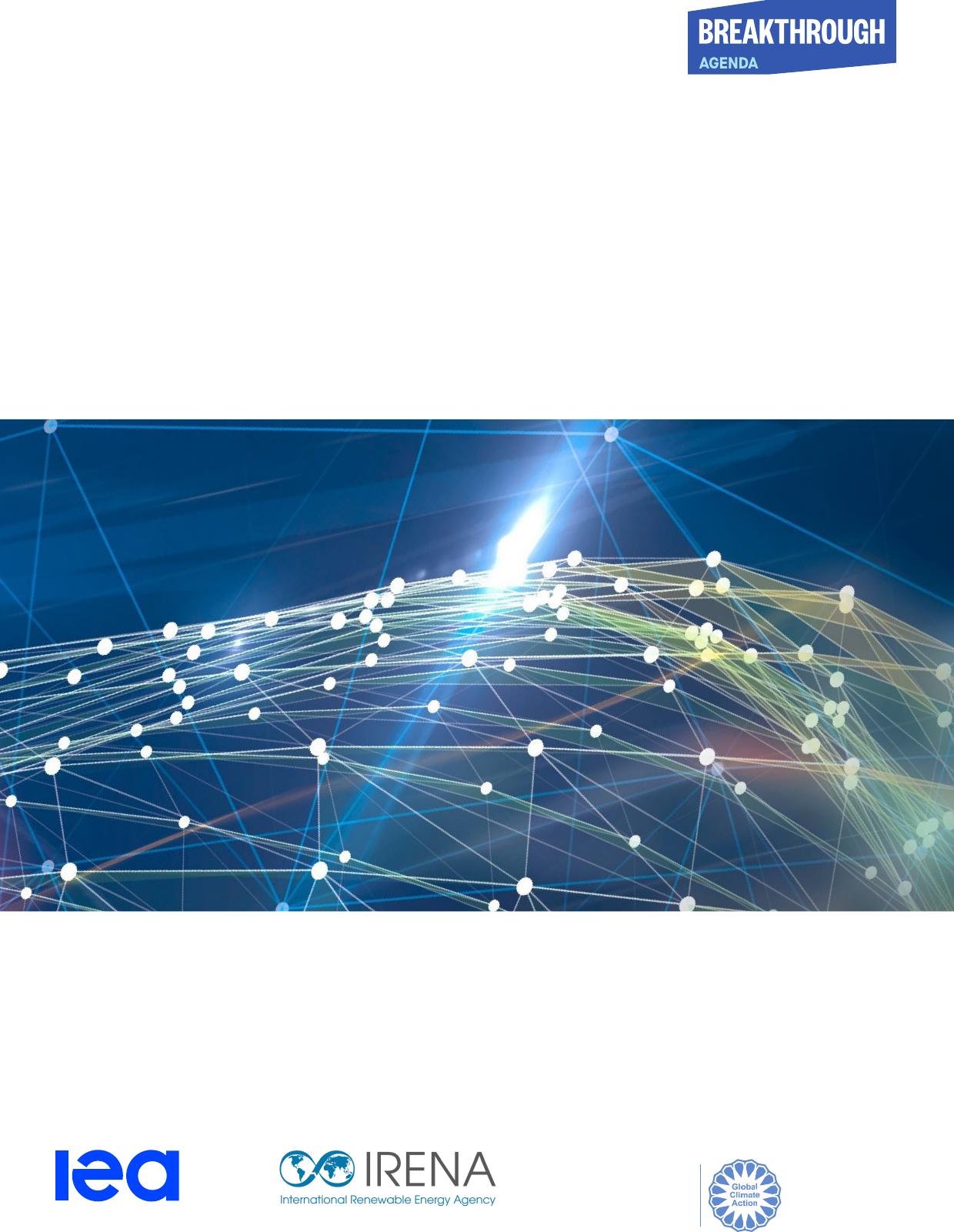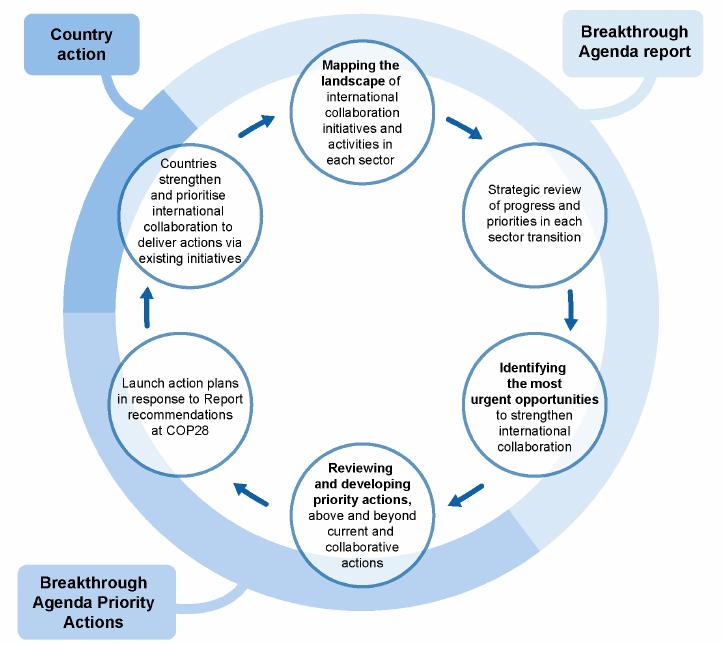THEBREAKTHROUGHAGENDAREPORT2023AcceleratingSectorTransitionsThroughStrongerInternationalCollaborationUNClimateChangeHigh-LevelChampionsincollaborationwith:MarrakechPartnershipTheBreakthroughAgendaReportINTERNATIONALENERGYAGENCY(IEA)TheIEAisattheheartofglobaldialogueonenergy,providingauthoritativeanalysis,data,policyrecommendations,andreal-worldsolutionstohelpcountriesprovidesecureandsustainableenergyforall.Takinganall-fuels,all-technologyapproach,theIEArecommendspoliciesthatenhancethereliability,affordabilityandsustainabilityofenergy.Itexaminesthefullspectrumofissuesincludingrenewables,oil,gasandcoalsupplyanddemand,energyefficiency,cleanenergytechnologies,electricitysystemsandmarkets,accesstoenergy,demand-sidemanagement,andmuchmore.Since2015,theIEAhasopeneditsdoorstomajoremergingeconomiestoexpanditsglobalimpactanddeepencooperation.INTERNATIONALRENEWABLEENERGYAGENCY(IRENA)IRENAistheleadintergovernmentalagencyforglobalenergytransformationthatsupportscountriesintheirtransitiontoasustainableenergyfutureandservesastheprincipalplatformforinternationalco-operation,acentreofexcellence,andarepositoryofpolicy,technology,resourceandfinancialknowledgeonrenewables.With168Members(167StatesandtheEuropeanUnion)and16additionalcountriesintheaccessionprocessandactivelyengaged,IRENApromotesthewidespreadadoptionandsustainableuseofallformsofrenewablesinpursuitofsustainabledevelopment,energyaccess,energysecurityandlow-carboneconomicgrowthandprosperity.UNCLIMATECHANGEHIGH-LEVELCHAMPIONSTheUNClimateChangeHigh-LevelChampionsmobilisenon-stateactorsforstrongerandmoreambitiousclimateaction.MandatedbyPartiesoftheParisAgreement,andworkingwiththeMarrakechPartnership,thetwoservingHLCsDr.MahmoudMohieldinandMs.RazanAlMubarakbuildonthelegacyoftheirpredecessorstoengagewithnon-stateactorsandactivatethe‘ambitionloop’withnationalgovernments,connectingpolicywiththemanyvoluntaryandcollaborativeactionstakenbycities,regions,businessesandinvestors,andnations.Theirworkisfundamentallydesignedtoencourageacollaborativeshiftacrossallofsocietytowardsadecarbonisedeconomysothatwecanallthriveinahealthy,resilientandzerocarbonworld.TheClimateChampionsTeam(CCT)isthedeliveryarmoftheUNClimateChangeHigh-LevelChampions.DISCLAIMERThedevelopmentofthisreportwasledbytheInternationalEnergyAgency(IEA)incollaborationwiththeInternationalRenewableEnergyAgency(IRENA)andtheUNClimateChangeHigh-LevelChampions.ThereportdoesnotnecessarilyreflecttheviewsoftheIEASecretariat,IRENAorindividualmembersoftheseorganisations.TheIEA,IRENA,UNClimateChangeHigh-LevelChampionsandtheirofficials,agents,anddataorotherthird-partycontentprovidersmakenorepresentationorwarranty,expressorimplied,inrespecttothereport’scontents(includingitscompletenessoraccuracy)andshallnotberesponsibleorliableforanyconsequenceofuseof,orrelianceon,thereportanditscontent.PAGE2TheBreakthroughAgendaReportThedesignationsemployedandthepresentationofmaterialhereindonotimplytheexpressionofanyopiniononthepartoftheIEASecretariat,IRENAortheUNClimateChangeHigh-LevelChampionsconcerning,andarewithoutprejudiceto,thelegalstatusofanyregion,country,territory,cityorareaorofitsauthorities,orconcerningthedelimitationoffrontiersorboundaries.ThementionofspecificcompaniesorcertainprojectsorproductsinthereportdoesnotimplythattheyareendorsedorrecommendedbytheIEA,IRENAortheUNClimateChangeHigh-LevelChampionsinpreferencetoothersofasimilarnaturethatarenotmentioned.ABOUTTHISREPORTTheBreakthroughAgendawaslaunchedby45worldleadersatCOP26andisacommitmenttoworktogetherthisdecadetoaccelerateinnovationanddeploymentofcleantechnologies,makingthemaccessibleandaffordableforallthisdecade.Tokick-startthisAgenda,countriesendorsedBreakthroughgoalstomakecleantechnologiesandsustainablepracticesmoreaffordable,accessibleandattractivethantheiralternativesby2030inthepower,roadtransport,steel,hydrogenandagriculturesectors.Thisreportalsocoversthebuildingsandcementsectors,wherenewbreakthroughsarebeingconsidered.TheBreakthroughAgendaestablishesanannualcycletotrackdevelopmentstowardsthesegoals,identifywherefurtherco-ordinatedinternationalactionisurgentlyneededtoaccelerateprogressandthengalvanisepublicandprivateinternationalactionbehindthesespecificprioritiesinordertomakethesetransitionsquicker,cheaperandeasierforall.PAGE3TheBreakthroughAgendaReportToinitiatethiscycle,worldleaderstaskedtheIEA,IRENAandtheUNClimateChangeHighLevelChampionstodevelopanannualBreakthroughAgendareporttoprovideanindependentevidencebaseandexpertrecommendationsforwherestrongerinternationalcollaborationisneeded.Thisdocument,the2023BreakthroughAgendaReport,isthesecondoftheseannualreports.Forsectorsaddressedin2022,itprovidesanassessmentofprogressagainsttherecommendationsmadelastyear,updatingrecommendationsforwhatmoreneedstobedone.Forsectorsaddedin2023,namelybuildingsandcement,itprovidesanassessmentofeachBreakthroughgoal,apathwayofco-ordinatedinternationalactionsthroughto2030,andasetofspecificrecommendationsonthemosturgentandhigh-impactopportunitiestostrengtheninternationalcollaboration.BreakthroughAgendaSignatories:AsofAugust2023theBreakthroughAgendasignatoriesare:Australia,Austria,Azerbaijan,Belgium,CaboVerde,Cambodia,Canada,Chile,China,Denmark,Egypt,EuropeanUnion,Finland,France,Germany,Guinea-Bissau,theHolySee,India,Ireland,Israel,Italy,Japan,Kenya,Latvia,Lithuania,Luxembourg,Malta,Mauritania,Morocco,Namibia,Netherlands,NewZealand,Nigeria,NorthMacedonia,Norway,Panama,Portugal,RepublicofKorea,Senegal,Serbia,Slovakia,Slovenia,Spain,Sweden,Türkiye,UnitedArabEmirates,UnitedKingdom,UnitedStates.PAGE4TheBreakthroughAgendaReportFOREWORDFOREWORDOverthepastyear,wehaveseenanaccelerationinthegloballow-carbontransition,withprogressoftenhappeningfasterthanmostrealise.ThisincludesrecorddeploymentofsolarPV,electriccarsandheatpumps,whichareallimportantsolutionsascountriestransitiontonetzeroemissions.However,itisalsoclearthatthetransitionisstillnotgoingfastenough–andisoccurringatverydifferentspeedsacrossregionsandsectors.Forexample,therecorddeploymentofrenewablesandtheincrediblyrapidgrowthinsalesofelectricvehiclesthattookplacein2022werebothheavilyconcentratedinChina,EuropeandtheUnitedStates.Strongerinternationalcollaborationisurgentlyneededtoacceleratethepaceofajusttransition,ensuringthatcleantechnologiesandsustainablesolutionsareaccessibletoall.ThisBreakthroughAgendaReport2023,thesecondinanannualseries,assessesprogressoninternationalcollaborationinsevenmajoremittingsectors.Thisincludesthefivesectorscoveredinlastyear’sreport–power,hydrogen,roadtransport,steelandagriculture–aswellasbuildingsandcement.Shouldcountriesagreetoworktogethertowardsbreakthroughgoalsinthesenewsectors,asisnowbeingconsidered,theBreakthroughAgendawillcover60%ofglobalgreenhousegasemissions.ThisreportisajointproductoftheInternationalEnergyAgency(IEA),theInternationalRenewableEnergyAgency(IRENA)andtheUNClimateChangeHigh-LevelChampions.Eachorganisationhasbroughtitsownexpertisetoassessprogressininternationalcollaboration,andtodeliverclearrecommendationsfortheactionsthatgovernmentsandnon-stateactorsneedtotaketogether.Italsodrawsonglobalexpertisegenerouslysharedbygovernments,businessesandcivilsocietyorganisationsactiveineachofthesectorscovered.Overall,thereportfindsonlymodestprogressinstrengtheninginternationalcollaborationinthesesectors.Therehavebeensomeexamplesofgoodprogress,whichcanprovideablueprintforothersectorsandinitiatives.Theseincludecollaborationonstandardsanddefinitionsfornear-zeroemissiongreensteelandlow-carbonhydrogen,thetradeofusedinternalcombustionenginevehicles,andrisingcommitmentstoinvestinresearchanddevelopmentinseveralsectors.Thereremainssignificantscopeforstrongerinternationalcollaborationinallsectors.Thisrequiresgreatercommitmentandparticipationfromallinvolved.Theprioritiesincludegovernmentsandbusinessessendingstronger,collectivedemandsignalsforsustainableproducts(suchaslow-carbonhydrogen,steelandcement);acontinuedimprovementinthecoordination,scale,andeffectivenessoffinancialandtechnicalassistanceprovidedtodevelopingcountries;stronger,moresustainedpublic-privatecollaborationonresearchandinnovationacrossseveralsectors;andtargetedcollaborationontrade.Wehopethattherecommendationsinthisreportprovideapractical,detailedroadmapforstrongerinternationalcollaboration.Welookforwardtocontinuingtosupportgovernments,businessesandcivilsocietyorganisationsintheireffortstoimplementtherecommendationsofthisreport,asweworktogethertomakethetransitiontocleantechnologiesandsustainablesolutionsfaster,easierandmoreaffordableforall.Weneedtoincorporatethefullrangeofenvironmental,social,economicandgovernancedimensionsandtoaddresstransitionalchallenges,especiallyindevelopingcountries.Theaccelerationinthegloballow-carbontransitionmustbeconnectedwithinclusivedevelopmentpathwaysthroughensuringlinkageswithandcontributiontothe2030AgendaforSustainableDevelopment.DrFatihBirolMrFrancescoLaCameraDrMahmoudMohieldinMsRazanAlMubarakExecutiveDirectorDirector-GeneralUNClimateChangeHigh-UNClimateChangeHigh-LevelChampionforCOP27LevelChampionforCOP28InternationalEnergyInternationalRenewableAgencyEnergyAgencyPAGE5TheBreakthroughAgendaReportACKNOWLEDGEMENTSACKNOWLEDGEMENTSTheBreakthroughAgendaReportwaspreparedbytheInternationalEnergyAgency(IEA),theInternationalRenewableEnergyAgency(IRENA)andtheUNClimateChangeHighLevelChampions(CCT).Theprincipalauthorsandcontributorsfortheanalysisrelatedtothepower,hydrogen,roadtransport,steel,buildingsandcementsectorswere(inalphabeticalorder):JoseBermudezMenendez(IEA),EmanueleBianco(IRENA),LucianoCaratori(CCT),KellyCarlin(CCT),ElizabethConnelly(IEA),ChiaraDelmastro(IEA),JinleiFeng(IRENA),AraceliFernandezPales(IEA),ElizabethPress(IRENA),HaraldFriedl(CCT),TimurGül(IEA),WillHall(IEA),MohamedHegazy(CCT),LuisJaneiro(IRENA),KaranKochar(IRENA),CatherineMacFarlane(CCT),AsamiMiketa(IRENA),RaulMiranda(IRENA),KapilNarula(CCT),FaranRana(IRENA),EllipseRath(IRENA),SimonSharpe(CCT),JacobTeter(IEA),TiffanyVass(IEA)andWillWild(CCT).ThebuildingschapterwasdevelopedincollaborationwiththeUNEP-hostedGlobalAllianceforBuildingsandConstruction(GlobalABC).TheprincipalauthorsoftheagriculturechapterwereAditiMukherji(CGIAR)andLoraineRonchi(CGIAR),withcontributionsfrom(inalphabeticalorder):ClaudiaArndt(ILRI),JacoboArango(AllianceofBioversityandCIAT),FionaFlintan(ILRI),JohnDerera(IITA),WendyFrancesconi(AllianceofBioversityandCIAT),SarahJones(AllianceofBioversityandCIAT),AnaMariaLoboguerrero(AllianceofBioversityandCIAT),DouglasMerrey(Consultant),JonathanMockshell(AllianceofBioversityandCIAT),MarcelaQuintero(AllianceofBioversityandCIAT),DanielGirmaMulat(ILRI),ClaudiaRingler(IFPRI),ManuelErnestoNarjesSanchez(AllianceofBioversityandCIAT),TekSapkota(CIMMYT),ShakuntalaThilsted(CGIAR).TheagriculturechapterwaspreparedbyCGIAR,undertheoversightofasteeringcommitteecomprisingRebeccaBrooks(CCT);Dr.IsmahaneElouafi(FAO);andDr.JoSwinnen(CGIAR).IEAandIRENAdidnotprovideinputtothechaptercontentanditsfindings.ThanksalsotoIEACommunicationsandDigitalOffice,IRENA’sCommunicationOfficeandCCT’sStrategicCommunicationsandEventsTeamfortheirsupportwiththeproduction,developmentandcommunicationofthereport.ThisprojectwouldnothavebeenpossiblewithoutthefinancialsupportprovidedbytheGovernmentsofAustralia,theUnitedArabEmiratesandtheUnitedKingdom.ThereportbenefitedfromtheinsightsgatheredduringaseriesofBreakthroughdialogues,includinginitiativesandgovernments.Italsobenefitedfromthefeedbackprovidedbythemanyseniorpeerreviewerswhoseinputhashelpedimprovedthequalityofthereport.Theyinclude:PrabodhaAcharya(IndianSteelAssociation);MaxAhman(UniversityofLund);NatalieAllen,PaulDurrant,AineMcGowanandMarcusStewart(GovernmentoftheUnitedKingdom);PerAndersson(StockholmEnvironmentInstitute);LaurentAntoni(IPHE);RikArends,TharsisTeohandChristophWolff(SmartFreightCentre);MarleneArens(HeidelbergCement);ChrisBataille(IDDRI);ChristopherBeauman(independentconsultant);AbhishekBhaskar(ClimatePAGE6TheBreakthroughAgendaReportACKNOWLEDGEMENTSInvestmentFunds);ErikBjörke(ClimateGroup);KatherineBuckley,SandraDickisonandJosephStanford(GovernmentoftheUnitedStates);MichaelBuechl,IuliaDolganova,JulianHaversandStelaIvanova(GovernmentofGermany);VenikaChristophe,StephaneCouroux,CarolineCzach,DeborahdeGrasseandAndréanneLéger(GovernmentofCanada);PatriciaColaferro(ALACERO);JennieDodson,LucadeGiovanetti,RolandHunzikerandUrskaSkrt(WBCSD);JennyHaywardandPetaOlesen(GovernmentofAustralia);MatteoCraglia(ITF);FrancoisCuenot(UNECE);TimDallmann(ICCT);RuthDavis(EyebrightConsulting);RebeccaDellandDanPletchaty(ClimateWorks);OlivierDemaret(GovernmentofBelgium);KarlDowney(SBTI/CDP);JohnDulac(Saint-Gobain);RachidEnnassiri(GovernmentofMorocco);AhmedElkenawy(AgricultureResearchCentre);MeredyddEvans(PNNL);LisaFischerandKatinkaWaagsaether(E3G);AndrewFlagg(Consultant);BernhardGahleitner(AustrianGovernment);HughGarnett(IIGCC);DuncanGibbandRichardLowes(RAP);AbhishekBhaskar,MariaDumpert,DolfGielen,MatthewWilliamHarris,ZizaMachado,PaulP.Mathew,PaulPulickal,PaulineArianeRavillard,SandraMariaRomboli,ShaneSuksangiumandChongSukSong(WorldBank);PeterGraham(GBPN);IanHamilton(UCL);DanHamza-GoodacreandAndreasWagner(ETC);KateHarland(CanadianClimateInstitute);AnnieHeaton(ResponsibleSteel);LukasHermwille(WuppertalInstitute);MarinaHolgado(HydrogenTCP);HansOlavIbrekk(GovernmentofNorway);AndyJarvis(BezosEarthFund);MustaphaIyabo(GovernmentofNigeria);HarukaKasaiandHazukiKasai(GovernmentofJapan);HiromiKawamata(JapanIronandSteelFederation);StephanieKodish(CALSTART);HugoLiabeuf(EnergyTransitionsCommission);JianLiu(EnergyResearchInstituteChina);AlvaroLorenz(Vcimentos);SigurdMagnusson(GovernmentofNewZealand);RafalMalinowski(Systemiq);LucianoMartini(ItalianGovernment);JonasMoberg(GreenHydrogenOrganisation);MarcFarreMoutinho(MissionPossiblePartnership);StephenNaimoliandRichardWaite(WorldResourcesInstitute);AudreyNougent(WorldGBC);OshadiyaOlanipekun(NigerianGovernment);BarbaraO'Neill(NREL);SimonOtto(VUB);LorenzoPagliano(PolitecnicodiMilano);HenriPaillere(IAEA);IngaPetersen(GlobalBatteryAlliance);MelissaPinfield(MeridianInstitute);AndrewPurvis(WorldSteelAssociation);NaaAyeleysaQuaynorMettle(REALL);OliverRapf(BPIE);KathyReiman(AgoraIndustry);CarlaRobledoandSachaScheffer(GovernmentoftheNetherlands);ChristopheRodriguez(IFPEB);DegerSayginandOliviaWessendorff(OECD);MonicaSchroeder(BuildChange);DanielSchroth(AfDB);PetraSchwager(UNIDO);KarimSelouane(GlobalABCAdaptationWorkingArea);TichakundaSimbini(NEPAD);EmmiSimonen(GovernmentofFinland);UpendraSingh(InternationalFertilizerDevelopmentCenter);FionaSkinner(UNIDO);DavidSmedickandLaurensSpeelman(RMI);MatthijsSoede(EuropeanCommission);MarvinStolzandAnnaZinecker(GIZ);MeliStylianou(CanadianGovernment);CaitlinSwalec(GEM);ElliottSwartz(TheGoodFoodInstitute);PeterSweetman(ClimateStrategy);MichaelTaylor(IRENA);AndreiTchouvelev(ISO);NoévanHulst(Gasunie);SheilaWatson(FIAFoundation);KipyegoWesley(GovernmentofKenya);PaulWinters(KellogInstituteforInternationalStudies);MatthewWittenstein(UNESCAP);FrankWouters(RelianceIndustries),HelenaWright(FAIRRInitiative);andtheMinistryofAgriculture,ForestryandFisheries(GovernmentofJapan).Theindividualsandorganisationsthatcontributedtothisstudyarenotresponsibleforanyopinionsorjudgementsitcontains.TheviewsexpressedinthestudyarenotnecessarilyviewsoftheIEA’sorIRENA’smembercountries.AllerrorsandomissionsaresolelytheresponsibilityoftheIEA,IRENA,theUNClimateChangeHigh-LevelChampionsandCGIAR.PAGE7TheBreakthroughAgendaReportTABLEOFCONTENTSTABLEOFCONTENTSExecutiveSummary................................................................................................................11Chapter1.Introduction..........................................................................................................34Thestateofthetransition......................................................................................................34Theroleofinternationalcollaboration...................................................................................35TheBreakthroughAgenda....................................................................................................35Approachtothisreport..........................................................................................................36Chapter2.Power....................................................................................................................38Stateofinternationalcollaboration........................................................................................39Continueimprovementsintheeffectivenessofthedeliveryoftechnicalandfinancialassistanceforthepowersectortransition.............................................................................41Drasticallyimprovetargetedsupportforlocaljobs,skillsandinvestmentinfossilfueldependentcommunities........................................................................................................44Acceleratethedeploymentofpriorityprojectsshowcasingnoveltechnologiesandsolutionsacrossmultipleregions..........................................................................................48Reassessopportunitiesforcross-borderelectricitytrade,acceleratedbyenhancedtechnicalsupport....................................................................................................................51Collectivelyagreehigherminimumenergyperformancestandardsformajorelectricityconsumingappliances...........................................................................................................54Chapter3.Hydrogen..............................................................................................................57Stateofinternationalcollaboration........................................................................................58Acceleratingthedevelopmentofcommonstandardsforhydrogenemissions,safetyandoperationswithincreasedgovernmentsupport....................................................................59Co-ordinatingactiontocreatetargeteddemandforlow-carbonandrenewablehydrogen,startingwithexistingindustrialapplications..........................................................................64Drivingglobalexpansionandknowledge-sharingofhydrogendemonstrationprojectsfordiversehigh-prioritysectors...................................................................................................67Collaboratefortherapidscale-upofconcessionalfinanceforlow-carbonandrenewablehydrogenprojectsindevelopingeconomies.........................................................................71Chapter4.RoadTransport....................................................................................................76Stateofinternationalcollaboration........................................................................................77Aligningthepaceofthetransitioninternationallytoshiftinvestmentandacceleratecostreduction................................................................................................................................78Providinginternationalassistanceandfinancetosupportdevelopingcountriesinthetransition................................................................................................................................83PAGE8TheBreakthroughAgendaReportTABLEOFCONTENTSAgreementonstandardsforthesustainabilityofbatterysupplychains...............................87Workingtogethertomobiliseinvestmentincharginginfrastructure.....................................90Takingthemostpollutingvehiclesoutofinternationaltrade................................................92Chapter5.Steel......................................................................................................................95Stateofinternationalcollaboration........................................................................................96Greateralignmentonemissionsaccountingmethodologiesanddefinitionsfornear-zeroemissionsteel........................................................................................................................97Furtherscale-upofhigh-qualitycommitmentstopurchasenear-zeroemissionsteel.......100Strongercollaborationondevelopmentanddemonstration,makinguseofsuccessfulco-operativemodels.................................................................................................................103Allmajorsteelproducingcountriestoengageinopenandinclusivedialoguesontradeandnear-zeroemissionsteel.....................................................................................................105Improvingtheeffectivenessoftechnicalandfinancialassistanceforindustrydecarbonisationprojects................................................................................................................................108Chapter6.Buildings.............................................................................................................111Howdowegetthere?..........................................................................................................112Currentstateofinternationalcollaboration.........................................................................116Priorityareasforinternationalcollaboration........................................................................120Amplifydemandfornetzeroemissionsandresilientbuildings,constructionmaterialsandcleanenergytechnologies............................................................................................123Co-ordinateeffortstoimprovetechnicalandfinancialassistancetounlockprivateinvestments............................................................................................................................125Co-ordinatesupportforresearch,developmentanddemonstrationtoacceleratethedeploymentofkeytechnologiesandconcepts...................................................................128Improvethetrainingandcapacitybuildingofferforstakeholdersalongthevaluechain,inboththepublicandprivatesector–withafocusonbuildingenergycodes...................130Chapter7.Cement................................................................................................................134Howdowegetthere?..........................................................................................................135Currentstateofinternationalcollaboration.........................................................................137Priorityareasforinternationalcollaboration........................................................................139Rapidlyscaleuphigh-qualitydemandcommitmentsfornear-zeroemissioncementandconcrete...............................................................................................................................141Facilitateprivatesectorcollaborationonnoveltechnologies,usingpublicsupporttodrivecostreductionsinallregions...............................................................................................144Improvetheco-ordinationofassistanceprogrammesforcommercial-scaleprojectsindevelopingcountries............................................................................................................146PAGE9TheBreakthroughAgendaReportTABLEOFCONTENTSChapter8.Agriculture..........................................................................................................149Stateofthetransition...........................................................................................................149Sevenpromisingtechnologyareasandapproachescriticaltothetransition.....................151Increasedinternationalclimatefinanceshouldbedirectedtounlockingthepotentialofagriculturaltechnologiesandapproacheswithproveneffectiveness.................................153Promoteinternationalsharingofknowledgeonpolicyandimplementationtofacilitatefasteruptakeofproventechnologies............................................................................................156Developcommonmetricsandindicatorstotracktheadoptionofsustainableagriculturesolutions...............................................................................................................................160Increasesupporttofoodsystemresearch,developmentanddemonstrationtosupportuptakeandscalingofpromisingtechnologiesandapproaches.........................................162Internationaleffortsshouldworktowardsenablingtheprivatesectortoscaleupsolutionsthroughglobalmarkets........................................................................................................164Chapter9.Crosscutting......................................................................................................168Leveragingcross-cuttingopportunities...............................................................................168PAGE10TheBreakthroughAgendaReportEXECUTIVESUMMARYEXECUTIVESUMMARYSTRENGTHENINGINTERNATIONALCOLLABORATIONTOACCELERATETRANSITIONSThetransitiontocleanenergyandsustainablesolutionsisacceleratingacrossmanysectors,withunprecedentedexpansionincleantechnologiessuchassolarPVandelectriccars.Renewableelectricityisnowmoreaffordablethanfossilfuel-basedelectricityinagrowingnumberofcountriesandcontributestomorethan50%ofelectricitygenerationinaround30%ofcountries.Salesofelectricpassengercarsaregrowingexponentiallyand–ifthisratecontinues–couldby2030becomfortablyinlinewithwhatisrequiredunderascenariocompatiblewithreachingnetzeroCO2emissionsby2050.Yet,globalemissionsarestillincreasing,andtheNationallyDeterminedContributionsthatcountrieshaveputforwardinUNclimatechangenegotiationsarenotconsistentwithcurbingtemperatureriseinlinewithinternationalclimategoals.Thepastyearhasalsobeennotableforrecordtemperatures,andextremeweathereventsarecontinuingtoincreaseinfrequencyandintensityinmanypartsoftheworld.Actionthisdecadewillbecrucialtoheadofftheworsteffectsofclimatechange.Someofthesolutionsrequiredtodecarbonisecertainsectorsarenotyetdeployedatscale,andcantakeseveralyearstodevelop,meaningfirststepstowardsdeploymentareneedednow.What’smore,investmentincleanenergytechnologiesandlow-emissionproductsandmaterialstendstobeconcentratedinadvancedeconomies,andnotinthecountriesundergoingthemostrapiddevelopmentandeconomicgrowth.Progressonthedeploymentoflowcarbonsolutions20222030IndicatorPowerRenewablescapacity3.8TW11TWHydrogenLowcarbonandrenewablehydrogenproduction0.7Mt/yr70–125Mt/yrRoadtransportEVsalesshareofpassengercars14%Atleast65%SteelNearzeroemissionsteelprojectannouncements(in13MtAtleast100Mt2022)vs.completedprojects(in2030)BuildingsShareofnewbuildingsthatarenetzero5%100%CementNearzeroemissioncementprojectannouncements(in22MtAtleast350Mt2022)vs.completedprojects(in2030)Sources:IRENA(2023),WorldEnergyTransitionsOutlook2023(WETO);IEA(2021),NetZeroEmissionsby2050Scenario;IEA(2023),TrackingCleanEnergyProgress.PAGE11TheBreakthroughAgendaReportEXECUTIVESUMMARYWell-targetedinternationalcollaborationisacriticalenablerateachstageofthetransition.Eveninthecurrentcontextofgeopoliticalandgeoeconomiccomplexities,well-targetedcollaborationcandeliverimportantbenefits.Itcandecreasethedifficultyandamplifytheeffectofactionsbeingtakenindividuallybycountriesandbusinesses,helpingtoensureafastertransitionandmakingcleantechnologiesandsustainablesolutionsmoreaccessibleandaffordabletoall.Itsformscaninclude:collaboratingonthedevelopmentandtestingofnewtechnologiesandsolutions,resultinginfasterinnovation;coordinatingdeployment,deliveringlargereconomiesofscale;sendingjointdemandsignalstocreatenewmarkets,providingstrongerincentivesforinvestment;collectivelyimprovingtheofferoftechnicalandfinancialassistance,toenableawiderdeploymentofsolutions;andcoordinatingonstandards,tohelpcreatelevelplayingfieldswhereneeded.Figure1HowinternationalcollaborationcanaccelerateprogressateachstageofthetransitionSource:AdaptedfromVictor,Geels&Sharpe(2019),AcceleratingtheLowCarbonTransition:TheCaseforStronger,(Accessed8September2023).InternationalcollaborationcanaccelerateprogressateachstageofthetransitionTheBreakthroughAgendaisdesignedtostrengtheninternationalcollaborationacrossthemajorgreenhousegasemittingsectorsoftheglobaleconomy.ThefivesectorsforwhichBreakthroughAgendagoalshavealreadybeenagreed–power,hydrogen,roadtransport,steelandagriculture–isthisyearsettoexpandtocoverthebuildingsandcementsectors.Asaresult,theAgendawillcovermorethan60%ofcurrentglobalGHGemissions.PAGE12TheBreakthroughAgendaReportEXECUTIVESUMMARYFigure2Greenhousegasemissionsbysector,2019OtherenergyForestand10%Powerotherlanduse5%23%Other16%59GtCO2eindustry10%Roadtransport5%5%Othertransport3%6%17%SteelCementBuildingsAgricultureandrelatedlanduseNotes:Emissionsarebrokendownbydirectemissionsineachsector.Onlyenergy-relatedemissionsfromcementareincluded.Emissionsfromhydrogenproductioncutacrossseveralsectors.GHGs=CO2,CH4,F-gases,HFCs,PFCs,SF6andNF3.Source:IPCC(2022),ClimateChange2022:MitigationofClimateChange.TheBreakthroughAgendanowcoversasignificantportionofglobalemissions.ONLYMODESTPROGRESSHASBEENMADEINSTRENGTHENINGINTERNATIONALCOLLABORATIONONLOW-CARBONTRANSITIONSINTHEPASTYEARInthepastyear,therehasbeenonlymodestprogressinstrengtheninginternationalcollaborationinthesectorscoveredinthisreport.Progresshasbeenmadeinexpandingfinancialandtechnicalassistancetodevelopingcountriesinsomesectors(includingpower,roadtransport,hydrogenandsteel)andinconvergingonstandardsformeasuringemissionsanddefininglow-carbonproducts(insteel,cement,andhydrogen).Therehasalsobeenprogressincollaborativeresearchanddevelopmentinitiativesacrossmostsectors,althoughthereremainsaneedtosharelearningmoredeeplywithawidersetofcountries.PAGE13TheBreakthroughAgendaReportEXECUTIVESUMMARYMuchmoreprogressisneededinaligningpoliciestocreatedemandforcleantechnologies.Inroadtransport,steel,cement,hydrogen,andelectricity-consumingappliances,opportunitiestocreatestrongerdemandsignalsforindustryinvestment,andtoacceleratecostreductionthrougheconomiesofscale,arestillbeingmissed.Sendingstrongdemandsignalsshouldbeahighpriorityforinternationalcollaborationthisyear.Thereisalsoaneedformoredeterminedeffortstoinitiatedialoguesontradeinsectorswherethisislikelytobecriticaltothetransition,notablysteelandagriculture.Overall,currenteffortsremainfarfromexploitingthefullpotentialofinternationalcollaborationtoacceleratetransitions.Whileparticipationinmanyinitiativeshasincreased,inmostsectorstheleadinginternationalinitiativesstillfallshortofmembershipthatcoversamajorityoftheglobalmarket.Greaterpoliticalcommitmentisneededtoprogressfromsofterformsofcollaboration,suchassharingbestpractice,toharderformssuchasalignmentofstandardsandpolicies,whicharemoredifficultbutcanyieldgreatergainsinmobilisinginvestmentandacceleratingdeployment.ProgresssummaryDemandFinanceResearchTradeOthercreationandandandconditionsStandardsmanagementinvestmentinnovationandcertificationInfrastructurePowerHydrogenRoadInfrastructuretransportSteelAgricultureKnowledgeBuildingsandskillsCementKnowledgeandskillsCrossCoordinationcuttingineachsectorNote:red=minimalprogress;orange=modestprogress;yellow=goodprogress;green=strongprogress;blue=newrecommendation;grey=norecommendationinthisareaforthissector.PAGE14TheBreakthroughAgendaReportEXECUTIVESUMMARYThepowersectoraccountsforPRIORITIESFORSTRENGTHENEDINTERNATIONALaround13GtCO2,or23%oftotalemissions.ThishasrisenCOLLABORATIONbyaround10%since2010.Theseneedtofallbyover50%Thedeploymentofrenewablesinthepowersectorhasincreasedto83%by2030.ofnewelectricitygeneratingcapacity–althoughtherateofannualdeploymentstillneedstotrebleby2030.TherehavebeenhighprofileTheaveragelevelisedcostofannouncementsoftechnicalandfinancialassistancefordevelopingelectricityhasfallenby86%forcountries,butthereremainsaneedforthistobeexpanded,particularlysolarPVand60%forwindtoreducethecostofcapitalindevelopingcountries,andtosupportthesince2010.transitioninthemostcoal-dependentregions.CollaborationonresearchandinnovationprojectsshouldbestrengthenedbysharinglearningwithBy2030,11TWofrenewableawidersetofcountries.Animportantopportunitythatremainsgeneratingcapacityisrequired,unexploitedisforcountriestoagreehigherminimumenergyperformanceupfromlessthan4TWtoday.standardsforelectricalappliances,toshiftglobalmarketstowardsmoreefficientproductsthatreducecostsandcutemissions._________________________Renewableandlow-carbonhydrogenproductionremainedbelow1EmissionsintensityofhydrogenMt/yrin2022,comparedwiththe70-125Mt/yrthatisneededby2030.productionneedstofallbyTherehasbeensomeprogresstowardsconvergenceonstandardsandnearly50%by2030,resultingincertificationforemissionsandsafety,andinincreasingfinancialanda10%reductionintotaltechnicalassistancefordevelopingcountries.Apressingneedistoemissionsfromhydrogenstrengthenthecollectivedemandsignalforrenewableandlowcarbonproduction(duetothelargehydrogen,frombothpublicandprivatebuyers,movingfromincreaseintotalproduction).commitmentsandpledgestocontractsandpolicies.Theopportunitytocreatelarge-scaledemandquicklyisgreatestinsectorswherehydrogenLow-carbonandrenewableisalreadyused,suchasfertilisersandrefining.Injointresearchandhydrogenproductionreachedinnovationactivitiesthereisaneedforgreaterprioritisationofthose0.7Mtin2022,comparedwithsectorswherehydrogencanprovidethemostvalue,suchasindustryand70-125Mt/yrrequiredby2030.shipping,aswellasforwidergeographicaldistributionofprojectsandimprovingknowledge-sharing._________________________EmissionsfromroadtransportProgressintheroadtransportsectorisaccelerating,withelectricneedtofallbynearlyone-thirdpassengercarsnowtotalling14%oftotalcarsales,aratethatisdoublingby2030togetontrackfornetevery1.2years.Therehasbeenprogresstowardstakingthemostzero.pollutingusedvehiclesoutofinternationaltrade,withagreementsbygroupsofAfricancountriesonminimumstandardsforimportedvehicles.ThetotalcostofownershipofTherehasalsobeenanexpansionoftechnicalassistanceprogrammeselectricbusesandtrucksisinthesector.Thereremainsaneedforcountrieswiththelargestmarketslikelytobelowerthandieseltoagreeonthepaceofthetransitiontowardsallnewvehiclesbeingzerocounterpartsacrossnearlyallemission,andtoimplementthisthrougheffectivepoliciesinallvehiclemedium-andheavy-dutysegments.Moreprogressisalsoneededtoagreeinternationalstandardssegmentsby2030inEurope,forbatterysustainability.theUnitedStatesandChina.Inthesteelsector,nearly90Mtofnewhigh-emissionblastfurnacesare_________________________anticipatedbefore2025.Announcementsfornewnear-zeroemissionsteelplantshaveincreasedto13Mt,morethandoublingversuslastyear,TotalCO2emissionsfromthebutstillfarshortofthemorethan100Mtneededby2030.Therehassteelsectorhaverisensincebeengoodprogressinaligningemissionsaccountingmethodologiesand2015,beforestabilisingsincedefinitionsfornear-zeroemissionsteel,andmodestprogressinthe2019.deliveryoffinancialandtechnicalassistancefordevelopingcountries,PAGE15TheBreakthroughAgendaReportEXECUTIVESUMMARYTheprojectpipelineforprimarywiththelaunchofnewfunds.Thereisanurgentneedforstrongernear-zeroemissionplantshascollectiveeffortstocreatedemandfornear-zeroemissionsteel:whileincreasedto13Mt,from5Mtparticipationinpublicsectorinitiativesforthispurposehasrisen(fromlastyear.Over100Mtis9%to20%oftheglobalmarket),purchasecommitmentsofthekindthatrequiredby2030togetontrackcouldmobiliseindustryinvestmentatscalehavenotyetbeenmade.fornetzero.Otherprioritiesaretoincreasethesharingoflearningfromearlydemonstrationprojectswithdevelopingcountries,andtoexpandinitial_________________________discussionsontradeandthesteeltransitiontoincludethelargeststeelproducersinemergingeconomies.Agricultureemissionscontinuetoincreaseto7.3GtCO2inInagriculture,emissionsremainonalong-termupwardtrend,crop2022.Theyneedtofallto5.7yieldsarenotimprovingattherateneeded,andagriculturalexpansionGtCO2togetontrackfornetcontinuestodrivedeforestation.Whiletherehavebeensomenewzero.internationalcommitmentstoinvestmentinresearchanddevelopment,Gainsandlossesinglobalthereremainsaneedforincreaseddevelopmentassistance,sustainedcroplandareroughlyequal,andsubstantialpolicyexchanges,andcooperationonstandardsandalthoughagriculturalexpansiontrade.Thisneedismostpressinginrelationtosustainableagriculturecontinuestodrivedeforestation.solutionswithproveneffectiveness,whichcouldbemorerapidlyExpansionwillhavetostopdeployed,includingagroecologyandothersustainableapproaches,lowcompletelyif2030targetsaretoemissionfertilisers,alternativeproteins,cropandlivestockbreeding,bemet.measurestoreducelivestockmethaneemissions,reductionsinfoodloss_________________________andwaste,anddigitalagricultureandclimateservicesforfarmers.BuildingssectoremissionsEmissionsinthebuildingssectorhavegrownatanaverageof1%perrepresentaroundathirdoftotalyearsince2015,withtheglobalgrowthinfloorareamorethanoffsettingenergysystememissions.theincreasedefficiencyanddecarbonisationefforts.MandatorybuildingOperationalemissionsneedtoenergyefficiencycodesareakeynationalpolicy,requiringascale-upinfallbyabout50%fromtheirtechnicalassistancetoensureallcountrieshavetheminplace.2022levelby2030,togetonInternationalagreementsondefinitionsandstandardsthatsupportthetrackwithnetzero.comparabilityandinteroperabilityofthesecodescanhelpfacilitateprivateinvestment.Alignedpublicprocurementcommitmentsforzero80%ofthegrowthinbuildingsemissionbuildingscanhelpgrowmarketsfornewconstructionmethods,floorareathrough2030issettomaterialsandbuildingappliances,eventhoughsomeofthecoordinationtakeplaceinemergingandgainsmaybelimitedbythehighlylocalisednatureofthesector.Moredevelopingeconomies.accessibletechnicalassistancefordevelopingcountriesisneededtosupportpolicydesignandimplementation,andtofacilitateinvestment._________________________Totalemissionsinthecementsectorhavebeenrisingsince2015,Emissionsintensityofcementalthoughtherehasbeenawaveofrecentannouncementsoflargeproductionhasrisenbynearlyprojectsfornear-zeroemissioncementproduction.Mostofthekey10%since2015,largelyduetotechnologiesrequiredhavenotyetbeendeployedcommerciallyatscale.anincreaseintheclinker-to-Privatesectorcollaborationonresearch,developmentandcementratioinChina.demonstrationhasbeennotablysubstantial.Asinthesteelsector,theurgentneedistocomplementthiswithstrongcollectiveactiontocreateBy2030,around10%ofglobaldemandforthenear-zeroemissionproduct,andwhilecountriesandcementproductioncapacitycompanieshaverecentlyjoinedinitiativeswiththisintent,theyhaveyetneedstobeconsistentwithtoconverttheintentionintoeffectiveaction.Itwillalsobeimportanttonear-zeroemissions.ensurethatknowledgefromearlydemonstrationandcommercial-scaleprojectsissharedquicklywithawiderangeofcountries,toaccelerate_________________________widerbuild-out.PAGE16TheBreakthroughAgendaReportEXECUTIVESUMMARYIntermsofcrosscuttingcollaborationthatwillhaveanimpactinseveralsectors,progresshasbeenmostnotableinresearchandinnovation,wherecountrieshavecommittedUSD94billiontocleanenergydemonstrationprojectsby2026.Onfinance,theBridgetownInitiativehasprompteddiscussionsatheadsofgovernmentlevelonproposalstoreducethecostofcapitalfordevelopingcountries’investmentsincleantechnologies,andtherehasbeensomeprogressinthedevelopmentofplatformstomatchdevelopingcountries’needswithinternationalinvestmentandtechnicalassistance.Ontrade,theClimateClubhastakeninitialstepstowardscoordinatedinternationalactiononindustrialdecarbonisationbuthassofaronlyinvolvedtwoofthetenlargestemergingeconomies;expandingparticipationwillbeimportanttotheeffectivenessoftheseefforts.Therehasbeensomeprogressinclarifyingthestructureforinternationalcollaborationwithineachsector,withtheBreakthroughAgendaprocesscontributingtothecoordinationofactivitiesandprovidingclearerdirectionwhereparticipationorresourcesneedtobeincreased.Othersectors:opportunitiestoimproveinternationalcollaborationandmakelow-carbontransitionslessdifficultarelikelytoexistinsectorsnotyetcoveredbytheBreakthroughAgenda.Theseincludeshipping,aviation,andindustrialsectorsotherthansteelandcement(suchaschemicalsandplastics).Inmanysectorstherewillbesynergiesbetweenactionstoreduceemissionsandactionstobuildresilience.TheagreementatCOP27oftheSharmElSheikhAdaptationAgenda,tobeadvancedinparallelwiththeBreakthroughAgenda,createsanopportunityforthesesynergiestobeenlargedandaccessedmorewidelythroughwelltargetedinternationalcollaboration.InJanuary2023,theCOP28PresidencyannouncedapartnershipwiththeBreakthroughAgenda,whichhasthepotentialtostrengtheninternationalcooperationbyprovidinggreatercontinuityofeffortsbetweenCOPs,especiallyifemulatedbyfutureCOPPresidencies.Thesummariesofprogressineachsectoroutlinedbelowdemonstratethecontributionthatinternationalcollaborationisalreadymakingtoacceleratethetransition.Often,actioninonesectorcontributestoprogressinanother,suchasbyspeedingupthedeploymentofkeytechnologies.Theprioritiesforactionandrecommendationsineachsectorprovideaclearpathwaytocontinueacceleratingthetransition.PAGE17TheBreakthroughAgendaReportEXECUTIVESUMMARYPowerprogresssummaryAreaWhatprogresshasbeenmade?Whatmoreneedstobedone?2023ModestP2.Finance•Awaveofnewpublicand•Continuetoincreasethescaleofpublicandprivatecommitments,includingandprivateinvestments.MinimalinvestmentJETPs.•Increasepubliccommitments,channelled•Thedevelopmentofinnovativethroughdirectinvestments,blendedfinancialinstrumentsimprovingfinance,andotherinstrumentssuchasaccesstofinance.grantsandsubsidiestohelpreducethecostofcapitalindevelopingcountries.•Furthergrowthinmatchmakingplatformstoimproveaccessto•Improvecollaborationaroundsuccessfulassistance.de-riskingmechanisms,particularlyamongMDBsandotherlenders.P3.Social•Severalsupportprogrammes•Aligndevelopmentfundingwithtargetedengagementannouncedfocusedonthesupportforeconomicdiversificationinsocialaspectsofthetransition.fossilfueldependentregions.•Improvementsincapacity•Developstrategiestostrengthenlocalbuildingforgovernmentsupplychains,usinglocalexpertiseandofficialsandlocalindustries.internationalbestpractice.•Sharelearningamongcountriesandsupportthecreationofdedicatednationalsocialtaskforces.P4.•Increaseintheparticipationin•Betterco-ordinateeffortstoresearch,Researchkeypublicandprivatesectordevelopanddemonstratetechnologies,andinitiatives.particularlyacrossemergingmarkets.innovation•Countrieshavesetoutjoint•PrioritiseR&Dinvestmentsinkeyenablinginnovationprioritiesandplantechnologies,suchasstorage,distributedModestfordemonstrationprojectsinenergyresourcesandsystemoperation.allregions.•Assessprospectsfortherefurbishment•Strengthenedcollaborationandrepurposingofexistingassetssuchasandknowledgeexchangehydropowerunitsandthermalpoweramongtheinitiativesworkingplants.inthisarea.P5.•Countrieshavesetclear•CollectivelyidentifymechanismstoInfrastructureprioritiesandroadmapsformitigatesecurityofsupplyrisksforcross-regionalgridinitiatives.borderinfrastructure.Modest•Advancedbilateraland•Exploremeansofreducingtransactionregionalinitiativestocostsandfast-trackingpermitting.implementorimprovecross-borderpowerexchange.•Scaleupmanufacturingcapacitytoreducecurrentmarketleadtimeandavoid•Improvedknowledgeshortfallsofkeymaterials.exchangebetweenregulatorsandotherrelevantactors.P6.Demand•Increasedmembershipof•Countriestocollectivelyagreetohighermanagementefficiencyandenergyminimumenergyperformancestandardsstandardsinitiatives.forhighenergy-consumingappliances.Minimal•Amodestincreaseinin-•Improvedtechnicalandfinancialcountryassistanceandassistancetofacilitatetheapplicationoftechnicalcapacitybuilding.measures.PAGE18TheBreakthroughAgendaReportEXECUTIVESUMMARYPowerrecommendations1Governments,workingwithkeyinstitutions,andfunds,shouldensurethatinternationalsupportisavailableatbetterterms,includinggrantsatearlyinvestmentstages.Thatincludescreatingde-riskingmechanisms,tailoredtothecountry’srespectivecontexts,helpingtomobiliseprivatesectorinvestments.Overallprovisionofresourcesshouldbeincreased,particularlytowardstechnologiesthathavenotachievedcommercialmaturity.2GovernmentsandMDBsshouldworktogethertomorestronglyaligndevelopmentfundingwithtargetedsupportforlocaljobs,skillsandinvestment,fortherepurposingoffossilfuelassets,economicdiversification,andforenvironmentalrestoration,infossilfueldependentregionsandcommunities.Civilsociety,governmentsandindustryshouldcontributetocreatinginternationalcentresofexpertiseonthejusttransition,withinexistinginstitutions.3Governmentsshouldworkthroughrelevantinitiativestoacceleratetheidentificationofsuitabledemonstrationprojects,resourcethemappropriately,andensurehigh-qualityknowledge-sharingstructuresareputinplace.Tofacilitateknowledgesharingamongawidersetofcountriesandstakeholders,closecollaborationwithregionalresearchandinnovationnetworkswillberequired.4Governmentsshouldworktogethertoreassesstheopportunitiesforcross-borderandregionalpowerinterconnectionandsmartgridstosupportthetransitiontocleanpowersystems,includingopportunitiesthathavebeenpreviouslyconsideredbutnottakenforward,giventheimprovingtechnology,fallingcosts,andincreasingneedforsystemflexibility.Countriesandinvestorsshouldsupportinternationaleffortstoidentifytopregionalprioritiesforinterconnection,andtoreplicatesuccessfulapproachestotechnicalagreements.5Countries,inconsultationwithindustry,shouldcollectivelyagreetohigherminimumenergyperformancestandardsforhighenergy-consumingappliances,supportedbyawarenesscampaignsandincentives,suchasenergyefficiencyretrofitprogrammes.Improvedtechnicalassistanceshouldfacilitatetheimplementationofeffectivestandardsindevelopingcountries.PAGE19TheBreakthroughAgendaReportEXECUTIVESUMMARYHydrogenprogresssummaryAreaWhatprogresshasbeenmade?Whatmoreneedstobedone?2023ModestH1.•IPHEleadingmajoreffortson•Prepareawell-articulatedplanthatStandardsmethodologies,inpartnershipwithdefinesresourceneedsfortheandISO,andincreasinglyco-ordinatingdevelopmentofacomprehensivecertificationthewiderlandscape.portfolioofstandards.•IEAHydrogenTCPhassetataskon•Provideappropriateresourcestocertificationharmonisation.undertaketherelevantworkonstandardsdevelopment.•OtherassessmentsorrelevantworkfromIRENAandRMI,theEuropean•GovernmentstoworkthroughexistingCleanHydrogenAllianceandtheforumstoensuremethodologiesusedHydrogenCouncil.todefineregulatoryframeworksareinteroperable.H2.•Notableindividualeffortsfrom•IncreasethestrengthofthedemandDemandcountries,albeitlackinginternationalsignalbymovingfromcommitmentscreationcoordinationonnear-termandpledgestocontractsandpolicies.commitmentsandpolicies.•Improveco-ordinationofeffortsbyMinimal•TheIRENACollaborativeFrameworkmorecountriesandcompaniesongreenhydrogenhasestablishedaworkingthroughjointinitiatives.workstreamonunderstandinghowtoco-ordinatedemandandsupplyglobally.H3.•Commitmenttoestablisha•EnsurenewprojectsarefocusedResearchconceptualframeworktoexchangebestinprioritysectorsandincreaseandpracticesbyCOP28.geographicaldiversityofdemonstrationinnovationprojects.•TheHydrogenValleyPlatformhadidentified83projectsfrom33countries•IncreaseeffortstoestablishMinimalbyJuly2023.proactiveknowledge-sharingplatformsandprocessesbetweenleadprojects.H4.•UNIDO,WorldBankandIRENA•GovernmentstoworkwithIFIstoFinancemappingcurrentlyavailableassistanceidentifyprojectsthatarebeingdelayedandandfinancingbestpractice,tosupportbyhighcostsofcapitalandotherinvestmentanimprovedoffer.obstaclestoinvestment,thenidentifybestpracticestosupporttargetedand•TheHydrogenforDevelopmenttailoredtechnicalassistanceforpolicyModestPartnershipwaslaunchedbytheWorlddesign.Bank,tohelpcatalysefundingforprojectsindevelopingcountriesthroughprovidingimprovedin-countrysupport.PAGE20TheBreakthroughAgendaReportEXECUTIVESUMMARYHydrogenrecommendations1Governmentsandbusinessesshouldprovidefinancialandhumanresourcesforthedevelopmentandimplementationofacomprehensiveportfolioofnationalandinternationalstandards,basedonawell-articulatedplanthatdefinesresourceneeds.Governmentsshouldalsoworktowardstheadoptionofacommonmethodologytocalculatethecarbonfootprintofthehydrogenvaluechaintofacilitatemutualrecognitionandinteroperabilityofcertificationsystems.Governments,especiallythoseofdevelopingcountries,shouldanticipatebuildingtechnicalcapacityoftheirnationalsystemstoverifycompliancewithinternationalhydrogenstandards.2Governmentsandcompaniesshouldco-ordinateinternationallytoincreasecommitmentsfortheuseoflow-carbonandrenewablehydrogeninsectorswherehydrogenisalreadyused,supportedbyspecificpoliciesandpurchaseagreements,tocollectivelysendastrongdemandsignalandmobiliseinvestmentinproduction.Innewpriorityapplicationsectors,countriesshouldsharelearningtoaccelerateearlydeployment.Thisshouldbedoneinamannerthatensuresalevelplayingfieldininternationaltrade.3Governmentsandcompaniesshouldworktogethertodramaticallyincreasethenumberandgeographicaldistributionofhydrogendemonstrationprojectsandtoensurethattheseappropriatelycovereachofhydrogen’shigh-valueend-usesectors,includingmaritimeshipping,heavyindustryandlong-durationenergystorage.Governmentsandtheprivatesectorshouldagreeonminimumreportingprinciplestoguideadeeperandmorerapidsharingofknowledgeamongthesedemonstrationprojectsandwiththebroaderstakeholdercommunity,includingacommitmenttosharethelessonslearnedfromallpubliclyfundeddemonstrationprojects.4Governments,MDBsandrelevanttechnicalpartnersshouldworktoidentifyviableprojectsthatarebeingdelayedbyhighcostsofcapitalandotherobstaclestoinvestment,thenidentifybestpracticestohelpunlocktheirprogress.Thisshouldbesupportedbyappropriatetechnicalassistanceprogrammestoassistgovernmentswithpolicydesignforthefurtherscale-upofprojects.PAGE21TheBreakthroughAgendaReportEXECUTIVESUMMARYRoadTransportprogresssummaryAreaProgresshighlightsWhatmoreneedstobedone2023ModestLong-term•Increasedmembershipofmultiple•Translatevoluntarycommitmentsvisioninitiativessettingvoluntaryintobindingpoliciesforallmajorcommitmentsforzeroemissionmarketsandsecurebroadersupportvehicle(ZEV)adoption.fromoriginalequipmentmanufacturers(OEMs).•Notableexpansionofcommitmentsbeyondelectriccars,including5•ExpandcommitmentsintonewcorporatemembersofEV100+andvehiclesegments,including2-and14corporatemembersofFMC3-wheelers.Trucking.Financeand•ZEV-TransitionCouncil(ZEVTC)•Scaleupsupportglobally,includinginvestmentInternationalAssistanceTaskforceinproductsupply,policy(IAT)andtheCollectiveforCleanandstandards,throughstrongerco-TransportFinanceprovidingordinatedworking.Modestmappingandtechnicalassistance,withaparticularfocusinSub-•Furtherco-ordinatetoscale,SaharanAfricaandIndia.accelerateandde-riskinvestment,reducecostofcapital,andmobilise•Expansionoftechnicalandfinancialcompanies.assistance,notablyviatheGEF-7GlobalElectricMobilityProgramme•CountriesshouldbettertrackandtheWorldBank’sGlobalFacilityproject-levelkeyperformancetoDecarboniseTransport.indicatorstoguidefuturepoliciesandassistanceefforts.Supply•Co-ordinationonEVbatterysupply•GreaterglobalharmonisationofchainschainsustainabilitybytheGlobalsustainabilitystandards(i.e.batteryBatteryAlliance(GBA)carbonfootprint,responsiblesourcing)andcommon,Modest•UNECEdevelopingmethodologyforinteroperablestandardsfordigitalModestmeasuringGHGemissions,productpassports(i.e.datacoveringtheentireautomotivelifegovernance).cycle.•Supportdata&researchonkeyobstaclesandpoliciesforenhancingcircularityinbatteryvaluechains.Infrastructure•EstablishmentofZEVTCtaskforce•Agreeonasetofpriorityareasfortofacilitatecollaborationonscalinguptechnicalandfinancialcharginginfrastructuredeployment.assistanceanddesignanimplementationplanfor•ZEVWISECoalitionsharingdelivery.knowledgeandexpertiseinthemedium-andheavy-dutysegments,•Designregionalroadmapsthatlayincludinginfrastructuredeploymentouttheneedsforinfrastructureandfinancing.deploymentfortrucksandbuses.Trade•UNEPgivenaformalcharterbythe•ExportingandimportingcountriesconditionsUNEnvironmentAssemblytoshouldconvenetoagreeonanpursuepolicy-orienteddatainternationalharmonisedframeworkcollectionandresearchonusedonminimumstandardsonusedGoodvehiclequalitystandards.vehicles,andestablishapubliclyaccessibledatabasefortracking.PAGE22TheBreakthroughAgendaReportEXECUTIVESUMMARYRoadtransport1Governmentsshouldagreeonatimelinebywhichallnewroadvehiclesalesshouldbezeroemission,withinterimtargetsforcountriestakingintoaccounttheirlevelofeconomicdevelopmentandabilitytoscaleupinfrastructure.Governmentsshouldputeffectivepoliciesinplacetoimplementthesecommitments.TargetsshouldbeParis-alignedandshouldincludeallvehicletypes.2Governmentsandinternationalorganisationsshouldincreaselow-costfinancinganddedicatedfundingtoprojectstoaccelerateZEVadoptioninEMDEs,focusingonensuringthatEMDEcountriesareawareofandhavereadyaccesstotechnicalassistanceandfinancingoffers,andensuringtheeffectivenessofprojectdeliveryandpolicydevelopmentsupport.3Governmentsshouldworktogethertoagreeonharmonisedsustainabilitystandardsandmetrics,includingbatterycarbonfootprint,responsiblesourcingandbroaderenvironmental,socialandgovernancerisksandimpactswhereverpossible.Inthecontextofdigitalproductpassports,theyshouldworktowardsenablingglobalinteroperability,includingharmoniseddatagovernance(i.e.datacollection,management,assuranceandverificationstandards).Further,governmentsshouldjointlyaddresspriorityareasforsustainablevaluechainsincludingtransport,tradeandrecyclingbottlenecksforbatterymaterialsattheendoflife,circularity-basedproductdesignandprocessing,andtechnicalassistancefordevelopingmarketsandemergingeconomiesonEVbatteryend-of-lifemanagement.4Governmentsshouldagreetofurtherincreasetechnicalandfinancialassistancetosupportcharginginfrastructure.Governmentsandcompaniesshouldsupportandleveragethemechanismsestablishedforsharingbestpractices,knowledge,andrelevanttechnology,andforsupportingimplementationbycountriesandNon-StateActorsatnationalandregionallevels.5Exportingandimportingcountriesshouldagreeonminimumstandardsforcross-bordertradeofusedvehicles.Countriesshouldestablishapubliclyaccessibledatabasefortrackingcross-borderusedvehicletrade.Governmentsandcompaniesshoulddevelopstrategiestodefineandlegislatequalitystandards,enforcedatportsofexportanddefinedbasedonstandardsestablishedbyimportingcountries,forusedInternalCombustionEngine(ICE)vehicles,aswellascommitmentstosupporttheinternationaltradeofsecond-handZEVs,andpublishplansbyCOP28.PAGE23TheBreakthroughAgendaReportEXECUTIVESUMMARYSteelprogresssummaryAreaWhatprogresshasbeenmade?Whatmoreneedstobedone?2023GoodS1.•Increaseinmembershipofandco-•AchievebroadconsensusonStandardsordinationbetweenkeypublicandmethodologiesbyend2024.andprivatesectorinitiatives.definitions•Agreeprocessforverifying‘near-zero•Emergingconsensusonemissionsemission’claims.accountingmethodologies.•Accelerateadoptionofstandardsin•Growingconvergenceondefinitionsnationalpolicythroughcollaborationfor‘near-zeroemissionsteel’.betweencountries.S2.•Increaseinmembershipofkeypublic•MovefromcommitmentsandpledgesDemandandprivatesectorinitiatives,withtocontractsandpolicies.creationCEMIDDIgrowingfromcountriesrepresenting9%to20%ofglobalsteel•Agreetoshareprocurementdatatoproduction.strengthendemandsignal.•IncreasedeffortstoengageregionsModestoutsideEuropeandNorthAmerica.S3.•Growingnumberofsuccessfulprivate•Scaleupcountry-levelcollaboration,ModestResearchsectorcollaborationmodelsforsteel.makingbestuseofprivatesectorandmodelswherepossible.innovation•InitialbilateralcountrypartnershipsbeingestablishedunderMission•WorkcloselywithclimatefinanceInnovationNZIM.fundstobuildengagementwithdevelopingcountries.S4.Trade•Someinitialprogresswithinnewand•Establishadialogueonsteelconditionsexistingforumsandagreements,suchdecarbonisationpoliciesandtrade,astheWTO,OECD,ClimateClubandinvolvingallmajorsteelproducingandGASSA.consumingcountries.ModestS5.•Launchofnewfunds,suchasCIF•EstablishamatchmakingplatformtoFinanceIndustry(USD80millionoutoflinksupplyanddemandforassistanceandUSD500millioncapitalised).andbuildsectoralexpertiseamonginvestmentmajorIFIs.•Initialinteresttoimprovetheeffectivenessofdelivery,including•DonorcountriestofurtherincreaseModestfromLeadITandtheClimateClub.commitmentsforindustrydecarbonisationfunds.PAGE24TheBreakthroughAgendaReportEXECUTIVESUMMARYSteelrecommendations1Governmentsandcompaniesshouldworkthroughexistingcollaborativeforumstoalignemissionsaccountingmethodologiesforsteelbytheendof2024.Countriesrepresentingthemajorityofglobalsteelproductionshouldcommittoadoptingnetzerocompatiblemandatorystandardsfromthemid-2020s.Appropriatestepsshouldbetakentoclarifythecompatibilityofemergingdefinitionswithnetzero.2Governmentsandcompaniesshouldincreasethescaleofnear-zeroemissionsteelprocurementcommitmentstocoverasignificantshareoftheirfuturesteeldemand,joiningrelevantpublicandprivatesectorinitiativeswherethesecommitmentsareaggregated.Thesecommitmentsshouldbehighqualityandshouldbesupportedbyappropriatelegalandimplementationframeworks,suchasadvancepurchasecommitments.3Governmentsandcompaniesshouldcollaborateviaexistinginitiativestofast-tracksharingoftechnologylearning,businesscasedevelopmentandpolicysupporttoacceleratethedevelopmentofpilotprojects.Emergingmarketsanddevelopingcountries’participationinkeyRD&Dinitiativesshouldbeincreasedinsupportofthisaim.4Governmentsshouldurgentlylaunchastrategicdialogueontradeandthesteelsector’stransition,includingtheleadingproducerandconsumercountries,withthepurposeofagreeingwaystoensurenear-zeroemissionsteelcancompeteininternationalmarkets.Thisisneededtoensurethattradehelpstoacceleratethetransitionanddoesnotholditback.5Countriesshouldestablishanimprovedmatchmakingfunctionfocusedonindustrydecarbonisationandincludingsteelthatcanbetterrespondtodevelopingcountryrequestsforfinancialandtechnicalassistance.Thisshouldincludedonorcountries,recipientcountries,IFIs,nationaldevelopmentbanks,philanthropicorganisations,privatefinancialinstitutionsandcompanies,withregularmeetingofministers.PAGE25TheBreakthroughAgendaReportEXECUTIVESUMMARYBuildingsprogresssummaryAreaProgresshighlightsWhatmoreneedstobedone2023NewB1.•Whole-lifecarbonassessmentsexist•GovernmentstoharmoniseandStandardsinmanycountries,mostlyvoluntary.upgradedefinitionsofnear-zeroandNewandThereisalimitedavailabilityofresilientbuildings,definingandusingcertificationresilienceassessmentsframeworks.acommonsetofconceptsandnomenclature.•Somelimitedcollaborationamongdevelopedcountriesandsome•Governmentstoalignframeworksforprivatesectororganisationstowhole-lifecarbonassessmentsandadvancecompliancewithstandardsdatacollectionanddefineresilienceandassociatedcertification.assessments.B2.•Strongaggregatedprocurement•GovernmentstoworkinpartnershipDemandcampaignsandpolicycommitmentswithexistingforumstoaggregatecreationfocusedonbuildingappliancesandandamplifythedemandsignalformaterials,albeitnotforheatingandnetzeroandresilientbuildings,coolingandwholebuildingor-expandingpublicsectorparticipationproject-level.andcommitment.•Abroadrepresentationof•Agreaterfocusonwholebuildinginternationalprivatesectorinitiatives,procurementcommitments,coveringwithpublicsectorcollaborationatanmaterials,appliancesandearlierstage.construction.B3.•Investmentinenergyefficiencyand•GovernmentsshouldincreasetheFinanceelectrificationforbuildingsatanall-scaleoffinancialandtechnicalandtimehigh,butnotyetontrackfornetassistancemadeavailableforinvestmentzeroemissionsbymid-century,anddevelopingcountries.alreadyshowingearlysignsofslowdown.•Improvedco-ordinationofIFIsandNewprivatesectorinvestmentstotargetNew•SomeengagementofIFIsandflagshipprojectswhichcanthenNewbusinessinunlockingprivatesectorunlockmajorpipelinesofprojectsininvestmentthroughseveralforums,emerginganddevelopingeconomiesalthoughitisstillchallengingtoinparticular.matchrequestsforsupportwiththerightfundingandtechnicalpartners.B4.•Severalwell-established•Governmentstoco-ordinateonResearchcollaborativeR&Dforumsalreadyresearch,developmentandandexist–withsuccessinmajordemonstrationprioritiestodeploymenttechnologies,suchasheatpumpingunderstandknowledgegaps,whichtechnologies,superinsulationandcanbeovercomeviajointworking.ventilativecooling.Currentforumscanbestrengthenedandexpanded•Acceleratethecreationofjointtoincreaseandacceleratetheprogrammestotestanddemonstrateimpactofresearchandinnovation.newtechnologies,supportingdevelopingcountryinvolvement.B5.•Severalcollaborativeforumsdeliver•CountriesandcompaniesshouldCapabilitysuccessfultrainingprogrammesforjointlydefinetrainingandcapacity-andskillsconstructionandengineeringrolesbuildingpriorities,strengtheningthethatwillbevitalforthebuildingsroleofexistingnetworkstoprovidesectorandcanbestrengthenedtoguidance,toolsandresourcesforbuildcapacityandskillstodelivernetcurriculumdesign,aswellaszeroandresilientbuildings.internationalaccreditationforeducationandtraining.•Countriesshouldfocusondeliveringtechnicalcapacityfortheimplementationandupgradeofbuildingenergycodesincountrieswheremostgrowthinfloorareaisforecast.PAGE26TheBreakthroughAgendaReportEXECUTIVESUMMARYBuildingsrecommendations1Governmentsshouldworktogethertoharmoniseandupgradethedefinitionsandnomenclaturefornetzeroandresilientbuildingsandtheirperformance.Countriesshouldworktowardsharmonisingwhole-lifecarbonassessments,developingresilienceassessments,andaligningcertificationschemewithnetzeroandresilientrequirements.Harmonisationshouldpermittheflexibilitytoaccommodatedifferentregionalcontextsandshouldbesupportedbyestablishingsharedinternationalmechanisms,platformsandformatsfordatasharingofbest-in-classnetzeroandresilientprojects.2Governmentsshouldjointlycreateandstrengthenprocurementcommitmentsfornetzeroandresilientbuildings,aswellasjoiningexistinglow-carbonmaterialprocurementalliances.Countriesshouldworktoestablishnewjointcommitmentsondeployingcleanandefficientheatingandcoolingtechnologies.3Countriesshouldincreasethescaleoffundingavailablefornetzeroandresilientbuildingprojectsaswellasimprovingtheco-ordinationofassistancegoingforwardthroughtheestablishmentofaestablishamatchmakingplatformdedicatedtothedeliveryofnetzeroandresilientbuildingprojects.Thisplatformwouldactasasinglepointofcontactforemerginganddevelopingcountries,withsupportfromdonorcountries,MDBs,NDBs,privatefinancialinstitutionsandinvestors,philanthropicorganisations,buildingsandrealestatecompaniesandtechnicalassistancepartners.4Countriesandcompaniesshouldworktogethertoidentifyknowledgegapsthatcanbeovercomeviajointworking,andalignRD&Dprioritiestosharedpolicygoals.Countriesshouldalsofacilitatetheexpansionofexistingnetworkstobringinnewexpertiseandcountrymembers,andworkthroughthosenetworkstoimprovecommunicationofhigh-qualityresearchandbestpractice,delivertrainingtodeployinnovativetechnologies,constructionpractices,toolsandbusinessmodelsatscale,usinggovernmentprojectstoleadtheway.5Countriesandcompaniesshouldjointlyidentifyknowledgegapsanddefinetrainingandcapacity-buildingpriorities,strengtheningtheroleofexistingnetworkstoshareknowledgeandprovideguidance,tools,andresourcestobuildcapacityacrossallregions.Thisincludesafocusonsupportingdevelopingcountrieswithimplementingandincreasingthestringencyofbuildingenergycodes.Countriesshouldalsoworktogethertoassistincurriculumdesign,implementationoftrainingprogrammesandaccreditationframeworkstoenhancethetransferabilityofskillsandqualifications,andultimatelypromotenetzeroandresilientbuildingpractices.PAGE27TheBreakthroughAgendaReportEXECUTIVESUMMARYCementprogresssummaryAreaProgresshighlightsWhatmoreneedstobedone2023NewC1.•Strongalignmentbetween•CountriesshouldagreeatimelineforStandardsinternationalorganisationsondevelopingandadopting1.5Candproductionlevelemissionsalignedlowandnear-zeroemissioncertificationaccounting.definitions,aswellasguidelinesforefficientuseandreuseofbuilding•Countriesandcompaniesmaterial.increasinglylookingtodefinelowandnear-zeroemissioncementandconcrete.C2.•Several,relativelynewpublicand•Furtherscale-upofhigh-qualityNewDemandprivatesectorforumsforaggregatingcommitments,whichshouldbemulti-creationdemand-sidecommitments.yearandbackedbyofftakeagreementsandorpolicysupport.C3.•Successfulprivatesector•AcceleratethepaceoflearningResearchcollaborationsarewell-established,amongawidersetofcountries,andfocusedonbothpre-competitiveandlinkingeffortstoavailablefinancialinnovationappliedinnovation.andtechnicalassistance.•RecentlaunchofMINZIMtosupport•SupportthedeliveryofpilotandNewcountry-levelcollaboration.demonstrationscaleprojectsfordeepdecarbonisationtechnologies.C4.•SeveralIFIshaveprogrammesin•DevelopanimprovedmatchmakingFinanceplacewhichcansupportcementfunctionfocusedonindustryanddecarbonisationprojects.decarbonisationtobetterrespondtoinvestmentdevelopingcountryrequestsand•Agrowingfocusfromcountriestomobiliseprivatesectorinvestment.improvethefinancialandtechnicalassistanceofferfordevelopingNewcountries,includingundertheClimateClubandLeadIT.PAGE28TheBreakthroughAgendaReportEXECUTIVESUMMARYCementrecommendations1Countriesandcompaniesshouldworkthroughexistingcollaborativeforumstoagreedefinitionsforlowandnear-zeroemissioncementandconcretebythemid-2020s,aswellasguidelinesfortheefficientuseandreuseofbuildingmaterial.2Countriesandcompaniesshouldworkthroughexistingcollaborativeforumstoco-ordinateandscaleupearlyeffortstocreateamarketfornear-zeroemissioncement,includingviahigh-quality,multi-yearpurchasecommitmentsand/orpolicysupport.3Countriesshouldworktogetherwitheffectiveprivatesectorcollaborativeforumstoacceleratethepaceoflearningbetweenawidersetofcountries,withaparticularfocusondevelopingcountries.Thesepartnershipsshouldsupportthedeliveryofpilotanddemonstrationscaleprojectsinallmajoremerginganddevelopingcountrieswellinadvanceof2030.4Countriesshouldestablishamatchmakingfunctionfocusedonindustrydecarbonisationandcementthatcanbetterrespondtodevelopingcountryrequestsforfinancialandtechnicalassistance.Inadditiontoparticipatingcountries,thisshouldincludeIFIs,nationaldevelopmentbanks,philanthropicorganisations,privatefinancialinstitutions,industrycoalitionsandcompanies,withregularmeetingofministers.PAGE29TheBreakthroughAgendaReportEXECUTIVESUMMARYAgricultureprogresssummaryAreaProgresshighlightsWhatmoreneedstobedone2023MinimalA1.•Newanalysisandroadmapsfor•OveralllevelsoffinanceforagrifoodFinanceclimatefinanceexpectedatCOP28.systemsneedtosubstantiallyandincrease,afterfallingover2021.investment•Additionalfinanceshouldfocusonpriorityareas,suchasagroecology,reductionoffoodlossandwaste,reducingmethaneemissionsandcropandlivestockbreeding.A2.•ThePolicyDialogueonTransitionto•AcceleratedsharingofbestpracticeKnowledgeSustainableAgriculturecontinuedtopoliciesamongcountrieswhomakeandskillsconvenegovernmentstosharebestupthemajorityofagrifoodmarkets.practiceonpolicyreform.•Provisionofhigh-qualityevidenceModest•TheAfricaAgriculturePolicyandanalysistobetterinformLeadershipDialoguebroughtdiscussionsamongcountries.togetherkeystakeholdersin2023.A3.•Regionalagreementsacrosssome•DevelopmentofinternationallyMinimalStandardsagrifoodmetricsexist(e.g.intheagreedstandardsformonitoringandandEuropeanUnion)butthereisnoreportingonthestateofnaturalcertificationconsensusglobally.resources.A4.•Anincreaseinfundingcommitments•WorkingwithkeydevelopmentModestResearchforR&Ddeliveredthroughthepartners,increasethelevelofR&DandAgricultureInnovationMissionforfundingsupportingprojectsininnovationClimate(AIM4C).developingcountries.A5.Trade•TheWorldTradeOrganization•Internationalagreementsonconditions(WTO)participatedintheAgriculturalstandardsandtradetoprovideMinisters’Conferenceatthe15thinvestorandbusinessconfidence.GlobalForumforFoodandMinimalAgriculture.•Improvedinformationforconsumersontradedproducts’sustainability.PAGE30TheBreakthroughAgendaReportEXECUTIVESUMMARYAgriculturerecommendations1Increasedclimatefinanceshouldbedirectedtosupportingthedeploymentofagriculturaltechnologiesandapproachesforwhichsciencehasgeneratedevidenceoneffectiveness,includingagroecology,reducingfoodlossandwate,reducinglivestockmethaneemissions,reducingemissionsfromfertilisers,andcropandlivestockbreeding.2Governments,researchinstitutions,internationalorganisationsandtheprivatesectorshouldcommittoalong-termprocesstotest,developevidenceandsharelearningonpolicyandimplementation.Thisshouldprioritisetheredirectingofsubsidiestosupportagriculturetomovetowardssustainabilityandclimateresilience,andthefacilitationoffasteruptakeofproventechnologiesinthesector.3Governments,internationalorganisationsandresearchinstitutesshoulddevelopcommonmetricsandindicatorstotracktheadoptionofkeysustainableagriculturesolutionsandtomonitorthestateofnaturalresourcesonwhichagriculturedepends.4Governments,researchorganisationsandcompaniesshouldworktogethertodeliverhigherlevelsofinvestmentinagriculturalresearch,developmentanddemonstration,tobemaintainedoverthecourseofthisdecade.Priorityshouldbegiventoinnovationsthatcanreducemethaneemissionsfromlivestock,makealternativeproteinsareliableandaffordableoption,increasetheresilienceofcrops,andadvanceuptakeofdigitalservicesbyfarmers.5Governmentsshouldbeginstrategicdialoguesonhowtoensureinternationaltradefacilitates,anddoesnotobstruct,thetransitiontosustainableagriculture.Inadditiontoaddressingtheagriculturalcommoditiesthatcontributedisproportionatelytodeforestation,earlypriorityshouldbegiventoagreeingstandards,labelsandregulationsforalternativeproteins,low-emissionfertilisers,andproductsofagroecologicalandothersustainableapproaches,andtodevelopingintellectualpropertyframeworksthatpromoteaccesstoresilientandlow-emissioncropandlivestockvarieties.Thisshouldbecomplementedwithinternationalsharingofbestpracticeonmobilisingprivateinvestmentandengagingconsumers.PAGE31TheBreakthroughAgendaReportEXECUTIVESUMMARYCrosscuttingprogresssummaryAreaProgresshighlightsWhatmoreneedstobedone2023GoodCo-ordination•TheBreakthroughAgendahas•Securegreaterparticipation,bothineachstartedtofacilitateimprovedintermsofthemembershipandsectorcollaborationbetweencountries,engagement.companiesandcivilsocietiesinseveralsectors.•Amoreconsistentprovisionofresourcestofundnecessary•Landscapemapshavebecomeacollaborativework,supportvitaltooltocommunicatetherangeengagementofvitalstakeholders.ofactivityineachsector.Financeand•Establishmentandfurther•Afocusalsooninter-sectoralinvestmentdevelopmentofsectoralcoordination.matchmakingplatforms.•GreatercountryengagementModest•Coordinatedcallstoimprovetherequiredtoacceleratetheprocessglobalfinancialarchitecture.ofMDBreforminlinewithcallsfromdevelopingcountries.Trade•Earlyprogresstobuildopenand•Countriesneedtoacceleratetheirconditionsinclusiveforumsforstrategiccommitmenttoestablishinghigh-dialoguesontrade-intensiveleveldialoguesonmajorissues,products.suchascarbonleakageandotherMinimalrisksformitigationefforts,ensuring•GrowinginterestfromtheWTOandrepresentativesfromallmajormemberstoengageintradeandmarkets.sustainabilitydiscussions.Research•CommitmentofUSD94billionfor•Greaterfocusondevelopingandcleanenergyprojectsand221countryprojects,makingbestuseofinnovationdemonstrationprojectscommittedprivatesectormodels,inclosetounderMissionInnovation.collaborationwithIFIs.ModestStandards•ISONetZeroGuidelinesandUN•EstablishmentofaninternationalandHighLevelExpertGroupprovidefunctiontobetterverifyclaims,definitionsusefulguidanceoncompatibilitymakinguseofdetailedsectoralwithnetzero.expertise.NewPAGE32TheBreakthroughAgendaReportEXECUTIVESUMMARYCrosscuttingrecommendations1Countriesshouldfurtherstrengthenforumsandinstitutionsthatsupportinternationalco-operationineachsector,withincreasedpoliticalandfinancialsupport,sufficientparticipation,anddeeperanalysisandcommunicationofthepotentialgainsfromco-ordinatedinternationalaction.2Governments,financialinstitutions,philanthropicorganisationsanddeliverypartnersshouldcontinuetoimprovetheco-ordinationoftechnicalandfinancialassistanceineachsector,learningfromexistingsuccessfulmodels.Furthereffortsarerequiredtoimprovetheconditionsanddeliveryoffinancialassistance,inlinewithdevelopingcountryrequests.3Governments,companiesandrelevantinternationalorganisationsshouldestablishhigh-level,strategicdialoguesineachsectorthatishighlyexposedinternationallyandwhereunevencompetitionrisksbeingabarriertothetransition,todevelopacommonapproachtoreachingalevelplayingfield.Thisshouldinclude,whererelevant,actionsondata,standards,procurement,technologycollaborationandtechnicalandfinancialassistance,aswellastrade.4Governmentsandcompaniesshouldgreatlyincreasespendingoncleantechnologydemonstrationprojects,workingtogethertobringnewtechnologiestocommercial-scaledeploymentassoonaspossible.Earlydeploymentprojectsshouldbesupportedbymatchmakingforumsandensuingcommitmentsandprocessesinallregions.5Wherevernotalreadyagreed,governmentsineachregionoftheworldshouldagreetothetopprioritycommoninfrastructureprojectsthatcansupportnear-termgrowthinthedeploymentofcleansolutions,suchasinterconnectorsandhydrogenpipelines.Ineachoftheland,seaandairtransportsectors,countriesandcompaniesshouldidentifyspecificinternationalroutestobeprioritisedfortheco-ordinatedfirstdeploymentofzero-emissionchargingorrefuellinginfrastructure.6Buildingonexistinginternationalefforts,governmentsshouldconsidertheestablishmentofaninternationalfunctiontoimprovethecollectiveverificationofclaimsofdifferentstandardsandtheircompatibilitywithinternationalclimategoals,acrossmultiplesectors.PAGE33TheBreakthroughAgendaReportINTRODUCTIONCHAPTER1.INTRODUCTIONTHESTATEOFTHETRANSITIONThepastyearhasseenanaccelerationoftheglobalenergytransitioninmanysectors,spurredbytheglobalenergycrisisandongoingrecoveryfromtheCovid-19pandemic.TotalinvestmentinenergytransitiontechnologiesreachedarecordhighofUSD1.3trillionin2022,increasing19%since2021.Renewableelectricitycapacityadditionsareexpectedtoincreasetomorethan440GWover2023,withsolarPVaccountingfortwo-thirdsofthisgrowth.Lookingforward,ifallannouncedprojectsarerealised,solarPVmanufacturingcapacitywillcomfortablyexceedthedeploymentneedsoftheIEA’sNetZeroEmissionsby2050Scenario(NZEScenario)in2030.Similarsuccesscanbeobservedinthedeploymentofelectriccars,whichhavebeendoublingevery1.2yearsandcurrentlystandat14%oftotalcarsales.Atthisrate,thedeploymentofelectriccarsisalignedwithwhatisrequiredunderanetzeroscenario.Muchofthisactivityhasbeenturbochargedbymajornewpoliciesfromgovernments–partlyinresponsetotheglobalenergycrisis–andthisissettocontinue.ThisincludestheUSInflationReductionAct,theEU’sREPowerEUandFit-for-55,Japan’sPolicyfortheRealizationofGreenTransformation,India’sProductionLinkedIncentive(PLI)schemeandPeople’sRepublicofChina’s(hereafter,“China”)LatestFive-Year-Plan(2021-2025).Whilstthesearelikelytoresultinafurtheraccelerationoftheglobalenergytransition,significantchallengesremain.Globalenergy-relatedCO2emissionsstillgrewby1%in2022,atatimewhentheyneedtofallonaveragebyaround6%eachyear.Progressinemergingmarketsanddevelopingcountriesislaggingfurtherbehind,withadditionalheadwindsfromthechanginggeopoliticalcontext.Moreover,evenamongadvancedeconomies,fasterprogressisstillneeded.By2030,therateofdeploymentinrenewablesneedstotrebleaccordingtotheIEAandIRENA,annualheatpumpsalesneedtoincreasefivefoldandthedeploymentofnear-zeroemissionindustrialfacilities–whichhasbarelystartedtoday–needstoacceleratesignificantly.Intermsofinvestment,morethan90%oftheincreaseincleanenergy1thattookplaceover2022occurredinadvancedeconomiesandChina.IRENA’sGlobalLandscapeofRenewableEnergyFinanceshowsthatmorethan50%oftheworld’spopulation,mostlyresidingindevelopingandemergingcountries,receivedonly15%ofglobalinvestmentsinrenewablesin2022.Theshareofrenewableenergyinvestmentsgoingtothesecountries1‘Cleanenergy’includesrenewablepower,energyefficiency,grids,electricvehicles,batterystoragenuclear,low-emissionfuelsandcarboncapture,utilisationandstorage.PAGE34TheBreakthroughAgendaReportINTRODUCTIONhasbeenprogressivelydecliningyearonyear.Whilstinvestmentinsolarissettoovertakeoilforthefirsttimein2023,totalfossilfuelinvestmentstillstandsatoverUSD1trillion,risingfromalowin2020.THEROLEOFINTERNATIONALCOLLABORATIONIntheBreakthroughAgendaReport2022,wesetouthowinternationalcollaborationwouldbeessentialtoachievingfasterinnovation,largereconomiesofscale,strongerincentivesforinvestmentand–whereneeded–levelplayingfields.Inthisyear’sreport,wedivedeeperintomanyoftheseareas,consideringprogressinthepast12monthsandusingthisassessmenttoinformouradviceforgovernments,businessandcivilsociety.Thisincludestheroleofco-ordinatedlow-emissionandnear-zeroemissionstandardsacrosshydrogen,steelandcement;theopportunityforaggregatedandaligneddemandsignalsinthosesamesectorsandalsoforsustainablebuildingmaterialsandend-useappliances;theneedforco-operationontradeforusedvehicles,steel,andagriculturalcommodities;andtheroleofdeepersharingoflearningfromresearchanddevelopmentinkeytechnologiestosupportthetransitioninallsectors.We’veobservedprogressinthelevelofambition,participationandresourcescommittedtocollaborativeeffortsinsomeoftheseareasoverthepastyear,butinotherstherehasbeenlittlevisiblechange.Amoredeterminedinternationaleffortineachsectorisclearlyneededtoincreasethepaceoftheglobaltransition.THEBREAKTHROUGHAGENDASincelastyear,countriessupportingtheBreakthroughAgendahavebeguntoembeditsroleasanimportantco-ordinatingprocesshelpingtostrengtheninternationalcollaborationwithinmajoremittingsectors.IneachofthesectorscoveredbytheAgenda,groupsofcountriesandsector-specificinitiativeshavemetregularlyoverthepastyeartoadvancetheirsharedunderstandingofthecollaborativeeffortsthatarealreadyinprogress,andofthestepsthatneedtobetakennext.MembershipoftheBreakthroughAgendahasincreasedto47countries,nowtotallingover80%ofglobalGDP.Beyondthis,membershipofthesectoralBreakthroughshasincreased,withbothnewcountriesandadditionalcollaborativeforumsandinitiativessupportingtheeffortsundervariousactionareas.AsmembersofthesectoralBreakthroughs,countriesarecommittedtoworktogethertowardsachievingthecollectiveBreakthroughgoalinthatsector,andtoparticipateinatleastonerelevantpracticalcollaborationinitiative.Countrieswithinthesegroupsalsodiscussandagreepriorityactionsthattheywilljointlytake,suchasthoseannouncedatCOP27.Thisreportprovidesanupdateonthefivesectorsthatwerecoveredlastyear–power,hydrogen,roadtransport,steelandagriculture–inwhichsectoralBreakthroughscurrentlyexist.Italsoaddstwonewsectors,cementandbuildings,wherecountrieshaveexpressedadesiretocommittonewBreakthroughs,althoughtheseareyettobeformallyagreed.Withthesenewsectorsadded,theBreakthroughAgendawouldcovermorethan60%ofPAGE35TheBreakthroughAgendaReportINTRODUCTIONglobalemissions.UndertheIEA’sNZEScenario,thesesamesectorswouldneedtodeliveraround9GtCO2ofannualemissionssavingsby2030versus2022(excludingagriculture).Internationalcollaborationwillbevitalinhelpingachievetheseemissionreductions,alongsidestrongnationalactions.Greenhousegasemissionsbysector,2019OtherenergyForestand10%Powerotherlanduse5%23%Other16%59GtCO2eindustry10%Roadtransport5%5%Othertransport3%6%17%SteelCementBuildingsAgricultureandrelatedlanduse.Notes:Emissionsarebrokendownbydirectemissionsineachsector.Onlyenergy-relatedemissionsfromcementareincluded.Emissionsfromhydrogencutacrossseveralsectors.Source:IPCC(2022),ClimateChange2022:MitigationofClimateChange.TheBreakthroughAgendanowcoversasignificantportionoftheglobaleconomy.APPROACHTOTHISREPORTAsthesecondannualBreakthroughAgendaReport,thisisthefirsttimewecantrackprogressagainsttherecommendationsforinternationalcollaborationthatwemadethepreviousyear.AtCOP27,countriesundertheBreakthroughAgendacommittedtojointactionsinthatweremadeinlastyear’sreport.Thesewereputforwardintheformofbrief‘actionplans’,oftenwithaspecifictimeframeandoneormorenominatedinitiativestoco-ordinatetheworkwithinthatarea.PAGE36TheBreakthroughAgendaReportINTRODUCTIONInthisyear’sreport,weassesstheprogressthathasbeenmadeagainstlastyear’srecommendations.Inthisweconsideranyprogressmadethroughcollaborativeinternationaleffortsinvolvingcountries,companiesandcivilsocietystakeholders,whetherviathenominatedinitiativesorotherwise.Weaimtohighlightexamplesofgoodcollaborationthatcanbestrengthenedthroughgreaterparticipationorstrongercommitments,andtopointoutareaswheretheneedforcollectiveinternationaleffortisnotyetbeingmet.Factorsbeingconsideredinthisassessmentincludethechangeinmembershipofkeycollaborationsandhowrepresentativethisisofmajormarketsandgeographies;thedegreeofactiveparticipationinthesecollaborations;whetherornotthesecollaborationsareadequatelyresourced;ifthestatedambitionoftheseforumsandinitiativesisalignedwith1.5°Ctrajectory;thedegreeofprogressmadeagainstboththeaimsofthecollaboration,aswellastherecommendationmadeinthepreviousBreakthroughAgendaReport;andtheextenttowhichrolesareclearlydefinedwithinthelandscape,helpingavoidduplicationandpluggaps.Weconductedinterviewswithawiderangeofstakeholderstoinformthisassessment,includinggovernmentofficials,industryrepresentatives,initiativesecretariats,academicexpertsandcivilsocietyorganisations.Takenasawhole,thisallowsustoprovideaholisticassessmentoftheprogressbeingmadeagainstourrecommendationsfromlastyear’sreport.Thisassessmentcolourshavebeenassignedtodescribeprogressmadetowardseachrecommendation.AssessmentDescriptionMinimalprogressModestprogressLittletonoprogresshasbeenmadeagainsttherecommendationthatwasGoodprogressmadelastyear,requiringurgentactionfromgovernmentstoincreasetheirStrongprogressactivity.Limitedprogresshasbeenmadeagainsttherecommendationmadelastyear,potentiallyincludingalimitedsetofgovernmentsorstakeholders,requiringgreaterfocusinthecomingyears.Solidprogressagainsttherecommendationmadelastyear,withbroadinclusionofkeycountriesdeliveringonactionatahighlevelofambition.Furthereffortsneededtogetthesectorontrackglobally.Thesectorisnowontracktodeliveragainstthisrecommendation,withglobalactionontracktomeetthebreakthroughstatement.Thechaptersonthenewsectors–cementandbuildings–followasimilarstructuretolastyear’sreport.Thisincludesabriefoverviewofprogressagainstkeyoutcomeindicators,asummaryofkeyactionsfor“howdowegetthere?”andanoverviewofthecurrentstatusofinternationalcollaboration,beforemovingintotheprioritiesforinternationalcollaborationandsubsequentrecommendations.Thechapteroncross-cuttingopportunitiesalsoprovidesanassessmentofprogressagainsttherecommendationsmadeintheseareaslastyear,includingco-ordinationwithineachsector,financialandtechnicalassistance,trade,researchanddevelopment,andinfrastructure.PAGE37TheBreakthroughAgendaReportPOWERPOWERThepowersectorisnotyetontrackfornetzerobymid-century,althoughthedeploymentandmanufactureofkeytechnologieshaveacceleratedconsiderablyinrecentyears.Ifcurrentratesofgrowthinwindandsolargenerationcontinue,theyaresettoachievemorethanhalfofwhatisrequiredby2030togetontrackforanetzeroscenario.Emissions1•Totalpowersectoremissionshaveincreasedfrom13.4GtCO2in2015to14.8GtCO2in2022.0u15Emissionsneedtomorethanhalveby2030,tobe0inlinewithnetzeroscenarios.10•Thecarbonintensityofelectricityiscurrentlyataround458gCO/kWh,andshouldachieve599gCO/kWhtoalignwithinternationalclimategoals.o----------------2015202020252030•Totalemissions(historic)•Totalemissions(2030target)•AverageemissionintensityCosts2•Renewableenergyislesscostlythanfossilfuel-basedelectricityinagrowingnumberof0.5countriesandmakesupmorethan50%of�productioninaround30%ofcountries.TheaveragelevelisedcostofelectricityfornewCl)0.4projectshasfallenby89%forsolarPVand69%::Jforonshorewindsince2010.N•Thecostsofstoragehavefallenbynearly80%Nsince2015,althoughtherearesignificantdifferencesbetweenregions.f':l0.3•Recentsupplychaindisruptionshavetemporarily0.2impactedcostreductions,andfurtherreductionswillprobablybemoremodestinthecomingyear.0.10-----------------20102022•SolarPV•Offshorewind•OnshorewindDeployment3•Renewableshareofnewcapacityadditionshasincreasedfrom37%in2010to83%in2022.S12•Ifsolarandwindcontinuetoexpandattheir10currentrate-doublingevery3.5years-theywill8reacharound8TWannualinstalledcapacityby62030.Netzeroscenariosestimatethatatotal114TWrenewableenergycapacityisneededby2030.2•Batterystoragealsoneedstoscaleuptoabout360GWby2030,from25GWin2022.202020252030•Wind•Other•Solar1Sources:IRENA(2023)WorldEnergyTransitionsOutlook2023(WETO);andIEA(2021),NetZeroEmissionsby2050Scenario.2Source:IRENA(2023)RenewablePowerGenerationCostsin2022.3Source:IRENA(2023)WorldEnergyTransitionsOutlook2023(WETO).PAGE38TheBreakthroughAgendaReportPOWERSTATEOFINTERNATIONALCOLLABORATIONInlastyear'sreport,weidentifiedinternationalcollaborationintheareasoffinance,socialengagement,researchandinnovation,infrastructureanddemandmanagementasbeingimportanttothetransitioninthepowersector,andmaderecommendationsonthemosturgentandhigh-impactopportunitiesinneedofinternationalcollaboration.Inthisreportweassessprogressagainstthoserecommendations.Ourassessmentissummarisedinthetablebelow,andthefollowingsectionsaddresseachareaofinternationalcollaborationinturn.AreaWhatprogresshasbeenmade?Whatmoreneedstobedone?2023ModestP2.Finance•Awaveofnewpublicand•Continuetoincreasethescaleofpublicandprivatecommitments,includingandprivateresources.investmentJETPs.•WorkwithMDBstolowerthecostof•Thedevelopmentofinnovativecapitalindevelopingcountriesbyfinancialinstrumentsimprovingpromotinggreenbondsandfacilitatingaccesstofinance.theuseoflocalcurrenciesandothermechanisms.•Furthergrowthinmatchmakingplatformstoimproveaccessto•Improvecollaborationandknowledge-assistance.sharingaroundsuccessfulde-riskingmechanisms,includingMDBsandotherlenders.P3.Social•Severalsupportprogrammes•Aligndevelopmentfundingwithtargetedengagementannounced,focusedonthesupportforeconomicdiversificationinsocialaspectsofthetransition.fossilfueldependentregions.Minimal•Improvementsincapacity•Developstrategiestostrengthenlocalbuildingforgovernmentofficialssupplychains,usinglocalexpertiseandandlocalindustries.internationalbestpractice.•Sharelearningamongcountriesandsupportthecreationofdedicatednationalsocialtaskforces.P4.•Increaseinparticipationinkey•Betterco-ordinateeffortstoresearch,Researchpublicandprivatesectordevelopanddemonstratetechnologies,andinitiatives.particularlyacrossemergingmarkets.innovation•Countriessetoutprioritiesand•PrioritiseR&Dinvestmentsinkeyplanforkeydemonstrationsinenablingtechnologies,suchasstorage,Modestallregions.distributedenergyresourcesandsystemoperation.•Strengthenedcollaborationandknowledgeexchangeamong•Assessprospectsfortherefurbishmentinitiatives.andrepurposingofexistingassetssuchashydropowerunitsandthermalpowerplants.PAGE39TheBreakthroughAgendaReportPOWERAreaWhatprogresshasbeenmade?Whatmoreneedstobedone?2023ModestP5.•Countrieshavesetclear•CollectivelyidentifymechanismstoInfrastructureprioritiesandroadmapsformitigatesecurityofsupplyrisksforcross-regionalgridinitiatives.borderinfrastructure.•Advancedbilateralandregional•Exploremeansofreducingtransactioninitiativestoimplementorcostsandfast-trackingpermitting.improvecross-borderpowerexchange.•Scaleupmanufacturingcapacitytoreducecurrentmarketleadtimeand•Improvedknowledgeexchangeavoidshortfallsofkeymaterials.betweenregulatorsandotherrelevantactors.•Increasedmembershipof•CountriestocollectivelyagreetohigherMinimalefficiencyandenergystandardsminimumenergyperformancestandardsinitiatives.forhighenergy-consumingappliances.•Amodestincreaseinin-country•Improvedtechnicalandfinancialassistanceandtechnicalassistancetofacilitatetheapplicationofcapacitybuilding.measures.Criticalpathto2030forthepowersectorPAGE40TheBreakthroughAgendaReportPOWERCONTINUEIMPROVEMENTSINTHEEFFECTIVENESSOFTHEDELIVERYOFTECHNICALANDFINANCIALASSISTANCEFORTHEPOWERSECTORTRANSITIONOVERVIEWLastyear,werecommendedthatgovernments,workingwithkeyinstitutions,initiatives,andfunds,shouldincreasethescale,co-ordination,transparencyandaccessibilityofinternationalsupportinthepowersector.AtCOP27,countriesunderthePowerBreakthroughagreedtosupportastepchangeintheprovisionofinternationalfinancialandtechnicalassistance,reinforcingtheexistinglandscapeandhelpingtomobiliseprivatesectorinvestment.TheEnergyTransitionCouncil(ETC)andtheGlobalEnergyAllianceforPeopleandPlanet(GEAPP)werenominatedbycountriestoco-ordinatesupportfortheseactivities.OtheractiveinstitutionsincludetheClimateInvestmentFund(CIF)andIRENA.WHATPROGRESSHASBEENMADE?Weassessthattherehasbeenmodestprogressmadeagainstourrecommendationoflastyear,includingviatheexpansionoftheJustEnergyTransitionPartnerships(JETPs)andongoingpartnershipsundertheETC.Financialresourceshavebeenallocatedtoinvestmentsinrenewablesandthephasingoutofcoalplants,aswellastotheenhancementofgrids,distributedenergyresourcesandenergyefficiency.Collaborationhasalsofocusedonintegratedenergyplanning,includingsociallyjustenergytransitions.TheCIF’sRenewableEnergyIntegration(REI)programmehasannouncedsupporttolow-andmiddle-incomecountriestodevelopmoreflexibleandresilientenergysystems,includingnationalgridsandsystemoperation.InvestmentplansforBrazil(USD70million,whichhasthepotentialtomobiliseanadditionalUSD9billionfrompartners),andColombia,wereapprovedin2022undertheprogramme;plansfortenadditionalcountriesareunderdevelopment.ManagedbytheAfricanDevelopmentBank,theSustainableEnergyFundforAfricaprovidescatalyticfinancetounlockprivatesectorresourcesandhasachievedoverUSD500millionindonorcontributions.IRENA’sEnergyTransitionAcceleratorFinancing(ETAF)Platformhasreceivedpledgesfromfourdevelopmentfinancialinstitutions,oneinsuranceproviderandoneequitypartneramountingtoUSD1.25billion,toscaleupatleast1.5GWofrenewableenergyprojectsby2030.ETAF’sfinancialresourcesandtechnicalsupportcombinewiththeClimateInvestmentPlatform(CIP).Launchedin2019asapartnershipbetweenIRENA,UnitedNationsDevelopmentProgramme(UNDP),andSE4ALL,inco-operationwiththeGreenClimateFund(GCF),CIPcurrentlycounts397registeredpartners,underwhich70projectsPAGE41TheBreakthroughAgendaReportPOWERhavereceivedtechnicalsupportformatchmakingbetweenprojectsandfinancialinstitutions.Over40projectswerematched,with4reachingfinancialclosetodate.TheETChasfacilitatedaccesstointernationalresourcestoacceleratethecleanenergytransitioninthepowersectorbyengaginginstitutionsandphilanthropies,andaroundtendonorcountrieshavemaderesourcesavailablethroughthisplatformsinceitsinceptionin2021.ThroughitsRapidResponseFacility(RRF),theETChelpedtodeployfast-actingtechnicalassistanceto11partnercountries,basedonprioritiesresultingfromnationaldialoguesin2022,andthereare31openrequestsacrossall11ETCpartnercountries.FinancialprogrammeshavealsoseenincreasingmomentumthroughJETPs,withadditionalpartnershipsagreedorunderdiscussion.JETPsaretypically3to5-yearprogrammes,andtheschemewasinitiatedwiththeJETPSouthAfrica,announcedin2021.TheJETPIndonesiawasagreedinNovember2022:itwillmobiliseUSD20billioninamixofinvestmentsandloansfromprivateandpublicentities.TheJETPwithVietNamwasformalisedinDecember2022andwillmobiliseatleastUSD15.5billion,withhalfofthisamountfinancedbythecountrymembersoftheInternationalPartnersGroup(IPG)1andtheremainderbytheGlasgowFinancialAllianceforNetZeroWorkingGroupmembers.FormalisedinJune2023,theJETPSenegalwillmobiliseUSD2.7billionthroughinternationalpartnersandmultilateraldevelopmentbanks(MDBs).Thesecommitmentsrepresentasubstantialincreaseinthefundsavailableforcountriestoacceleratetheenergytransition,withaconsiderableportionoffundslikelytofocusonthepowersectorandphasingoutcoal.Intermsofbetterdirectingprivatefinance,anewmethodologyfortheuseofcarbonfinancetocreateincentivesforajusttransitionawayfromcoal-firedthermalgenerationisexpectedtobepresentedatCOP28.TheCoaltoCleanCreditInitiative(CCCI),apartnershipbetweentheGEAPPandtheRockefellerFoundation,intendstocapturerevenuesfromselling“coal-to-clean”credits.Thiscanthenencouragetheclosureofcoalplantsandbringinvestmentsinnewrenewableenergyprojects,whilesupportingthetransitionofworkersandcommunities.Similarly,theAfricanCarbonMarketsInitiativeaimstounlockvoluntarycarbonmarketsforfinancingAfrica’stransition,mobilisingcreditsvaluedatUSD6billionannually,underwhichmorethanUSD1billionwouldbedestinedtophaseoutcoalanddieselgeneratorsinthepowersector.TheinitiativewaslaunchedatCOP27,andwasfollowedbypublicationofa13-pointactionroadmapthroughwhichAfricannations,majorcreditbuyersandfinancialinstitutionsannouncedtheircommitmentsandplanstofurtherscaleuptheinitiative.Otherinnovativeinstrumentsincludegreenbonds,whichhavebeeninstrumentalinraisingfinanceincountriessuchasColombia,Egypt,IndiaandIndonesia.1TheIPGforVietNamincludesCanada,Denmark,theEuropeanUnion,France,Germany,Italy,Japan,Norway,theUnitedKingdomandtheUnitedStates.PAGE42TheBreakthroughAgendaReportPOWERWHATMORENEEDSTOBEDONE?In2022,globalinvestmentsinenergytransitiontechnologies–renewableenergy,energyefficiency,electrifiedtransportandheat,energystorage,hydrogen,andcarboncaptureandstorage(CCS)–reachedUSD1.3trillion,anincreaseof19%fromthepreviousyear.However,annualinvestmentsmusttripleuntil2030tomeettheParisAgreementgoals.Internationalassistancecanplayaroleinthisbysupportingthedesignandimplementationofpoliciesthatmobiliseandreallocateprivateinvestment,andbyprovidingconcessionalfinance.Sofar,demandforfundingprogrammeshasbeenconsiderablyhigherthanavailableresources2.Anadditionallimitationofcurrentinternationalfinancialassistanceisthatithastypicallyconcentratedonlessriskyinvestmentssuchasrenewablesandenergyefficiency.Aclearerfocusonotherhigher-riskbutsystemicallyimportanttechnologiesincludingenergystorage(bothshortandlong-termduration),distributedenergyresourcesandsectorcouplingisneeded,alongwithnewbusinessmodels.Countriesshouldworktogether,particularlythroughMDBs,tomobiliseadditionalresourcesforthepowersectortransition.Inparticular,thisincludescollectivelyidentifyingfundsthatcanenlargetheirliquidityfacilitiesandincreasecreditavailability,leveragingMDBs’trackrecordsinmanagingrisks.Furthermore,grantstosupportearly-stagestudiescanbetteridentifyopportunities,increasetransparencyofthepotentialoutcomes,andupskillprojectpartners,reducingriskfromthestart.Governmentsanddevelopmentfinanceinstitutionscanplayasignificantroleinde-riskingprivateprojectsandthusleveragingprivatefinance.Thatincludessecuringrevenuesandhedgingagainstkeyuncertaintiessuchascurrencyandinfrastructurerisks(e.g.lackoftransmissionlines).3Asaresult,reducingriskscancreateamorepositiveenvironmentforinvestment,helpingtolowercostsofcapital.Countriescanalsofacilitateblendedfinancestrategies.Exchangeofknowledgeandexperiencesisessential.Forinstance,theWorldBank’ssustainablerenewablesriskmitigationinitiativehasgatheredknowledgeonenhancingprivatesectorinvestmentsthroughde-riskingandcouldsupportotheractors.Inaddition,publicresourcesandpoliciesshouldbothreformandtailorthemeansoflendingtodifferentcontextsandneeds,includingincreasingwillingnesstoriskierenvironments.AsarguedbyproponentsoftheBridgetownInitiative,itiscriticalthatfinancialaiddoesnotcreateanadditionalburdenforcountries.Moreattentionshouldbepaidtopoliciesthatgivegovernmentsmoreflexibility(fiscalspace)intheirspendingchoices,includingtheuseoflocalcurrencyinsettlingdebt.Insummary,demandforfundingprogrammeshasbeenconsiderablyhigherthanavailableresources4.Therefore,anincreaseinpublicfundingneedstobedelivered,buildingon3Agreementsthatensurerevenuesatpre-definedpricepointssuchasPowerPurchaseAgreements(PPAs)orcontracts-for-difference(CfDs)contributetoreducingrisks.Alternatively,securingliquidityfacilitiescanensurecontinuedcashflowsfromoff-takerswithoutburdeningcountriesbyprovidingshort-termliquidity,coveringrisksandimprovingtheproject’screditworthiness.PAGE43TheBreakthroughAgendaReportPOWERexistingprogrammestostrengthenthecollectiveimpactatthespeedandscalerequired.ThiscouldbeenabledthroughplatformssuchastheCIF,ETC,andIRENA’sETAF,whichcanconnecttechnicalpartnerswithdevelopingcountries.MDBsandotherfundinginstitutionscoulddeliverjointprogressreports,settingouttotalresourcescommittedanddisbursed,successfulcasestudiesandkeyfocusareasforfutureprojects.ThismessagewasechoedintheBrasiliaDeclarationontheFutureoftheClimateInvestmentFunds(CIF)in2023,wherecountriesenvisagedmajorclimateandenvironmentalfundslikeCIF,theGCFandtheGlobalEnvironmentFacilityjoiningforces.Initiativesshouldalsoengagenationaldevelopmentbanksandotherspecificvehicles,includingUN-linkedfundssuchastheGCF.Lastly,fundingmustbesecuredtosupportinitiatives’co-ordinationfunctions,whichareoftenmissedoutduringprogrammediscussions.RECOMMENDATIONP2HASBEENUPDATEDASFOLLOWS:Donorgovernments,workingwithkeyinstitutionsandfunds,shouldensurethatinternationalsupportisavailableatbetterterms,includinggrantsatearlyinvestmentstagesforhigher-riskprojects.Thatincludescreatingde-riskingmechanisms,tailoredtothecountry’srespectivecontexts,andtechnicalassistanceforregulatoryreforms,bothofwhichcanhelptomobiliseprivatesectorinvestments.Overallprovisionofresourcesshouldbesignificantlyincreased,particularlyfortechnologiesthathavenotachievedcommercialmaturity,suchasenergystorage.DRASTICALLYIMPROVETARGETEDSUPPORTFORLOCALJOBS,SKILLSANDINVESTMENTINFOSSILFUELDEPENDENTCOMMUNITIESOVERVIEWLastyear,werecommendedthatcountriesshouldworktogetherwithMDBstobetteraligndevelopmentfinancingwithtargetedsupportforlocaljobs,skillsandinvestment,particularlyinfossilfueldependentregions.AtCOP27,countriesunderthePowerBreakthroughagreedtoscaleupsupportforjusttransitionsbydevelopingcommonplanstoacceleratethealignmentofcross-cuttingdevelopmentfinancelendingprogrammesbyCOP28.KeyinitiativesandorganisationstotakethisforwardincludetheETC,theInternationalLabourOrganization(ILO)andCIF–inparticular,theAcceleratingCoalTransitionsinvestmentprogramme.OtherrelevantforumsandagreementsincludeIRENA’sCollaborativeFrameworkforJustandInclusiveEnergyTransitions,IEA’sGlobalCommissiononPeople-CentredCleanEnergyTransitions,andtheJustTransitionPAGE44TheBreakthroughAgendaReportPOWERDeclaration,whichbuildsonILO'sGuidelinesforaJustTransition.TheAfricaJustandAffordableEnergyTransitionInitiative(AJAETI)isalsorelevantinitsroletoempowerlocalcommunitiesandequitableapproachesandpromoteentrepreneurialinnovation.WHATPROGRESSHASBEENMADE?Weassessthattherehasbeenminimalprogressmadeagainstourrecommendationoflastyear.Althoughthereareseveralinitiativesinplacetoaddresstheneedsofspecificcountriesforthejusttransition,thereislimitedvisibilityintotheextentofco-operationbetweendevelopedgovernmentsandMDBsinaligningdevelopmentfundingwithtargetedsupportforthejusttransition.TheJETPshavebeensetupinselectedcountriestoprovideinternationalsupporttoaddressthesocialconsequencesoftheenergytransition.Theyintendtopromotetrainingandjobcreationforaffectedworkers,whileencouragingeconomicdiversificationandinnovation.Forexample,SouthAfrica’sJETPnationalplan,releasedinNovember2022,setsoutactivitiestodevelopsectorsandstrategiesforcapacitybuilding.However,economicdiversificationandinnovationandskillsdevelopmentmakeuponly0.4%ofthetotalamountplanned.Indonesia’sJETPaimstosupportdevelopmentofalocalrenewablesindustrybymobilisinginvestmentsinlocalmanufacturingcapacityandenergyefficiency.Itwillalsofocusonthemostvulnerablegroups,suchascoalindustryemployees.In2022,ILOevaluatedtheimpactofthecoalphase-outonjobsinIndonesia,thePhilippines,andVietNam,andproposedaframeworkforco-operationamongactors.Inthepastyear,theILOhasalsoevaluatedjobconditionsforBrazil,Indonesia,MauritiusandTürkiyeundertheClimateActionsforJobs(CA4J)initiative.OtherrelevantlearningresourcesincludetheWorldBank’srecommendationsontransitioningjobs,theUNDP’sassessmentforChina,andNewClimateInstitute’sassessmentforChinaandEurope.Restructuringlocaleconomiesmustcapitaliseonregionalstrengthsandopportunitiesintheglobalmarket.LaunchedinJanuary2023,theRenewableEnergyManufacturingInitiative(REMI)hasdevelopedanimplementationroadmapforthenextfivetoeightyears,whichaimstosupportAfricancountriesinscalinguptheirmanufacturingcapabilitiesforpowergenerationtechnologies,withassistancefromanumberofentities.5TheinitiativehasundertakenaninceptionstudythatincludesestimatesfortheinvestmentneedsfordevelopinglocalassemblyofsolarmodulesandbatteriesacrosstenAfricancountries,andpotentialcostsofthefinalproduct.REMInowplanstodeveloppilotprojectsandexploresynergyopportunitieswithalargergroupofnon-Africancountries,andparticularlywithChina,theworld’slargestmanufacturerofcleanenergytechnologies.Ifsuccessful,thereispotentialfortheworkofREMItobereplicatedincountriesthroughoutLatinAmericaandAsia.5TheREMIisacollaborationofSustainableEnergyforAll,theAfricanClimateFoundation,BloombergPhilanthropies,ClimateWorksFoundation,andtheChineseRenewableEnergyIndustryAssociation.PAGE45TheBreakthroughAgendaReportPOWERWHATMORENEEDSTOBEDONE?Countriesincludedasmembersintheinitiativesmentionedabovecoverroughly17-20%ofglobalcoalproductionandcoal-basedpowergeneration(seeFigure2.2).Whileapromisingstart,thereissignificantpotentialforexpansionofactivityintomorecoal-usingregions.Inadditiontotheseindividualinitiatives,itisimperativetointegratetheprinciplesofjusttransitionbysettingclearerstrategiesforthecreationofjobsandeconomicdiversificationactivitiesintothebroaderspectrumoffinancialdevelopmentassistanceofferedbytheMDBs.Furthereffortsneedtobemadetostrengthentheco-operationbetweendonorgovernmentsandMDBstoeffectivelyaligndevelopmentfundingwithsupportforthejusttransition.Afocusonbothdevelopingandemergingeconomiesisnecessary,giventhescaleofthechallenge.Theimpactsofthetransitionwilldifferdependingonacountry’seconomyandlabourmarketstructure,sostrategiesmustbebothtargetedandholistic.Shareofcoalproduction(left)andcoal-basedpowergeneration(right)bycountry,2022Australia,6%Russia,5%India,10%ChineseTaipei,Poland,Australia,1%2%1%UnitedStates,Indonesia,7%Germany,1%India,12%6%SouthAfrica,Russia,2%Indonesia,2%3%VietNam,1%Germany,1%Korea,2%VietNam,Japan,3%Philippines,0%Poland,1%SouthAfrica,1%UnitedStates,2%8%Others,Malaysia,1%5%Others,6%Colombia,Türkiye,1%1%Türkiye,1%Kazakhs…China,50%China,50%Note:Bluedenotesacountrythatisarecipientofjusttransitionsupport,reddenotescountriesthatarenotcurrentlyaddressed,andgreydenotesdevelopedcountries.Source:ReprintedfromEmber(2023),Yearlyelectricitydata(database),(accessedSeptember2023);TheShiftDataPortal(2023),ExploreWorldenergyandclimatedata(database),(accessedSeptember2023).Justtransitioninitiativescoveralargeshareofcoalproducingcountries,althoughtheimpactofprogrammesremainstobeseen.CentraltotheJETPannouncementsaretheaimsofrestructuringlocaleconomiesandcreatingjobs,whichoverallinvolveawiderangeofstakeholders.Whenestablishingsuchpartnerships,developingcountriesandJETP’sIPGmembersshouldincreasethefocusonlocalsupplychains,includingsmallandmediumenterprises.Theseareoftensensitivetomarketdisruptionsandareoftenunder-resourcedrelativetolargercompanies.Thisshouldalsoincludeactivitiestocreatenewopportunitiesforthelocalworkforce.CountriesshouldPAGE46TheBreakthroughAgendaReportPOWERthereforedefineclearexpectationsandroadmapsforlabour,educationinfrastructureandnewbusinessesearlyintheprocess,evenbeforesettingfinancialresources.Duringtheseprocesses,countriesinvolvedinestablishingtheseprogrammesshouldproactivelyconsultcivilsocietyorganisationstosupportthecreationofcentresofexpertiseandprovidefeedbackonthepoliciesbeingproposed.Universitiesandgraduatescanbenefitfromandcontributetotheestablishmentofnewcleantechnologysectors.Countriesmaynothavereliabledataonlabourandskillstodevelopstrategiesforthetransitionandsocountriesshouldworktogethertofundanddeveloppre-implementationstudiesthatcanprovideamoreaccurateoverviewofthecurrentandfuturelabourimpacts.ILOcanbeinstrumentalinsupportingJETPswiththistask.TheCIF’sJustTransitionInitiativehasproducedresearchandcarriedoutknowledge-sharingactivities,includingcreatingaresourcelibrarytolocatekeyresearchmaterialandpolicyguidance.ItalsocreatedaJustTransitionPlanningToolboxthatprovidesplanningsteps,tools,andcasestudiesthatguidepolicymakersthroughdeliveringajusttransitioninasystematicway.Thiscanincludepromotingdialoguebetweencountriestoexchangelessonslearned,whichultimatelycanhelpinformstrategiesforthefutureworkforceandeconomicresilience.Governmentsmayconsidercreatingspecificjusttransitiontaskforcestoengagewithothercountriesgoingthroughthesameprocess,andconnectlocalactionwithinternationalexperienceexchange.Thiswouldincludesupportingasocialdialoguewithworkers,employersandgovernmentstohelpunderstandthelocalcontext.AnongoingexampleistheUnitedStates-Indiapartnershiponjusttransitionfromcoal,whichwillexplorecollaborationandstrategies,includingsub-nationalexchangebetweencoal-richUSandIndianregionstosharebestpractices.Insummary,thereareanincreasingnumberofactivitiestoaddressthesocio-economicimpactsoftheenergytransition.However,activitiesarestillatanearlystageandlarge-scaleresultsintermsofsuccessfulregionaltransitionsareyettobeobserved.Acceleratinglearningbetweenthoseprojectsthatareworkingwell,andusingthistobettertargetresourcestoagreaternumberoffossilfueldependantregions,willbevitaltoguaranteeajusttransitioninthepowersector.RECOMMENDATIONP3HASBEENRESTATEDASFOLLOWS:DonorgovernmentsandMDBsshouldworktogethertomorestronglyaligndevelopmentfundingwithtargetedsupportforlocaljobs,skillsandinvestment,fortherepurposingoffossilfuelassets,economicdiversification,andforenvironmentalrestoration,infossilfueldependentregionsandcommunities.Civilsociety,governmentsandindustryshouldcontributetocreatinginternationalcentresofexpertiseonthejusttransition,withinexistinginstitutions.PAGE47TheBreakthroughAgendaReportPOWERACCELERATETHEDEPLOYMENTOFPRIORITYPROJECTSSHOWCASINGNOVELTECHNOLOGIESANDSOLUTIONSACROSSMULTIPLEREGIONSOVERVIEWLastyear,werecommendedthatcountriesshouldagreeonstrategicpriorityprojectstodemonstratestate-of-the-artsolutionsthatarefundamentaltothetransitioninthepowersector.AtCOP27,countriesunderthePowerBreakthroughagreedtocollaboratetoidentifynewsystem-wideinnovationsandlarge-scaledemonstrationprojectsthatarecurrentlyunder-resourced,inordertoacceleratedeliveryandsharelessons.CountriesnominatedtheMissionInnovationGreenPoweredFutureMission(GPFM),theGlobalPowerSystemTransformationConsortium(G-PST),andBreakthroughEnergytotakethisforward.Theseinitiativeshaveasmemberscountriesaccountingformorethan60%ofglobalelectricitygeneration,inadditiontoprivatecompaniesandintergovernmentalorganisations.WHATPROGRESSHASBEENMADE?Weassessthattherehasbeenmodestprogressagainstourrecommendationmadelastyear,withsomenotablestepstakenbycountriesunderthenominatedinitiatives.Settingprioritiesfortheshort-andmedium-termisessentialtoassistpolicy-making.GPFMmadestrideswithpilotingcrucialsolutionsforpowersectordecarbonisationin2022,followingonfromtheinnovationpriority-settingexerciseinits2021Roadmap.The2022-24GPFMActionPlanwhittledthe2021listof100prioritiesdowntothe50mosturgentshort-termpriorities,ofwhich20willbeaddressedthrougharesearchprogrammetobelaunchedinSeptember2023.6IRENAalsoundertookasimilarexercisein2023throughitsInnovationLandscapeforSmartElectrification.Thisprovidesaninnovationtoolboxthatincludes100innovations(35forpowertomobility,35forpowertoheatingandcooling,and30forpowertohydrogen)tosupportstrategiesforthesmartelectrificationofend-usesectors,brokendownbythestageofdevelopment.Innovativesolutionsneedtobetestedincontrolledsettingsbeforebeingscaledup,allowingforrefinementandensuringtheyarefit-for-purpose,therebyreducingriskandsavingtimeandresourcesinthelongrun.TheGPFMplanstostartonfivelargedemonstrationprojectsby2024,aimedatsystemswithupto80%shareofvariablerenewableenergies(VRE).Thiswillcoverdifferenttechnical,regulatoryandmarket6SomeoftheprioritiesdefinedbyGPFMtobeaddressedbythe2023programmeare:1)highefficiencyPVcellsandmodules;2)recyclingofPV;3)floatingoff-shorewindturbines;4)systemreliabilityandstability;5)storagetechnologies;6)gridsupportingwithinverter-basedtech;7)VREflexibility;8)enhancedtransmissionsystemoperator-distributionsystemoperator(TSO-DSO)co-ordinationforflexmarkets;9)DSOflexibilitymanagement;10)utility-scalestorageforsystemserviceprovision;11)unlockingflexibilityfromdistributedenergyresources(DER)/buildings;12)demandresponse,electricvehiclesandgridimpact;and13)marketsfortheprovisionofancillaryservicesbyVREandstorageflexibilityprovision.PAGE48TheBreakthroughAgendaReportPOWERframeworksacrossfivecontinents.Thefirstdemonstrationprojectwilltesttheintegrationoflarge-scaleoffshorewindandrequiredtransmissioninsuchanenvironmentinAsia.ThesecondintendstotestdistinctstorageandsectorcouplinginterfacetechnologiesandinnovativemarketandregulatoryframeworksinEurope.Taskforcesoneachcontinentwillmonitorprogressandencourageknowledgesharingamongeachofthesepilotsthroughatoolboxandregularworkshops.In2022,theEnergySectorManagementAssistanceProgram(ESMAP)'sEnergyStoragePartnership(ESP)focusedondevelopingitsGlobalNetworkofEnergyStorageTestbedsinitiativewithIndia,MoroccoandSouthAfricainordertoacceleratethecommercialdeploymentofpre-andearly-markettechnologies.ESPhasalsocarriedoutassessmentsandcasestudiesonvarioustechnologiesandbusinessmodelsindifferentsettingsaroundtheworld.Instepwithtechnologicalchange,therehavebeenprofoundchangestothemodalitiesthroughwhichpowerassetsconnectandbehave,andhowpowersystemsareoperated.Inresponse,G-PST7hasprioritisedactivitiestodevelopnewstandardsfordeployingrelevanttechnologieslikestorage,gridforminginvertersanddistributedenergyresources.G-PSThasalsoprovidedcountrieswithtechnicalsupporttoimprovesystemoperation,buildingonbestpracticesofTSOsincountrieswithsignificantsharesofvariablerenewables.RecentactivitieshaveincludedstakeholdermeetingstosupportbetterintegrationofVREsinIndonesiaandinPeru.TSOsfromColombia,India,SouthAfricaandVietNamweresupportedwithvarioustechnicalassistanceefforts.Atthenationallevel,theCleanEnergyMinisterial(CEM)'s21stCenturyPowerPartnership(21CPP)8supportspolicyandregulationviadirecttechnicalassistanceandcapacitybuilding.InJuly2023attheCEM14meeting,acountrycohortofAustralia,Chile,theEuropeanUnion,IndiaandtheUnitedKingdompresentedongoingnationalActionPlansontopicssuchasplanning,projectdevelopmentandoperation,whichcanbringinsightstootherregions.Quarterlypeer-learningworkshopswilladdresstechnicalchallengesrelatedtocountries'ActionPlangoals,withcohortsexpectedtogrowannually.PlansareunderwaytoannounceasecondcohortforCEM15in2024.OtherexamplesofprogressincluderegionalworkshopsorganisedbyRenewablesinLatinAmericaandtheCaribbeanin2022toshowcaseregulatoryandinstitutionalbestpractices.CIFlaunchedtheREILearningPlatforminJuly2023tostrengthennationalcapacitiesandreadiness.Fromademand-sideperspective,IntegratetoZerohasprovidedsupportandgatheredknowledgeonintegratingdistributedresourcestoenhancesystemflexibilitywhilecreatingvalueforconsumers.7TheG-PSTstrategicprioritiesarebasedonfivekeyareas,namely:1)operatorspeerlearning;2)technicalsupportforoperationalsolutions;3)workforcetraining;4)technologystandardsandcertification;and5)opentoolsanddata.8Co-ledbyBrazil,IndiaandtheUnitedStates,withanadvisorygroupfromtheprivatesectorandnon-profitorganisations.PAGE49TheBreakthroughAgendaReportPOWERWHATMORENEEDSTOBEDONE?Theactivitiesbeingundertakenbycountriesandsupportingorganisationsbroadlyalignwithourrecommendationfromlastyear,withsomepromisingresultsbeingdeliveredinmajordevelopingeconomies.However,countrieswillneedtoallocatesufficientlevelsoffundingtoensurethattheseprojectscometofruitionearlyenoughtoinformpolicyreformsthatarecriticaltothepaceofthetransition.Governmentsshouldalsoexplorehowtobestmakeuseofexistinggenerationassetsthroughretrofittingorrepurposing,whichcanreducethecostsofthetransition.Thoughprobablythemostmaturerenewabletechnology,existinghydropowerhastypicallybeeninoperationfor30-50years,whichmeansitsageingfleetrequiresmodernisationtomeetever-evolvingpowersystemneeds.Enhanceddigitalisationwillbekeytoachievingthenecessaryadjustmentstoplantdesign,operationandmaintenance.IRENA'sCollaborativeFrameworkonHydropowerhasfacilitatedknowledgesharingbetweencountries,butadditionalinternationaleffortsareneededtoexploreretrofittingoptions,tohelpmapeligiblecandidates,andtoraiseawareness.ThiscanbuildontheworkdonebytheInternationalHydropowerAssociation,comprisingmembersfromtheprivatesectoracross120countries.Similarly,furtherworkisrequiredtoexplorethepotentialforcoalandgas-firedplantstoberepurposedtoprovideservicessuchasinertiaandsystemstrength.Repurposinghasthepotentialtoallowfasterimplementationatalowercostcomparedtobuildingnewfacilities,andadditionalresearchisneededtodetermineconversionoptions,andtheconditionsunderwhichthisroutecouldbefeasible.Plantsmayalsobeconvertedforsustainablebiomass,biogas,waste,geothermalornuclear,informedbyCIF'sRepurposingforAdvancingCoalTransitionToolthataimstosupportdecision-making.RECOMMENDATIONP4HASBEENUPDATEDASFOLLOWS:Governmentsshouldworkthroughrelevantinitiativestoacceleratetheidentificationandimplementationofsuitabledemonstrationprojects,resourcethemappropriately,andensurehigh-qualityknowledge-sharingstructuresareputinplace.Tofacilitateknowledgesharingamongawidersetofcountriesandstakeholders,closecollaborationwithregionalresearchandinnovationnetworkswillberequired.PAGE50TheBreakthroughAgendaReportPOWERREASSESSOPPORTUNITIESFORCROSS-BORDERELECTRICITYTRADE,ACCELERATEDBYENHANCEDTECHNICALSUPPORTOVERVIEWLastyear,werecommendedthatcountriesshouldworktogethertoreassesstheopportunitiesforcross-borderandregionalpowerinterconnection,toidentifytopregionalprioritiesforinterconnection,andtoreplicatesuccessfulapproachestotechnicalagreements.AtCOP27,countriesunderthePowerBreakthroughagreedtocollaboratetodevelopandimplementeffectiveapproachesandstandardisedtoolstosupportlocalandcross-regionalgridsystemflexibility.CountriesnominatedtheGreenGridsInitiative(GGI)andtheUnitedNationsEconomicandSocialCommissionforAsiaandthePacifictoaccelerateactivityinthisarea,alongsideG-PSTandCEMinitiatives,theInternationalSmartGridActionNetwork(ISGAN)andthe21stCenturyPowerPartnership(21CPP).WHATPROGRESSHASBEENMADE?Weassessthattherehasbeenmodestprogressagainstourrecommendationmadelastyear,withsomenotablestepstakenamongcountriesintermsofsettingjointprioritiesandestablishingregionalframeworksforelectricityexchange.Countrieshavemadeprogresstowardsdefiningprioritiesforcross-borderinterconnection,andregionalinitiativessuchastheAfricanContinentalMasterplan,TheAssociationofSoutheastAsianNations(ASEAN)PowerGrid,andenhancementsontheCentralAmericaCorridorhaveadvanced.MembersoftheGGI,comprisingstateandnon-stateactors,metinMarch2023tobuildconsensusonasetofpriorityprojects.TheseincludethePrinciplesandProtocolsforInterconnectors,whichusescasestudiesandbestpracticesfromEurope,includingexperiencefromtheNorthSea,toprovideactionableadviceforpolicymakersonthedevelopmentofinterconnectors.TheprinciplesareinitiallyaimedattheAsia-Pacificregionbutshouldbeuniversallyapplicable.GGIisalsodevelopinganElectricityTransitionPlaybook,whichwastrialledin2023withsupportfromtheClimateCompatibleGrowthinitiative,withtheaimofformallylaunchingatCOP28.Agreeingonmilestonesfordeployingspecificcross-bordergridsandmarketshasthepotentialtogreatlyreduceleadtimesforfutureinterconnectionprojects,giventheircomplexity.TheEconomicandSocialCommissionforAsiaandthePacific(ESCAP),throughitsexpertworkinggrouponenergyconnectivity,hasconductedtwomeetingssinceSeptember2022toadvancetheRegionalRoadMaponPowerSystemConnectivityandfinalisetheGreenPowerCorridorFramework,whichwaslaunchedin2021.Thisbuildsonninestrategicpriorities,withproposalsforkeymilestones,timeframesandresponsiblePAGE51TheBreakthroughAgendaReportPOWERentities.9ESCAPhasalsoengagedwiththeASEANPowerGrid(APG)toassessNorth-EastAsiaInterconnection,andenhancepowertradeinSouthAsia.ItalsodevelopedaGreenPowerCorridorRoadmapforNortheastAsia,whichwillbepublishedinNovember2023.Additionally,ESCAPrecentlylaunchedaprojectincollaborationwiththeEconomicCooperationOrganizationtostudythefeasibilityofdevelopingaregionalelectricitymarket.AlsoinAsia,in2022theGreaterMekongSubregioncollaborationreleasedguidelinesonhowtoovercomeregulatorychallengesandpoliticalconcernstobuildafullysynchronisednetworkbetweenCambodia,LaoPeople'sDemocraticRepublic,10Myanmar,ThailandandVietNam,alongwithsouthernprovincesofChina.FurtherprogressacrossthatregionincludesSingapore'sadherencetotheexistingLaos-Thailand-MalaysiaPowerIntegrationProject(LTM-PIP)frameworkin2022.11ThisprocesscanbringtechnicalandregulatoryinsightstootherongoingdiscussionsintheregionandisasteptowardstheAPG.ProgramInfrastructureDevelopmentforAfrica(PIDA),ajointinitiativeoftheAfricanUnionCommission,theAfricanUnionDevelopmentAgency-NewPartnershipforAfrica’sDevelopment(AUDA-NEPAD),aimsatintegratingtheregionalinfrastructureinfoursectors,oneofwhichisenergy.Thisincludedaround20regionalinfrastructureprojects(powergenerationandtransmission)tobecompletedby2030.Inparallel,thedevelopmentoftheContinentalPowerSystemMasterplan(CMP),ledbyAUDA-NEPAD,isbeingconcludedin2023.CMPhasbeendevelopedbyexpertsofAUDA-NEPADandthefiveAfricanpowerpools,withmodellingsupportfromIRENAandtheIAEA,andvalidatedthroughconsultativeprocesseswithAfricaninstitutionsanddevelopmentpartnerssupportingthiseffort.CMPistoserveasablueprintfortheAfricanSingleElectricityMarket(AfSEM),aflagshipinitiativeoftheAfricanUnionaimingatcreatingaunifiedmarketframeworkacrossthecontinentby2040.Fivestrategicworkingdocumentshavebeenproducedin2022.Learningthroughcollaborationisfundamentalinareassuchasregulationandmarketconditions.TheRegulatoryEnergyTransitionAccelerator(RETA)aimstosupportthisthroughagrowingnetworkof44energyregulatorsandregulatoryassociationsfromseveralcountries,workinginpartnershipwithorganisationssuchastheIEA,IRENAandtheWorldBank.ARETAworkshoponregionalinterconnectionthattookplacein2023broughttogetherparticipantsfrom18countriestobetterinformitstechnicalsupportactivities.Thetopchallengesidentifiedbyparticipantsincludedalackofconsensusbetweenjurisdictions;challengeswithagreeingoninstitutionalarrangements,marketmodalitiesandnetworkrules;andalackofco-ordinationinplanningandinvestment.9UNESCAP’sPowerConnectivityStrategiesare:1)Buildtrustandpoliticalconsensusforcross-borderelectricitytrade;2)Developaregionalcross-borderelectricitygridmasterplan;3)Developandimplementintergovernmentalagreementsonenergyco-operationandinterconnection;4)co-ordinate,harmoniseandinstitutionalisepolicyandregulatoryframeworks;5)Movetowardsmultilateralpowertradeandcreatecompetitivemarketsforcross-borderelectricity;6)co-ordinatecross-bordertransmissionplanningandsystemoperation;7)Mobiliseinvestmentincross-bordergridandgenerationinfrastructure;8)Buildcapacitiesandshareinformation,data,lessonslearnedandbestpractices;9)EnsurethecoherenceofenergyconnectivityinitiativesandtheSustainableDevelopmentGoals.10HereafterLaos.11TheLTMS-PIP(LaoPDR-Thailand-Malaysia-SingaporePowerIntegrationProject)enablesimportsfromLaoPDRtoMalaysiaandSingapore,usingThailand'sexistingnetwork.PAGE52TheBreakthroughAgendaReportPOWERWHATMORENEEDSTOBEDONE?Toacceleratetheeffectivedeploymentofcross-borderelectricitytrade,countriesshouldworktogethertoensurethatimportanttechnicalandnon-technicalbarriersareaddressed.Theseincludeinstitutionalchallengestoharmonisingstandardsandprocedures,whichaddtothecomplexityofagreeingcross-borderelectricitytrade.Countriestypicallyhavedifferentpowermarketarrangements,pre-existingagreementsthatneedtobefulfilled,andvaryingpoliciesacrossjurisdictions,allofwhichmustbetailoredtocomplywithacommonregionalapproach.Countrieslookingtoengageincross-borderelectricitytradetypicallyhavetoagreeonframeworksfordisclosingimportanttechnicalandeconomicparametersofnationalpowermarketdesignandphysicalassets,andaddressingthesepointsfromthebeginningcanacceleratethenegotiationoftradeagreements.SuccessfulexperiencessuchastheEuropeanSingleMarketandtheSouthernAfricanPowerPool,whichgatherseveralcountriesunderthesameframeworkinpursuitofacommongoal,canprovideexamplesofwherecollaborationhasprovidedafoundationfordiscussingpre-marketstandardssuchascapacityobligationsandthedisclosureofcosts,theimplementationofplatformsrequiredforspotandforwardenergymarkets,andbalancingmechanisms.Otherbarrierstoacceleratingthedevelopmentofregionalelectricitymarketsincludeaprioritisationofnationaloverregionalprojects,anduncertaintiesinthesecurityofcross-borderelectricitysupply.Itisthereforeessentialforcountriestoagreeclearrulesandidentifysecuremechanismsthatcande-riskpotentialsupplydisruptionsandavoidunjustifiedsupplyenforcements,usingmarketarrangementsthatcanappropriatelycompensatebothparties.Countriesshouldalsoagreetime-boundmilestonesfordeployingregionalprioritycross-borderinterconnectionprojects,tofocuscollectiveattentiononthepaceofprogress.Morerecently,theprocessofbuildingtransmissionlineshasbecomeevenmorechallengingwithasevereshortageofequipment.Severaltransmissionprojectsacrosstheglobehavebeendelayedduetolimitedavailabilityofcables,convertersandothergridequipmentinamarketsuppliedbyfewcompanies.Constraintsoncriticalmaterialslikecopperandaluminiumhaveaddedalayerofcomplexity,ashasashortageofskilledworkers,particularlyindevelopingcountries.Renewablesandstorageprojectshaveexperiencedlongqueuestoconnectontothegrid,aresultofinsufficientgridcapacityandslowinstitutionalprocesses.Governmentengagementwithindustryisneededtoidentifyprioritiesandprovideincentivestohelpenhancethemanufacturingcapacitytofurtherreducemarketleadtimesforkeycomponents.Countriescanalsofacilitatelong-termcontractsforthesupplyofkeymaterials,whicharetypicallyinternationallytraded,soastoavoidtheindustryfallingshortonthemandothersupplies.Atthesametime,countriescanexchangebestpracticesonhowtospeeduppermittingprocessesforconnectingsolar,windandstorageontonationalgrids.PAGE53TheBreakthroughAgendaReportPOWERRECOMMENDATIONP5HASBEENRESTATEDASFOLLOWS:Governmentsshouldworktogethertoreassesstheopportunitiesforcross-borderandregionalpowerinterconnectionandsmartgridstosupportthetransitiontocleanpowersystems,includingopportunitiesthathavebeenpreviouslyconsideredbutnottakenforward,giventheimprovingtechnology,fallingcosts,andincreasingneedforsystemflexibility.Countriesandinvestorsshouldsupportinternationaleffortstoidentifytopregionalprioritiesforinterconnection,andtoreplicatesuccessfulapproachestotechnicalagreements.COLLECTIVELYAGREEHIGHERMINIMUMENERGYPERFORMANCESTANDARDSFORMAJORELECTRICITY-CONSUMINGAPPLIANCESOVERVIEWLastyear,werecommendedthatcountriesshouldcollectivelyagreehigherminimumenergyperformancestandardsforhighenergy-consumingappliances.AtCOP27,underthePowerBreakthrough,countriesagreedonactiontopromoteenergyefficiencystandardsforproductsbysupportingimprovedtechnicalandadministrativeassistance.CountriesnominatedtheCEMSuper-EfficientEquipmentandApplianceDeployment(SEAD)InitiativeandClimateGroup'sEP100toleadthiswork,withsupportfromMissionEfficiency(formerlytheThreePerCentClub)andClimateGroup'sEP100.WHATPROGRESSHASBEENMADE?Weassessthattherehasbeenminimalprogressmadeagainstourrecommendationforcountriestoagreehigherminimumenergyperformancestandards,buttherehasbeenmodestprogressinincreasingtechnicalassistanceforcountriestodevelopsuchstandards.Since2022,SEAD'smembershiphasgrownto24countries,withtheadditionofPanamaandTürkiye,andadditionalmemberorganisations,includingTheEuropeanBankforReconstructionandDevelopment(EBRD)andEP100.Overthesameperiod,SEADledtwomajortrainingeventsinLatinAmericaandsub-SaharanAfrica,deliveredmorethantenbilateralpolicyexchangeswithgovernmentsanddevelopedanonlinetrainingcourseonApplianceEnergyEfficiencyPolicy.In2023,theinitiativeaimstousein-countryassistancetosupportthedeliveryoftheProductEfficiencyCalltoAction,whichnowhas14countriesassignatories.MissionEfficiencycurrentlyhas16membercountriesandworkswithover60technicalandfinancepartnerstodeliverenergyefficiencyinfrastructureandprojectinvestments,makingaclearcaseforenergyefficiencyalongsidethedevelopmentagenda.ItalsocurrentlyPAGE54TheBreakthroughAgendaReportPOWERworkswithfourmajorInternationalFinancialInstitutions(IFIs)tosupportfundingfortheseprojects,includingGEF,EBRD,GCFandtheInter-AmericanDevelopmentBank.EP100isaprivatesectorinitiative,throughwhichmemberssignuptoatleastoneofthreecommitments:1)doubleenergyproductivity;2)implementanenergymanagementsystem;or3)own,occupyordevelopnetzerocarbonbuildings.EP100currentlyhasover120members,althoughwithastrongfocusinEurope.WHATMORENEEDSTOBEDONE?Asaresultoftheseefforts,wehaveseenastrongimprovementintechnicalassistance,particularlyinthoseregionsthathavethegreatestpotentialforelectricitydemandgrowth.Thisisyettotranslateintoasignificantnumberofnewcountriestakinguphigherminimumenergyperformancestandards,suggestingeffortsneedtobefurtheracceleratedandscaledup.Thisshouldinclude:1)politicaldialogueontheproductefficiencystandardsconsistentwithinternationalclimatechangegoals;2)jointlyincreasingtheeffectivenessofenergyefficiencypoliciesforapplianceequipmentacrossmultiplemarkets;and3)connectinggovernmentofficialstolearnfromtheirpeers.Thereremainsanunexploitedopportunityforcountriestoaccelerateprogressbyagreeinghigherminimumenergyperformancestandardsforhighenergy-consumingappliances.Inmanycases,appliancesaretradedinternationally,andmanufacturedbycompaniesthatselltomultiplecountries.Arelativelysmallnumberofcountriescanhaveadisproportionallylargeimpactontheglobalmarket.Forexample,in2021ninecountries(theG7plustheNetherlandsandSpain)accountedforoverhalfofglobalimportsofrefrigerators,andfourcountriesmadeupoverhalfofglobalexports.Co-ordinationonstandardsbythesecountriescoulddecisivelyshifttheglobalmarkettowardsmoreefficientproducts.Giventhatstrongenergyefficiencystandardshavehistoricallybeenshowntoaccelerateinnovationandcostreduction,thiswouldbetothebenefitofallcountries.RECOMMENDATIONP6HASBEENRESTATEDASFOLLOWS:Countries,inconsultationwithindustry,shouldcollectivelyagreetohigherminimumenergyperformancestandardsforhighenergy-consumingappliances,supportedbyawarenesscampaignsandincentives,suchasenergyefficiencyretrofitprogrammes.Improvedtechnicalassistanceshouldfacilitatetheimplementationofeffectivestandardsindevelopingcountries.PAGE55TheBreakthroughAgendaReportPOWERRECOMMENDEDREPORTSWerecommendthefollowingreportsformoredetaileddescriptionsofthetechnologiesforpowersectordecarbonisationandoftheactionsthatcountriesandbusinessescantakeindividually.NetZeroby2050(IEA,2021).MakingCleanElectrificationPossible(ETC,2021).WorldEnergyOutlook2022(IEA,2022).RenewablePowerGenerationCostsin2021(IRENA,2022).RE-organisingPowerSystemsfortheTransition(IRENA,2022).Globallandscapeofrenewableenergyfinance(IRENA&CPI,2023).WorldEnergyTransitionsOutlook2023(IRENA,2023).ScalingUpPrivateFinanceforCleanEnergyinEmergingandDevelopingEconomies(IEA,2023)Thecostoffinancingforrenewablepower(IRENA,2023).Low-costfinancefortheenergytransition(IRENA,2023).FinancingCleanEnergyinAfrica(IEA,2023)PAGE56TheBreakthroughAgendaReportHYDROGENHYDROGENThedeploymentofrenewableandlow-carbonhydrogenissignificantlybelowwhereitneedstobeunderanetzeroscenario,despitecontinuingtoreceivesignificantinterest.Morethan1000hydrogenplantsareplanned,althoughgreatercertaintyofpolicysupportanddemandisrequiredtomoveplansandannouncementsintorealprojects.Emissions1"�01500u::•Therehasbeennosignificantreductionintotalemissionsfromhydrogenproduction,duetothe�:E'.E'.Eslowuptakeoflow-carbonandrenewablehydrogen.1000•Averageemissionsintensityofhydrogen5005productionremainshighastherehavebeennosignificantchangesintheproductionmix.0202020212022-02019•Emissionsintensityneedstofallbynearly50%by20302030,resultingina10%reductionintotalemissionsfromhydrogenproduction.•Totalemissions(historic)•Totalemissions(2030target)•AverageemissionintensityCosts2•Renewableandlow-carbonhydrogenremainsmoreexpensivethanhydrogenfromunabatedS2000fossilfuels.�1500•Alongsiderenewableelectricitycostandavailability,electrolysercapitalcostisanimportant-1000partofthecostofrenewablehydrogen.5000-----------------•Electrolysercapitalcostisexpectedtodecrease20222030throughacceleratedinnovation,scale-upandimprovedmanufacturingtechniques,althougheElectrolyserCAPEX(today)recentincreasesinmaterialcostsriskslowingdownthesecostdeclines.•ElectrolyserCAPEX(2023target)Deployment3N80•Renewableandlow-carbonhydrogenhascontinuedtogrowsince2020butremainsbelowI701%ofglobalhydrogenproduction.�60•Totalglobalhydrogenproductionstoodat95Mtin2022.50•Low-carbonandrenewablehydrogen40productionreached0.7Mtin2022,comparedwith70-125Mt/yrrequiredby2030.302010o---�---------------......202020252030•Renewable•Renewable(target2023)•Low-carbon•Low-carbon(target2030)1GlobalCO2emissionsandaverageemissionintensityofhydrogenproduction,IEA.Errorbarsreflectthevariabilityofemissionsdependingontheallocationmethodfortheproductionofhydrogenasaby-productinthepetrochemicalindustry.2Electrolysercapitalcosts,IEAandIRENA.The2030targetreferstotheprojectedcostintheIEA’sNetZeroEmissionsby2050Scenario(NZEScenario)andIRENA’s1.5°CScenario.3Productionoflow-carbonandrenewablehydrogenandshareoftotalhydrogenproduction,IEAandIRENA.DashedareasrepresentvariabilitybetweenIEA’sNetZeroEmissionsby2050Scenario(NZEScenario)andIRENA’s1.5°CScenario.PAGE57TheBreakthroughAgendaReportHYDROGENSTATEOFINTERNATIONALCOLLABORATIONInlastyear'sreport,weidentifiedinternationalcollaborationintheareasofstandardsandcertification,demandcreation,technologydemonstrationandfinanceasbeingimportantforscalinguptheproductionanduseoflow-carbonandrenewablehydrogen1,andmaderecommendationsonthemosturgentandhigh-impactopportunitiesinneedofinternationalcollaborationineachofthoseareas.Inthisreportweassessprogressagainstthoserecommendations.Ourassessmentissummarisedinthetablebelow,andthefollowingsectionsaddresseachareaofinternationalcollaborationinturn.AreaWhatprogresshasbeenmade?Whatmoreneedstobedone?2023ModestH1.•IPHEleadingmajoreffortson•Prepareawell-articulatedplanthatStandardsmethodologies,inpartnershipwithISO,definesresourceneedsfortheMinimalandandincreasinglyco-ordinatingthewiderdevelopmentofacomprehensivecertificationlandscape.portfolioofstandards.•IEAHydrogenTCPhassetataskon•Provideappropriateresourcestocertificationharmonisation.undertaketherelevantworkonstandardsdevelopment.•OtherassessmentsorrelevantworkfromIRENAandRMI,theEuropean•GovernmentstoworkthroughCleanHydrogenAllianceandtheexistingforumstoensureHydrogenCouncil.methodologiesusedtodefineregulatoryframeworksareinteroperable.H2.•Notableindividualeffortsfrom•IncreasethestrengthofthedemandDemandcountries,albeitlackinginternationalsignalbymovingfromcommitmentscreationcoordinationonnear-termandpledgestocontractsandcommitmentsandpolicies.policies.•TheIRENACollaborativeFramework•Improveco-ordinationofeffortsbyongreenhydrogenhasestablishedamorecountriesandcompaniesworkstreamonunderstandinghowtoworkingthroughjointinitiatives.co-ordinatedemandandsupplyglobally.H3.•Commitmenttoestablishaconceptual•EnsurenewprojectsarefocusedinMinimalResearchframeworktoexchangebestpracticesprioritysectorsandincreaseandbyCOP28.geographicaldiversityofinnovationdemonstrationprojects.•TheHydrogenValleyPlatformhadidentified83projectsfrom33countries•IncreaseeffortstoestablishbyJuly2023.proactiveknowledge-sharingplatformsandprocessesbetweenleadprojects.1Whilethisreportdoesnotdefineaspecificcarbonintensitylimitforlow-carbonandrenewablehydrogen,bothoftheseproductionrouteswillneedtoachieveverifiablelow-carbonintensitiesthattrendtowardsnearzeroby2030.Thisimpliesthatfossil-basedhydrogenproductionmustoperatewithhighcarboncaptureratesappliedtoallstreamscontainingCO2,andthatthecapturedcarbonmustbepermanentlystoredundergroundtopreventitsreleaseintotheatmosphere.Additionally,itiscriticalthatmethaneleakageisreducedtonearzero,ifnotcompletelyavoided.Rigorousmeasurement,reportingandverificationofemissionswillbenecessary.PAGE58TheBreakthroughAgendaReportHYDROGENAreaWhatprogresshasbeenmade?Whatmoreneedstobedone?2023ModestH4.•UNIDO,WorldBankandIRENA•GovernmentstoworkwithIFIstoFinancemappingcurrentlyavailableassistanceidentifyprojectsthatarebeingandandfinancingbestpractice,tosupportdelayedbyhighcostsofcapitalandinvestmentanimprovedoffer.otherobstaclestoinvestment,thenidentifybestpracticestosupport•TheHydrogenforDevelopmenttargetedandtailoredtechnicalPartnershipwaslaunchedbytheWorldassistanceforpolicydesign.Bank,tohelpcatalysefundingforprojectsindevelopingcountriesthroughprovidingimprovedin-countrysupport.Criticalpathto2030forhydrogenACCELERATINGTHEDEVELOPMENTOFCOMMONSTANDARDSFORHYDROGENEMISSIONS,SAFETYANDOPERATIONSWITHINCREASEDGOVERNMENTSUPPORTOVERVIEWLastyear,werecommendedthatcountriesandcompaniesshouldagreeacomprehensiveportfolioofinternationalstandardsandassociatedcertificationschemes,andshouldsupporttheirdevelopmentwithappropriateresources.AtCOP27,countriesundertheHydrogenBreakthroughagreedtoaccelerateandexpandaco-ordinatedprogrammeofworktodevelopthesestandardsandassociatedcertificationschemes,committingtofullyresourcethisprogrammebyCOP28andtoreportprogressannuallyatsubsequentCOPs.PAGE59TheBreakthroughAgendaReportHYDROGENTheInternationalPartnershipforHydrogenandFuelCellsintheEconomy(IPHE)wasnominatedtoco-ordinatethiswork,withsupportfromIEA’sHydrogenTechnologyCollaborationProgramme(TCP)andIRENA’sCollaborativeFrameworkonGreenHydrogen.Increasingtheuseofhydrogen2tosupportdecarbonisationwillrequirethedevelopmentandadoptionofrobustandgloballyharmonisedstandardsrelatingnotonlytoemissions,butalsotooverallsustainability(includingwaterandlanduse),safety,andoperationsinnewapplicationsandtechnologiesthatarenotyetpartoftheenergysystem.Internationalcollaborationwillbeavitalenabler,ensuringthathydrogen(anditsderivatives)canbesafelyusedandeffectivelytradedacrossborders,andminimisingtheadministrativeburdenforcompanies.WHATPROGRESSHASBEENMADE?Weassessthatmodestprogresshasbeenmadeagainstourrecommendationonstandardsandcertificationlastyear,withnotableeffortsbycountriesviaIPHEandISO.Insupportoftheseefforts,in2022theIPHEmembercountries,throughtheHydrogenProductionAnalysisTaskForce,developedmethodologiesforevaluatingemissionsfromdifferenthydrogenproductionmethodsandcarriers.Thefinalversionoftheworkingpaperisexpectedtobepublishedinthethirdquarterof2023,andwillalsoincludeguidanceonhydrogentransportation.TheIPHEGuidelinesweretransferredtotheInternationalOrganizationforStandardization(ISO)in2022todevelopacommonglobalstandard,3andadrafttechnicalspecification(ISODTS19870)ofthe“Methodologyfordeterminingthegreenhousegasemissionsassociatedwiththeproduction,conditioningandtransportofhydrogentoconsumptiongate”isexpectedtobesubmittedforpublicationbyCOP28.Followingthis,threeinternationalstandards,forproduction,conditioningandtransport,respectively,areexpectedtobesequentiallydevelopedwithinthe2024-26timeframe.Thiswillbeasignificantfirststeptowardstheadoptionofstandardsontheemissionsintensityofhydrogenproductioninregulationsandcertification,orasacriterionforreceivingsubsidies.TheHydrogenTaskForceoftheUnitedNationsEconomicCommissionforEurope(UNECE)4isalsoinvestigatingtheopportunityforacommonmethodologyforstandardsbasedontheUnitedNationsResourceManagementSystem(UNRMS),avoluntaryglobalstandardforintegratedandsustainableresource2Inthisreport,hydrogenincludesalsohydrogen-basedfuelssuchasammoniaandsynthetichydrocarbons.3ISOisanon-governmentalorganisationthatcomprisesstandardsbodiesfrommorethan160countries,withonestandardsbodyrepresentingeachmembercountry.Forexample,theAmericanNationalStandardsInstituterepresentstheUnitedStates.TheISOTechnicalCommitteeforhydrogentechnologies(TC197)hassofarpublished18ISOstandardsandiscurrentlydeveloping24moreforsystemsanddevicesfortheproduction,storage,transport,measurementanduseofhydrogen.NewISOTechnicalSubcommitteeISO/TC197/SC1“Hydrogenatscaleandhorizontalenergysystems”isresponsibleforhydrogensustainabilityaspects.ItbegandevelopmentoftheDTS19870inJanuary2023.4In2023,theUnitedNationsEconomicCommissionforEurope(UNECE)establishedaHydrogenTaskForcetopromotepolicydialogue,co-operationandgoodpracticesrelatedtosustainablehydrogenwithintheUNECEregion.TheTaskForcecurrentlyhasthreemainareasofwork:hydrogenstandardsandclassification,promotionofactionsalongthewholevaluechainandsynergieswithenergyinfrastructure.PAGE60TheBreakthroughAgendaReportHYDROGENmanagement.TheTaskForceaimstoworkonahydrogentaxonomybasedonlifecycleanalysisandaGuaranteeofOriginforHydrogen,incollaborationwithvariousorganisations.Onanindividualbasis,governmentsarestartingtoadoptregulatoryframeworksforthecertificationofhydrogenforproducersseekingsupportfromgovernmentprogrammes(seeBox3.1).Box3.1ProgressonhydrogencertificationactivitiesAnumberofnewregulatorymeasuresrelatedtohydrogencertificationwereintroducedin2022.TheUnitedKingdom'sLow-CarbonHydrogenStandardpolicywaspublishedinApril2022,withadefinedemissionsthresholdtodetermineeligibilityforsupportschemes,andtheGovernmentisnowconsultingonacertificationscheme.TheEuropeanCommissionhaspublishedtwoDelegatedActs,onedefiningtheconditionsunderwhichhydrogen,hydrogen-basedfuelsandotherenergycarrierscanbeconsideredasrenewablefuelsofnon-biologicalorigin(RFNBOs),andoneforamethodologytoassessGHGemissionssavingsfromRFNBOs.InSeptember2022,theUSDepartmentofEnergyissueddraftguidanceforacleanhydrogenproductionstandard,proposinganinitiallifecycleemissionstargetofnogreaterthan4kgCO2equivalent(CO2-eq)/kgH2,butmethodologicaldetailsarestilltobereleased.Theextenttowhichtheseearlyattemptstoadoptregulationsarebeinginformedbyinternationaleffortsisnotyetclear.Thedifferentapproaches(incriteria,scopeandmethodologies)ofthecertificationschemesbeingimplementedbycountriessuggestthatgreaterco-ordinationisneededtopreventdifferentaccountingmethodologiesbecomingabarriertothecreationofaglobalhydrogenmarket.Withoutgreaterinternationalco-ordination,differentapproachestocertificationrisklocking-insupplierstoasingleoff-takerandrestrictingtradetoonlythatcarriedoutunderbilateralagreements.IPHEisworkingwiththeCOP28teamonadeclarationofintenttopursuemutualrecognitionofcertificationschemesofrenewableandlow-carbonhydrogen,tobesignedatCOP28.Attheendof2022,IPHEinitiatedacertificationmechanismstaskforce,aimingtoassesstheconditionsforinteroperabilityoflow-carbonandrenewablehydrogencertificationmechanismsandidentifycommoninformationrequirementstoenablelow-carbonandrenewablehydrogencertificationequivalency.TheIEAHydrogenTCPTask47onHydrogenCertificationwasapprovedbytheTCP’sExecutiveCommitteeon28June2023toworkontechnicalmattersofharmonisationofcertification,andthegroupofexpertsstarteditsactivitiesinakick-offmeetinginJuly2023.ThisTaskwillbeco-ledbytheUnitedStates(DepartmentofEnergy)andJapan(NewEnergyandIndustrialTechnologyDevelopmentOrganization),withtheHydrogenCouncilasTaskManager(co-ordinator),andPAGE61TheBreakthroughAgendaReportHYDROGENFrance(AlternativeEnergiesandAtomicEnergyCommission),Germany(NOWGmbH),Australia(DepartmentofClimateChange,Energy,theEnvironmentandWater)andISOassubtaskleaders.Thisworkisfullyco-ordinatedwiththeIPHE.IRENAandRMIhavepublishedthereportCreatingaglobalhydrogenmarket:Certificationtoenabletradeprovidinganoverviewofexistingcertificationschemesandidentifyinggapsthatmayhinderthedevelopmentofhydrogentradeacrossborders.AHydrogenCertification101paperwasdevelopedbymid-2023,co-ordinatedbytheIPHEandtheIEAHydrogenTCP,withsupportfromIRENAandcontributionsfromtheHydrogenCouncilandPower-to-XHub.Beyondthetechnicalworkamongthesenominatedinitiatives,progresshasbeenmadeonagreeingonsomeoftheprinciplesforhydrogenstandardsatapoliticallevel.Notably,thisincludesagreementamongtheG7underJapan’sPresidency,resultinginaCommuniquétextthatreads:“Wewillenhanceoureffortstodeveloptherule-based,transparentglobalmarketandsupplychainsforlow-carbonandrenewablehydrogenbasedonreliableinternationalstandardsandcertificationschemesadheringtoenvironmentalandsocialstandards.”ThiswassupportedbytheIEAreportTowardshydrogendefinitionsbasedontheiremissionsintensityanditbuildsontheinitialworkoftheG7HydrogenActionPact(G7-HAP)from2022,includingtheIRENAreportAcceleratinghydrogendeploymentintheG7,thatincluded15recommendations,including“Establishcommonsustainabilitycriteriafortradedandsupportedhydrogen”and“Alignmethodologiesforhydrogencertification”.Apartfromsustainabilitymatters,therearestillmanygapsinthetechnicalandsafetystandardsalongthevaluechain.Since2022,differentinitiativeshavemadeprogressonidentifyingneedsforsafetyandtechnicalstandards,aswellasanygaps,andhaveprovidedrecommendationsonhowtoaddressthem.InMarch2023,theEuropeanCleanHydrogenAlliance5WorkingGrouponStandardisationpublishedtheRoadmaponHydrogenStandardisation.Thereportcontainsalistofapproximately400standardisationtopics,aswellasadescriptionofthestatusofeachtopicandgapsidentifiedbysurveyingtheworkinggrouponstandardisation.TheHydrogenCouncil,aglobalinitiativerepresentingbusiness,performedagapanalysisandidentifiedmorethan400regulatoryandsafetygapsthroughdeskreview,interviewsandexpertreview.Thislistwasthenrefinedto13keyprioritytopicsacross7priorityareas.Additionally,IPHEapprovedthelaunchoftwoTaskForcesbyitsRegulations,Codes,StandardsandSafetyWorkingGroup,onmaritimeconsiderationsandonbulkstorage,whichareexpectedtoidentifygapsinstandards.Inadditiontothedevelopmentofinternationalstandards,itiscriticallyimportanttoensurethatallcountriesenteringthehydrogenvaluechain–andespeciallydevelopingmarkets–5TheEuropeanCleanHydrogenAlliancewassetupinJuly2020tosupportthelarge-scaledeploymentofcleanhydrogentechnologiesby2030.Itbringstogetherpublicbodies,research&technologyorganisations,civilsocietyorganisations,privatecompaniesandotherentities.PAGE62TheBreakthroughAgendaReportHYDROGENhavethecapabilitytoassessconformitywithsuchstandards.Anticipatingandbuildingthenecessarytechnicalcapacitiesforeffectivelyverifyingcomplianceagainstthedefinedinternationalstandardsisimperativetoalloweverycountrytorapidlybeginadoptinglow-carbonandrenewablehydrogentechnologies.Examplesofinitiativestowardsthisaimarealreadyemerging,inparticularwithintheUNframework.TheUnitedNationsIndustrialDevelopmentOrganization(UNIDO)GlobalProgrammeforGreenHydrogeninIndustry,forexample,supportsdevelopingcountriestobuildsuchcapacities,andUNIDOisconductingaseriesofworkshopstoraiseawarenessandoutlinetheprocessforparticipationininternationalstandardsonhydrogen.AnotherexamplecomesfromtheHydrogenTaskForceofUNECE:WhilemanyUNECEmemberstatesarealreadyactivepartnersintheIPHE,therearestill17,particularlylandlockeddevelopingcountries,thathavenotyetparticipated.TheTaskForceisthereforeworkingtoextendthegeographicreachoftheIPHEbyengagingthesenot-yet-involvedUNECEmemberstatesinhydrogen-relateddiscussionsandactivities.WHATMORENEEDSTOBEDONE?Thepastyearhasseennotabledevelopmentsofinternationalstandardsforrenewableandlow-carbonhydrogen,ledbytheIPHEandtheISO,butasizeablenumberofstandardsareyettobedeveloped.Furtherprogressisalsoneededindevelopingandagreeingsafetyandoperationalstandards.Whilethefinalisationofmoreconcreteplanswilltaketime,governmentsshouldcontinuetoworkcloselythroughexistingforumsforcollaborationand,whereneeded,committoadequatelyresourceworkplansthatcanfacilitateimproveddialogueandco-ordination.Supportfromrelevantgovernmentsandindustries(forexampleonpre-normativeresearchtoacceleratethedevelopmentoftherelevantstandards)couldacceleratetheapprovalandimplementationofthestandards,therebyacceleratinghydrogendeployment.Atthesametime,itwillbeessentialtoensurethatallcountrieshavethetechnicalcapacitytoverifycompliancewithhydrogenstandards,includingthroughcapacitybuildingandtechnicalassistancefordevelopingcountries.RECOMMENDATIONH1HASBEENUPDATEDASFOLLOWS:Governmentsandbusinessesshouldprovidefinancialandhumanresourcesforthedevelopmentandimplementationofacomprehensiveportfolioofnationalandinternationalstandards,basedonawell-articulatedplanthatdefinesresourceneeds.Governmentsshouldalsoworktowardstheadoptionofacommonmethodologytocalculatethecarbonfootprintofthehydrogenvaluechaintofacilitatemutualrecognitionandinteroperabilityofcertificationsystems.Governmentsshouldanticipatebuildingtechnicalcapacityoftheirnationalsystemstoverifycompliancewithinternationalhydrogenstandards.PAGE63TheBreakthroughAgendaReportHYDROGENCO-ORDINATINGACTIONTOCREATETARGETEDDEMANDFORLOW-CARBONANDRENEWABLEHYDROGEN,STARTINGWITHEXISTINGINDUSTRIALAPPLICATIONSOVERVIEWLastyear,werecommendedthatcountriesandcompaniesshouldco-ordinatearoundincreasedcommitmentsfortheuseofrenewableandlow-carbonhydrogeninsectorswherehydrogeniscurrentlyused,andsharelearningtoaccelerateearlydeploymentinnewpriorityapplicationsectorsforhydrogen6.AtCOP27,countriesundertheHydrogenBreakthroughagreedtostrengthenthedemandsignal,byco-ordinatingtheagreementandannouncementofpackagesoffirmpublicandprivatecommitmentsforthelarge-scaleuseofrenewableandlow-carbonhydrogentodisplacefossilfueluseinawiderangeofapplications.CountriesareexpectedtoannounceaggregatedcommitmentsbyCOP28andtoupdatethematsubsequentCOPs.TheFirstMoversCoalition(FMC),theMissionInnovationCleanHydrogenMission(CHM)andtheCleanEnergyMinisterialHydrogenInitiative(H2I)werenominatedbycountriestoco-ordinatethiswork.WHATPROGRESSHASBEENMADE?Weassessthatminimalprogresshasbeenmadeagainstourrecommendationondemandcreationfromlastyear,withveryfewadditionalcommitmentsbycountriesandcompaniesandacontinuedlackofspecificityinsuchcommitments.Internationalco-operationisvitalforcreatingdemandforrenewableandlow-carbonhydrogenuse,particularlyinprioritysectorslikeheavyindustry(especiallychemicalsandsteel),maritimeshipping,aviation,seasonalelectricitystorage,andpotentiallyinsegmentsofheavy-dutytrucking,wherecompetitionmayhinderdecarbonisationefforts.Co-ordinateddemand-creatingpoliciescansendastrongersignaltomobiliseinvestmentinlow-carbonandrenewablehydrogenproduction.Collaborationalsoallowsactorstoshareexperienceinestablishingamoresecure,diversifieddemandforhydrogenovertime.Botharecrucialtoachievingeconomiesofscaleandacceleratingcostreductionsonthesupplyside.Variousinitiativesareinplacetofacilitateco-ordinationbetweencountriesandprivatesectorstakeholders.Amongtheprivatesector-ledinitiatives,FMCgained29newcommitmentssinceCOP27,ofwhich18arerelevanttohydrogendemandinsectorssuchasaviation,shipping,steel6Inlastyear’sreport,priorityapplicationswereidentifiedasapplicationswhereemissionsarehardtoabate,andwheretherearelimitedviablecleanenergyalternatives,includingheavyindustry,maritimeshipping,aviation,seasonalelectricitystorage,andsegmentsofheavy-dutytrucking.PAGE64TheBreakthroughAgendaReportHYDROGENandtrucking.FMCiscurrentlyassessingthepotentialrangeofdemandforhydrogenthatcouldresultfromthepledgesmadebyitsmembersby2030,withtheaimofcompletingtheassessmentbyCOP28.TheGreenHydrogenCatapult(GHC),anotherrelevantprivatesectorinitiative,haswelcomed3newmemberssinceCOP27,bringingitstotalmembershipto11organisations.TheGHCisconductingfeasibilitystudiesfordeliveringhydrogen-basedfuelstoportsandaimstoannouncethefirstshippingcorridorthisyear.Additionally,theGHCisdevelopinga"Book&Claim"systemtoaggregatedemandfromnumerousstakeholders,enablingtheprocurementofshipscapableofoperatingwithhydrogen-basedfuelsandthedevelopmentofnecessaryinfrastructure.Withregardstogovernment-ledinitiatives,SpainjoinedtheMissionInnovationCHM,increasingthenumberofmembersto20.NonewmembershavejoinedtheH2Isinceourlastreport.TheMissionInnovationHydrogenValleyPlatform,whichshowcaseshydrogenvalley7projectsaroundtheworld,wasrelaunchedinMay2023.Ifallofthe83valleysshowcasedontheplatformarerealised,theywillunlocksignificantdemandforrenewableandlow-carbonhydrogen(formoreonprogressthroughtheMissionInnovationCHM,seethefollowingsection).H2IhasinitiatedtheInternationalHydrogenTradeForumtostimulatediscussionbetweenimportingandexportingcountries,includingthroughengagementwithCleanEnergyMinisterial(CEM)andnon-CEMgovernmentmembers.Progressoninternationalco-operationtoestablishglobaltargetsfordemandcreationforlow-carbonandrenewablehydrogenhasbeenlimited.Suchtargetshavebeenimplementedorconsideredbysomeindividualcountriesandpoliticalentities.TheEuropeanUnionhasagreedtargetsforstimulatingdemandforrenewablefuelsofnon-biologicalorigin(RFNBOs),includingthat42%ofhydrogendemandinindustrymustbemetwithRFNBOsby2030.Additionally,targetshavebeensetforatleast1%RFNBOintotalenergydemandintransportand1.2%ofaviationfuelsby2030.WhilethesetargetsaremandatoryforEUmembercountries,nationalpoliciesmustnowbeimplementedtomeetthem.India’sNationalGreenHydrogenMission,releasedinApril2023,didnotincludepreviouslyannouncedquotasforrenewablehydrogeninfertilisers,refiningandsteel,buttheseremainunderdiscussionandcouldbeadoptedinthenearfuture.Asthefigurebelowshows,thesumofthesetargetsbyallrelevantcountriessofarcorrespondstoonlyafewpercentofcurrentglobalhydrogendemand,androseonlyfrom3%to4%between2021and2022.Wearenotawareofanyattemptsbygroupsofcountriestoagreetargetsforthenear-termdeploymentoflow-carbonandrenewablehydrogeninindustrialapplicationsorrefining,whichaccountfornearlyallofcurrentglobalhydrogenuse.Thisisasignificantmissedopportunityforrapidlyscalingupthelow-carbonandrenewablehydrogeneconomy.7Ahydrogenvalleyisageographicalarea–acity,region,islandorindustrialcluster–whereseveralhydrogenapplicationsarecombinedtogetherintoanintegratedhydrogenecosystemthatconsumesasignificantamountofhydrogen,thusimprovingtheeconomicviabilityoftheproject.PAGE65TheBreakthroughAgendaReportHYDROGENSumofcountries’targetsfortheuseoflow-carbonandrenewablehydrogeninindustryandrefining,asapercentageoftotalhydrogendemandShareofglobaldemandtoday(%)5%4%3%2%1%0%October2022October2021Notes:Dashedareasdenotetheuppervalueoftargetswhichareprovidedasarange.WithregardstothecontributionoftheEuropeanUnion,thelowervaluecorrespondstotheFitfor55package,whiletheupperrangereferstothetargetssetoutintheREPowerEUplan.ThedashedareaalsoincludesthecontributionoftheannouncedmandatoryquotasforrenewablehydrogenuseinindustryinIndia,althoughtheyarenotyetfeaturedinapolicydocument.Source:IEA(2022),GlobalHydrogenReview2022.Despitesomeindividualprogress,demandtargetsforlow-carbonandrenewablehydrogenremainverylowWHATMORENEEDSTOBEDONE?Overall,progressonthecreationofdemandforrenewableandlow-carbonhydrogenhasbeenlimited.Governmenttargetshavefallenshortofinitialannouncements,withnonewtargetsbeingdeclaredinthepastyear.Furthermore,thereisalackoffundedpoliciesormandatoryregulationsinplacetomeetthesetargets.Currenteffortsfromcountrieshavemostlybeenonanindividualbasis,withminimalcollaborationinsettingtargetseitherintotalorwithinspecificsectors,orinestablishingpoliciestomeetthosetargets.Intheprivatesector,someprogresshasbeenmadetoclarifytheexpecteddemandfromexistinginitiatives,withfurtherdevelopmentsexpectedbyCOP28.Bothgovernmentsandcompaniesneedtostrengthentheircollaborationaroundmeasuresthatwillsendastrongercollectivedemandsignal,includingmovingfromtargetstopoliciesandfromcommitmentstocontracts.PAGE66TheBreakthroughAgendaReportHYDROGENRECOMMENDATIONH2HASBEENRESTATEDASFOLLOWS:Governmentsandcompaniesshouldco-ordinateinternationallytoincreasecommitmentsfortheuseoflow-carbonandrenewablehydrogeninsectorswherehydrogenisalreadyused,supportedbyspecificpoliciesandpurchaseagreements,tocollectivelysendastrongdemandsignalandmobiliseinvestmentinproduction.Innewpriorityapplicationsectors,countriesshouldsharelearningtoaccelerateearlydeployment.Thisshouldbedoneinamannerthatensuresalevelplayingfieldininternationaltrade.DRIVINGGLOBALEXPANSIONANDKNOWLEDGE-SHARINGOFHYDROGENDEMONSTRATIONPROJECTSFORDIVERSEHIGH-PRIORITYSECTORSOVERVIEWLastyear,werecommendedthatgovernmentsandcompaniesshouldworktogethertodramaticallyincreasethenumberandgeographicaldistributionofhydrogendemonstrationprojects,andtoensurethattheseappropriatelycovereachofhydrogen’shigh-valueend-usesectors8.AtCOP27,countriesundertheHydrogenBreakthroughagreedtodrivesuchanincrease,backedbymechanismstobroadenandmorerapidlysharelearningfromprojects,andcommittedtoreportprogressannuallyatsubsequentCOPs.TheMissionInnovationCHMwasnominatedbycountriestoco-ordinatethiswork.Astheymakeuseofarelativelynascentsetoftechnologies,renewableandlow-carbonhydrogenproductionanduseprocessesrequiretheactiveinvolvementoffirstmoverswhoarewillingtorapidlyinnovate,payhigherprices,takerisksandadapttoachangingregulatoryenvironment,allofwhichcanbefacilitatedbygreatercollaboration.Firstmoversmakeanessentialcontributiontoacceleratingtheunderstandingandimplementationofhydrogen-basedsolutionsacrossindustries,andgovernmentscanplayacrucialrolebyprovidingthenecessaryplatformforknowledgeexchangetotakeplaceeffectively.Byfosteringcollaborationandcreatingsupportiveframeworks,governmentscanfacilitatetherapidinternationaldisseminationofbestpractices,therebyencouraginginnovationanddrivingthewidespreadadoptionofhydrogenasasustainablesolution.8Theemphasisondemonstrationprojectsoverresearchinthissectionisdrivenbythelargenumberofhydrogentechnologies,particularlyontheend-useside,thatareatdemonstrationstageandthatcouldunlocklargedemandsforhydrogeninprioritysectors.Demonstrationprojectscanenablereal-worldapplicationandvalidationofhydrogentechnologies,producingpracticalinsightsandinstillingconfidenceamonggovernmentsandcompaniestoinvestinandexpandtheuseofhydrogentechnologiesonalargerscale.PAGE67TheBreakthroughAgendaReportHYDROGENWHATPROGRESSHASBEENMADE?Weassessthatminimalprogresshasbeenmadeagainstourrecommendationfromlastyear,withpilotprojectsbeinglocatedmostlyindevelopedcountries.The20countriesparticipatingintheMissionInnovationCHMhavealong-standingsharedgoalofidentifyingatleast100large-scaleintegratedlow-carbonandrenewablehydrogenvalleyprojectsworldwideby2030,withtheaimofestablishingaglobalnetworkbyCOP28.Theseprojectswilltestthedeliveryofdifferentproduction,storageandtransportmethodsandend-useapplications,towardstheobjectiveofreachingcriticalscaleandunlockingrapiddeployment.Further,theCHMaimstospecificallytargetnewprojectsindevelopingcountries,supportedbythedevelopmentofaframeworkthatcanfacilitatesharinglessonslearned,identifyinggapsandaccessingsupport,includingajointcallforresearchandinnovationprojects.Toenhancecollaborationbetweenprojects,theCHMaimstostimulateknowledgeexchangebetweenthedifferentvalleyswithdedicatedinternationalworkshops,whilesimultaneouslymonitoringthedevelopmentofthevalleys.Thismonitoringactivityhasthepotentialtosurfaceknowledgeaboutgood(andbad)practicesrelatedtohydrogenvalleys,creatingalearningresourceforfuturedevelopersworldwide.TheMissionInnovationHydrogenValleyPlatform,showcasinghydrogenvalleyprojectsaroundtheworld,wasrelaunchedinMay2023andbytheendofJuly2023included83valleysfrom33countries.Moreover,three-quartersofthelistedvalleysareinEurope,andthelimitednumberofprojectsintheGlobalSouthwithintheplatformleavesroomforspeculationregardingtheexistenceofinitiativesintheseregions.Furthercollaborationbetweentheplatform,regionalhubsofmultilateraldevelopmentbanks(MDBs)andotherlocalinstitutionsintheGlobalSouthcouldenhancethemonitoringandassessmentofinitiatives.Pilotprojects9forrenewablehydrogenproductionarestilllimitedprimarilytoEurope(59%ofthetotalnumberofprojects)andAsia(21%).Asmuchas50%of1.6GWofplannedorinstalledcapacityofelectrolysersofpilotprojectsizeisconcentratedinjustfourcountries:China(243MW),Germany(202MW),Spain(191MW)andAustralia(185MW).Thirty-ninecountriesaccountfortheremaining50%.The14pilotprojectsforlow-carbonhydrogenproductionaresimilarlyunevenlydistributed,withthelargestnumberofprojectsinNorthAmerica(9),followedbyEurope(3).Onlythreeprojectsarecurrentlyoperational–inCanada,ChinaandFrance.9Renewablehydrogenpilotprojectsaredefinedhereasanyelectrolysisprojectswithacapacitybelow10MWforanytechnology(alkaline,protonexchangemembrane[PEM]orsolidoxideelectrolysercell[SOEC]),commissionedafter2020orplannedtobecommissionedby2030,foratotalof453projectsconsidered.Low-carbonhydrogenpilotprojectsareheredefinedasanycarboncapture,utilisationandstorage(CCUS)projectforhydrogenwithacaptureratebelow100ktofCO2peryear.PAGE68TheBreakthroughAgendaReportHYDROGENStatusofrenewablehydrogenpilotprojectsasoflate2022:Capacity(left)andnumber(right)ofprojects,byelectrolysertypeandregion140Numberofprojects800MW120700600100500804006030020040100200Announced0UnderdevelopmentOperationalAnnouncedUnderdevelopmentOperationalAnnouncedUnderdevelopmentOperationalAnnouncedUnderdevelopmentOperationalAnnouncedUnderdevelopmentOperationalAnnouncedUnderdevelopmentOperationalAnnouncedUnderdevelopmentOperationalAnnouncedUnderdevelopmentOperationalALKPEMSOECOther/unkownALKPEMSOECOther/unkownEuropeAsiaOceaniaNorthAmericaLatinAmericaAfricaMENANotes:Alk=Alkaline;MENA=MiddleEastandNorthAfrica;PEM=ProtonExchangeMembrane;SOEC=solidoxideelectrolysercell.Onlyrenewablehydrogenpilotprojectsarepresentedduetothesmallnumberoflow-carbonhydrogenprojectsandsignificantuncertaintiesabouttheirproductioncapacity.Alk=Alkaline,PEM=ProtonExchangeMembrane,SOEC=solidoxideelectrolysercell.Source:IEA(2022),HydrogenProjectsDatabase,(accessedSeptember2023),Author’sanalysis.Themajorityofthecapacityofrenewablehydrogenpilotprojectsisstillintheannouncementphase.Itshouldbenotedthatalargemajorityofthecapacityisstillintheannouncementphase(967MW),whileonly396MWareunderdevelopment(eitherhavereachedfinalinvestmentdecisionorareunderconstruction).Only268MWarecurrentlyoperational.Lastyearwereportedthattherewasalackofemphasisonindustrialandmaritimeapplicationsofhydrogenininternationaleffortstocreatehydrogenvalleys,andthisappearsstilltobethecase.Whilenoenduseismentionedforaround19%ofthecapacityoftherenewablehydrogenpilotprojectsidentifiedinthe2022IEAdatabase,51%oftheremainingprojectstargettransport,andonly19%targetrefiningandheavyindustry(withtheremainingprojectstargetingotherindustry[14%],gridinjectionanddomesticheating[12%],andpowergeneration[5%]).Thisreflectsthefactthatprojectsforhydrogenproductionintendedforuseinindustrialapplicationstendtobelargerinsizethanthoseaimingtouseitintotransportapplications(typicallysmallhydrogenrefuellingstations).PAGE69TheBreakthroughAgendaReportHYDROGENWHATMORENEEDSTOBEDONE?Inconclusion,thecurrentstateoftheglobalhydrogenpilotprojectspipelinerevealsalackofgeographicaldispersionandsectoralbalance.Theend-useapplicationsofhydrogenprojectslargelyfocusontransport,whileotherprioritysectors(heavyindustry,maritimeshipping,aviation,seasonalelectricitystorage)receivelimitedattention.Moreover,projectsstillstruggletomovefromtheannouncementphasetoinvestmentandconstruction.Thismakestheexchangeofinformationandsharingofbestpracticeschallenging.TheestablishmentofaconceptualframeworktoexchangebestpracticesbyCOP28isapositivestepforward.Thisframeworkwillsignaltodevelopersthepossibilitytohitthegroundrunningwhenitcomestosharingvaluableinformationandexperiences.However,forthispotentialtoberealised,theconceptualframeworkmustbeunderpinnedbyapracticalframework.Knowledge-sharingstructures,liketheoneplannedwithintheMissionInnovationCHM,shouldbeputintopracticeassoonaspossible.Effectiveinternationalcollaborationbetweengovernments,developersandtheresearchcommunityisrequiredthroughoutdevelopmentanddemonstration.Thiscollaborationwouldbenefitfromastrongerfocusonprioritysectors,wherethegrowingweightofevidencesuggestshydrogenwillbeofgreatestvalue,andshouldfosterpartnershipsandknowledgeexchangeamongkeyactorsinprojectsfocusedonthesesectors.RECOMMENDATIONH3HASBEENRESTATEDASFOLLOWS:Governmentsandcompaniesshouldworktogethertodramaticallyincreasethenumberandgeographicaldistributionofhydrogendemonstrationprojectsandtoensurethattheseappropriatelycovereachofhydrogen’shigh-valueend-usesectors,includingmaritimeshipping,heavyindustryandlong-durationenergystorage.Governmentsandtheprivatesectorshouldagreeonminimumreportingprinciplestoguideadeeperandmorerapidsharingofknowledgeamongthesedemonstrationprojectsandwiththebroaderstakeholdercommunity,includingacommitmenttosharethelessonslearnedfromallpubliclyfundeddemonstrationprojects.PAGE70TheBreakthroughAgendaReportHYDROGENCOLLABORATEFORTHERAPIDSCALE-UPOFCONCESSIONALFINANCEFORLOW-CARBONANDRENEWABLEHYDROGENPROJECTSINDEVELOPINGECONOMIESOVERVIEWLastyear,werecommendedthatgovernmentsshouldgreatlyincreasethescaleoftechnicalandfinancialassistanceforhydrogenprojects,helpingtoacceleratedeploymentindevelopingcountries.AtCOP27,countriesundertheHydrogenBreakthroughagreedtoenhanceinternationalassistancebyco-ordinatingandfacilitatingaccesstoincreasedconcessionalfinanceandothermechanismsthataddressobstaclestoinvestment,includingcommunicatingaportfolioofsuchmechanismsbyCOP28.Toleadthisactivity,countriesnominatedUNIDOandtheWorldBank.WHATPROGRESSHASBEENMADE?Weassessthatmodestprogresshasbeenmadeagainstourrecommendationfromlastyear,withinternationalfinancialinstitutionscommittingatleastUSD6.4billiontosupporthydrogenindevelopingcountries.UNIDO,incollaborationwiththeWorldBankandIRENA,isconductingamappingexercisethattracksexistingfinancialandtechnicalassistancesupporttowardshydrogenprojectsindevelopingcountries.ThiswillcoverinitiativesundertakenbyMDBs,funds,internationaltechnicalagencies,nationaldevelopmentagenciesandotherinitiatives(e.g.H2Global)thathaveactiveprogrammesoraredevelopingthem.Preliminaryresultsofthemappingexerciseshowthatgrantsandconcessionalloansarethemostcommoninstrument,mainlyfocusedontheupstreampartofthevaluechain.Onthedownstreamsegment,grantsaremainlydirectedtothechemical,metallurgyandroadtransportsectors.TheWorldBank,GlobalInfrastructureFacility(GIF)andtheOECDarecurrently(atthetimeofwriting)preparingastudytoreviewtheexistingliteratureonmajormarkettrends,financingchallenges,investmentneedsandthetypeoffinancingrequiredinthehydrogensector.Giventherelativelyearlystageofdevelopmentofmostmajorrenewableandlow-carbonhydrogenprojects,thedevelopmentofsuchknowledgecanhelpbetteradviseinternationalfinancialinstitutions,governments,technicalpartnersandindustryinunderstandingandidentifyingappropriatefinancialinstrumentstoovercomedifferentbarriersfacingprojects.TheWorldBanklaunchedtheHydrogenforDevelopmentPartnership(H4D),anewglobalpartnershiptoboostthedeploymentoflow-carbonandrenewablehydrogenindevelopingcountriesbyprovidingpracticaladvicetonationalgovernments.H4Disopentoallhydrogenstakeholdersandalreadycounts31leadingindustryassociations,governmentinvestmentvehicles,hydrogenhubsandresearchinstitutesaspartners.TheH4Dpartnershiphasfourworkstreams:(1)technology,infrastructureandsystemsintegration;PAGE71TheBreakthroughAgendaReportHYDROGEN(2)policyandregulations;(3)investments,financing,businessmodelsandprocurement;and(4)socio-economicsandsustainability.Workinggroupsaredevelopingspecificproductsacrosstheseareas.Tofurtherenhancecollaboration,theAfricaGreenHydrogenFinanceAcceleratorForum,heldinApril2023,convened200stakeholdersfromdevelopmentfinanceinstitutions,governments,projectdevelopersandbilateralpartnerstodiscussfinanceandde-riskingsolutionsforgreenhydrogenprojectsinAfrica.Recommendationsincludedscalingupblendedfinancing,establishinganAfricanrenewableenergyandgreenhydrogeneconomyfinancingvehicle,increasingthevolumeofguarantees,andencouragingimportingcountriestocreateaninclusivemarketforrenewablehydrogen.TheForumwasorganisedbytheMauritaniaMinistryofPetroleum,MinesandEnergyandtheAfricaGreenHydrogenAlliance(AGHA)withthesupportoftheGreenHydrogenOrganisation(GH2)andtheWorldBank.Manynewcommitmentstomobiliseinvestmentinhydrogenprojectshavebeenmadeinthepastyear,markingacrucialsteptowardsadvancingthehydrogeneconomyworldwide.SinceMarch2022,aroundUSD6.4billionhasbeencommittedbymajorpublicfinancialinstitutionstosupporthydrogendevelopmentindevelopingcountries(Figure3.4)10,withIndiabeingthemainrecipienttodate,takinginalmosthalfofallcommitments.ThisincludesUSD2.9billionworthofcommitmentbytheEuropeanInvestmentBank(EIB)todeveloprenewablehydrogenprojectsinBrazil,IndiaandNamibia.Additionally,theWorldBankisprovidingUSD1.5billiontoIndiaandUSD150milliontoChiletosupportearly-stagerenewablehydrogenprojectsthroughtheprovisionoffinancing,risk-mitigationandcapacitybuilding.10Additionalcommitmentsareinthepipelinewhicharelikelytoincreasethisfigureinthecomingmonths.PAGE72TheBreakthroughAgendaReportHYDROGENFinancialcommitmentsbybilateralandmultilateraldevelopmentfinanceinstitutionsforhydrogenprojectsindevelopingcountriesbyagency(left)andcountry(right),August2023~USD6.4bln~USD6.4blnEIBWorldBankKfWIDBEBRDIndiaBrazilMultipleNamibiaChileTurkeySaudiArabiaEgyptNotes:EBRD=EuropeanBankforReconstructionandDevelopment;EIB=EuropeanInvestmentBank;IBRD=InternationalBankforReconstructionandDevelopment;IDB=Inter-AmericanDevelopmentBank.AsadditionalannouncementsareinthepipelinefromorganisationssuchastheWorldBankGroup,AsianDevelopmentBank,andothermultilateralandbilateraldevelopmentfinanceinstitutions,theUSD6.4billioncommittedthusfarisexpectedtoincreaseoverthenextyear.Alsonotethatthisfigureislikelyanunderestimateofthetotalfundscommittedtodate.Thisisbecause,whilethelistoftrackedcommitmentsaimstobeexhaustive,itispossiblethatsomecommitmentsmayhavebeeninadvertentlymissed.Inaddition,muchofthesupportforrenewableandlow-carbonhydrogeniscoupledwithbroadercleanenergyinitiatives,makingitchallengingtodeterminetheexactvolumegoingtohydrogen.Forexample,ClimateInvestmentFunds(CIF)committedUSD70milliontosupportcleanenergydeploymentinBrazil.Astheexactamountgoingtowardshydrogenisnotknown,thiscommitmenthasbeenexcludedfromthefigureabove.Sources:IEAanalysisbasedondatafromEuropeanInvestmentBank(a),EuropeanInvestmentBank(b),WorldBank,IEA,andEuropeanBankforReconstructionandDevelopment.InternationalfinancialinstitutionshavecommittedatleastUSD6.4billiontosupporthydrogenindevelopingcountries.Financialsupportofsuchscaleandscopeinthesectorisunprecedentedgiventhatitisatsuchanascentstageofdevelopment.However,additionalprivatefinanceisneededtobridgetheoverallinvestmentgapindevelopingcountries,estimatedtobebetweenUSD37-59billionperyearuntil2030.11Attractingsuchfinancewillrequireappropriatepolicyframeworks,whichinternationalassistancecanhelptodesign.Inmanydevelopedeconomies,hundredsofbillionsareexpectedtobemobilisedbygovernmentsintheformofdomesticsubsidiestosupportlocalprojects,therebystimulatingadditionalprivateinvestment.Incontrast,governmentsinmanydevelopingeconomiesmaybemorefiscallyconstrainedandlessabletoundertakesimilarmeasures.11Thisincludesinvestmentneedsindevelopingcountriesforelectrolysers(newadditionsaswellasstockreplacements),hydrogeninfrastructure(pipelines,newinfrastructureneedsfortransportinghydrogen,bunkeringfacilitiesandhydrogenfuellingstationsforroadtransport),longdurationenergystorage,andfacilitiesforhydrogen-basedammoniaandmethanol.PAGE73TheBreakthroughAgendaReportHYDROGENTherefore,withoutadditionalsupportfrominternationalpublicfinancialinstitutions,mostnewfinancingforhydrogenisexpectedtobeconcentratedindevelopedcountries,liketheUnitedStatesandEUmembercountries.Inthenearterm,theconcentrationoffinancialcapitalinwealthiernationscanfurtherfuelexistingimbalancesbydivertingattentionandfundingawayfrompotentialhydrogenprojectsindevelopingcountries.Butasprojectsindevelopedcountriessuccessfullyreachscale,attainsubstantialtechnologicaladvancements,andrealisecostreductions,theresultingbenefitshavethepotentialtorippleoutglobally,ultimatelyrenderingfuturehydrogenproductioninvestmentsindevelopingcountriesmorefeasibleandaccessible.WHATMORENEEDSTOBEDONE?Toensuretheopportunitytoproduceanddeploylow-carbonandrenewablehydrogenatlargescaleindevelopingcountriesisnotmissed,collaborationandco-ordinatedeffortsamonggovernments,financialinstitutionsandotherrelevantstakeholderswillbeneededbothtoscaleupfinancingthroughexistingmodels,andtodevelopinnovativefinancingmodelsthattakeintoaccountthelocalcontextineachcountry.Theimprovedmappingofthevariousactors,instrumentsandfundstosupportthedevelopmentofhydrogenprojectsthatisnowunderwayisawelcomedevelopment,butthismustnotremainsolelyananalyticalexercise.Itwillbecrucialforgovernmentsandfinancialinstitutionstousethisknowledgetoidentifythemosteffectivewaysforinternationalco-operationtohelpunlockfinancingforlow-carbonandrenewablehydrogenprojectsindevelopingcountries,andtoexpandandreplicatetheseapproaches.Additionally,theinitiativesdiscussedaboveaimtobroadentheunderstandingofthehydrogenfinancinglandscape,addressobstaclesandassociatedrisks,andexploresuccessfulfinancingmodelsthathavenotbeeninvestigatedbefore.Bycapitalisingonthenew-foundfinancialsupport,technicalexpertise,andknowledge-sharingofferedthroughtheseinitiatives,developingcountriescanacceleratetheprogressoftheirhydrogensectors.RECOMMENDATIONH4HASBEENUPDATEDASFOLLOWS:Governments,MDBsandrelevanttechnicalpartnersshouldworktoidentifyviableprojectsthatarebeingdelayedbyhighcostsofcapitalandotherobstaclestoinvestment,thenidentifybestpracticestohelpunlocktheirprogress.Thisshouldbesupportedbyappropriatetechnicalassistanceprogrammestoassistgovernmentswithpolicydesignforthefurtherscale-upofprojects.PAGE74TheBreakthroughAgendaReportHYDROGENRECOMMENDEDREPORTSWerecommendthefollowingreportsformoredetaileddescriptionsofthetechnologiesforlow-carbonandrenewablehydrogenandoftheactionsthatcountriesandbusinessescantakeindividually.TheFutureofHydrogen(IEA,2019)MakingtheHydrogenEconomyPossible:AcceleratingCleanHydrogeninanElectrifiedEconomy(EnergyTransitionsCommission,2021)GlobalHydrogenReview2022(IEA,2022)GeopoliticsoftheEnergyTransformation:TheHydrogenFactor(IRENA,2022)GlobalHydrogenTradetoMeetthe1.5°CClimateGoal:GreenHydrogenCostandPotential(IRENA,2022)“Greenhydrogen:Aguidetopolicymaking”series([1],[2],[3])(IRENA,2020-2022)InternationalTradeRulesforHydrogenanditsCarriers:InformationandIssuesforConsideration(IPHE,2022)Roadmaponhydrogenstandardisation(EuropeanCleanHydrogenAlliance,2023)Creatingaglobalhydrogenmarket:Certificationtoenabletrade(IRENA,2023)Towardshydrogendefinitionsbasedontheiremissionsintensity(IEA,2023)PAGE75TheBreakthroughAgendaReportROADTRANSPORT1MetalpricesandhistoricalbatterypricesarefromIEA(2023),EnergyTechnologyPerspectives2023.Futurebatterypricesarebasedonimpliedcostreductionsbasedona17%learningcurve,fromBNEF,2023.2Unlessotherwisespecified,thetermelectricvehicleisusedtorefertobothbatteryelectricandplug-inhybridelectricvehicles,butdoesnotincludefuelcellelectricvehicles.PAGE76TheBreakthroughAgendaReportROADTRANSPORTSTATEOFINTERNATIONALCOLLABORATIONInlastyear'sreport,weidentifiedinternationalcollaborationintheareasofsettingalong-termvision,financeandinvestment,supplychains,infrastructureandtradeconditionsasbeingimportantfortheroadtransportsector,andmaderecommendationsonthemosturgentandhigh-impactopportunitiesinneedofinternationalcollaborationineachofthoseareas.Inthisreportweassessprogressagainstthoserecommendations.Ourassessmentissummarisedinthetablebelow,andthefollowingsectionsaddresseachareaofinternationalcollaborationinturn.AreaWhatprogresshasbeenmade?Whatmoreneedstobedone?2023ModestRT1.Long-•Increasedmembershipofmultiple•TranslatevoluntarycommitmentsModesttermvisioninitiativessettingvoluntaryintobindingpoliciesforallmajorcommitmentsforzeroemissionvehiclemarketsandsecurebroaderModest(ZEV)adoption.supportfromoriginalequipmentModestmanufacturers(OEMs).•Notableexpansionofcommitmentsbeyondelectriccars,including5•ExpandcommitmentsintonewcorporatemembersofEV100+and14vehiclesegments,including2-corporatemembersofFMCTrucking.and3-wheelers.RT2.•ZEV-TransitionCouncil(ZEVTC)•Scaleupsupportglobally,FinanceandInternationalAssistanceTaskforceincludinginproductsupply,policyinvestment(IAT)andtheCollectiveforCleanandstandards,throughstrongerTransportFinanceprovidingmappingco-ordinatedworking.andtechnicalassistance,withaparticularfocusinSub-SaharanAfrica•Furtherco-ordinatetoscale,andIndia.accelerateandde-riskinvestment,reducecostof•Expansionoftechnicalandfinancialcapital,andmobilisecompanies.assistance,notablyviatheGEF-7GlobalElectricMobilityProgrammeand•CountriesshouldbettertracktheWorldBank’sGlobalFacilitytoproject-levelkeyperformanceDecarboniseTransport.indicatorstoguidefuturepoliciesandassistanceefforts.RT3.Supply•Co-ordinationonEVbatterysupply•GreaterglobalharmonisationofchainschainsustainabilitybytheGlobalsustainabilitystandards(i.e.BatteryAlliance(GBA)batterycarbonfootprint,responsiblesourcing)and•UNECEdevelopingmethodologyforcommon,interoperablestandardsmeasuringGHGemissions,coveringfordigitalproductpassports(i.e.theentireautomotivelifecycle.datagovernance).•Supportdata&researchonkeyobstaclesandpoliciesforenhancingcircularityinbatteryvaluechains.RT4.•EstablishmentofZEVTCtaskforceto•AgreeonasetofpriorityareasInfrastructurefacilitatecollaborationonchargingforscalinguptechnicalandinfrastructuredeployment.financialassistanceanddesignanimplementationplanfor•ZEVWISECoalitionsharingknowledgedelivery.andexpertiseinthemedium-andheavy-dutysegments,including•Designregionalroadmapsthatinfrastructuredeploymentandlayouttheneedsforfinancing.infrastructuredeploymentfortrucksandbuses.PAGE77TheBreakthroughAgendaReportROADTRANSPORTAreaWhatprogresshasbeenmade?Whatmoreneedstobedone?2023GoodRT5.Trade•UNEPgivenaformalcharterbytheUN•ExportingandimportingcountriesconditionsEnvironmentAssemblytopursueshouldconvenetoagreeonanpolicy-orienteddatacollectionandinternationalharmonisedresearchonusedvehiclequalityframeworkonminimumstandards.standardsonusedvehicles,andestablishapubliclyaccessibledatabasefortracking.Criticalpathto2030fortheroadtransportsectorALIGNINGTHEPACEOFTHETRANSITIONINTERNATIONALLYTOSHIFTINVESTMENTANDACCELERATECOSTREDUCTIONOVERVIEWLastyear,werecommendedthatgovernmentsshouldagreeonatimelinebywhichallnewroadvehiclesalesshouldbezeroemission,withcompaniescommittingtothesametimelinesforvehicleproduction.Wenotedthatgreaterco-ordinationwouldachieveafastershiftofinvestmentthroughouttheglobalindustry,acceleratingthereductionincostofzero-emissionvehicles.AtCOP27,countriesundertheRoadTransportBreakthroughagreedtoworktogethertocommittoandimplementcommonandco-ordinatedtargetsandmeasuresthatsendacollectiveglobalmarketsignalinsupportofaParisAgreement-PAGE78TheBreakthroughAgendaReportROADTRANSPORTalignedZEVtransition,andtoreviewprogressatCOP28.TheynominatedtheAcceleratingtoZero(A2Z)Coalitiontoco-ordinateacrossthesixinitiativeslistedbelow,andtoreviewandcommunicateprogressbyCOP28:InitiativeScopeTargetStakeholdersLDVsCorporate&ZEV100%ZEVsalesforcarsandvansby2035inleadingpublicsectordeclarationmarketsandby2040globally,atdatescorresponding(city,state,totimelinesrequiredtostayontrackwithParisnational)ElectricLDVsAgreementgoals.1Countries(16)Vehicles&HDVsInitiative100%ZEVcivilgovernmentownership&operationsbyCorporate(>100)LDVs2035in9outof16EVImembercountries(Zero-EV100EmissionGovernmentFleetDeclaration).Corporate(5)EV100+HDVs100%ZEV(electric)signatoryowned&contractedvanCorporate&andMDVfleet(<7.5t)by2030.EstablishchargingpublicsectorGlobalMoUHDVsinfrastructureforemployees&customersby2030.(state,national)onZE-Corporate(14)M/HDVs100%ZEVMDVpurchasesby2030and100%ZEVMDVoperationsby2040inleadingmarkets(OECD,FirstMoversHDVsChina,India).Coalition’sTrucking30%ZEVM/HDVsalesby2030insignatorycountriesCommitmentsandbyNon-StateActorendorsers.100%ZEVM/HDVsalesby2040.100%ZEVM/HDVoperationsby2050.100%ZEVMDVand30%ZEVHDVsignatorypurchases&contractedfleetsby2030.100%ZEVM/HDVsforownedandcontractedoperationsby2040.WHATPROGRESSHASBEENMADE?Weassessthatmodestprogresshasbeenmadeagainstourrecommendationfromlastyear.TheZEVdeclaration,firstsignedatCOP26andhostedbytheA2ZCoalition,2continuestoengageandattractsignatories,withmorethan220signatoriesasofAugust2023,upfrom170inMay2022.Nationalsignatoriesalonemakeup12%ofthegloballight-dutyvehicle(carandvan)market.Thecoalitionservesasaplatformforsignatoriestoco-ordinate,alignactivitiesandamplifyprogress,andhasbeenchargedwithtrackingandreportingonprogressinimplementationaheadofCOP28.1InlinewithmodellingbyIRENA,IEAandtheICCT.2TheA2ZSteeringCommitteecomprisesrepresentativesoftheUKDepartmentofEnergySecurityandNetZero,ClimateGroup,theDriveElectricCampaign,andtheICCT.PAGE79TheBreakthroughAgendaReportROADTRANSPORTThemovetozero-emissionmedium-andheavy-dutyvehicles(M/HDVs)isalsopickinguppace,withtheGlobalMoUonZE-M/HDVs3makingmajorstridesinattractingnationalgovernmentsignatoriesandcorporate/sub-nationalendorsers.In2022,11additionalcountries–amongthemtheUnitedStates–signedtheMemorandumofUnderstanding,bringingthetotalnumberofcountriesandterritoriesamongthesignatoriesto27.Thesenowaccountfor20%oftotalannualsalesofnewM/HDVsworldwide,upfrom5%previously.TheGlobalMoUhasendorsementsfrommorethan75regionalgovernment,M/HDVmanufacturers,fleetownersandoperators,amongothers.ItissupportedbytechnicalworkbytheSmartFreightCentre,whichleadstheSustainableFreightBuyersAlliance,9andwithinthis,theFleetElectrificationCoalition.10Coverageofinitiativesoflight-andheavy-dutyvehiclesalesNotcoveredHDVsNotcoveredCoveredLDVsChinaUnitedStatesJapanKoreaOthers0%10%20%30%40%50%60%70%80%90%100%Shareofvehiclesalesin2022Notes:LDVs=light-dutyvehicles,includingcarsandvans;HDVs=heavy-dutyvehicles,includingbusesandmedium-andheavy-dutytrucks.CoverageisbasedonlyongovernmentsignatoriestotheZEVdeclaration(LDVs)andGlobalMoUonZE-M/HDVs(HDVs)astheprincipalgovernmentinitiativesaggregatingcommitmentstonetzerointheroadtransportsector.Membershipofambitiouscollectiveinitiativesisgrowing,butkeyautomotivemarkets,suchasJapan,KoreaandChina,arenotyetsignatoriestoanyofthemajorcommitments.CommitmentsontheelectrificationofcorporatefleetsalsoprogressedthroughtheClimateGroup’sinitiativesEV100(forLDVs)andEV100+campaign(forM/HDVs).AsofMay2023,EV100had130corporatemembers.TheEV100+campaign,launchedinSeptember2022,collaborateswithDrivetoZeroandtheSmartFreightCentre’sFleetElectrificationCoalition,aswellastheGlobalMoUonZE-M/HDVsonpolicy-relatedissues,utilisingthestrengthofbothnetworks.Theinitiativesoutlinedabovehavedistincttargetsandmemberships,andcomplementpoliticalcommitmentsmadebynationalgovernmentsininitiativessuchastheZEV3TheGlobalMoUwasestablishedin2021byCALSTART’sDrivetoZeroprogrammeandtheDutchgovernment.PAGE80TheBreakthroughAgendaReportROADTRANSPORTdeclaration(whichalsoincludescorporatesignatories)andtheGlobalMoUonZE-M/HDVs.Furthermore,engagementwithcorporatemembershipspansthefullelectricmobilityecosystemthroughinitiativessuchastheFirstMoversCoalition’sTruckingInitiative,andtheFleetElectrificationCoalition.Thetargetssetbysuchinitiatives–liketheZEVWISEefforttoscaleupthezero-emissiontruckmarkettobetween100000to1milliontrucksintheverynear-term–canbeleveragedtoachieveambitiouslonger-termZEVsalespenetrationtargets.FurtherinternationaleffortstosupporttheelectrificationofgovernmentfleetsincludetheZero-EmissionGovernmentFleetDeclaration,launchedatthe2022CleanEnergyMinisterialbytheElectricVehiclesInitiative(EVI).InternationalforumshavealsoresultedinmultilateralpledgestoabateroadsectorCO2emissions.TheMajorEconomiesForuminApril2023featuredacollectiveZEVgoalbytheEuropeanUnion,France,Germany,Indonesia,Norway,theUnitedKingdomandtheUnitedStates,thatpledgedtoworktowardsmorethan50%ofallLDVsandatleast30%ofM/HDVsbeingZEVsby2030,withaviewtosettingnationalmarketsharegoalsbyCOP28.Atthe2023G7meeting,G7membercountriesreaffirmedtheircommitmenttoahighlydecarbonisedroadsectorby2030,andtocollectivelyreducingroadtransport(aggregatefleet-level)emissionsbyatleast50%by2035.FutureG7andG20summitscanbuilduponthispoliticalmomentum.AnotherpotentialopportunityforcommitmentstobeformalisedisthroughtheUnitedNationsEconomicCommissionforEurope(UNECE)’sInlandTransportCommittee,whichhasrecentlybeenrecognisedbytheUnitedNationsEconomicandSocialCouncil(ECOSOC)astheinter-regionalUNbodyforinlandtransport,andthereforenowhasthemandatetodevelopanambitiousmitigationstrategyfortheglobalinlandtransportsector,includingmilestonesandkeyactionsthatshouldbetakenbetweennowand2050.AnotheroptiontoencourageformalcommitmentswouldbeforpartiesoftheUNFCCCtodevelopatransport-specificdecarbonisationroadmap,andtousethistoalignandintegratenational-leveltransport-specific(andothersector-specific)emissionbudgetsintoNationallyDeterminedContributions.WHATMORENEEDSTOBEDONE?Toacceleratethetransitiontozero-emissionroadvehicles,morenationalgovernments–especiallythosewithmajorautomotivemarkets–shouldjointheseinitiativesandcollectivecommitments.WhilepublicsectorsignatoriesoftheZEVdeclarationrepresentadiversemix,includingEuropeancountriesanddevelopingeconomies,manysignatoriesaresub-nationalentitiessuchasstates,provincesandcities.NotablyabsentarekeyEastAsiannations—China,JapanandSouthKorea—whosecombinedmarketshareconstitutesmorethanone-thirdoftheglobalautomotivemarket.Greaterparticipationincollectivecommitmentstoafasttransitionwouldfurtheracceleratethereductionincostofzero-emissionvehicles.PAGE81TheBreakthroughAgendaReportROADTRANSPORTCommitmentsshouldcoverallvehicletypes4,andbesupportedbyclearimplementationplansandpolicies.Whilecommitmentsacrossgovernments,corporations,andotherorganisationssignalanimportantfirststep,theirpoliticalorvoluntarynaturemeansthattheylargelyremainaspirationalincontrasttobindingnationalorsub-nationallegislation(suchasCO2emissionsorvehicleefficiencystandards,5orZEVmandates).Itisthereforecrucialthatcommitmentsaretranslatedintonationalpolicies,suchasthroughstandards,mandates,fiscalpoliciesandothermeasures,and/orbyagreeingtointernationallegallybindinginstruments,suchasthosedevelopedbytheUNECEWorldForumforHarmonizationofVehicleRegulation.Itmayalsobevaluabletoincorporateconditionsofmembershipinsuchinitiativesintothetermsofmultilateraltradeagreements,forinstancebymakingacommitmenttoZEVsalestargetsaprerequisiteformembershipinamultilateralgroupofgovernmentsenjoyingmutualfavouredtradingstatus.Commitmentsandinvestmentsfromvehiclemanufacturersoftenalignwithnationalpolicydeclarations–andespeciallywithbindingregulations–asseeninCalifornia,wheretruckandenginemanufacturersrecentlycommittedtomeetthestate’smandatory100%cleantruckZEVsalesby2036.Corporateengagementinitiativesshowrobustinvolvementfrommembers,particularlythosethatstandtobenefitmostfromaswiftshifttoelectricmobility,suchascharginginfrastructureproviders,fleetowners/operators,andsharedmobilityplatforms.andcommitmentacrossinvestors(includingshareholdersofOEMs)hasincreasedrecently.However,itisnotablethatmajorvehiclemanufacturersarelargelyabsentfromtheseinitiatives;amongtheworld’stopeightautomotivegroupsbysales,onlytwo(GMandFord)haveendorsedtheZEVDeclaration.Thistrendislikelytopersistunlessgovernmentsinallthemajorautomotivemarketssignalfirmpolicycommitmentstotransitiontoelectricmobility.ItcanalsobeusefulforcivilsocietygroupstoengagewithautomakerstorecognisethebenefitsofpubliclycommittingtotransitioningtoZEVsatapacethatisalignedwithavoidingtheworstimpactsofclimatechange.Mostinitiativestodatefocusonthehighestemittingroadtransportationsectors,namelypassengercarsandvans(i.e.light-dutyvehicles,whichaccountfornearly60%ofroadsectoremissions),aswellasbuses(8%)andtrucks(30%).However,asishighlightedinIndia’scommitmenttotheZEVDeclaration,theimportanceofthe2/3-wheelermarketsshouldnotbeoverlooked,especiallyinAsianmarkets.Zero-emission2/3-wheelersarealreadymoreaffordabletopurchaseandoperatethanInternalCombustionEngine(ICE)2/3-wheelers,andintheregionswheretheyaremostprevalent,theyaretypicallyheavilyutilisedformobilityanddeliveries.Co-ordinatedinternationalcommitmentstoafasttransitioninoftenoverlookedvehiclesegmentscouldaccelerateinvestmentandprogressinthetechnology,inthesamewayasforcars.4TheRoadTransportBreakthroughgoalfocusesonthepotentialclimate,healthandeconomicbenefitsofarapidtransitiontoelectricmobility.Yetwhilethereisrecognitionoftheneedtoimplementpoliciesthatreducecardependencyandencouragealternativemodesoftransportthatarelesscarbon-intensive,thereisfarlessconsensusontheabatementpotentialof“avoid-shift”strategies.5ThemostprominentrecentexamplebeingtheEuropeanUnion’sCO2emissionsstandards,whichmandatethatallnewcarsandvanssoldfrom2035willhavetohavezerotailpipeemissions.PAGE82TheBreakthroughAgendaReportROADTRANSPORTRECOMMENDATIONRT1HASBEENUPDATEDASFOLLOW:Governmentsshouldagreeonatimelinebywhichallnewroadvehiclesalesshouldbezero-emission,withinterimtargetsforcountriestakingintoaccounttheirlevelofeconomicdevelopmentandabilitytoscaleupinfrastructure.Governmentsshouldputeffectiveandlegallybindingpoliciesinplacetoimplementthesecommitments.TargetsshouldbeParis-alignedandshouldincludeallvehicletypes.PROVIDINGINTERNATIONALASSISTANCEANDFINANCETOSUPPORTDEVELOPINGCOUNTRIESINTHETRANSITIONOVERVIEWRapidelectrificationofroadvehiclesacrossEmergingMarketsandDevelopingEconomies(EMDEs)willbeessentialtomeetinginternationalclimategoals.Lastyear,werecommendedthattheinternationalcommunityshouldscaleuptechnicalandfinancialassistancetodevelopingcountriesfortheroadtransporttransitionatcity,provincial,nationalandregionallevels.Inresponse,countriesintheRoadTransportBreakthroughmadeasharedcommitmentatCOP27tosignificantlystrengthentheoverallofferofinternationalassistanceavailabletosupporttheZEVtransitioninEMDEs,andtoreviewprogressatCOP28.TheZeroEmissionsVehicleTransitionCouncil(ZEV-TC)IAT6wastaskedwithleadingthiseffort.WHATPROGRESSHASBEENMADE?Weassessthatmodestprogresshasbeenmadeagainstourrecommendationfromlastyear.AtCOP27,theZEV-TC–informedbyrecommendationsfromthe2022BreakthroughAgendaReport,theIATandthenearly50EMDEcountriesthatparticipatedinthe2021-22RegionalDialogues–launchedaGlobalCommitmentalongsideapackageoffivekeyactions.Theseare:1)updatingthecurrentlandscapeofinternationalassistance;2)launchingaZEVRapidResponseFacility(ZEV-RRF)toprovidetechnicalsupport;3)theZEVCountryPartnershipmodeltoprovideambitiousEMDEswithmoretailoredandin-depthpublicandprivatesectorsupportandengagement;4)theZEVEmergingMarkets6IATmembersincludenationalgovernmentsaswellasleadingfundinganddeliverypartners,suchasUNEP,theWorldBank,theFIAFoundation,theDriveElectricCampaign,ICCTandWorldBusinessCouncilforSustainableDevelopment(WBCSD),amongothers.PAGE83TheBreakthroughAgendaReportROADTRANSPORTInitiative(ZEV-EM-I)todeliveraseriesofprivatesectorinvestmentdialogues;and5)publishingaGlobalZEVTransitionRoadmapatCOP28,tobeupdatedannually.Progressisbeingmadeonallfiveactions,shapedbyfeedbackfromalmost50EMDEcountriesduringthe2021-22ZEVRegionalDialogues.AtCOP27,thefirstcountrypartnershipwaslaunchedwithIndia,incorporatingaZEVCountryPilotinitiativetostrengthenpublicsectorco-ordination.Itincludeslaunchingscalablepilotprojectstoaddressgapsintheprovision,aswellastheZEVEmergingMarketsInitiative’sIndiaDialoguetostrengthenprivatesectorco-ordinationandcollaborationwithgovernmentatthefederalandstatelevels.Whilesucheffortstoboostandco-ordinateinternationalassistancearemovingahead,thefinancialandtechnicalneedsremainsubstantial.Thiscallsforco-ordinatedactionfromgovernments,lendinginstitutions,technicalaidagenciesandtheprivatesector.DataonlevelsoftechnicalassistancefundingandfinancelinkedtoelectricmobilityforEMDEsissparse,andclimatefinancehasrecentlyscaledupconsiderably,withrecentannouncementsincludingtheSummitonaNewGlobalFinancingPactheldinParisinJune,whichwasfollowedbyamultilateraldevelopmentbank(MDB)VisionStatement.Whilethesedevelopmentsmayalsosignalincreasingfinanceforelectricmobility,thereremainsamajorgap,withinvestmentneedingtoincreasesubstantiallytoacceleratethetransition.TheCollectiveforCleanTransportFinance7wasalsoestablishedatCOP27withtheaimofsupportingthemostambitiousgovernmentswithcapacitybuilding,engagingwithcompaniesonZEVsupplyanddemand,andconveningfinancestakeholdersfromthepublic,multilateralandprivatesectors.Thecollectiveworkswiththeinitiativesoutlinedabove,andwillfocusitseffortsonsectoralde-risking,demandaggregation,financeblendingandmobilisingprivateinvestors.Itisengagedine-bus,electricfreight,andgeneraltransportdecarbonisationprojectsglobally,withregionalfociinsub-SaharanAfricaandIndia.AnothermajorsourceoftechnicalandfinancialsupporttoEMDEsistheGlobalEnvironmentFacility(GEF-7)fundedGlobalElectricMobilityProgramme,whichprovidestechnicalandfinancialassistancetoover50countries–via32projects–focusingontheintroductionofZEVurbantransitbusesand2-and3-wheelersandthedevelopmentofrelatednationalpolicyandstandards.Aswellascountry-levelprojects,theGlobalElectricMobilityProgrammehasfourRegionalSupportandInvestmentPlatforms8thatprovidetechnicalsupportandfinancing.TheProgrammealsoconsistsofthematicGlobalWorkingGroupsthathavedevelopedproductsandtoolsforEMDEs,includingthosethataresubsequentlydisseminatedviathe7LedbyWBCSD,UNEP,theSmartFreightCentre,theWorldBank’sGlobalFacilitytoDecarboniseTransport,andtheNand&JeetKhemkaFoundation.TheinitiativewilllinkitseffortswiththeZEV-TC,GlobalMoUandIEAEVI;otherinstitutionsandcorporationshaveexpressedinterestinjoiningtheinitiative.8TheplatformsareledbyUNEPforAfrica;theADBforAsia;theEuropeanBankforReconstructionandDevelopment(EBRD)forCentralEuropeandtheMiddleEast,andtheMolinoCentre,Chile,forLatinAmericaandtheCaribbean.PAGE84TheBreakthroughAgendaReportROADTRANSPORTregionalplatformsandcountryprojects.Forexample,inthepastyear,theIEAandtheUnitedNationsEnvironmentProgramme(UNEP)havereleasedtechnicaltoolssuchasatotalcostofownershipcalculatorandanEVchargingandgridintegrationtool.Ninenewcountryproject(GEF-8)fundingproposalsfurtheraimtobroadenthescopeoftheprogrammetoencompasssecond-handvehiclesandbatteryrecycling.FurtherassistanceisprovidedthroughtheWorldBank’sGlobalFacilitytoDecarboniseTransport,establishedin2021,whichnowfundssevenprojects,twoofwhichfocusonelectricmobilityinIndiaandsub-SaharanAfrica.Projectsreducethecostofcapital,forinstancebyleveraginggrants,providingfundingshortfalls,providingloanswithafirstorsecondlossguarantee,andblendingjuniorandseniorcapitalintoasinglefinancevehicle.Inthepastyear,theZEV-TCInternationalAssistanceTaskforce(IAT),withthesupportoftheGlobalFuelEconomyInitiative,commissionedareportonthedemandforsupportforelectricmobilityfromEMDEcountriestoinformthedevelopmentoftheGlobalZEVTransitionRoadmap.Thereportidentifiedcrucialareasforenhancedpolicyaction,includingreducingthecostofcapital,infrastructuredevelopment,batteryrecyclingandsustainablesupplychains.Thereportalsonotedtheneedforbetterco-ordinationandpoolingofresourcestoboosttheiraccessibilityandvisibilitytoEMDEcountries,andtodevelopmorebankableprojects,withaparticularfocusonurbantransitbusesand2-and3-wheelers.TheIATalsoreportedonthecurrentelectricmobilitysupportoffer,identifying26existingglobalandregionalinitiativesofferingtechnicaland/orfinancialsupport,aswellasanumberofgapsingeographicandthematiccoverage,andalackofaccessibilityandawarenessofexistingresources.Thesegapswillinformfutureoutreach,technicalassistance,andprojectdevelopment.Technicalassistanceshouldfocusenablingthetransitiontoelectricmobilitywithinbroadergoals,includingsustainabletransport,energysecurity,domesticindustrialdevelopment,andGHGabatementgoals.ThegoalofscalingupdomesticmanufacturingisalsobeingconsideredbymanyEMDEcountries,suchasSouthAfrica,MexicoandVietNam.WHATMORENEEDSTOBEDONE?Tofurtheraccelerateprogress,countriesshouldundertakemoreandbetterco-ordinatedworktoscaleupfinancialandtechnicalassistanceforEMDEs,coveringareassuchasthesupplyofelectromobilitytechnologiesandproducts,policydevelopmentandstandards.Countriesworkingtogetherininternationalforumscansupportthisaimthroughactionssuchasidentifyingprioritycountriesfortechnicalandfinancialsupport,improvingPAGE85TheBreakthroughAgendaReportROADTRANSPORTawarenessamongEMDEcountriesaboutavailablesupport,addressinggeographical9andthematicgaps,de-riskinginvestmentstomobilisetheprivatesector,andpromotingknowledgeandtechnologysharing.Countriesshouldalsoworktobettertrackproject-levelkeyperformanceindicatorstoguidefuturepoliciesandassistanceefforts,includingformajorfinancialdonors,suchastheGlobalEnvironmentFacility(GEF)andmultilateraldevelopmentbanks.10Towardsthisaim,countriesandInternationalFinancialInstitutions(IFIs)shouldtaskanagencyorprovideaplatformtoestablishandmaintainapubliclyshareddatabasedocumentingtheirfinancialassistancetoEMDEsforelectricmobility.Providingenhanced,tailoredin-countrytechnicalassistancewillrequireanincreaseindedicatedfundinglinkedtospecificandmeasurabledeliverablesacrosstheentireprojectcycle.ThisshouldincludeequippingrecipientgovernmentswiththecapabilitytodevelopandimplementpolicyframeworkssupportingZEVs,aswellasaclearplanforimplementation,monitoringandreportingontheimpactofpoliciesorprogressonprojectsacrossvariouslevels(city,regional,national).Countriesshouldalsoidentifymechanismstoreducethecostofcapital,leveragingvariousfundingstreamsandstrengtheninginternationalcollaborationtoaddressupfrontcosts,whileensuringthatlendercountriesareawareofandcanaccesslow-costfinance.LessonslearnedfromIndia’sexperienceinaggregatingdemandandprocuring5500e-busescouldprovidevaluableinsightsinthisregard.Engagementbetweendomesticcompaniesacrossthefullelectricmobilitysupplychain(electricitygeneration,transmissionanddistribution;charging;OEMs;battery-relatedmining,processing,productionandrecycling)andlendersshouldalsobepromoted,collaboratingwithprovidersoftechnicalassistanceandlow-costfinancetodeviseprojectswithwidespread,mutualdevelopmentalbenefits.Assistanceshouldalsosupportdevelopmentgoals,includingsustainabletransport,energysecurity,domesticindustrialdevelopmentandGHGabatementgoals.RECOMMENDATIONRT2HASBEENUPDATEDASFOLLOWS:Governmentsandinternationalorganisationsshouldincreaselow-costfinancinganddedicatedfundingtoprojectstoaccelerateZEVadoptioninEMDEs,focusingonensuringthatEMDEcountriesareawareofandhavereadyaccesstotechnicalassistanceandfinancingoffers,andensuringtheeffectivenessofprojectdeliveryandpolicydevelopmentsupport.9InworkinggroupmeetingsoftheZEV-TCIAT,membershavehighlightedtheneedtoexpandgeographicalcoverageoftechnicalandfinancialassistancetocountriesintheMiddleEast,WestAsia,CentralandEasternEurope,andSmallIslandDevelopingStates(SIDS).10IncludingtheWorldBank,ADB,AfricanDevelopmentBank,EBRD,InterAmericanDevelopmentBank,andothers.PAGE86TheBreakthroughAgendaReportROADTRANSPORTAGREEMENTONSTANDARDSFORTHESUSTAINABILITYOFBATTERYSUPPLYCHAINSOVERVIEWLastyear,werecommendedthatgovernmentsshouldworktogethertoagreeharmonisedstandardstoensuresustainabilityandsocialresponsibilityalongtheEVbatterysupplychain.AtCOP27,countriesundertheRoadTransportBreakthroughagreedtoaccelerateworktoimprovethesustainabilityofZEVbatterysupplychainsglobally,byworkingtogethertoestablishamechanismforcountriesandbusinessestosharebestpracticeandknowledge,supportimplementationandexploreopportunitiesforharmonisingstandardsbyCOP28.InApril2023,theGlobalBatteryAlliance(GBA)formallyagreedtoleadco-ordinationonZEVbatterysupplychainsustainability.TheGBAisamulti-stakeholderorganisationfocusingonthesustainabilityofbatteryvaluechains,withconveningpoweracrossthepublicandprivatesectors,and,importantly,includescivilsocietystakeholders.Its10guidingprinciplesforasustainableandresponsiblebatteryvaluechainhavebeenendorsedbyover130businesses,governments,academics,industryactors,internationalandnon-governmentalorganisations.WHATPROGRESSHASBEENMADE?Weassessthatmodestprogresshasbeenmadeagainstourrecommendationfromlastyear.In2022,GBAlauncheditsGreenhouseGasRulebook,asetofrulesforcalculatingandtrackingtheGHGfootprintoflithium-ionbatteriesforEVsfromminingtoendoflifeandrecycling.ThefirstBatteryPassportproofofconceptwaslaunchedinJanuary2023,inparalleltochildlabourandhumanrightsindicestosupportduediligenceaspartoftheBatteryPassportframework.Throughout2023,theGBAhascontinuedtodeveloptheBatteryPassportindicatorframework,emphasisingtransparent,publicandinclusiveconsultationsontheGHGrulebook,andwillcontinuepilotingandhostingconsultationsondatagovernance.TheGBAwillalsoconveneamemberworkinggrouptodelvedeeperintokeyobstaclesandleverstoenhancecircularityacrossbatteryvaluechains.TheGBAisjoinedinleadingeffortstoimprovethesustainabilityofZEVbatterysupplychainsgloballybytheWorldEconomicForum’sCircularCarsInitiative,11UNEPandtheEnvironmentalCollaboratoryatDrexelUniversity.Together,thesegroupsaimtoestablish11TheCircularCarsInitiative(CCI)waslaunchedin2020andco-hostedbyWorldEconomicForumandWBCSD.Ithasengagedmorethan60companiesandorganisations,aimingtoreducelifecycleemissionofvehiclesmanufacturing.PAGE87TheBreakthroughAgendaReportROADTRANSPORTamechanismforcountriesandbusinessestosharebestpracticesandknowledge,tosupportimplementation,andtoexploreopportunitiesforharmonisingdatastandardsbyCOP28.TheGBAisdraftingacommuniquéforreleaseatCOP28,withrecommendationsonpriorityactionstoenhancethesustainabilityperformanceofbatteryvaluechainsglobally,includingbutnotlimitedtoharmonisationofstandardsacrossmajormarketssuchasEurope,theUnitedStates,China,JapanandIndia.Further,theGBAisscopingthepotentialforotherinitiativestoendorsetheserecommendations.Atthegloballevel,theUNECEWorldForumforHarmonizationofVehicleRegulation,whichconvenesgovernmentsrepresentingmorethan90%ofglobalroadvehicleproduction,hasplayedanimportantroleincreatingstandardsforEVbatterydurabilityandconveninggovernmentstodevelopagloballyharmonisedmethodologyforemissionsaccountingcoveringtheentireautomotivelifecycle(includingnotonlybatteries,butallvehiclecomponents).TheWorkingPartyonPollutionandEnergy(GRPE)hasissuedregulationsonEVbatterydurabilityforlight-dutyvehicles(UNGTRNo.22),whichwereusedbothinEurope’sEuro7proposaland(withsmallchanges)intheUnitedStatesEPAregulations.TheGRPEisnowworkingonsimilarstandardsformedium-andheavy-dutyvehicles.Furthermore,inJanuary2023,theGRPEstartedregulatoryworkonautomotivelifecycleassessment.Thiswork,ledbythegovernmentsofJapanandKorea,aimstodevelopaninternationallyharmonisedproceduretodeterminethecarbonfootprintofvehicles,withprioritytopicsincludingmethodstoaccountforthecarbonfootprintofEVbatteryproduction,reuseandrecycling.Thereisincreasingrecognitionthatreachingnetzeroby2050willrequiremorecomprehensiveregulationsandambitionswithawiderscope,andthatreduceemissionsacrosstheentirevehiclelifecycle.WhileEurope12andChinahavebeenleadingthewayinregulationsonEVbatteryproductionandend-of-lifedisposal,animportantcross-regionalcollaborationbetweentheEuropeanBatteryAlliance13andLi-Bridgeinitiative14intheUnitedStatesbeganin2022,focusingonbatterysustainability,recyclingandreuse,environmentaljusticeandothertopics.InterestinestablishingaconsistentdatabasisandmethodologyforassessingthecarbonintensityofEVbatteryproductionandendoflifehasalsobeenexpressedbygovernmentsincludingChina,Japan,KoreaandSweden.12Recognisingtheimportanceoflithium,nickel,andcobaltneedsforfutureEVbatteries,aprovisionalpoliticalagreementhasbeenreachedbetweentheEuropeanParliamentandCouncilonanewBatteryRegulation,whichincludesasetofprovisionsonmaterialsourcing,recycledcontent,andemissionsintensityforproducingEVbatteries.13TheEuropeanBatteryAlliancewaslaunchedbytheEuropeanCommissionin2017topromotesafertraffic,cleanervehiclesandsustainabletechnologicalsolutions.14TheUSGovernmentlaunchedLi-Bridgetodeveloparobustandsecuredomesticbatterysupplychain.PAGE88TheBreakthroughAgendaReportROADTRANSPORTWHATMORENEEDSTOBEDONE?Asmanygovernmentsdeveloppoliciestoestablishorgrowdomesticbatterymanufacturingsupplychains,itwillbecriticalforgovernmentstoworktogethertoensurethatvaluablebatterymaterialsaremined,processedanddevelopedintoEVbatterycellsandpacksinasustainableandjustmanner.Thiswillbeeasierfortheglobalindustrytoachieveifthereisgreaterinternationalconsistencyorconvergenceofmethods,reportingframeworks,and,wheneverpossible,ofregulation.Currentlyitisnotatallclearthatregulatorystandardsbeingdevelopedwillmeetminimumharmonisationandinteroperabilitystandards.Animmediateopportunity,giventhatthebatterypassportecosystemisevolvingrapidly,isforcountriestoensurecommonandinteroperablestandardsfordigitalproductpassports,includingbatterycarbonfootprint,responsiblesourcinganddatagovernance.Thesearetheminimumelementsthatwouldbeneededtoensurethatotherconsiderations,suchastheprovenanceandpurityofmineralsembeddedinbatteries,theidentityofthecompaniesandthelabourconditionsinvolvedineachstepofthesupplychain,andotherenvironmentalimpacts,canbeaccuratelyaccountedforandtracked,suchthatregulationstargetingeachofthesefacetscanbeeffective.Suchcommonaccountingandtrackingmethodologiescanenablegreaterconvergenceinregulatoryrequirements,whichgovernmentsshouldpursueinparallel.Internationalco-operationonthehandlingofusedEVbatteriesattheendoftheirlifetimewillalsobeimportant.TechnicalassistancecansupportdevelopingcountriestoputinplaceeffectivepoliciesforEVbatterycollection,storage,recyclingandreuse,andotherend-of-lifeopportunities.Forgovernmentfleets,consideringbatterysustainabilityduringthevehicleprocurementstagecanalsoimprovebatterycircularity.Finally,governmentsshouldjointlyaddresskeyobstaclestoenhancedsustainabilityandcircularityinbatteryvaluechains,includingharmonisationofpoliciesontradeand(transboundary)transportofbatterymaterialsandrecyclingattheendoflife.RECOMMENDATIONRT3HASBEENUPDATEDASFOLLOWS:Governmentsshouldworktogethertoagreeonharmonisedsustainabilitystandardsandmetrics,includingbatterycarbonfootprint,responsiblesourcingandbroaderenvironmental,socialandgovernancerisksandimpactswhereverpossible.Inthecontextofdigitalproductpassports,theyshouldworktowardsenablingglobalinteroperability,includingharmoniseddatagovernance(i.e.datacollection,management,assuranceandverificationstandards).Further,governmentsshouldjointlyaddresspriorityareasforsustainablevaluechainsincludingtransport,tradeandrecyclingbottlenecksforbatterymaterialsattheendoflife,circularity-basedproductdesignandprocessing,andtechnicalassistancefordevelopingmarketsandemergingeconomiesonEVbatteryend-of-lifemanagement.PAGE89TheBreakthroughAgendaReportROADTRANSPORTWORKINGTOGETHERTOMOBILISEINVESTMENTINCHARGINGINFRASTRUCTUREOVERVIEWLastyear,werecommendedthatcountriesshouldsharebestpracticeinpolicytomobiliseinvestmentandacceleratethedeploymentofcharginginfrastructure.AtCOP27,countriesundertheRoadTransportBreakthroughagreedtoacceleratethedevelopmentanddeploymentofZEVinfrastructuregloballybyworkingtogethertoestablishamechanismbythetimeofCOP28forsharingbestpracticesandsupportingimplementationbycountriesandbusinessesatnationalandregionallevels.ThesignatorycountriesnominatedTheInternationalCouncilonCleanTransportation(ICCT)–throughtheworkoftheZEV-TCandinpartnershipwithCALSTART,theGreenGridsInitiative(GGI),WBCSD,theTransportDecarbonisationAlliance(TDA),TheClimateGroup,EV100,andEVI–toleadinestablishingaspecialistknowledgeandbestpracticesharingandco-ordinationmechanismonZEVinfrastructurebyCOP28.Thisisexpectedtoincludealong-termvisionformeetingZEVinfrastructureneedsandexploringthedevelopmentofnewstandardisedtoolsandproductstosupportZEVinfrastructureplanningandmodellingatdifferentlevels.Additionally,countriesagreedtoactivelyengageinongoinginternationaldiscussionsalongsidevehiclemanufacturersonthealignmentofchargingtypes,andtoinviteICCTtoreviewprogressonthedevelopmentofinternationalstandardsforvehiclechargingtypesbyCOP28.WHATPROGRESSHASBEENMADE?Weassessthatmodestprogresshasbeenmadeagainstourrecommendationfromlastyear.InMarch2023,theZEV-TClaunchedataskforcecomposedofparticipatinggovernments,otherorganisations,15andprivatestakeholderssuchasautomakers,energynetworkproviders,andchargepointoperators,todiscusshowbesttofacilitatecharginginfrastructuredeployment.Thetaskforcewillfocusnotonlyonthecurrentdeploymentstatusandfutureneeds,16butalsobestpracticesandstrategiestoaddressbarriers.15MembersincludeC40,TDA,GreenGridsInitiative(GGI),EVI,CALSTART,andtheClimateGroup.16FormoredataondevelopmentsinpolicyanddeploymentofZEVinfrastructure,seetheIEAGlobalEVOutlookandGlobalEVDataExplorer,aswellastheZEVTransitionCouncildataportal.Moredetailedassessmentsofchargingdeploymentneeds,otherinfrastructuresthatcanenable,accelerate,andexpandtheoperationalfeasibilityofZEVshavebeenundertakenonbatteryswapping(e.g.intheIEA(2023),GlobalEVOutlook),inanITFassessmentofthepotentialforsystemiccostsavingsofElectricRoadSystems,andonHydrogenRefuellingstationsdeploymentandinnovationintheGlobalHydrogenReview.Detailedassessmentsofthecharginginfrastructureneedsthrough2030havebeendevelopedbytheICCT,aswellasintheGlobalEVOutlook.WithregardstocharginginfrastructureinEMDEs,seethe2023ICCTpublication,EVcharginginfrastructureinEMDEs.Ontheheavy-dutyside,arecentICCTreportfocusesondepotandfast-andultra-fast“mid-shift”chargingandgridupgradeneedsatthecountylevelacrosstheUnitedStates.PAGE90TheBreakthroughAgendaReportROADTRANSPORTParticipatinggovernmentshaveagreedtoprioritise1)theimpactofEVsontheelectricitygrid,and2)standardsforcharginginfrastructure,user-friendlinessandtheimportanceofsharingdata.Thegrouphasalsoagreedtodevelopbytheendof2024aglobalroadmaptoworldwidereliablepublicandprivatecharginginfrastructure.TheZEVWISECoalition17sharesexpertiseonZEVpoliciesinthemedium-andheavy-dutyvehiclesegmentsandaddresseskeyissuesoninfrastructuredeploymentandfinancing.ItsMay2023meetingoutlinedrelevantevidence(e.g.arecentICCTreportonthecostsavingsofsmartchargingtoroadfreightoperators),aswellasstrategicnetworkplanningtoenablechargingofelectricroadfreightintheUnitedKingdomandUnitedStates.InaninitiativeledbytheDutchGovernment,ZEVWISEpartnersdraftedacalltotransportministriesandotherorganisationsthatwascirculatedattheInternationalTransportForum’sTransportSummitinMay2023,callingonenergyministriestomorerapidlydeploychargingsolutionsforEVs,withaparticularfocusongridreadinessneedsformedium-andheavy-dutyelectrictrucksandbuses.WHATMORENEEDSTOBEDONE?LackofsufficientcharginginfrastructureislikelytobeamajorfactorconstrainingthepaceofthetransitiontoZEVsinmanycountries.Toavoidthis,itwillbeimportantforgovernmentstohaveaccesstohighqualityanalysisandadviceonpoliciestoaccelerateinfrastructuredeployment.Countriescanimprovethequalityofinternationalexchangeofbestpracticebycommissioningstudiestoidentifytheinfrastructurepoliciesthathavesofarprovedmosteffectiveinmobilisingprivateinvestmentandexpandingcoverage.Charginginfrastructureshouldbeapriorityforinternationalassistancetodevelopingcountriesontheroadtransporttransition(seeprevioussection).Thiscanbesupportedbycountriesandinternationalorganisationsdesigningregionalroadmapsthatlayouttheneedsforcoherentinfrastructuredeployment,especiallyconsideringtheinfrastructureneedsformedium-andheavy-dutytrucksandbusesgiventhehigherpowerneededtosupplythesevehicles.RECOMMENDATIONRT4HASBEENUPDATEDASFOLLOWS:Governmentsshouldagreetofurtherincreasetechnicalandfinancialassistancetosupportcharginginfrastructure.Governmentsandcompaniesshouldsupportandleveragethemechanismsestablishedforsharingbestpractices,knowledge,andrelevanttechnology,andforsupportingimplementationbycountriesandNon-StateActorsatnationalandregionallevels.17ZEVWISEpartnersaretheGovernmentoftheNetherlands,TheUSDepartmentofEnergy,UKDepartmentforEnergySecurityandNetZero,UNEP,InternationalTransportationForum,TheICCT,theWorldBank,SmartFreightCentre,CleanVehicleInitiative,TheCEMElectricVehiclesInitiative,theWBCSDandCALSTART.PAGE91TheBreakthroughAgendaReportROADTRANSPORTTAKINGTHEMOSTPOLLUTINGVEHICLESOUTOFINTERNATIONALTRADEOVERVIEWLastyear,werecommendedthatvehicleimporterandexportercountriesshouldagreeonharmonisedregulationsonvehiclestandardstoensurevehicleefficiencyandsafetyininternationally-tradedusedvehicles.AtCOP27,countriesundertheRoadTransportBreakthroughagreedtoinitiateadialogueamongacoalitionofimporterandexportercountriesbyCOP28,todevelopharmonisedqualitystandardsforusedICEvehicles.Countriesalsocommittedtosupporttheinternationaltradeofsecond-handZEVsandtopublishfutureplansinthisregard.WHATPROGRESSHASBEENMADE?Weassessthatgoodprogresshasbeenmadeagainstourrecommendationfromlastyear.UNEPinparticularhasledeffortstobuildaconsensusbetweenmajorvehicleexportingandimportingregionsandcountries.UNEPorganisedthefirstAfricanusedvehiclesimportersmeetingalreadyin2021,involving27Africancountriesandrelevantregionalorganisations(e.g.AfricanUnionCommission[AUC],EastAfricanCommunity[EAC],EconomicCommunityofWestAfricanStates[ECOWAS]andUnitedNationsEconomicCommissionforAfrica[UNECA]).Themeetingemphasisedtheimportanceofapplyingaregionalapproachbasedonharmonisedstandardsandavehicledatasharingsystem.MinimumstandardsforimportedvehicleshavesubsequentlybeenadoptedbygroupsofcountriesinEastAfrica(EAC)andWestAfrica(ECOWAS).TheSaferandCleanerUsedVehiclesforAfricaproject,ledbyUNEPandUNECE,providedtrainingontheframeworkforinspectionandmonitoringofimportedusedvehiclesforstakeholdersfrommemberstatesinECOWASandEAC.Some22sub-SaharanAfricancountries(15fromECOWASand7fromEAC)haveadoptedregionallyharmonisedEuro4-equivalentvehicleemissionstandardsandusedvehicleemissionlimits.Progresshasalsobeenmadeforotherregions,includingSouthernandCentralAfrica,Asia,andLatinAmericaandtheCaribbean.Aspartofthisproject,theUNECEWorldForumforHarmonizationofVehicleRegulationshascreatedadedicatedworkinggrouponSaferandCleanerUsedandNewVehicles(SCUNV),whichaimstodevelopacommonframeworkfortechnicalrequirementsofnewandusedvehiclesaspertainingtotheirsafetyandenvironmentalcondition.SCUNVisco-chairedbySouthAfrica,Kenya,Nigeria,theNetherlandsandtheUnitedStates.Ascoveredinlastyear’sreport,UNEPhasbeengivenaformalcharterbytheUNEnvironmentAssembly(UNEA)topursuepolicy-orienteddatacollectionandresearchonusedvehiclequalitystandards.Underthismandate,UNEPhascontinuedtoengagewithUNmembercountriesover2023,focusingrecentlyonvehicleexportingcountries.TheywillholdtheirnextmeetingonthistopicinOctober2023,withrepresentativesfromtheUnitedStates,EuropeanUnion,JapanandKorea,amongothers,accountingforaroundPAGE92TheBreakthroughAgendaReportROADTRANSPORT90%oftotalusedvehicleexports,expectedtoparticipate.TheaimistobuildpoliticalconsensusonharmonisedvehiclequalitystandardsandpracticesforusedvehicleexportbythenextUNEAmeetinginMarch2024.TheWorldTradeOrganisation,asaninternationalframeworkfornegotiationandformalisationoftradeagreement,mayalsobeabletoplayanimportantroleinformingaharmonisedglobalstandard.UNECE,UNEPandtheUnitedNationsRoadSafetyFund(UNRSF)haveorganisedseveralmeetingsofvehicleexportersandimporters(bothseparatelyandjointly),withthemostrecentjointexportersandimportersmeetingheldinSeptember2022.ParticipatingcountriesincludesomeEACmembercountries,includingRwandaandKenya,aswellastheNetherlandsasamajorexporter.In2022,theEuropeanCommissionstartedtheprocessofrevisingtheEnd-of-LifeVehicleRegulation,andtheproposaliscurrentlyopenforpubliccomment.Itisexpectedthatthenewregulationwilladdressissuesrelatedtotheexportofpollutingvehicles.AnothersignofthegrowingrecognitionoftheimportanceofusedICEandEVflows,andtheregulatoryenvironmentunderwhichtheseflowswillevolve,istheproliferationofstudiesfocusingonthetopicthathavebeenrecentlyreleasedorareunderway.18WHATMORENEEDSTOBEDONE?Toestablishaharmonisedframeworkandqualitystandardsthateffectivelyremovethemostpollutingvehiclesfromtheglobalmarket,anagreementwouldneedtobemadeattheinternationallevel,notonlyamongmajorvehicleexportingcountriesandregions,butalsoatintermediateports(e.g.inNewZealand,NorthAfricaandtheMiddleEast),involvingimportingcountriesandregions.Undersuchaframework,vehiclesforexportshouldbeinspectedandcertifiedforroadworthinessandcompliancewithatleastEuro4/IVminimumemissionsstandards.Asmanyimportingcountrieslackthecapacityorfinancialresourcesforpropervehicleinspection,exportingcountriesshouldalsoadoptregulatoryframeworkstoensureusedvehiclescanbeinspectedagainstrelevantvehiclequalityregulations(e.g.pollutantemissionperformancestandards)attheportofexport.Limitedaccessibledataontheglobaltradeofusedvehiclesremainsthelargestbarriertotrackingtradeflows,monitoringvehiclestatus,andimplementingregulations.Tosupportimproveddataavailability,usedsecond-handvehicleexportsshouldbebettertracked,withdatamadeaccessibletoexportingandimportingcountries.Thiswouldimprovevisibilityofusedvehicletradeflows,andwouldmakeiteasiertoensurethatallrelevantregulations(e.g.roadworthiness,emissionsstandards,vehicleage,etc.)andtaxationpoliciesarebeingfollowed.18TheseincludestudiesfromUNEP,UCDavis,UCDavisandUNEP,theITFandWEFandSystemiq.PAGE93TheBreakthroughAgendaReportROADTRANSPORTRECOMMENDATIONRT5HASBEENUPDATEDASFOLLOWS:Exportingandimportingcountriesshouldagreeonminimumstandardsforcross-bordertradeofusedvehicles.Countriesshouldestablishapubliclyaccessibledatabasefortrackingcross-borderusedvehicletrade.Governmentsandcompaniesshoulddevelopstrategiestodefineandlegislatequalitystandards,enforcedatportsofexportanddefinedbasedonstandardsestablishedbyimportingcountries,forusedInternalCombustionEngine(ICE)vehicles,aswellascommitmentstosupporttheinternationaltradeofsecond-handZEVs,andpublishplansbyCOP28RECOMMENDEDREPORTSWerecommendthefollowingreportsformoredetaileddescriptionsofthetechnologiesforroadtransportsectordecarbonisationandoftheactionsthatcountriesandbusinessescantakeindividually.Werecommendthefollowingreportsformoredetaileddescriptionsofthetechnologiesforroadtransportdecarbonisationandoftheactionsthatcountriesandbusinessescantakeindividually.DecarbonizingRoadTransportby2050:EffectivePoliciestoAcceleratetheTransitiontoZero-EmissionVehicles(ICCT,2021)Decarbonisingroadtransportby2050:AcceleratingtheGlobalTransitiontoZero-EmissionVehicles(ICCT,2021)RenewableEnergyPoliciesforCities:Transport(IRENA,2021)GlobalEVOutlook2023(IEA,2023)FacilitatingDecarbonisationinEmergingEconomiesThroughSmartCharging(IEA,2023)AcceleratingZEVadoptioninfleetstodecarbonizeroadtransportation(ICCT,2023)TowardstheLight:EffectiveLightMobilityPoliciesinCities(ITF,2023)PAGE94TheBreakthroughAgendaReportSTEEL1Notes:LHaxis=totalemissions(bar);RHaxis=emissionsintensity(line).Source:IEA(2023),TrackingCleanEnergyProgress:Steel.2Levelisedcosts.Notes:tcs=tonneofcrudesteel.Sources:TransitionZeroforhistoricblastfurnaceproductioncosts,MissionPossiblePartnership(MPP)for2025and2030100%H2DRIcosts.H2pricesassumedtobeUSD1.6–2.5in2025andUSD1.2–2.1in2030.3Source:IEA(2023),NetZeroEmissionsby2050:ARoadmapfortheGlobalEnergySector–2023Update(forthcoming).4“Near-zeroemission”referstoprojectsthat,onceoperational,willbenear-zeroemissionfromthestart,asdefinedintheIEAreportAchievingNetZeroHeavyIndustrySectorsinG7Members.“Near-zeroemissioncapable”referstoprojectsthatwillachievesubstantialemissionsreductionsfromthestart–butfallshortofnear-zeroemissionsinitially–withplanstocontinuereducingemissionsovertimesuchthattheycouldlaterachievenear-zeroemissionproductionwithoutsubstantialadditionalcapitalinvestmentsincoreprocessequipment.PAGE95TheBreakthroughAgendaReportSTEELSTATEOFINTERNATIONALCOLLABORATIONInlastyear'sreport,weidentifiedinternationalcollaborationintheareasofstandardsandcertification,demandcreation,researchandinnovation,tradeandfinanceasbeingimportanttothetransitioninthesteelsector,andmaderecommendationsonthemosturgentandhigh-impactopportunitiesinneedofinternationalcollaborationineachofthoseareas.Inthisreportweassessprogressagainstthoserecommendations.Ourassessmentissummarisedinthetablebelow,andthefollowingsectionsaddresseachareaofinternationalcollaborationinturn.AreaWhatprogresshasbeenmade?Whatmoreneedstobedone?2023GoodStandards•Increaseinmembershipofandco-•Achievebroadconsensusonandordinationbetweenkeypublicandmethodologiesbyend2024.certificationprivatesectorinitiatives.•Agreeprocessforverifying‘near-•Emergingconsensusonemissionszeroemission’claims.accountingmethodologies.•Accelerateadoptionofstandardsin•Growingconvergenceondefinitionsfornationalpolicythrough‘near-zeroemissionsteel’.collaborationbetweencountries.Demand•Increaseinmembershipofkeypublic•Movefromcommitmentsandcreationandprivatesectorinitiatives,withCEMpledgestocontractsandpolicies.IDDIgrowingfromcountriesrepresenting9%to20%ofglobalsteel•AgreetoshareprocurementdatatoModestproduction.strengthendemandsignal.•IncreasedeffortstoengageregionsoutsideEuropeandNorthAmerica.Research•Growingnumberofsuccessfulprivate•Scaleupcountry-levelandsectorcollaborationmodelsforsteel.collaboration,makingbestuseofinnovationprivatesectormodelswhere•Initialbilateralcountrypartnershipspossible.beingestablishedunderMissionModestInnovationNZIM.•Workcloselywithclimatefinancefundstobuildengagementwithdevelopingcountries.Trade•Someinitialprogresswithinnewand•Establishadialogueonsteelconditionsexistingforumsandagreements,suchdecarbonisationpoliciesandtrade,astheWTO,OECD,ClimateClubandinvolvingallmajorsteelproducingGASSA.andconsumingcountries.ModestFinanceand•Launchofnewfunds,suchasCIF•EstablishamatchmakingplatforminvestmentIndustry(USD80millionoutoftolinksupplyanddemandforUSD500millioncapitalised).assistanceandbuildsectoralexpertiseamongmajorIFIs.Modest•Initialinteresttoimprovetheeffectivenessofdelivery,including•DonorcountriestofurtherincreasefromLeadITandtheClimateClub.commitmentsforindustrydecarbonisationfunds.PAGE96TheBreakthroughAgendaReportSTEELCriticalpathto2030forthesteelsector-GREATERALIGNMENTONEMISSIONSACCOUNTINGMETHODOLOGIESANDDEFINITIONSFORNEAR-ZEROEMISSIONSTEELOVERVIEWLastyear,werecommendedthatcountriesshouldagreeoncommondefinitionsforlowandnear-zeroemissionsteel,alongwithatimelinefortheadoption1ofstandardsbythemid-2020s.AsignificantsteptowardsachievingthisrecommendationwasmadeatCOP27,wherecountriesundertheSteelBreakthroughagreedtodevelopacommontimeframefortheadoptionofstandardsbyCOP28.TheyidentifiedtheCleanEnergyMinisterial(CEM)’sIndustrialDeepDecarbonisationInitiative(IDDI)andResponsibleSteelasprimaryplatformstocarryforwardthiswork,althoughseveralotherorganisationsareincreasinglyactiveinthisspace,includingtheInternationalOrganizationforStandardization(ISO)andtheWorldTradeOrganization(WTO).1Adoptionreferstotherequirementforcompaniestomeetsuchstandardsincertaingovernmentpolicies,suchasprocurement,accesstofinance,subsidy,orregulations.PAGE97TheBreakthroughAgendaReportSTEELWHATPROGRESSHASBEENMADE?Overall,weassessthatgoodprogresshasbeenmadeagainstourrecommendationonthecommonunderstandingofdefinitionsandstandards.Since2022,IDDIhasincreaseditsmembershipfrom5to10membercountries,increasingtheircoverageasashareofglobalsteelproductionfrom9%to20%.ThisnowincludesIndia,Japan,theUnitedStates,Germany,Brazil,Canada,SaudiArabia,theUnitedKingdom,SwedenandtheUnitedArabEmirates(inorderofsteelproduction).IDDIplanstotrialProductCategoryRulesforsteelandcementusedinconstructionwithseveraloftheirmembercountriesthisyear,withGermany,theUnitedKingdomandCanadaconsultingonlowandnear-zeroemissionstandardsin2023,inpartinformedbytheIEAworkundertheG7during2022.Theyarealsodevelopingguidancetosupporttheharmonisationofemissionaccountingmethodologiesusedindifferentregionsforfinishedsteelproducts.ResponsibleSteelmembershiphasincreasedfrom51to58companies(allofwhicharerequiredtoseta1.5°Calignednetzerogoal),nowtotalling272Mt,oraround15%ofglobalsteelproduction,with58sitesachievingcertification.TheyarecurrentlytestingV2.0oftheirinternationalstandardandwilllaunchV2.1inQ42023,withthepotentialforfurtherrevisionsin2024.CoverageofinitiativesandemissionthresholdproposalsNotes:GSCC=GlobalSteelClimateCouncil.IDDI=IndustrialDeepDecarbonisationInitiative.Membershipofkeyinitiativesisgrowingandthereissomelevelofconvergenceonemissionthresholdstodefinenear-zeroemissionsteel.Therearetwomaincomponentstothedevelopmentofsteelstandards:anemissionsaccountingmethodology,andnormativethresholdsthatdefinelow-emissionsteel.Ontheformer,therehasbeenencouragingprogress,withtheG7PresidencyofJapancommissioningtheIEAtocarryoutareportonemissionsaccountingmethodologies,whichwasendorsedbytheG7intheLeaders’CommuniqueandwillbetakenforwardbyalargergroupofcountrieswithintheIEA’snewWorkingPartyonIndustrialDecarbonisationPAGE98TheBreakthroughAgendaReportSTEEL(WPID).ThiswillaimtoalignthevariousapproachesusedbyISO,worldsteelandResponsibleSteel,withahighdegreeofinteroperabilitylookingpossibleinthenextcoupleofyears.Thereisalsoworkunderdevelopmenttoimprovethereportingandverificationofmethaneemissionsinthesteelsupplychain,whichaccountsforaroundathirdofthetotalGHGsfromsteelproduction.Toaddressthischallenge,theUnitedNationsEnvironmentProgramme(UNEP)isdevelopingaSteelMethanePartnership,aninitiativeaimedatloweringmethaneemissionsfrommetallurgicalcoalproductionby60-75%by2030.ThePartnershipincludesadetailedperformance,reportingandverificationframeworkonmethanefrommetallurgicalcoalproduction,representinganopportunityforcollaborationwiththeotherorganisationsandinitiativesdevelopingsimilarguidanceforotherpartsofthesupplychain.Withregardstodefinitionsforlowandnear-zeroemissionsteel,therehasbeennotableprogresstowardssomeconvergence,includingbetweenResponsibleSteel,FirstMoversCoalition,WVStahl,IDDIandSSAB.AnalternativehasbeenproposedbytheGlobalSteelClimateCouncil(GSCC)basedonanemissionsthresholdthatstaysconstantastheshareofscrapinputchanges.Severalcompanieshavealsobegunworktolabelandbrandproductsbasedonthesedefinitions.Thisincludestheworld’slargeststeelcompanybyproduction,China’sBaosteel,whichhasdevelopeditsownstandardtomarketloweremissionssteel.Their“BeyondECO”standardcertifiessteelat30%loweremissionsthana2020baseline,withmoreambitiousthresholdsexpectedtobesetinfuture.TheGlobalArrangementonSustainableSteelandAluminium(GASSA)betweentheUnitedStatesandtheEuropeanUnionaimstodeliveranagreedapproachtoemissionsaccountingbyOctober2023,althoughwhetherornotthiswouldchoosetoalsoadoptexistingproposalscoveredaboveatalaterstageisunclear.TheClimateClub,launchedinDecember2022,alsoaimstoworkwithitsmembersondefinitionsandaccountingmethodologies,providingapotentialpoliticalforumtobuildsupport,expandingonexistingtechnicalwork.Whileadegreeofalignmentwillberequired,completeagreementbetweenorganisationsisunlikelyandperhapsnotnecessaryatthisstage.Rather,anindependentassessmentofdifferentstandardsofcompatibilitywithanetzerosteelsectormayberequired,similartotheworkoftheUNHigh-LevelExpertGroupontheNetZeroCommitmentsofNon-StateEntities,toavoidconflictingorconfusingclaims.Thisisfurtherexploredinthecross-cuttingsectionofthisreport.WHATMORENEEDSTOBEDONE?Theprioritynowisforgovernmentstoestablishacleartimelineforthealignmentofemissionsaccountingmethodologies,followedbytheuseoflowandnear-zeroemissiondefinitionsinpolicies.Germany,theUnitedKingdomandCanadaarelikelytoleadtheway,withconsultationsunderwayin2023,aswellasthepotentialoutcomeofGASSA.Muchgreatersupportforsharingbestpracticesfromthisearlycohortwillbeneededtofacilitateuptakeinallmajorsteelproducingcountries.Thisshouldincludecountriesworkingtogethertoprogressthetechnicalalignmentofmethodologies,includingthroughforumsPAGE99TheBreakthroughAgendaReportSTEELsuchasIDDI,theIEA’sWPIDandthoseundertheWTO,tiedtogetherwithtechnicalandfinancialassistance.Countriesshouldthenworktogethertosupporttheimplementationoflowandnear-zeroemissionstandardsbythemid-2020s,learningfromtheexperienceoffirst-movercountries.RECOMMENDATIONS1HASBEENUPDATEDASFOLLOWS:Governmentsandcompaniesshouldworkthroughexistingcollaborativeforumstoalignemissionsaccountingmethodologiesforsteelbytheendof2024.Countriesrepresentingthemajorityofglobalsteelproductionshouldcommittoadoptingnetzerocompatiblemandatorystandardsfromthemid-2020s.Appropriatestepsshouldbetakentoclarifythecompatibilityofemergingdefinitionswithnetzero.FURTHERSCALE-UPOFHIGH-QUALITYCOMMITMENTSTOPURCHASENEAR-ZEROEMISSIONSTEELOVERVIEWLastyear,werecommendedthatgovernmentsandcompaniesshouldincreasethescaleofhigh-qualitynear-zeroemissionsteelprocurementcommitments.AtCOP27,countriesundertheSteelBreakthroughagreedtorapidlyscaleupdemandcommitmentsforlowandnear-zeroemissionsteelbyco-ordinatingpublicandprivatepurchaseagreements.ThesecountriesidentifiedIDDI,theFirstMoversCoalition2(FMC)andSteelZero3asleadinginitiativesinthisarea.WHATPROGRESSHASBEENMADE?Weassessthattherehasbeenmodestprogressagainstourrecommendation,withsomeincreasesindemand-sidecommitments,althoughinmanycasesthesehavebeeninsufficienttobringforwardmajornewinvestments.Membershiphasgrownacrossallthreeinitiatives,withIDDIgrowingfrom5to9members(seeabove)andFMCandSteelZeroincreasingthenumberofcompaniesby5and13sincetheendof2021,respectively.Beyondtheseinitiatives,anadditional192FirstMoversCoalitionSteelcommitment(2022).3SteelZeroandtheSteelZeroCommitmentFramework.PAGE100TheBreakthroughAgendaReportSTEELcompanieshavemadecommitments,oftenviadirectofftakeagreementswithaproducer.Membershipisstillhighlyregionallyfocused,with88%ofprivatesectorcommitmentsbeingfromcompaniesheadquarteredinEurope.Tosupportoutreachinotherregions,FMCisholdingin-countryworkshopsinIndia,Brazil,theUnitedStatesandtheUnitedArabEmirates,andSteelZerolaunchedinIndiain2022,withactivitygrowingintheUnitedStates,KoreaandJapan,althoughinbothcasestheseareyettotranslateintonewcommitmentsfromcompaniesbasedinthesecountries.InvolvementofmajorsteelcompaniesinChinahasnotyetbeenpossible,althoughBaosteel–whoseannualproductionissimilartothatofIndia,thesecondlargestcountrybysteelproduction–hasfinalisedanagreementwithMercedes-Benztosupplylow-emissionsteel(at30%loweremissionsthanbaseline),suggestingthatactivityisalsobeginningthere.AtCOP27,IDDIlaunchedafour-tierGreenPublicProcurementpledge,and–asof2023–membersarestillconsideringtheirproposedlevelofcommitment.IDDIpublishedaprogressreportinearly2023ontheirworkandfutureplans.Viapublicprocurement,IDDImembershavedirectinfluenceoverapproximately5%ofglobalsteeldemand,representingmajorpotentialtosupportanearlymarketforlowandnear-zeroemissionsteel.Byworkingtogether,IDDImemberscansendamuchstrongerinternationalsignalthantheywouldbeabletosendontheirown.Itwillbeimportantformembercountriestocommittothehighestambitionforusingnear-zeroemissionsteelinthemajorityofpublicprojectsby2030,helpingtobringforwardinvestmentdecisionsformajorsteelproducers.Numberofcompaniescommittedtopurchaselow-emissionsteel80Numberofcompanies60Individual40SteelZeroFMC200202220232021Notes:FMC=FirstMoversCoalition.FiguresasofAugust2023.Thenumberofcompaniescommittingtopurchaselow-emissionsteelhasmorethandoubledsincetheendof2021,althoughthevastmajorityofbuyersarelocatedinEurope.PAGE101TheBreakthroughAgendaReportSTEELWHATMORENEEDSTOBEDONE?Asrecommendedlastyear,tosupportinvestmentinnear-zeroemissionsteelproduction,steelcompanieswillneedlegallyenforceable,multi-yearcommitmentsfrombuyers,supportedbyrobuststandards(ascoveredabove).Initiativesareyettotranslateanotableportionofearly-stageannouncementsintopledgesthatcansupportinvestmentdecisionsbysteelproducers,althoughleadingexamplesofmoreformalisedcommitments,suchastheUKpolicyconsultation,Canada’sGreeningGovernmentStrategy,andprivatesectorcommitmentstopurchasenear-zeroemissionproductswithagreenpremium,suchasthosefromH2GreenSteelinSweden,arestartingtoemerge.Itisalsoimportantforparticipationindemand-creationinitiatives,suchasIDDI,tocontinuetoexpand,ascoverageofalargershareoftheglobalsteelmarketcouldgreatlyincreasetheeffectivenessoftheseefforts.Duetothecommercialsensitivityandearlystageofsomeofthesecommitments,ithasnotbeenpossibletoestimatethelevelofsteeldemandthatiscovered.Thereareearlyattemptsbysomeoftheinitiativesmentionedabove,aswellasbysomesteelindustrydataproviders.Greatertransparencyonprocurementdatacanhelpstrengthenthedemandsignalforpotentiallow-emissionsteelproducers.Governmentsandcompaniesshouldagreetoshareaggregatedanonymiseddatawithrelevantinitiatives,whichinturncanhelpcatalyseinvestmentinnewfacilitiesandidentifygaps.RECOMMENDATIONS2HASBEENRESTATEDASFOLLOWS:Governmentsandcompaniesshouldincreasethescaleofnear-zeroemissionsteelprocurementcommitmentstocoverasignificantshareoftheirfuturesteeldemand,joiningrelevantpublicandprivatesectorinitiativeswherethesecommitmentsareaggregated.Thesecommitmentsshouldbehighqualityandshouldbesupportedbyappropriatelegalandimplementationframeworks,suchasadvancepurchasecommitmentsPAGE102TheBreakthroughAgendaReportSTEELSTRONGERCOLLABORATIONONDEVELOPMENTANDDEMONSTRATION,MAKINGUSEOFSUCCESSFULCO-OPERATIVEMODELSOVERVIEWLastyear,werecommendedthatgovernmentsandcompaniesshouldidentifyseveralcommercial-scalepilotprojects,inallmajorsteelproducingregions,whereinternationalcollaborationcansupportsharedlearning.AtCOP27,countriesundertheSteelBreakthroughagreedtocollaborateinternationallytoidentifyagrowingnumberofgloballysignificantprioritydemonstrationprojectsandsharelearningfromthem.CountriesidentifiedtheMissionInnovationNetZeroIndustriesMission(NZIM)totakethisforward,withsupportfromtheMissionPossiblePartnership(MPP).WHATPROGRESSHASBEENMADE?Weassessthattherehasbeenmodestprogressagainstourrecommendationonresearchandinnovationcollaborationinthesteelsector.InSeptember2022,theNZIMwaslaunched,co-ledbyAustraliaandAustria,withmembershipfromCanada,China,theEuropeanCommission,Finland,Germany,Korea,theUnitedKingdomandtheUnitedStates.InMarch2023,membersofNZIMsetoutanactionplanwhichaimstoestablishastakeholderdialogue,designandimplementframeworksforco-ordinatingandacceleratingglobalco-operation,andleverageexistingwork.NZIMaimstostrengthentieswiththeprivatesector,particularlytechnologysuppliersandenergy-intensiveindustry.NZIMisyettoco-ordinateactivitieswithMPP,althoughthiscouldbeoneusefulforumtoaccessleadingprivatecompaniesandapipelineofinitialprojectstosharelearningfrom.Therearestillsomesignificantinnovationchallengestobeovercomeinordertosupporttherapidscale-upandcostreductionoflow-emissionsteelproduction.Thisincludesachievingthefirstcommercial-scaleoperationofahydrogendirectreductionfurnace,overcomingthelimitedsupplyofhigh-qualityironore(currentlyimportantforthehydrogendirectreductiontoelectricarcfurnaceroute),increasingthescaleofzerocarbonelectricityavailable(bothfordirectelectrificationandhydrogen-basedprocesses),ensuringefficientmaterialuseandreuseinvariousend-usesectors,andenablingthecost-effectivesupplyandstorageofrenewableandlow-carbonhydrogen.Inordertoovercomethesechallengesatapacecompatiblewithanetzerotrajectory,multipleprojectstriallingdifferentapproachesinparallelarerequiredacrossbothdevelopedanddevelopingcountries.Formalknowledge-sharingplatformssuchasNZIM,aswellasprivatesectorcollaborations,areneededtoacceleratecollectivelearning.PAGE103TheBreakthroughAgendaReportSTEELExamplesofprivatesectorknowledge-sharingincludetheHydrogenIron&SteelMakingForum2022,hostedbySwedishcompanySSABandKoreancompanyPosco.worldsteelalsohosteditsfirstOpenForuminSeptember2022,withafocusonbreakthroughtechnologies.Therearealsoagrowingnumberofbilateralagreementsbetweencompaniestotrialnewapproachesindifferentgeographies,includingH2GreenSteelwithAngloAmericaninSouthAfricaandBrazil.Newtechnologycompaniesarealsorapidlyexpandingintonewgeographiesusingsubsidiarymodels.ThisincludesBostonMetal,acompanythathasdevelopedanapproachtoelectrifytheentiresteelmakingprocessandlaunchedasubsidiaryinBrazil,withoperationofademonstration-scaleplantduetostartin2023.WHATMORENEEDSTOBEDONE?Toaccelerateprogress,countriesshouldlooktoreplicateandexpandsuccessfulprivatesector-ledmodelsoftechnologycollaborationandknowledge-sharing,aswellascontinuingtostrengthenprocessesforsharedlearningthroughformalgovernment-to-governmentinitiatives.Toenablegreaterprivatesectorcollaborationacrossborders,governmentsshouldfacilitatemajorinternationalopportunitiesforcompaniestosharelearningonthesetopics,withallpartiesagreeingonclearguidanceontheopportunitiesandlimitsofinformation-sharing(i.e.agreaterfocusontheorganisationalandprocess-relatedchallengesofestablishingdemonstrationprojects).Fundsearmarkedforfinancialandtechnicalassistancecansupportdevelopingcountryinvolvementinsuchcollaborations,wheredirectfinancialsupportofprojectsisachallenge.RECOMMENDATIONS3HASBEENUPDATEDASFOLLOWS:Governmentsandcompaniesshouldcollaborateviaexistinginitiativestofast-tracksharingoftechnologylearning,businesscasedevelopmentandpolicysupporttoacceleratethedevelopmentofpilotprojects.Emergingmarketsanddevelopingcountries’participationinkeyRD&Dinitiativesshouldbeincreasedinsupportofthisaim.PAGE104TheBreakthroughAgendaReportSTEELALLMAJORSTEELPRODUCINGCOUNTRIESTOENGAGEINOPENANDINCLUSIVEDIALOGUESONTRADEANDNEAR-ZEROEMISSIONSTEELOVERVIEWLastyear,werecommendedthatcountriesshouldurgentlylaunchastrategicdialogueontradetoagreeonwaystoensurenear-zeroemissionsteelcancompeteininternationalmarkets.AtCOP27,countriesundertheSteelBreakthroughagreedtolaunchsuchastrategicdialogueonthetradeoflowandnear-zeroemissionsteelbyCOP28.TheGroupof20(G20),theWTOandtheOECDSteelCommitteewereidentifiedbythesecountriesaspotentialforumstoconvenecountriestodiscussthesetopics.WHATPROGRESSHASBEENMADE?Weassessthattherehasbeenmodestprogressagainstourrecommendationontradeandthesteeltransition,withactivitybothamongthenominatedinitiativesandorganisations,aswellasundernewcollaborativeforums.TheG20hasyettoattemptdiscussionsoragreementsonthetradeofnear-zeroemissionindustrialmaterials.However,in2023theIndianG20PresidencytookasmallstepinthisdirectionbycommissioningareportoncircularityinthesteelsectorfromIRENA.Theanalysishighlightedtheimportanceofscrapinachievinganetzerosteelsector,encouragingafreerflowofscrapsteelaroundtheworldsothatitcanbeusedwhereitdeliversthehighesteconomicvalueandreducedemissionsfromthesector.WhilenosignificantoutcomeisexpectedonsteeltradeintheG20thisyear,progresstodateindicatesaninitialattempttoputindustrydecarbonisationontheagendaattheG20andreflectsthechallengeofreachingagreement,evenonalesscontentiousissue.SinceCOP27,theWTOhasundertakennewactivityonsteelsectordecarbonisation,includingpublishinganinformationnoteonsteelstandardsinDecember2022andhostingaTradeForumonsteelinMarch2023,whichbroughttogetherrepresentativesfrommajormarketstodiscusshowtheWTOcanhelpreducepotentialtradefragmentationinthesector.OtherrelevantdiscussionsarecontinuingundertheTradeandEnvironmentalSustainabilityStructureDiscussions(TESSD),theTechnicalBarrierstoTrade(TBT)CommitteeandtheCommitteeonTradeandEnvironment(CTE).Whilethiswasanimportantstepforwardforamoreinclusivedialogueontradeandthesteelsector’stransition,sucheventsdonotyetrepresentthelevelofstrategicdialoguerecommendedinlastyear’sreport.TheOECDSteelCommitteehascontinueditsworktosupportitsmembercountrieswithanalysisofmajortrendsintheglobalsteelindustry,withagrowingfocusondecarbonisation.ThishasincludedworktoassessthestateofdecarbonisationinthesteelsectorandareportfortheG7ontheheterogeneityofsteeldecarbonisationpathways.PAGE105TheBreakthroughAgendaReportSTEELSimilartotheWTOdiscussions,themembershipofthisCommitteedoesnotincludeallmajorproducers,withnotableabsenceofseniorgovernmentrepresentationfromChina.MilliontonnesSteelproductionbygroupsofcountriesbyregion20001500ChinaOtherAsiaPacific1000EurasiaMiddleEast500AfricaEuropeCentralandSouthAmericaNorthAmerica0G7ClimateClubOECDSCG20WTOWorldNotes:WTO=WorldTradeOrganization.OECDSteelCommittee(OECDSC)includesbothfullmembercountriesand“participant”countries.ClimateClubmembershipisaccurateasofAugust2023butislikelytochange.MostrecentintergovernmentalcollaborationonsteeldecarbonisationhasoccurredamongtheG7butthevastmajorityofsteelproductionisoutsidethisgroup.TheGASSArepresentsthefirstpotentialjointagreementonsteeldecarbonisation,withanagreementbetweentheUnitedStatesandtheEuropeanUniontargetedforOctober2023.Suchanagreementislikelytofocusonajointmethodologyforassessingemissionsfromthesteelsector,whichcanbetterinformfutureagreementsinwhichtradetermscouldbelinkedtoemissionsstandards.Thisiscurrentlyonlyabilateralagreement,althoughtheremaybepotentialtoextendittoabroadersetofcountries,dependingonthenegotiatedoutcome.TheEuropeanUnionhasalsocontinuedmakingprogressontheimplementationofitsCarbonBorderAdjustmentMechanism(CBAM),withatransitionperiodstartingonthe1stofOctober2023,runninguntiltheendof2025.From2026,theCBAMwillcomeintoeffect,requiringsteelmakerstopurchasecertificatesandreportontheiremissions.Duringthetransitionperiod,companieswillberequiredtoundertakequarterlyreportingofembeddedemissionsintheproductscoveredbytheCBAM,whichincludesironandsteel.OneofthemoresignificantnewcollaborativeeffortsinthisareaistheClimateClub,initiatedbytheGermanG7Presidency,withTermsofReferenceagreedamongtheG7inDecember2022.Sincethen,theClimateClubhasexpandedto27membergovernments4(asofAugust2023),representing23%ofglobalsteelproduction,co-chairedbyGermany4Australia,Austria,Argentina,Canada,Chile,Colombia,CostaRica,Egypt,EuropeanCommission,Denmark,France,Germany,Indonesia,Italy,Japan,Kenya,Korea,Luxembourg,Morocco,theNetherlands,Norway,Singapore,Switzerland,Ukraine,theUnitedKingdom,theUnitedStates,Uruguay(asofAugust2023).PAGE106TheBreakthroughAgendaReportSTEELandChileandsupportedbytheIEAandOECDasaninterimsecretariat.Withthestatedintentionofbeinganinclusive,collaborativeforum,theClubhassoughttobuildadialoguebetweendevelopedanddevelopingcountries,illustratedbyitscurrentmembership(approximately30%ofmembersaredevelopingoremergingcountries).WhiletheactivitiesoftheClimateClubarelikelytocutacrossseveraloftheareasinthischapter,itsinitialaimwastoraisecollectiveambitiononindustrydecarbonisationandinsodoing,toeasepotentialtradetensions.WHATMORENEEDSTOBEDONE?Strengtheningthedialoguebetweenmajorsteelproducingandconsumingcountries,includingcurrentmajorproducers,andlikelyfuturemajorproducersviaopenandinclusiveforumswillbevitaltoensurethattradingarrangementsareconducivetothetransitioninthesteelsector.Countriescanhelptobuildtrustbyprovidingclearcommunicationofplannedpolicyapproachestosupportsteeldecarbonisation(suchascarboncontractsfordifference),aswellascollaboratingonmeasurestoenablethetransition,suchasemissionsreporting,accountingmethodologiesandstandards.Indoingso,governmentsshouldbeabletoestablishasharedunderstandingofequivalentmeasuresbetweencountries,whetherthesebepriceornon-pricemeasures,whilealsomakingprogressonkeyenablingconditionsforthetransition.Opencommunicationbetweencountriesintheseareascansupportgovernmentslookingtoadoptsimilarpoliciesdomestically,providingopportunitiestolearnfrompriorexperience,aswellashelpingtoavoidoverlyrestrictiverequirementsfortrade.Tosupportdevelopingcountriesinestablishingpoliciestoacceleratethetransition,developedcountriesshouldbeproactiveinprovidinganimprovedtechnicalandfinancialsupportoffer(coveredinmoredetailinthenextsection),whichcansupportkeyenablingconditionsfortrade,includingadministrativesystemsforemissionsmonitoring,reportingandverification.RECOMMENDATIONS4HASBEENRESTATEDASFOLLOWS:Governmentsshouldurgentlylaunchastrategicdialogueontradeandthesteelsector’stransition,includingtheleadingproducerandconsumercountries,withthepurposeofagreeingwaystoensurenear-zeroemissionsteelcancompeteininternationalmarkets.PAGE107TheBreakthroughAgendaReportSTEELIMPROVINGTHEEFFECTIVENESSOFTECHNICALANDFINANCIALASSISTANCEFORINDUSTRYDECARBONISATIONPROJECTSOVERVIEWLastyear,werecommendedthatdevelopedcountriesandmultilateraldevelopmentbanksshouldsignificantlyincreasefundsforsupportingthesteelindustrytransitiontonear-zeroemissiontechnologiesinemerginganddevelopingcountries.AtCOP27,countriesundertheSteelBreakthroughagreedtoenhancetheoverallpublicofferofinternationalassistanceinsupportofdeepdecarbonisationofthesteelsector,whichinturnwouldhelpmobiliseprivatesectorinvestment.TheLeadershipGroupforIndustryTransition(LeadIT)wasnominatedtotakeforwardthiswork,buildingontheprinciplesestablishedbytheTaskforceonAccesstoClimateFinance.WHATPROGRESSHASBEENMADE?Weassessthatmodestprogresshasbeenmadeagainstourrecommendationonfinancialandtechnicalassistancesincelastyear,withsomenewfundsbeingmadeavailable,althoughthereisalackofclarityfordevelopingcountriesontheoveralloffer.SinceCOP27,LeadIThasbeenactiveindevelopingsupportingevidenceforthisactivity,includingcontinuingin-countrysupportwithkeypartnercountriesanddevelopingplansforaplatformtohelpfacilitateanenhancedtechnicalandfinancialoffer.ThisincludesthemappingofInternationalFinancialInstitutions’(IFIs)activitiesinsupportofsteeldecarbonisation,anongoingprojecttounderstandthecurrenttechnicalassistanceoffer,andworkwithinSouthAfricatosupportinitialroad-mapping.Of13majorIFIs,only4haverelativelywell-establishedprogrammesorprojectsthatsupportsteeldecarbonisation:theInternationalFinanceCorporation(IFC),theEuropeanBankforReconstructionandDevelopment(EBRD),theWorldBankandtheClimateInvestmentFunds(CIF).Notably,theCIFIndustryDecarbonizationProgramwasannouncedatCOP27,withaninitialoutlayofUSD80million(outofatargetofUSD500million),althoughatimelineforsupportinginitialprojectsisyettobefinalised.Manyoftheexistingprogrammesfocusmoreheavilyonenergyefficiencyandincrementalemissionreductions,giventhelimitedavailabilityandunderstandingofdeepdecarbonisationtechnology.Asmoremoneyismobilisedtosupportearlyefforts,greaterfocuswillberequiredonthesuccessfuldeliveryofprojects,inlinewithdevelopingcountryneeds.GivenIFIsandsupportingpartnershaverelativelylittleexperienceindeliveringsteeldecarbonisationprojects,rapidlearningamonginstitutionsaroundearlysuccessfulcasestudieswillbevital.Moreover,giventhatindustrydecarbonisationisoftenanemergingareaoffocus,thereareveryfewexamplesofdetailedprojectproposalsthatcanattractIFIs’investmentinrecipientcountries.PAGE108TheBreakthroughAgendaReportSTEELWHATMORENEEDSTOBEDONE?Oneoptiontosupporttheeffectivedeliveryofprojectsforsteel(andindeedwiderindustry)decarbonisationwouldbeascaled-upmatchmakingfunction,forbothindividualprojectsandwiderpolicy-making,betweendonorcountries,recipientcountries,IFIs,nationaldevelopmentbanks,philanthropicorganisations,privatefinancialinstitutionsandcompanies.Suchafunctionshouldmakeuseofexistingcasestudiesonimplementingbest-practicesupportprogrammes,suchaseffortsundertakenbytheOECDCleanEnergyFinanceandInvestmentMobilisation(CEFIM)programmeandUnitedNationsIndustrialDevelopmentOrganization(UNIDO).Itshouldalsoworkcloselywithexistingroutesforrequestingandprovidingtechnicalassistance,suchastheNDCPartnership,avoidingduplicationbutratherfocusingonimprovingtheco-ordinatedresponse.Adedicatedindustrydecarbonisation-focusedplatformcouldprovideadditionalbenefitsbeyondwhatalreadyexists,allowingaclosercommunityofpracticetobeestablishedamongtheattendingstakeholders,whichismorechallengingwhenfinancialandtechnicalassistancecutsacrossmultiplesectors.Regularmeetingsofpoliticalleaders(suchasenergyorindustryministers)atthisplatformcanbehelpfultobringgreaterfocustocountryrequestsandexpediteprogressinlinewithcountryambitions.Asleadingpolicyandindustrialactorsincreasinglyfocusondeployingnear-zeroemissionsteelproductionfacilities,itwillbeimportantforfinancialandtechnicalassistancetosupportdevelopingcountriestoparticipateinthismarket,notmerelytoproducehigh-emissionsteelwithgreaterefficiency.RECOMMENDATIONS5HASBEENUPDATEDASFOLLOWS:Countriesshouldestablishanimprovedmatchmakingfunctionfocusedonindustrydecarbonisationandincludingsteelthatcanbetterrespondtodevelopingcountryrequestsforfinancialandtechnicalassistance.Thisshouldincludedonorcountries,recipientcountries,IFIs,nationaldevelopmentbanks,philanthropicorganisations,privatefinancialinstitutionsandcompanies,withregularmeetingofministers.RECOMMENDEDREPORTSWerecommendthefollowingreportsformoredetaileddescriptionsofthetechnologiesforsteelsectordecarbonisationandoftheactionsthatcountriesandbusinessescantakeindividually.IronandSteelTechnologyRoadmap(IEA,2020)ReachingZerowithRenewables:EliminatingCO2emissionsfromindustryandtransportinlinewiththe1.5⁰Cclimategoal(IRENA,2020)PAGE109TheBreakthroughAgendaReportSTEELNetZeroSteelSectorTransitionStrategy(MPP,2021)NetZeroSteelproject(IDDRI,2021)1.5°CSteel:decarbonisingthesteelsectorinParis-compatiblepathways(E3G&PNNL,2021)GlobalSteelataCrossroads(Agora,2021)AchievingNetZeroHeavyIndustrySectorsinG7Members(IEA,2022)EmissionsMeasurementandDataCollectionforaNetZeroSteelIndustry(IEA,2023)TowardsaCircularSteelIndustry(IRENA,2023)PAGE110TheBreakthroughAgendaReportBUILDINGS1Globalemissionsfromthebuildingssector(operationalphase)intheIEANetZeroEmissionsby2050Scenario,2010-2030.Notes:NZE=NetZeroEmissionsby2050Scenario.Source:IEA(2023),TrackingCleanEnergyProgress2023.2Includingcement,steelandaluminiuminthisaccounting.3Source:IEA(2022),TheFutureofHeatPumps.4Finalenergyintensityoftotalfloorarea.Source:IEA(2023),TrackingCleanEnergyProgress2023.PAGE111TheBreakthroughAgendaReportBUILDINGSHOWDOWEGETTHERE?TogetontracktomeetthegoalsoftheParisAgreement,thebuildingssectorneedstomeettwointerdependentobjectives:Resilience:anticipating,adaptingandrespondingtoclimateshocks;andNear-zero(emission):addressingbothembodiedandoperationalemissions1.Near-zeroemissionbuildingsmustbeconsideredinthecontextoftheirwhole-lifeimpact,andfortheenablingroletheyplayinsupportingtheenergytransition.Beyondtheirrolesinreducingemissions,buildingsarecriticalfordeliveringresiliencetocommunities.Failuretoembedresilienceandadaptationmeasuresintobuildingswillhindereffortstodecarbonise,asbuiltassetswillrequiremoreinvestmenttomaintain,repairandupgradeinresponsetophysicalclimaterisksandresultingchangesinbehaviour,thusalsocreatingmoreemissions.Deliveringnear-zeroemissionandresilientbuildingsinvolvesallactivitiesofthebuildingsandconstructionsector,fromdefiningtherequirements(regulation,policy,voluntarycertificates),design(technicalandspatial),productselectionandexecution,throughconstruction,operation,maintenanceandendoflife.Giventhatbuildingshavealonglifespan,earlyactionisneededtoavoid“lockingin”vulnerabilityandemissionpathwaysthatcouldresultfromnon-resilientandinefficientbuildingdesign.Keytothisisthebuildingenvelope,whichplaysapivotalroleinthelong-termenergyefficiency,durabilityandresilienceofbuildings.However,designconsiderationsoftenfacethechallengeofnarrowprofitmarginsfordesigners,leadingtothereuseofwell-knownsystemsratherthandedicatedsolutionsadaptedtothecontext.Thebuildingsandconstructionsectorsencompassdiversetechnicalexpertiseandskills,whichmaydifferdependingonthetypesofbuildings2concernedandthecontextsindifferentcountries.Ensuringthatthedesignandbuildingphasesarecoherentiscrucialandrequiresstrongleadershipandco-ordination.Avisionandmilestonesforthesector’stransitionaresetoutintheUNClimateActionPathwayand2030Breakthroughs,whichrequirethesectortohalveitsemissionsby2030(relativeto2021),with100%ofnewbuildingshavingnetzerooperatingemissionsby2030,andwidespreaddeeprenovationsofexistingassetswellunderway.Embodiedcarbonmustbereducedbyatleast40%,withleadingprojectsachievingatleast50%reductions.1Thebuildingssectorcurrentlyusesvariedterminologytorefertobuildingswhosewhole-lifeemissionsarealignedwithmeetingtheambitionoftheParisAgreement,including“nearzero”,“netzero”and“zero-carbon-ready”,amongothers.InthisReport,werefertoallParisAgreement-alignedbuildingsas“nearzeroemission”,inlinewiththeproposedBuildingsBreakthroughstatement.2AccordingtoUNCentralProductsClassification5211-12,comprising9categories.PAGE112TheBreakthroughAgendaReportBUILDINGSThisvisionisalsoalignedwiththepathwayforbuildingsintheIEA’sNZEScenario,inwhichallnewbuildingsanddeeprenovations3arezero-carbon-ready4from2030,newfossilfuelboilersarebannedby2025,andmostappliancesandairconditioningequipmentarebest-in-classby2035,amongothermilestones.Giventhefragmentedandsiloednatureoftheglobalbuildingsandconstructionsector,thesealignedvisionshaveacriticalroleinestablishingacommonsharedpathwayforallactorsinthesector–frommanufacturingandconstruction,realestateandfinance,toendusersandoccupiers.Achievinganear-zeroemissionandresilientbuildingstockwillrequireinternationallyco-ordinatedpolicyactionstobedeliveredurgently,withtheengagementofallstakeholdersinthevaluechain.Credible,implementableandambitiousroadmapstodefineapathwaytonear-zeroemissionandresilientbuildingsby2030shouldbedevelopedandco-ordinatedbynationalandsub-nationalauthorities.Tobeeffective,roadmapsmustbedevelopedthroughacollaborativeprocessthatfocusesonpriorityactionsandresponsibleagents.Roadmapscansupportco-ordinationacrossstakeholders,andsendalong-termsignaltothemarketaroundacommondirectionandpaceoftransition,includingclearmilestonesforpolicyandregulatorymeasuresfornewbuildingsandrenovations.Sucharoadmapshouldalsoprovideguidelinesanddeploymenttargetsfortechnologiesandinfrastructuresolutionsthatarecompatiblewithapathwaytonear-zeroemissionandresilientbuildings,aswellasdevelopthecapacityoftheindustrytobetterassessanddesignforclimaterisks.Inparticular,itshouldprioritiseactioninthosecommunitiesmostvulnerabletoachangingclimate,withafocusoncriticalbuildings(e.g.healthcare,educationandinfrastructurebuildings).Aplatformtotrackandreviewprogressagainsttheroadmaptargetswillbevitaltoensureaccountability.Thedevelopment,strengtheningandimplementationofbuildingenergycodes5,designstandardsandbuildingperformancecertificatesisanurgentneed.Thisshouldincludeensuringminimumperformancestandardsforenergyefficiencyandresilience(e.g.structuralimprovements,habitability,climateadaptation),andlimitingbothoperationalandembodiedemissions.Wherecountriesalreadyhavecodesinplace,upgradesareneededtoalignwithdefinitionsfornear-zeroemissionandresilientbuildings,followedbyaprogressiveexpansionofsuchcodestomajorbuildingsrenovations.Thecertificationofbuildingscompatiblewiththisdefinitionalsoneedsstrengthening.Today,arangeofcertifications,mostlyprivate,areinplaceindifferentregionsandassessingtheircompatibilitywithnear-zeroemissionandresilienceiscritical.Sub-nationalgovernments3Inthisreportweuse“deeprenovation”tomeanthedeepestreductionsofenergyconsumptionofabuilding,withimprovementsmainlyconcerningthebuildingenvelopeandthermalenergysystems.4“Zero-carbon-ready”buildingsarehighlyenergy-efficientandresilientbuildingsthateitheruserenewableenergydirectlyorrelyonasourceofenergysupplythatcanbefullydecarbonised–suchaselectricityordistrictenergy.Zero-carbon-readybuildingsincludebothoperationalandembodiedemissionsintheirscope.5Inthisreport,thetermbuildingenergycodesisusedbeyonditscurrentcoverage,andalsoreferstotheprogressiveshiftofcodestocoverwholelifecarbonaswellasresiliencymetrics,beyondenergyperformances.Insomecountriestheyarealsocalled“buildingenergystandards”andinthisreportthetwotermsareusedinterchangeably.PAGE113TheBreakthroughAgendaReportBUILDINGSprovideaplatformtotest,developandleaddeploymenttoprovidefuturevisibilityandcompetenciesaroundadoptionofstricterbuildingcodes.Harmonisingandmandatingwhole-lifecarbon(WLC)assessmentsfornewbuildingprojectsandmajorrenovationsiscriticaltodevelopingandnormalisingthenecessaryskillsandknowledgeacrossthevaluechain.Suchassessmentsshouldbeunderpinnedbyharmonised(orinteroperable)methodologiesforassessingemissionsacrossthelifetimeofabuilding,suchthatdataarecomparableacrossprojects.Datacollectedviatheseassessmentsiscurrentlyextremelylimitedandplatformsarerequiredtofacilitatesharingandalignmenttosupportprojectbenchmarkingandfuturedecision-making.Interoperabilityandtransparencyofdatashouldunlockinternationalknowledgesharingcapacity,therebyminimisingtheadministrativeburdenongovernmentandindustry,particularlyforemerginganddevelopingcountries.Thedevelopmentofstandardisedframeworksfordesigningandassessingtheresilienceofbuiltassetstophysicalclimaterisksisrequired.Theseframeworksmustpermitconsiderationoflower-probability,higher-impactrisksthatresultfromalltheIntergovernmentalPanelonClimateChange(IPCC)emissionscenarios.Standardsforbuildingenvelopeperformance,systems,equipment,andconstructionmaterials–includingminimumenergyperformancestandards–shouldcomplementbuildingenergycodestoprogressivelyshiftthemarkettowardsbest-availabletechnologiesandlow-carbonmaterials6.Themostefficienttechnologiesandlow-carbonbuildingmaterialstendtobemoreexpensivethantheirconventionalalternatives.Standardsthereforeneedtobepartofacomprehensivepolicypackageincludingwiderregulationandsupportingmeasuressuchassubsidies,propertytaxincentives,mandatoryenergyplanningetc.,todrivemarketchange.Strengtheningregulationisparticularlyrelevantforheating,coolingandcookingtechnologies.Decarbonisationofheatingandbuildingrenovationsarevitaltoreducedirectemissionsinbuildings,80%ofwhichareassociatedwithspaceandwaterheating.Themajorityofremainingdirectemissionsareassociatedwithcooking,anend-useforwhichmorethan2.3billionpeopleworldwidestillrelyonrudimentarycookstoves,leadingto3.7millionprematuredeathsperyear.Improvingefficiencyinspacecoolingequipmentisalsocrucialtofacilitateelectricitydemandreduction,especiallyduringpeakperiods.Adoptingcirculardesignpresentsakeyopportunitytoreducematerialdemand.Allstakeholderswithinthevaluechainhaveanimportantroletoplayincreatingearlydemandforreusedmaterialsandcomponents.Governmentactionisvitaltothedeliveryofexemplardemonstrationprojectsthatcanstimulatethesupplymarketandsetthecontextfortrainingwithintheconstructionsector.Thiscanbefurthersupportedbytheinclusionofcirculardesignpoliciesingovernmentprocurementandconstructionguidance,aswellasmandatingenergyrenovationsalongsidestructuralones.Othercriticalactionsrequiredto6Recommendationsassociatedwithelectricappliancestandards(relatingtoelectricalappliancesacrossbothbuildingsandindustry)canbefurtherexploredinthePowerchapterofthisreport;recommendationsassociatedwithconstructionmaterialsstandardscanbefurtherexploredintheSteelandCementchaptersofthisreport.PAGE114TheBreakthroughAgendaReportBUILDINGSpromotetheadoptionofcircularityincludedevelopingstandardsfortherecertificationofmaterialsandcomponents,establishingtheinfrastructurefortheidentificationandstorageofreusedmaterialsandpromotingthedeploymentofproductandbuildingsdigital“passports”.Governmentsandprivaterealestatedevelopersshouldamplifydemandthroughcommitmentcampaignsfortheprocurementofnear-zeroemissionandresilientbuildings,enablingtechnologiesandlow-carbonconstructionmaterials.Thiscanincludetheuseofflagshippublicprojects,wheregovernment-managedbuildingscanprovideearlydemandsignalstodrivethesectors’developmentofcriticalskills,knowledge,constructionpracticesandmaterialsrequiredtodelivernear-zeroemissionandresilientbuildingsby2030.Unlockingprivatefinancethroughclearandconsistentpolicyandregulatoryframeworksthatsupportthedevelopmentofnear-zeroemissionandresilientbuildingswillbevital.Thisshouldincludeaddressinguncertaintyintherisksassociatedwithinvestmentsintermsofcosttovalueandensuringthatphysicalpropertiesaretranslatedintometricstoinformfinancialdecisions(e.g.certificates,labels,whole-lifecarbonassessments),includingtransitionalrisksofclimatechangetobeaccountedforinthevaluationofbuiltassets.Astepchangeinthescaleandeffectivenessoffinancialandtechnicalassistancewillberequired,particularlyforemerginganddevelopingcountries.Governmentsshouldjointlyidentifyshort-medium-andlong-termresearchandinnovationprioritiesandworkcloselywiththeindustrytodevelopearly-stagepilotanddemonstrationprojectsthatcanshowcasefront-runningconstructiontechniques,infrastructures,passiveenergybuildingsdesign,circularity,cleantechnologies,processes,businessmodelsandapproachestodelivernear-zeroemissionandresilientbuildings/districtsandrenovations.RD&Deffortswillcontinuetobeneededovertime,bothtocontinuouslyimprovebuildingtechnologiestoenableefficientoperationinhard-to-reachmarketsegments,andtoeasetheirintegrationamongpractitioners,aswellastobetterunderstandthephysicalriskofclimatechangetocitiesandbuildingsandhowtoaddresstheserisks.Governments,withsupportfromtheprivatesector,shouldsupportthedeliveryoftraining,retrainingandreorientationtotheworkforcetoenablethedeliveryofnear-zeroemissionandresilientrenovationsandnewbuilds.Countriesthatareleadingthetransitionshouldalsobeamongthefirsttosharetheirlearningwithothers,ultimatelyacceleratingthetransitionforall.Thisincludesthemovefromconventionalconstructionpracticesandtechnologiestothosethatarenear-zeroemissionandresilient,aswellasraisingtheawarenessofallstakeholdersaboutnewtechnologies,constructionpracticesandresiliencystrategies.Sucheffortsshouldcontributetoidentifyinganddevelopingjobopportunitiesinthesectorandsupportlocallabourunionsinreskillingtheworkforce.Sufficiencymeasuremustcomplementtheroleplayedbyefficiency,behaviourandrenewablesinthemitigationofemissions,asglobalgrowthinfloorareaisoutpacingtheexistingeffortstodecarbonisethesector.7Thereisaneedtofurtherdevelopand7UNEP(2022),2022GlobalStatusReportforBuildingsandConstruction;IEA(2023),TrackingCleanEnergyProgress2023.PAGE115TheBreakthroughAgendaReportBUILDINGSencouragefocusonsufficiencypoliciesandinterventions8inthesector.TheIPCCSixthAssessmentReportnotesthat“Atagloballevel,upto17%ofthemitigationpotentialinthebuildingssectorcouldbecapturedby2050throughsufficiencyinterventions”.Theimpactofsufficiencymeasuresneedstobemorewidelyunderstood,withimplementationeffortsledbydevelopedcountrieswhichhavealargerfloorareapercapitatorepurpose,andlesspressurefrompopulationgrowthandurbanisation.Countriesshouldalsoworktoraisepublicawarenessofnear-zeroemissionandresilientbuildings,aswellastheirenablingtechnologiesandassociatedbenefits,throughdedicatedcommunicationcampaigns.Thiswillnotonlymotivatepeopletoreduceenergyuseandemissions,butalsotoachievesustainedchangeintechnologychoice.High-levelministerialengagementsonthesectorwillprovideakeyplatformtoestablishaccountabilityonprogressandmaintainpoliticalfocus.Figure6.1.Criticalpathto2030forthebuildingssectorCURRENTSTATEOFINTERNATIONALCOLLABORATIONInternationalcollaborationtosupportthetransitiontoefficient,low-emission,resilientbuildingshasbeendrivenbymanyglobal,regionalandnationalinitiatives,oftenrunningformanyyears.Thebuildingssectoritselfishighlyfragmented,representingalargenumberofactorsthroughoutlongsupply-chains(includingmanufacturers,public/private8SufficiencypoliciesaredefinedbytheIPCCasa“setofmeasuresanddailypracticesthatavoiddemandforenergy,materials,landandwaterwhiledeliveringhumanwell-beingforallwithinplanetaryboundaries,”andsufficiencyinterventionsare,forexample,“density,compacity,bioclimaticdesign,multifunctionalityofspace,repurposingofexistingunusedbuildingsandmovingfromownershiptousershipofappliances”.PAGE116TheBreakthroughAgendaReportBUILDINGSdevelopers,labourers,architects,engineers,assetownersandtenants),operatingwithindifferingfinancingandregulatoryenvironmentsacrossmultipleprojects.Asaresult,co-ordinationandalignmentacrosstheseactorsisachallenge,evenmoresointernationally.Severalinitiativesaimtotacklethisco-ordinationchallengeforthebuildingssectorbyplayingcentralorganisingrolesforthewholesectororpartsofit.Inanefforttoimprovetheco-ordinationofactionsofcountriesandotheractorsinthesector,atCOP27,16countries–ledbyFranceandMorocco–and13initiatives/foundationstogetherlaunchedacallfortheBuildingsBreakthrough,withthevision:“near-zeroemissionandresilientbuildingsarethenewnormalby2030”.BySeptember2023,thenumberofcountriesandinitiativessupportingtheBreakthroughhadincreasedto25and15,respectively,withafulllaunchexpectedlaterin2023.TheBuildingsBreakthroughisco-ordinatedundertheumbrellaoftheGlobalAllianceforBuildingsandConstruction(GlobalABC)thatwasestablishedatCOP21in2015.TheAllianceisanumbrellaorganisationgatheringallthestakeholdersofthebuildingssectorvaluechain,andistheinitiativewiththehighestgovernmentalmembership.Itcurrentlyhas39countrymembers,whorepresentabout35%ofglobalfloorarea,andabout240membersfrominitiativesandinstitutionsfromthepublicandprivatesector,includingindustry,civilsocietyandacademia.TheactivitiesoftheGlobalABCaremanagedthroughmultiplehubs,includingresilience,materials,cleanheat,data,financeandmarkettransformation.TheGlobalABCprovidesopportunitiesforexchangebetweenmembercountriesandorganisationsthroughanAnnualAssemblyandtargetedevents,suchasattheCOP’sBuildingsPavilionandRegionalClimateWeeks.Ithasbeenveryactiveindeliveringbuildingssectorroadmapsto2050forover30countries,inadditiontoprovidingtheannualGlobalStatusReportforBuildingsandConstructionpublication.TheprincipalcollaborativeinitiativeintheprivatesectoristheWorldGreenBuildingCouncil(WorldGBC),workingonthetransformationtosustainableanddecarbonisedbuiltenvironments.Togetherwith75+GreenBuildingCouncils(GBCs),thefirstofwhichwasfoundedin1993,andtheir46000members,WorldGBCaimstodrivesystemchangeacrosskeyimpactareasofclimateaction,resourcesandcircularityandhealth,equityandresilience.Thischangeisdeliveredthroughglobalprogrammesandregionalnetworks.WorkprogrammesandactivitiesincludetheAdvancingNetZeroprogramme,theCircularityAccelerator,theBetterPlacesforPeopleprogrammeandtheir‘GlobalPolicyPrinciplesforaSustainableBuiltEnvironment’.Establishedin1995,theWorldBusinessCouncilforSustainableDevelopment(WBCSD)alsoprovidesaforumfortheprivatesector.Ithasmorethan220members,manyofwhichareassociatedwiththebuiltenvironmentvaluechain.TheWBCSDhostsseveralprogrammestosupportthetransformationofthebuiltenvironment,includingoncircularity,decarbonisation,digitalisationandfinance,andleadsaMarketTransformationAgendatoprovideasharedvisionandactionsforallstakeholdersinthesector.Atthemunicipallevel,C40isaglobalnetworkoflocalgovernmentstakingactiontoconfronttheclimatecrisis,aimingtohalvetheemissionsofitsmembercitieswithinadecade.C40hostsaNetZeroCarbonBuildingsAcceleratorandCleanConstructionPAGE117TheBreakthroughAgendaReportBUILDINGSAccelerator.TheInternationalCouncilforLocalEnvironmentalInitiativesisalsoveryactiveatthelocallevel,withpathwaystowardslow-emission,nature-based,equitable,resilientandcirculardevelopmentdesignedtocreatesystemicchange.Otherinitiativeshaveatargetedfocusonspecificbuildingsandconstructionsubsectors,areasofwork(energyefficiency,resiliencyandadaptation,finance,standardsandcertifications,etc)orgeography.TheEnergyEfficiencyHub(EEHub)EnergyEfficiencyinBuildingsTaskForce,hostedbytheIEA,isagovernmentplatformtoexchangerelevantpolicyinformation.ItisledbyGermanyandtheEuropeanCommission,andcurrentlyhassevenmembers,withfocusareascoveringthelifecycleperspectiveofemissionsinbuildingsanddeepretrofitmodels.Co-ordinationacrossinitiativesfocusedonspecificenergyend-usesinbuildingsisalsoquiteactive,especiallyforcooling.Establishedin2019,theCoolCoalitioncountsover100publicandprivatepartnerstoexchangeknowledge,raiseawarenessandtakeactiontoacceleratetheglobaltransitiontoefficientandclimate-friendlycoolingsolutions,includingsupportingthedevelopmentofnationalactionplans.TheCleanCoolCollaborative(previouslyK-CEP)isaphilanthropicinitiativeworkingtowardsefficient,climate-friendlycoolingforall.Onheating,theCleanHeatForumwaslaunchedatCOP26,undertheumbrellaoftheGlobalABC,withtheaimofconveninggovernments,industryleaders,expertsandcivilsocietytosharebestpracticeinpolicy-makingbetweengovernmentsandtheprivatesectorandtoacceleratetheshiftawayfromfossilfuelsintheheatingsector.Intermsofcarbonmeasurement,standards,certificationandregulation,therearemanycollaborativeeffortsinvolvingtechnicalexpertsalongthesupplychaininmultiplesectors,supportedbyanumberoforganisations.UnitedforEfficiency(U4E)provideModelRegulationGuidelinesforgovernmentstodeployenergyefficiencyregulationsforlighting,appliancesandequipment.Similarly,CLASPisinvolvedwiththedevelopmentofenergyperformancestandardsforappliances.TheGlobalBuildingsPerformanceNetworkinvolvesanetworkofindividualexperts,networksandalliances,andresearch,implementationandadvocacypartnerstosupportgovernmentstodevelopandimplementpolicyreformplansandroadmapstodecarbonisebuildingsandpromotehealthy,affordablehousing,particularlyinIndiaandIndonesia.NationalGBCsdevelopandadministervoluntarygreenbuildingcertifications.TheInternationalFinanceCorporation(IFC)EDGEcertificationprogramme,focusedondevelopingcountries,isalsowell-known.TheInternationalOrganizationforStandardization(ISO),anNGO,involvesstandardisationorganisationsfrommorethan160countries,withthegoalofsharingknowledgeanddevelopingrelevantinternationalstandardsacrossdifferentproducts,processes,servicesandmaterials.Withtheaimofdrivinglarge-scalechangearoundadvancingresilientsolutions,ResilienceRisingisaglobalconsortiumofNGOsandinitiatives.OnesuchinitiativeistheInternationalCoalitiononSustainableInfrastructure,whichaimstomobilisetheengineeringcommunitytomakeresilienceandsustainabilitythecornerstonesofdecision-makingoninfrastructure.OtherinitiativesincludetheCoalitionforDisasterResilientInfrastructure,Arsht-Rock,RoofOverOurHeads,andBuildChange.Inpartduetoalackofstandardisedmetrics,thereisPAGE118TheBreakthroughAgendaReportBUILDINGSlimitedexperienceandavailabledataforunderstandingandtrackinghowresilienceisbeingembeddedinbuildingsdesign:theNotreDameGlobalAdaptationInitiativedevelopedcountryindexestoassesswherethegreatestneedsandopportunitiesforimprovingresiliencetoclimatechangeexist.TheCitiesResilienceIndexprovidesaframeworkmethodologyforassessingresilienceincities,andtheBuildingResilienceIndex(IFC)atoolforassessingtheresilienceofbuildings.REDiprovidesasetofprescriptiveguidelinesforimplementationofresilience-baseddesignintobuildings.Withregardstodeliveringfinancetosupportbuildingsdecarbonisation,theIFChaseffortsfocusedinthisarea,managingprogrammessuchastheMarketAcceleratorforGreenConstruction.Intheprivatesector,theInstitutionalInvestorsGrouponClimateChangeprovidesaforumforcollaborationbetweenmajorinstitutionalinvestorsonanetzeroandclimateresilientfuture,includingrealestateandacrossmultipleregions.Thegroupcurrentlyhasover400members,whomanagearoundUSD65trillionofassets,althoughthiscutsacrossmanysectorsbeyondrealestate.TheProgrammeforEnergyEfficiencyinBuildings(PEEB)stimulatessustainablebuildingdesignandconstructionthroughfinancinglarge-scaleprojects,policiesandcapacitybuilding.InEurope,theEnergyEfficiencyFinancialInstitutionsGroupcelebratedtenyearsofactivitiesonbuildingsinvestmentandfinance(database,toolkitsandwhitepapers)in2023.SupportfordevelopingcountriesisbeingspearheadedbySEforALL,providingtechnicalassistanceandhelpingcountriessecurefinancethroughseveralinitiativesincleancooking,coolingandenergyefficiency.Thereareseveralwell-establishedforumstosupportpublicandprivatesectorcollaborationonRD&D.ThisincludestheIEA’sTechnologyCollaborationProgramme(TCP),whichincludestheEnergyinBuildingsandCommunitiesTCP,theDistrictHeatingandCoolingTCP,theEnergyEfficientEnd-UseEquipmentTCP,theEnergyStorageTCP,theHeatPumpingTechnologiesTCP,SolarHeatingandCoolingTCP,PhotovoltaicPowerSystemsTCP,andtheUser-CentredEnergySystemsTCP.Inaddition,MissionInnovationlaunchedtheInnovationcommunityonaffordableheatingandcoolingofbuildings(previouslyAffordableHeatingandCoolingofBuildingsInnovationChallenge)in2016,with11countriesandtheEuropeanUnioncurrentlyparticipating.TheInternationalCouncilforResearchandInnovationinBuildingandConstruction(CIB)andtheClimateTechnologyCentreandNetworkarealsoactiveinthearea.Overall,internationalcollaborationaroundthebuildingsandconstructionsectorshasbeensteadilyincreasingoverrecentyears,coveringagrowingnumberofissuesacrossdecarbonisationandresilience.Despitethis,high-levelintergovernmentalcollaborationissomewhatlimitedcomparedwithothersectors.Inparticular,thereisarelativelylowlevelofparticipationfromthelargestemergingeconomies,withoneindicatorofthisbeingtheabsenceof65%ofglobalfloorareafromparticipationintheGlobalABC.Theinitiativelandscape,whilstveryfull,isrelativelyfragmented,suggestedtherearesignificantbenefitsfromincreasedcoordination.Thisispartlyduetothedistributednatureofthebuildingsandconstructionsectorandassociateddecarbonisationchallenge,inwhichsolutionsaremorelocalisedthantheglobalPAGE119TheBreakthroughAgendaReportBUILDINGSsolutionsrelevantforothersectors.Inaddition,aswithothersectors,thebuildingssectorisnotoverseenorregulatedbyasingleministryoradministrativebody,butrathercutsacrossmanydifferentministries(housing,energy,environment),withimplementationandenforcementatasub-nationallevelinmanycountries.Thereisthereforeasignificantopportunitytoimproveco-ordinationandfurtherstrengtheninternationalcollaboration,acceleratingthebuildingssectortowardsanetzeroandresilientfuture.Benefitsfrominternationalco-ordinationincludelearningfromexperiencesineachcountryandfromdevelopersacrossdifferentstepsofthevaluechain,avoidingduplicationofefforts,channellingresourceswheremoreareneeded,andcreatingstrongerincentivesforinvestmentinnewsolutions.Toachievethisaim,countriesshouldstrengthenintergovernmentalforumsforconveningandco-ordinatingnationalgovernmenteffortsinthebuildingsandconstructionsector.PRIORITYAREASFORINTERNATIONALCOLLABORATIONWORKTOWARDSHARMONISINGKEYDEFINITIONS,ASSESSMENTFRAMEWORKSANDCERTIFICATIONOFNEAR-ZEROEMISSIONANDRESILIENTBUILDINGSOVERVIEWBuildingcodes,standards,certificationandroadmapsareallimportanttoolstohelpalignexpectationsonthepaceandtrajectoryofthetransitioninthebuildingssector.Certificatesalsoprovideawayforbuyerstodifferentiatebetweenbuildings,technologiesandmaterialsthatarehigh-emissionandlow-emission,aswellasallowingmanufacturersandbusinessesawaytochargeapremiuminreturnfortheirinvestments.Buildingsenergycodeshavebeencentraltoimprovingtheenergyperformanceofnewbuildings.Transitioningtowardsnear-zeroemissionandresilientbuildingswillrequirewhole-lifecarbonandresiliencyassessments,inadditiontoenergyperformance,tobecomethenormforbuildingsconstructionandmajorrenovationprojects.Definingcommonmeasuresofperformanceandriskassessmentforwhole-lifecarbonandresiliencewillhelpguideinternationalinvestment,normalisecorporateclimateriskdisclosureandimproveinternationalknowledgesharingonnear-zeroemissionandresilientbuildingdesign.Standardscanbeappliedtothematerialsandtechnologiesthatareusedinbuildings,includingsteelandcement,aswellasheatingandcoolingappliances.9Certificationschemesthatdefine,assessandcertifytheperformanceofbuildingsarecriticalforstrengtheningconfidenceinnear-zeroemissionandresilientprojectsamongall9Standardsinrelationtosteelandcementarecoveredinmoredetailinthechaptersonthosesectors.ThePowerChapteraddressestheroleofstandardsforelectricalappliances,includingthoseinbuildings.PAGE120TheBreakthroughAgendaReportBUILDINGSstakeholders.Robustcertificationofcompliancewithbuildingcodesandinternationalstandardswillberequiredinordertoidentify,designandfundnear-zeroemissionandresilientbuildingprojects.Nationaland/orsub-nationalroadmapsareusefulinstrumentstoalignbuildingsstakeholdersaroundacommonpaceanddirectionofpolicychange.Wherepossible,regionalalignmentonkeypolicymilestonesstrengthenscredibilityandconfidenceinthepaceofthetransitionacrosstheregionalvaluechain.WHATPROGRESSHASBEENMADE?Knowledgesharingonbuildingenergycodesandtheirenforcementsamongearly-movercountrieshasbeensupportedbytheIEA’sEBCProgrammewhichhashadaWorkingGrouponBuildingEnergyCodessince2019(expectedtoendin2024).InadditiontoASHRAEandtheInternationalCodeCouncil,thisgroupcurrentlyhas12countrymembers,includingtheUnitedStatesandChina,representingnearly50%ofglobalbuildingsfloorarea.Theadoptionandimplementationofwhole-lifecarbonmethodologiesiscurrentlymostlyvoluntary,oftenleadingtodifferencesindeclaredperformances.Internationaleffortstoharmonisesuchassessmentsarestillrare.Assessmentsofbuildings’resiliencetoclimatechangearestilluncommon.TheGlobalABCadaptationworkinggroupisworkingtodevelopunderstandingofindicatorsforriskevaluationandpossibleactionsonadaptation.Knowledgesharingonbuildingenergycodesandtheirenforcementsamongearly-movercountriesarebetterunderstoodthankstotheIEA’sEBCProgrammewhichhashadaWorkingGrouponBuildingEnergyCodessince2019(expectedtoendin2024).InadditiontoASHRAEandtheInternationalCodeCouncil,thisgroupcurrentlyhas12countrymembers,includingtheUnitedStatesandChina,representingnearly50%ofglobalbuildingsfloorarea.Internationalcollaborationeffortshavealsobeenactiveonvoluntarystandardsandperformancecertificates.Voluntarycodesandstandardsareameanstobuildcapacitywithintheregionalvaluechainandperformancecertificatesareusefulinstrumentsforguaranteeingaverifiedlevelofquality.ExamplesofvoluntarystandardsthatintegratednewrequirementsincludetheANSI/ASHRAEStandard228-2023StandardMethodofEvaluatingZeroNetEnergyandZeroNetCarbonBuildingPerformance,launchedin2023.Internationalbuildingcertificationschemesarealsomostlyprivatesectorled.Amongthemostwell-knowninternationalcertifications,LEED(basedintheUnitedStates)andBREEAM(basedintheUnitedKingdom)arehighlystringentvoluntarygreenbuildingscertificationschemes,whichareoftenadoptedbyleadingprojectsindevelopedcountries.Dependingontheproject,thesecertificationsoftenincluderequirementsbeyondcarbonemissions,includinghealthandsocialimpact,andbiodiversity.Passivhouse,initiallydevelopedforcoldclimates,isanotherwidelyusedcertification,withaclearsetofindicatorsforperformanceofthePAGE121TheBreakthroughAgendaReportBUILDINGSbuildingenvelopeandenergyneedsforheatingandcooling,andithasbeenexpandedtocoverwarmclimatesaswell.Emerginganddevelopingcountriesoftenstruggletomeetstringentrequirementsforcertificationschemesgivenalackofsupportinginfrastructure,bothintermsofskillsandavailablematerials,andoftheadministrativesystemstocollectandreportthenecessarydata.Tobridgethisgapandprovideasimplerquantitativeapproach,theIFCestablishedtheEDGEgreenbuildingscertificationscheme,targetedatdevelopingcountries.Whileofferinglowerlevelsofambition(inrecognitionofthechallengefordevelopingcountries)EDGEnowoffersaZeroCarboncertification(Level3),whichrequireszerooperationalemissions,andpartiallyconsidersembodiedcarbon.Fortheoperationalphaseofbuildings,internationalcertificatesschemesthatbenefitfrommeasuredin-serviceenergyconsumptionarealsostillverylimitedbutwouldhelpbridgethegapbetweencertifiedandrealenergyperformances.OnenationalexampleofsuchaschemeintegratingmonitoredenergyusedataistheNationalAustralianBuiltEnvironmentRatingSystem.WHATMORENEEDSTOBEDONE?Thereisaclearroleforimprovedinternationalcollaboration,especiallyforaligningdefinitionsandnomenclaturefornear-zeroemissionandresilientbuildingsandharmonisingcompatiblewhole-lifecarbonandresilienceassessments.Whereverpossiblecountriesshouldworkthroughexistingforumstoharmonise–oratleastmakeinteroperable–thedefinitionsfornear-zeroemissionandresilientbuildings.Developingacommonsetofconceptsandnomenclature,establishedininternationalstandardssuchasEN-ISO52000,wouldfacilitatecommunicationacrossinternationalstakeholdersandavoidambiguityoverterms.Whileperfectalignmentofstandardsrequirementsisunlikelytobepractical,alignmentonkeydefinitionsandnomenclatureiscriticallyimportanttoprovideclarityforallstakeholdersandfacilitateinvestmentdecisionsinternationally.Countriesshouldworktowardsharmonisingandaligningwhole-lifecarbonassessmentsfornear-zeroemissionandresilientbuildingstoreducetheadministrativeburdenforactorsthatoperateinternationallyandsimplifyincentivesforinvestors.Furthermore,thereisaneedforcountriestoworktowardsdevelopingandharmonisingresiliencyassessments.Resiliencemetricsforbuildingsshouldalsobeco-ordinatedwithbroadercity/settlementresilienceassessments.Sufficientflexibilityshouldbebuiltintotheseapproachestoidentifyandaccommodatelocalisedregionalclimaterisksandconstructionpractices.TherewillalsobeaneedforguidanceonusingWLCandresiliencyassessmentincaseswheredataisunavailable.Theharmonisation/developmentofWLCandresiliencyassessmentshouldbesupportedbyestablishingsharedformats,mechanismsandinternationalplatformsfordataandknowledgesharing,tohelpensurethatdataareaccessibleandcomparableacrossprojectsindifferentcountries,simplifyinginvestmentdecisions.PAGE122TheBreakthroughAgendaReportBUILDINGSInternationalsharingofbestpracticeinassessingandcertifyingcompliancewithnear-zeroemissionandresiliencestandardscanalsobehelpfulandcanplayanimportantroleinupgradingcertificationprocesses,aswellasmethodsandtoolsforimplementingandreinforcingnationalcertificationschemes.Thiscanbesupportedbythedevelopmentofinternationaltechnicalroundtablesandtrainingprogrammes,whichmakeuseofthelatesttoolsanddata,andcanbuildlocalcapacity.Wherepossible,regionalalignmentonkeypolicymilestoneswithinnationalandsub-nationalroadmapsstrengthenscredibilityandconfidenceinthepaceofthetransitionacrosstheregionalvaluechain.Thisconfidencehelpsde-riskpublicandprivateinvestmentinthesector.RECOMMENDATIONB1:Governmentsshouldworktogethertoharmoniseandupgradethedefinitionsandnomenclaturefornear-zeroemissionandresilientbuildingsandtheirperformance.Countriesshouldworktowardsharmonisingwhole-lifecarbonassessments,developingresilienceassessments,andaligningcertificationschemewithnear-zeroemissionandresilientrequirements.Harmonisationshouldpermittheflexibilitytoaccommodatedifferentregionalcontextsandshouldbesupportedbyestablishingsharedinternationalmechanisms,platformsandformatsfordatasharingofbest-in-classnear-zeroemissionandresilientprojects.AMPLIFYDEMANDFORNETZEROEMISSIONSANDRESILIENTBUILDINGS,CONSTRUCTIONMATERIALSANDCLEANENERGYTECHNOLOGIESOVERVIEWCreatingandsignallingdemandde-risksthetransitionandincentivisescapacitybuildingforallactorsinthevaluechain.Internationalco-ordinationhasakeyroletoplayinstrengtheningandamplifyingthepaceanddirectionoftransitionthroughpublicdemandsignalsandjointpolicyobjectives.Whileeconomicallyprofitableovertheirlifecycleinthemajorityofprojects,near-zeroemissionandresilientbuildingsandenablingtechnologiesoftencommandapremiumupfrontcapitalcostcomparedtotheirconventional,higheremissionequivalents.Tohelpcreateanearlymarketfortheseproducts,procurementcommitmentsthatpromisetocoverthepremiumcansupportthescale-upinmanufacturingandinstallationthatcandrivedowncosts,ultimatelyreducingtheneedforongoingpolicysupport.Co-ordinatingsuchPAGE123TheBreakthroughAgendaReportBUILDINGScommitmentsacrossmultiplecountriesandcompaniescancreatelargersharedmarketsformaterialsandappliances,aswellasforwholebuildingapproachesinlinewithnetzeroambitionbymid-century,providingthesectorwithincreasedconfidencetoinvest.Inaddition,definingjointpolicyobjectives(e.g.doublingrenovationratesbyacertainyear)canalsoprovidetheindustrywiththepredictabilityneededtoencourageprivatesectorinvestment.WHATPROGRESSHASBEENMADE?Procurementcommitmentshavebeenmadeforconstructionmaterialsandbuildingappliancesinparticular,whichareoftenmass-producedandhighlytraded,andforwhichco-ordinatedgovernmentalengagementinexistingprocurementcampaignsalreadyexists.OngoingcampaignsincludetheGreenPublicProcurementCampaignoftheCleanEnergyMinisterialIndustrialDeepDecarbonisationInitiative(IDDI),SteelZero,ConcreteZero,andtheFirstMoversCoalition(Aluminium,Steel,CementandConcrete).Beyondmaterialsandappliances,co-ordinatedprocurementcommitmentsonnetzeroandresilientbuildingsmaybeaggregatedthroughinternationalbuyers’alliances.ExamplesofprivatesectorinitiativesinthisspaceincludeWorldGBC’sNetZeroCarbonBuildingsCommitment,UKBetterBuildingPartnership’sClimateCommitment,ClimateGroupEP100andC40’sCleanConstructionAccelerator.Therearecurrentlynogovernment-ledinitiativesinthisspace,whichcouldprovideanopportunitytofurtherstrengthenthedemandsignalandfacilitatelearningbetweencountriesongreenprocurementpolicyrelatedtobuildings.Jointcommitmentstopolicyobjectiveswithadefinedtimelinesarealsopowerfulinstrumentstodrivedemand.C40’scleanconstructionandnetzerocarbonbuildingsacceleratorprogrammesarestrongexamplesofexistingjointpolicycommitmentsatsub-nationallevel.Forappliances,theprincipalcollaborativeforumisCEMSEAD,whichincludesaProductEfficiencyCalltoAction,coveringindoorlighting,residentialairconditioners,residentialrefrigeratorsandindustrialelectricmotorsystems.WHATMORENEEDSTOHAPPEN?Nationalandsub-nationalgovernmentsshouldjoinexistinginternationalinitiativesaggregatingprocurementcommitmentsfornear-zeroemissionconstructionmaterials.Thiswillhelptostrengthensignalsforinvestment,andbringdownthecostofnear-zeroemissionproductionofmaterialssuchassteelandcement(seethechaptersonthosesectorsformoredetails).Aprioritygoingforwardistocreatejointprocurementcommitmentsfornear-zeroemissionandresilientbuildingsprojects.Suchcommitmentsshouldprovideacommonplatformtoaggregatebothpublicandprivate-sectorinvestmentaswellasmobilisingtenantdemand.Thiswouldgobeyondcreatingdemandforzeroemissionversionsofcurrently-usedmaterials,andbegintodrivedemandandsupply-sidecapacityforwhole-lifecarbonandPAGE124TheBreakthroughAgendaReportBUILDINGSresilienceassessments,exploringnewbuildingdesigns,andnewapproachestoefficiencyinbuildings’constructionandoperation.Governmentbuildingsandpublicprojectsareanaturalsegmentofthemarketforgovernmentprocurementtoaddressfirst.Knowledgesharingbetweengovernmentsandco-ordinateddeliveryofexemplarydemonstrationprojectscansignificantlysupporttheindustrytobuildcapacityandgainexperienceinordertomeetfuturedemandfornear-zeroemissionandresilientbuildings.Inaddition,aligningguidanceandpracticeswithinpublicregistriesalsoplaysanimportantroleinsuccessfullydeliveringsuchprojects.Beyondprocurement,jointcommitmentstoaligntheregulatorymilestonesshouldalsogobeyondcurrentexistingonesonairconditionersandelectricalappliances,andextendtokeycleanandefficientheatingandcoolingtechnologies,inparticular.RECOMMENDATIONB2:Governmentsshouldjointlycreateandstrengthenprocurementcommitmentsfornear-zeroemissionandresilientbuildings,aswellasjoiningexistingmaterialprocurementalliances.Countriesshouldworktoestablishnewjointcommitmentsondeployingcleanandefficientheatingandcoolingtechnologies.CO-ORDINATEEFFORTSTOIMPROVETECHNICALANDFINANCIALASSISTANCETOUNLOCKPRIVATEINVESTMENTSOVERVIEWAstepchangeininvestmentwillberequiredtosupportthedecarbonisationandadaptationofthebuildingssectorandsupportinginfrastructure.Whileitischallengingtotracktotalinvestmentgivenhowfragmentedthesectoris,investmentinenergyefficiencyandelectrification10inbuildingsisestimatedtohaveincreasedtoaboutUSD285billionin2022,upfromlessthanUSD200billionin2020.Whilestillsignificantlyabovelevelsfrom2014to2019,investmentisnotexpectedtogrowfurtherin2023.NationalpublicspendingprogrammesarelargelylimitedtoEuropeancountries,whichledtheincreaseinresponsetotheenergycrisisandlowerhouseholdbudgets,andtotheUnitedStates,throughitscontinuedfundingforenergyefficiency.By2030,annuallevelsofinvestmentneedtomorethandoubletosupportthesector’stransitiontonetzero.Theinvestmentgapisparticularlylargeinemergingmarketsanddevelopingeconomies,whichcontributethemajorityoftheforecastgrowthinfloorarea,wherepublicinvestmentremainslow,andsupporting10Includinginvestmentsinnewefficientequipment,deeprenovation,andzero-carbon-readybuildings.PAGE125TheBreakthroughAgendaReportBUILDINGSregulationandpolicies–particularlystringentbuildingenergycodes–arenotyetinplace.Inaddition,thegreaterfocusonaffordabilityandbasicprovisionofshelterindevelopingcountriesmaymeanthat–withoutadditionalsupport–sustainabilitycriteriaaredeprioritised.WHATPROGRESSHASBEENMADE?Severalwell-establishedcollaborativeforumsexisttosupportincreasedinvestmentinbuildingstoovercomethesechallenges.Multilateraldevelopmentbanks(MDBs)andIFIshavemanyyearsofexperienceinsupportinglow-carbonprojectsinemergingmarketsanddevelopingeconomies,withtheIFC,InternationalBankforReconstructionandDevelopmentandEuropeanBankforReconstructionandDevelopmentchannellingalargeshareofthebudgetdeliveredtoprojects.Tofacilitatecollaborationonthistopic,theGlobalABCconvenesaFinanceHub,co-chairedbyIFCandPEEB,witharecentfocusonthetoolsandmethodsthatcansupportIFIsastheydevelopaportfolioofprojects.SinceCOP26,PEEBhasalsostartedworkingwiththeInternationalDevelopmentFinanceClubtosupportdevelopmentbanks’collaborationaroundgreenbuildings.AmongtheG20,theEnergyEfficiencyTaskForceGroup(EEFTG)wasestablishedwith15oftheG20countriesasitsmembers.TheEEFTGconductedusefulworkwhichcountriescouldbuildupon,includinginvestmentprinciples,privatesectorconveningandMDBco-ordination.Therearealsomanyprivatesectorcollaborativeefforts,includingtheWorldGBCSustainableFinanceTaskforce,theNetZeroAssetManagersInitiative,theNet-ZeroAssetOwnersAlliance,theParisAlignedAssetOwnersinitiative,GFANZandtheGlobalInnovationLabforClimateFinance.Atasub-nationallevel,theCitiesClimateFinanceLeadershipAlliancehasalsobeenworkingwithmunicipalgovernmentstomobiliseinvestment.WHATMORENEEDSTOBEDONE?Overall,thereisaneedforasignificantincreaseinthetechnicalandfinancialassistancemadeavailablefordevelopingcountriestosupportthetransition.Thisprincipallyincludesprivatefinance,mobilisedbytheappropriatepolicies.However,greaterpublicsupportwillalsoberequiredtokickstartapipelineofprojectsthatwouldotherwisebeseenastooriskyiflefttoprivatefinancealone.Developedcountriesshouldreviewtheavailablefundingonoffertosupportnear-zeroemissionandresilientbuildingsindevelopingcountries,committingtoincreasetheleveloffundingavailable.Tobettermobiliseprivateinvestment,asmentionedabove,buildingratingsorcertificatesareacriticalmechanismforprovidingassuranceongenuinelysustainableprojectsforinvestment.Alackofclearco-ordinationamongcertificationschemes,orminimumratingstandards,presentsabarriertointernationalinvestment,withinvestorsandconsumersunclearonhowschemesdifferandiftheywilldeliveroutcomesinlinewithnationalorPAGE126TheBreakthroughAgendaReportBUILDINGScompany-leveltargets.Betteraligningtheseschemeswillhelpacceleratethemobilisationofprivatefinance,reducingcomplexityintheverificationofsustainableinvestments.Beyondalackofco-ordinationoncertificationschemes,thereisaco-ordinationchallengeinthedeliveryoffinancialandtechnicalsupportforturnkeydecarbonisationprojects,especiallyinemerginganddevelopingeconomies.DuetothelargenumberofdifferentIFIs,funds,andprivateinvestorswhoarelookingtosupportlow-carbonprojects,itcanbechallengingfornationalandregionalgovernmentsinemerginganddevelopingcountriestomatchtheirrequestsforsupportwiththerightfundingandtechnicalpartners.Inmanycases,developingcountriesrequiresupporttodevelopprojectproposalsbeforetheyaresubmittedforlarge-scalefundingbyoneofthemajorIFIs.Themainchallengeisnotnecessarilyattractingmorefinancebutratherusingtheexistingfundsmoreeffectively,bymatchingpartnerstogetherandsupportingrecipientcountriesthroughthewholeprocess,fromprojectideationtocompletion.Tohelpovercomethischallengeandtomakebestuseofpublicandprivatefunds,adedicatedmatchmakingplatformshouldbeestablishedforstakeholdersinthebuiltenvironmentsector,includingprivatesectorinvestors.Suchaplatformshouldprovidesinglepointofcontactfordevelopingcountrieswhoarelookingtoaccesssupport,withdonorcountries,MDBs,nationaldevelopmentbanks(NDBs),privatefinancialinstitutionsandinvestors,philanthropicorganisations,buildingsandrealestatecompaniesandtechnicalassistancepartnersallinvolved.Itshouldcoverbothfinancialsupportformajorflagshipprojects,andpolicymatchmakingtohelpunlockapipelineofprojects.Policymatchmakingwouldinvolvecountriesthatarefurtheralonginthetransitionsharingexperienceofdevelopingandimplementingcertainbuildingsdecarbonisationpolicies,toensureindividualprojectscanmotivatelargerchangesinthesector.Thismodelhasworkedwellinothersectors,includingpower(seeEnergyTransitionCouncil)androadtransport(seeZeroEmissionVehicleInternationalAssistanceTaskforce).Tofurthersupportprivatesectorinvestment,suchaplatformcouldtakeontheroleofgroupingtogetherprojects,whereappropriate,loweringtherisksforinvestors.Theplatformshouldalsofacilitateimprovedlearningaroundtheuseofinnovativefinancialinstrumentsandprojectdesignthathaveprovedtobesuccessful.Thisincludesgovernment-backedzero-couponrenovationloans,greenmortgagesandpropertyassessedcleanenergy(PACE)loans.Itwillalsobeimportantthatinvestorsincreasinglyembedphysicalclimateriskassessmentsintoinvestments,bothwithinMDBsandtheprivatesector.Thisinturncanbesupportedbyaligningwithrequirementstodiscloseclimateriskininvestments,buildingonsuccessfulinternationalagreementssuchastheG20announcementtosupporttheTaskforceonClimate-relatedFinancialDisclosuresframework.PAGE127TheBreakthroughAgendaReportBUILDINGSRECOMMENDATIONB3:Countriesshouldincreasethescaleoffundingavailablefornear-zeroemissionandresilientbuildingprojects,aswellasimprovingtheco-ordinationofassistancegoingforwardthroughtheestablishmentofaestablishamatchmakingplatformdedicatedtothedeliveryofnear-zeroemissionandresilientbuildingprojects.Thisplatformwouldactasasinglepointofcontactforemerginganddevelopingcountries,withsupportfromdonorcountries,MDBs,NDBs,privatefinancialinstitutionsandinvestors,philanthropicorganisations,buildingsandrealestatecompaniesandtechnicalassistancepartners.CO-ORDINATESUPPORTFORRESEARCH,DEVELOPMENTANDDEMONSTRATIONTOACCELERATETHEDEPLOYMENTOFKEYTECHNOLOGIESANDCONCEPTSOVERVIEWComparedtoothersectors,thebuildingssectorhasalreadystarteddeployingmanymaturetechnologiesforcleanenergyandefficiency.However,thereareseveralhard-to-reachmarketsegmentsandconceptsforwhichinnovationwillbecritical.WhileexperienceonRD&Dforbuildingsdesignandtechnologieshasmadeprogressovermanyyears,therearesomeemergingresearchareasandmarketsegmentswhicharereceivinglessattentionfrominternationalresearchcollaborationnetworks.Thismightbelinkedtothelackofcertainexpertiseinexistingwell-consolidatedinternationalresearchnetworksand/ortothelowermembershipofemerginganddevelopingcountriesinexistingresearchprogrammes.WHATPROGRESSHASBEENMADE?InternationalcollaborationonRD&Dhasbeenquiteactiveinthebuildingssector,spanningfromtheIEATechnologyCollaborationProgrammes(TCPs),advancingresearch,developmentandcommercialisationofbuildingenergytechnologies,totheMissionInnovationChallengeInnovationCommunityonAffordableHeatingandCoolingofBuildings(IC7),whichaimstoshareacommonunderstandingofglobalRD&Dprioritiesforheatingandcoolingandtoidentifycollaborationopportunities.TheIEATCPs’workinggrouponbuildingshasmadeeffortstoidentifyprioritiesforresearchcollaborationandinmid-2022publishedareporthighlightingsomeoftheprioritiesforstrengtheninginnovationandcollaborationrelatedtotheirrespectiveworkareas.ThesameTCPshostedtheIEAFutureBuildingsForumThinkThankWorkshopinlate2022todiscussresearchprioritiesforexistingbuildings.PAGE128TheBreakthroughAgendaReportBUILDINGSInnovationhasalsobeendrivenbytheCleanCoolCollaborative(previouslyK-CEP),CoolCoalitionandRockyMountainInstitute.TheGlobalCoolingPrizeandMillionCoolRoofChallengesstandoutastechnologyprizesdrivinginnovationinthesector.InlateJuly2023,aGlobalCoolingEfficiencyAcceleratorwaslaunchedtobringinnovativeproductstothemarket.Significantprogresshasbeenachievedbyinternationallyledresearch,especiallywithregardstoadvancesinindividualtechnologies,suchasheatpumps,superinsulationmaterialsandstorage.WHATMORENEEDSTOBEDONE?Researchareaswithcriticalimportanceforpolicyprioritiesinthesectorincludeassessinganddesigningbuildingresilience,assessingembodiedemissions,advancingunderstandingoftheroleofsufficiency,near-zeroemissionandresilientconstructionpracticesfordifferentbuildingtypes,circulardesign,passivebuildingdesignandconstruction,energymanagementsystems,andcleanandefficientspacecoolingandheatingtechnologies.Researchmustalsoreachbeyondtechnologiesalone,suchastobetterunderstandstakeholders’engagementoverthevaluechainanduseracceptanceofinnovativetechnologies.Innovationwillalsoberequiredtotrainpractitionersonhowtooperateandintegratenewtechnologiesintheirdailypractices,toenabletechnologiestooperatetogether,andtodevelopbusinessmodelsandalignincentivesthatcanincreasetheaffordabilityofnewtechnologies.Toadvancetheroleof‘sufficiency’withinthesector,countriesshouldco-ordinateonharmonisingcommondefinitions,establishinginternationaltrackingmetrics(e.g.thegrowthoffloorareapercapital),identifyingeffectivesufficiencypolicies,elevatingplatformsforsharingandadvancingthetopicwithinthesector.Tofurtherimprovecollaborationinthisarea,countriesshouldbuildonexistingnetworkstoalignnear-,medium-andlong-termRD&Dprioritiestoevolvingpolicygoals.Thisshouldincludedevelopingshared,credibletechnologyinnovationroadmaps,andasystemtoreviewandtrackprogressagainstsucharoadmap,providingavisiontoalignactorswithacleardirectionofchange.Toincreaseparticipationofemergingmarketsanddevelopingeconomiesinexistingmultilateralnetworks,countriesshoulddefineprocessestoacceleratethecreationofflexiblejointprogrammes.Thisisalsokeytoenablingglobaldeploymentofemergingtechnologysolutions.Thecreationofflexiblejointprogrammescould,forexample,beeasedthroughthedevelopmentofalistofexpertswhoareavailabletocollaborateonacertaintopic.Countriesshouldfurtherfacilitatethesharingofskillsandknowledgebyexpandingexistingplatformsforinternationalknowledgesharingtointegratevocationaltrainingonhowtoinstall,operateandmaintainnewtechnologiesandpractices.SuchplatformsshouldalsoPAGE129TheBreakthroughAgendaReportBUILDINGSimproveaccesstohigh-qualityresearch(e.g.byco-ordinatingoncriteriaforhigh-qualityresearchandpublicationstandards);reviewsofstate-of-the-artmaterials,technologiesandconstructiontechniques;andworktocommunicateresearchbeyondatechnicalaudience.Countriesshouldco-ordinateeffortsonthedemonstrationandearlyadoptionofnewtechnologiesforpublicprojectsandputinplacethenecessaryinfrastructuretoenableconditionsfortesting,operatingandcommercialisingnewtechnologies,whichcanbeavitaltooltoshowcasewhatispossibleandsharethatlearningwithawidernetwork.RECOMMENDATIONB4:Countriesandcompaniesshouldworktogethertoidentifyknowledgegapsthatcanbeovercomeviajointworking,andalignRD&Dprioritiestosharedpolicygoals.Countriesshouldalsofacilitatetheexpansionofexistingnetworkstobringinnewexpertiseandcountrymembers,andworkthroughthosenetworkstoimprovecommunicationofhigh-qualityresearchandbestpractice,anddelivertrainingtodeployinnovativetechnologies,constructionpractices,toolsandbusinessmodelsatscale,usinggovernmentprojectstoleadtheway.IMPROVETHETRAININGANDCAPACITYBUILDINGOFFERFORSTAKEHOLDERSALONGTHEVALUECHAIN,INBOTHTHEPUBLICANDPRIVATESECTOR–WITHAFOCUSONBUILDINGENERGYCODESOVERVIEWThesuccessofgovernmentpolicies,financialincentives,regulationsandschemesinreducingcarbonandimprovingtheresilienceofthebuildingssectorwilldependontheavailabilityofaskilledworkforcetoimplementthesechanges.Theshortageof“green-collar”professionalswithcutting-edgeskillsinenergyefficiency,low-carbonengineering,andskilledconstructionlabourhasbeenidentifiedinanumberofcountriesasamajorbottleneckinthetransitiontosustainableconstructionpractices.Thiscanbeaddressedbyembeddingenvironmentalsustainability,resourceefficiencyandclimateresiliencewithinallmainstreamlearning,includingnationalcurricula,apprenticeships,degreesandprofessionalqualifications.Addressingthelackofunderstandingofenergyefficiency,resiliencyandsustainabilitywithinthebuiltenvironmentworkforcewillbeveryvaluableforasectorwhichemploysmorethan200millionpeopleandmorethan90%oftheoperatorsareSMEs.AllplayersinPAGE130TheBreakthroughAgendaReportBUILDINGStheindustrymustunderstandtheimpacttheircontributionmakestotheperformanceofbuildingsandtheinterdependenceofallthoseinvolvedthroughoutthebuildinglifecyclestages,fromdesigntoendoflife.Nationalandsub-nationalbuildingenergycodeshavebeencentraltoimprovingtheenergyperformanceofnewbuildings.Emerginganddevelopingeconomieslargelydonothavestringentbuildingenergycodesinplace.Capacitybuildingneedstofocusonsupportingthesecountrieswithimplementingandincreasingthestringencyofbuildingenergycodes.Sucheffortsneedtobeguidedbytrackingthepresentstringencyofenergycodesinternationally.WHATPROGRESSHASBEENMADE?Thereareseveralexistinginternationalcollaborativeinitiativesthatsupportcapacitybuildingandtrainingforthebuildingssector.Forinstance,theGlobalUniversitiesPartnershiponEnvironmentandSustainability(GUPES),theEducationforSustainableDevelopment(ESD)andInternationalSustainableCampusNetwork(ISCN)aimtosupporttheincorporationofsustainability–includingsustainableconstruction–intoeducationatalllevels.TheInternationalLabourOrganization'sSkillsforGreenJobsInitiativeaimstopromotethedevelopmentofskillsandcompetenciesthatarerelevanttogreenjobsacrossvarioussectors,includingconstruction.Therearealsoregionalinitiativesthataddresstheskillsgapsandshortagesintheconstructionsectorrelatedtoenergyefficiencyandsustainablebuildingpractices,suchastheEuropeanUnion'sBUILDUPSkillsinitiative.AnumberofnetworksandinternationalpartnershipssuchasWorldGBCandGlobalABCprovideresources,trainingprogrammesandguidanceforgovernmentsandprofessionalsongreenbuildingpractices,promotingsustainabledesignandconstructionglobally.TheIFC’sEDGEprogrammeprovidestrainingandcertificationforprofessionalsingreenbuildingdesignandconstruction.TheGettingtoZeroplatformprovidesresourcesandopportunitiesforknowledgesharingandadvancedlearning.Theseinitiativesandcollaborationsaimtoenhanceskills,knowledgeandawarenessamongprofessionalsinvolvedintheconstructionindustry.Bysharingbestpractices,providingtrainingprogrammesandfosteringnetworks,theseinternationalcollaborationscontributetotheglobaladoptionofsustainablebuildingpracticesandtheachievementofclimateandsustainabilitygoals.TheIEAEnergyEfficiencyTrainingWeek,whichsinceitslaunchin2015hasinvolvedmorethan2000professionals,primarilyfromgovernmentinstitutionsandfrommorethan120countries,representsasuccessfulexampleofsharingexperiencesandbestpracticesforplanning,implementingandevaluatingenergyefficiencypoliciesinemergingeconomies.Today,over90countrieshaveimplementedmandatoryorvoluntarycodesforeitherthebuildingssectororthenon-residentialsegment.However,about15%ofexpectedfloorareagrowthby2050inemerginganddevelopingeconomiesisnotcurrentlycoveredbybuildingenergycodesatall(seeFigure6.2)–morethanthecombinedfloorareaofFrance,ItalyandGermanytoday.PAGE131TheBreakthroughAgendaReportBUILDINGSFigure6.2.Newfloorareaadditionsfrom2023to2050bycoverageofbuildingenergycodesEmergingandCodeavailableDevelopingorunderEconomiesdevelopmentAdvancedNoknownEconomiescode0255075100Billionsq.m.Sources:IEA(2023),TrackingCleanEnergyProgress2023;UNEP(2022)2022GlobalStatusReportforBuildingsandConstruction.Internationalcollaborationeffortsonbuildingenergycodesamongearly-movercountriesarebetterunderstoodthankstotheIEA’sEBCProgrammewhichhashadaWorkingGrouponBuildingEnergyCodessince2019.Inthisgroup,countriesexchangeknowledgeonhowtoformulateandimplementbuildingsenergycodes,sharinglessonslearnedtoacceleratetheprocessforothers.Itwillbeimportanttosynthesiselearningfromthisgroup(whichisexpectedtoendin2024)inordertoincreaseknowledgeonbuildingscodesamongalargergroupofcountries,andtodevelopmaterialsandtechnicalsupportforemerginganddevelopingcountriesinparticular.Developing,upgradingandimplementingnewbuildingsenergycodesisoftenaverychallenging,lengthyandcomplexprocess.Buildingenergycodesthatintegratecarbonmetricsarecurrentlyrare,andthosethatintegrateresiliencemetricsevenmoreso.Ambitiousmetricshaveonlybeenadoptedbyfirst-moverregions,countriesorsub-nationalentities.WHATMORENEEDSTOBEDONE?Internationalcollaborationandknowledgetransferontrainingandcapacitybuildingfornetzeroandresilientbuildingsandconstructioncanhelpacceleratetheadoptionofsustainableconstructionpracticesworldwide.Effortstowardsthisaimshouldfocusonstrengtheningtheexistingforums,platformsandnetworksthatfacilitatetheknowledgesharing,includingthroughdigitallearningplatformswithcontentaccessibleindifferentlanguages.Internationalcollaborationcanhelptosupportcurriculumdevelopment,encourageexperientiallearningandexchangeprogrammes,andstrengthenpartnershipandresourcesharing.Technicalassistanceandcapacity-buildingsupportfordevelopingtrainingprogrammesisparticularlyurgentincountrieswithlimitedresources.Thedevelopmentandco-ordinationofinternationaldatasharingplatformswillfurthersupporteffortstoharmoniseonkeyareas.PAGE132TheBreakthroughAgendaReportBUILDINGSThereisalsoaneedtodevelopinternationalguidelinesandaccreditationframeworksforeducationandtraining.Harmonisationeffortswillenhancethetransferabilityofskillsandqualifications,facilitateinternationalmobilityofprofessionals,andpromoteglobalrecognitionofeducationforhigh-performingbuildings.Co-ordinatedcapacitybuildingneedstofocusonsupportingdevelopingcountries–whowillcontributemostsignificantlytofloorareagrowth–withimplementingandincreasingthestringencyofbuildingsenergycodes.Thiscapacitybuildingwillneedtobeenhancedbytrackingofenergycodestringencyandsupportedbyfinancefordevelopmentandimplementationofsuchcodes.RECOMMENDATIONB5:Countriesandcompaniesshouldjointlyidentifyknowledgegapsanddefinetrainingandcapacity-buildingpriorities,strengtheningtheroleofexistingnetworkstoshareknowledgeandprovideguidance,tools,andresourcestobuildcapacityacrossallregions.Thisincludesafocusonsupportingdevelopingcountrieswithimplementingandincreasingthestringencyofbuildingenergycodes.Countriesshouldalsoworktogethertoassistincurriculumdesign,implementationoftrainingprogrammesandaccreditationframeworkstoenhancethetransferabilityofskillsandqualifications,andultimatelypromotenetzeroandresilientbuildingpractices.RECOMMENDEDREPORTSHumanSettlements-ClimateActionPathway2021(UN,2021).MarketTransformationLeversforaNetZeroBuiltEnvironment(WBCSD,2021).GlobalPolicyPrinciplesforaSustainableBuiltEnvironment(WorldGBC,2023).AdaptationoftheBuildingSectortoClimateChange:10PrinciplesforEffectiveAction(GlobalABC,2021).TechnologyandInnovationPathwaysforZero-carbon-readyBuildingsby2030,AstrategicvisionfromtheIEATechnologyCollaborationProgrammes(IEA,2022).2022FutureBuildingsForumThinkTankWorkshop.ExistingBuildings:PathwaystoNetZeroCarbonby2035(EBCTCP,2022).2022GlobalStatusReportforBuildingsandConstruction(UNEPGlobalABC,2022).Net-zerobuildings:Halvingconstructionemissionstoday(Arup,WBCSD,2023).EBCWorkingGroupFinalReport:ScanofCodeRequirementstoAddressGreenhouseGasEmissions(EBCTCP,2023).TrackingCleanEnergyProgress2023[Buildings,BuildingEnvelopes,Heating,SpaceCooling,Lighting,AppliancesandEquipment](IEA,2023).PAGE133TheBreakthroughAgendaReportCEMENT1Notes:LHaxis=totalemissions(bar);RHaxis=emissionsintensity(line).Source:IEA(2023),TrackingCleanEnergyProgress:Cement.2Source:IEA(2023),EnergyTechnologyPerspectives2023.3Source:IEA(2023),EnergyTechnologyPerspectives2023.4“Near-zeroemission”referstoprojectsthat,onceoperational,willbenear-zeroemissionfromthestart,asdefinedintheIEAreportAchievingNetZeroHeavyIndustrySectorsinG7Members.“Near-zeroemissioncapable”referstoprojectsthatwillachievesubstantialemissionsreductionsfromthestart–butfallshortofnear-zeroemissionsinitially–withplanstocontinuereducingemissionsovertimesuchthattheycouldlaterachievenear-zeroemissionproductionwithoutsubstantialadditionalcapitalinvestmentsincoreprocessequipment.PAGE134TheBreakthroughAgendaReportCEMENTHOWDOWEGETTHERE?Standardsanddefinitionsforlowandnear-zeroemissioncementandconcreteproductionwillbeimportanttosupportmultipleenablingpoliciesandcommitments.Theyneedtobeagreedamongcementandconcreteproducersandconsumers–includinggovernments–toavoidthedevelopmentofmultiplecompetingstandards,whichcanconfuseconsumersandslowthetransition.Thesedefinitionsshouldbesupportedbyrobustandinteroperableemissionsaccountingmethodologies,recognisedininternationalstandards.Theseshouldalsobealignedwiththeapproachbeingtakenforothermaterials,suchassteel,toensureafaircomparisonandshouldlooktodefinethresholdsforintermediateproducts,suchasclinker,whererelevant.Netzerocompatiblestandardsandguidelinesforcementuseandconstructiondesignregulationswillalsobevitaltofacilitatetheefficientuseand,whereappropriate,reuseofclinker,cementandconcrete.Improvedmaterialefficiencywillbecrucialtohelpreduceoveralldemandforclinker,cementandconcrete,reducingthechallengefordecarbonisation.Thiswillrequireworkingalongthesupplychain,includingfinalconsumers,architects,structuralengineers,designers,builders’merchants,bankersandmore,toagreecommonapproachesfordecarbonisationatdifferentstepsofthesupplychain,andtoexchangeknowledgeandbestpractice.Earlydemandforlowandnear-zeroemissioncementwillbefacilitatedbythesedefinitionsandstandards,helpingprovidemarketcertainty.Variousmeasurescanhelpsupportthecreationofaleadmarketforlowandnear-zeroemissioncement,includingpurchasecommitmentsfromtheprivatesector,andpoliciesincludingpublicprocurementguidelines,standardsandmandates,andcarboncontractsfordifference(CCFDs).Aggregatingthesecommitmentsacrosscountries,initiativesandpolicieswillhelpsendastrongerdemandsignal,furthermobilisingearlyinvestmentinprojects.GovernmentsandcompaniesshouldincreaseRD&Dinvestmentsandknowledgeexchangetoacceleratemultiplepilotanddemonstrationscaleprojectsaroundtheworld.Thisshouldincludeamixoftechnologysolutions,includingnear-termefficiencyimprovements;carboncapture,utilisationandstorage(CCUS);clinkerfromnon-carbonatesources;supplementary/alternativecementitiousmaterials;alternativebindingmaterials;andfuelsubstitution(e.g.bioenergy,renewablewaste,electricityorhydrogen).AsexploratoryRD&Dprojectsde-riskkeydeepdecarbonisationtechnologies,governmentscansupportthefirstwaveofcommercial-scaleplantsfromthemid-2020sthroughpolicyandregulation.Governmentsshouldprovideappropriatesupportforearlycommercial-scaledeployment,supportingrapidscale-upoflow-emissionproductionboththroughnew-buildsandretrofitsofexistingplants.Thisincludestheuseofdirectsubsidiesoncapitaland/oroperationalcosts,mechanismstode-riskfinance,carbonpricing,mandatorystandardsandmore,dependingonacountry’sexistingpolicyframeworkandintendedoutcomes.Wherenecessary,thisshouldincludecreatingalevelplayingfieldforlowandnear-zeroemissioncementandfacilitatingtradeacrossborders.Complementarypolicies,suchasretrofit-readyrequirementsthatensureadequatespaceandtechnicalPAGE135TheBreakthroughAgendaReportCEMENTconsiderationsforfutureincorporationofnear-zeroemissiontechnologiesareinplacewhenplanningnewunabatedplants,canhelptopreventemissionslock-inwhiledeploymentisstillscalingup.Governmentsandcompaniesshouldestablishandcommunicateearlyonlong-termstrategiesandsetmilestonesfordeepdecarbonisation,providinggreatercertaintyonthedirectionoftravel.Thesestrategiesshoulddetailtheimportantinteractionswithothersectors,suchaspowerandbuildings,thatwillhaveasignificantimpactonthepaceofthetransitioninthecementsector.Alongsidepoliciestoboostthedeploymentofkeylow-emissionmaterialproductiontechnologies,suchstrategiesshouldalsosetoutpoliciestoencouragematerialefficiencyandcircularity,incloseconsultationwithsupplychains.Thisinturncanprovidecertaintyforpublicandprivateinvestorsaroundthetechnologiesandemissionreductionapproachesforthesector.Strategiesandmilestonesshouldberevisedregularlyastechnologyandpolicypathwaysevolve,whilemaintainingafocusondecarbonisation.Governmentsandcompanieswillneedtoworkcloselytogethertodevelopeffectiveinternationaltechnologydevelopmentanddeploymentpartnerships,potentiallyunderpinnedbytechnicalandfinancialassistance,ensuringinvolvementfromallmajorcement-producingregions.Ascanbeobservedwithalready-announcedprojects,itislikelythatcompaniesinEuropeandNorthAmericawillleadonearlydeploymentofinnovative,near-zeroemissiontechnologiesoverthemid-2020s.Beyondthesefirstfewprojects,additionalprojectsshouldbetakenforwardacrosstheglobe,supportedbylearningfromtheseearlyexamplesandenablingoperationlaterthisdecade.Governmentsandcompaniesshouldworkproactivelytopreparevitalenablinginfrastructureforkeyindustrialsites–includingCO2transportationandstorage,mostimportantly,aswellashydrogenandelectricityinfrastructure,whereneeded.Giventhegenerallylongerlead-timesforinfrastructure,thisshouldincludeplanningwellinadvance,andmakinguseofearlylearningonrapidinfrastructuredeployment,includingnovelregulations,acceleratedpermitting,plantoperationandCO2infrastructureintegration.Itisimportantthatsuchapproachesremaininclusiveoflocalcommunities’concernsandpriorities;informationcampaignsandproactivecommunityengagementwillbevital.Rapidfeedbackloops,supportedbyinternationalinitiatives,canhelpensurethatnear-zeroemissionplantsandtheirenablinginfrastructurearebuiltinawidersetofcountriesasquicklyaspossible.Asignificantincreaseintheavailabilityofskilledprofessionalswillberequiredtosupporttheseprojects,includingengineers,architects,constructionworkers,carbonmanagementandrenewableenergyexperts,capableofsupportingthedeploymentofnewnear-zeroemissioncementplantsanddeployingmaterialefficiencystrategies.Thiswillrequirebothretrainingprogrammesforexistingemployees,aswellasanincreaseinappropriategraduateandearly-careertrainingandqualifications.Fortheseactionstoberealised,thereisaneedtofocusandco-ordinateinternationaleffortsinthecementsector,aswellaswithotherindustrysectors.OnlywitheffectivePAGE136TheBreakthroughAgendaReportCEMENTinternationalcollaborationwillitbepossibletoensurethatthetransitioncanoccuratthepaceandscalerequired,andthatnear-zeroemissionsolutionsareaffordableandaccessibletoall.Figure7.1.Criticalpathto2030forthecementsectorCURRENTSTATEOFINTERNATIONALCOLLABORATIONInternationalcollaborationtosupportcementsectordecarbonisationiswelldevelopedintheprivatesector,butisonlyatarelativelyearlystagebetweengovernments,withactivitystartingtoaccelerateinthepastfewyears.Thecementsectorexhibitsarelativelyhighdegreeofmarketconcentration,withthetopfourcompaniesresponsibleforabout20%ofglobalcementproduction(twoheadquarteredinEuropeandtwoheadquarteredinChina).Asaresult,thereispotentialforacceleratedsharingofknowledgeacrossborders,asmanycompaniesoperateinseveralregions.TheGlobalCementandConcreteAssociation(GCCA),establishedin2018,isanindustrybodythatfocusesondecarbonisation,with43membercompaniesrepresenting80%ofglobalcementproductionoutsideChina(Chinarepresentsabouthalfofglobalcementproduction).Keyactivitiesinclude:theGCCA2050CementandConcreteIndustryRoadmapforNetZeroConcrete,aninitiativetotranslateglobalcommitmentsintolocalactionthroughnationaltechnology,policyandprojectroadmaps;amemberSustainabilityCharterandguidelines;aCO2emissionsandenergy,annualreportingandbenchmarkingPAGE137TheBreakthroughAgendaReportCEMENTdatabase(GNR2.01);anexternallyverifiedEnvironmentalProductDeclarationsoftwaretoolformembersandnon-members;andInnovandi,whichencompassestwoglobalinnovationplatformsthataddressbothpre-competitiveandappliedinnovationactivitythroughanindustryandacademiaresearchconsortium,andastartupacceleratorscheme.TheWorldCementAssociation(WCA)wasestablishedin2016,with36fullcorporatemembersand25associatecorporatemembers.Italsoundertakesseveralactivitiesinsupportofdecarbonisation,includingthePlantEvaluation,GapAnalysisandSupportService(PEGASUS)Programme.Creatingleadmarketsthroughearlydemandcommitmentshasbeenanareaofcollaborationthathasseenrapidlygrowinginterestinrecentyears.Amonggovernments,theprincipalinitiativeinthisspaceistheCleanEnergyMinisterial’sIndustrialDeepDecarbonisationInitiative(IDDI),whichwasestablishedin2021withtheUnitedNationsIndustrialDevelopmentOrganization(UNIDO)asthesecretariattosupportthecreationofdemandthroughgreenpublicprocurement.IDDIcurrentlyincludes10membercountries,whoaccountforabout16%ofglobalcementdemand.Intheprivatesector,theleadingglobalinitiativesincludeConcreteZero,whichwasestablishedin2022toco-ordinatecompanycommitmentsandunifyprivatesectordemandforusing100%netzeroconcreteby2050atthelatest,aswellas30%low-emissionconcreteby2025and50%by2030.TheFirstMoversCoalition(FMC),whichwaslaunchedin2021(withcementandconcreteaddedin2022),alsoworkswithcompaniestoco-ordinatetheircommitments,targeting10%near-zeroemissioncement/concreteby2030.Intermsofcertificationandstandards,alongsideGCCA’songoingwork,theConcreteSustainabilityCouncil(CSC)waslaunchedin2016bytheWorldBusinessCouncilforSustainableDevelopment(WBCSD).TheCouncilprovidesaresponsible-sourcingcertificationsystem,gradingbuildingmaterialsfacilitiesonenvironmentalandsocialresponsibility,andgovernance.Earlytechnologieshavealsobeenafocusforcollaborationefforts,withseveralestablishednetworksforsharinglearningonCCUS,includingtheGlobalCCSInstituteandtheCEMCCUSInitiative,thelatterofwhichhasagreedaformalco-operationwithGCCAtoscaleupCCUSdeploymentinthecementandconcreteindustry.BeyondCCUSinitiatives,theMissionInnovationNetZeroIndustriesMission(NZIM)waslaunchedin2022,co-ledbyAustriaandAustralia,witheightothergovernmentmembers.NZIMaimstoacceleratenovelindustrytechnologies’timetocommercialisationthroughimprovednationalandmultinationalco-ordinationofR&Defforts.Beyondtheseglobalefforts,therearestrongandlong-establishedregionalcementandconcreteorganisationsinEurope(Cembureau,EuropeanReadymixedConcreteOrganization[ERMCO],FederationoftheEuropeanPrecastConcreteIndustry[BIBM],ConcreteEurope);LatinAmericaandtheCaribbean(Inter-AmericanCementFederation[FICEM]),Ibero-AmericanFederationofReady-MixConcrete[FIHP]);andArabcountries1Thedatabaseisoperatedbyathirdparty(PwC)andbasedonaninternationallyrecognisedreportingprotocol,verifiedanddatingbackto2005.PAGE138TheBreakthroughAgendaReportCEMENT(ArabUnionforCementandBuildingMaterials[AUCBM]),aswellascountryassociations(includinginNorthAmerica,ChinaandIndia).AnAfricaNetZeroConcreteGroupwaslaunchedatCOP27bytheUNHighLevelChampionsandGCCA.Atthecross-industrylevel,thereareseveralorganisationsandinitiativeswhichincludecementandconcretewithintheircurrentorplannedactivities.ThisincludestheLeadershipGroupforIndustryTransition(LeadIT),whichincludes18membercountries,aswellas4cementcompanies.LeadIThasworkedinpartnershipwithGCCAtoproduceaGreenCementTechnologyTracker,totrackthelatestprojectsaroundtheworld.TherecentlylaunchedClimateClubincludesreferencetocementinitsTermsofReference,whichwereagreedbytheG7inDecember2022.TheIEA’snewWorkingPartyonIndustrialDecarbonisation(WPID)alsorepresentsaforumforcross-industrycollaboration,with31countrymembers,plustheEuropeanUnion.PRIORITYAREASFORINTERNATIONALCOLLABORATIONAGREECOMMONSTANDARDS,DEFINITIONSANDGUIDELINESFORCEMENTANDCONCRETEPRODUCTIONANDUSEOVERVIEWStandardsareavitaltoolforaligningexpectationsastothepaceandtrajectoryofthenetzerotransitioninthecementsector,andforuseindifferentmechanismsthatcanhelpenablethetransition.Acommonemissionsaccountingmethodology(oratminimum,aninteroperablesetofmethodologies)isanimportantfirststep,workingviawell-establishedbodies,suchastheInternationalOrganizationforStandardization(ISO).Whilecementisnotcurrentlyhighlytraded(lessthan5%ofglobalproductionistradedinternationally),internationalcollaborationonstandards,definitionsandguidelineswillbeimportantforaligningontheemissionsreductionpotentialofdifferentapproachesandtechnologies,aswellasdevelopingandsharingbestpracticeguidance,andreducingadministrativebarriersforcompaniesoperatinginternationally.Thereisalsothepotentialforintermediateproductsthathaveahighervalue-to-weightratiothancement,suchasclinker,tobemorehighlytradedthanfinalproducts,meaningitwillbeimportantforthemtobecoveredbyinternationalco-operationonstandards.WHATPROGRESSHASBEENMADE?ExistinginternationalemissionaccountingmethodologiesforcementandconcreteproductionincludeISO19694part3andtheGCCA’sCO2andEnergyProtocol,whicharealreadyaligned.Anupdatefornoveltechnologies,suchasCCUS,calcinedclaysandnewfuelssuchashydrogen,isalreadyunderwaywiththeGCCAhavingstartedworkinthisareain2022.ThecarbonfootprintofproductscanbecalculatedandcommunicatedaspartofanEnvironmentalProductDeclaration(EPD).EPDstandardshavebeendevelopedoveraPAGE139TheBreakthroughAgendaReportCEMENTnumberofdecadesandthereisclosealignmentformanypartsoftheworldunderEN15804(theEuropeanStandardsbody),albeitwithlocalinterpretationandapplicationofProductCategoryrules(PCRs).TherecurrentlyexistsadistinctdifferencebetweenEN15804andthevariouscementandconcretePCRsthatcomplywiththisstandardandtheapproachbeingtakeninNorthAmerica.IDDIcurrentlyhasaworkprogrammetoprovideguidelinesfordevelopingandharmonisingEPDandPCRstandards.Beyondemissionsaccounting,establishingdefinitionsforwhatconstituteslowand/ornear-zeroemissioncementandconcretewouldenablesupportingmechanismsthatcanfurtheradvancethetransition.Commondefinitionswouldallowbuyerstodifferentiatebetweenhigherandloweremissionproductsandmakeitpossibleforproducerstochargeagreenpremiuminreturnfortheirinvestments,aswellasprovidingabasisfordifferentiatingsubsidyorregulatorypolicies.CurrentproposalsfordefinitionsincludethoseoftheIEA(asendorsedbytheG7inthe2022Communiqué),FMC,ConcreteZero,theUSGeneralServicesAdministration(GSA)BuyCleanandBuyCleanCalifornia.IDDIiscurrentlydevelopinglow-emissionandnear-zerodefinitionsforcementandconcrete,buildingontheIEAmethodology.Theseproposalsalldifferslightlyandwouldbenefitfromgreaterconvergenceinapproachandlevelofambitiontoavoidtheemergenceofmultipledefinitionsandsoreducecomplexityforconsumers.Importantlyforthesector,improvedstandardsandguidelinesfornetzero-compatibleclinker,cement,concreteandbuildingmaterialuseandreusewillalsobenecessarytohelpguideproject-leveldecision-makingthatcanimprovematerialefficiency.Design,useandreusestrategiesthatmakemoreefficientuseofcementandconcretehavethepotentialtosubstantiallyreducethesector’semissions,withimmediateactionpossibleinleadprojectswhichcanbereplicatedindustry-wide,supportedbystandardsandguidelines.Whileinternationalcollaborationoncementandconcretedefinitionshasreceivedlessattentionthanothermorehighlytradedmaterials(e.g.steelandaluminium)someforumsareemergingwhichcouldfacilitatesuchconversations.ThisincludesIDDI,establishedin2021,withamembershipthatnowincludesIndia,theUnitedStates,Brazil,SaudiArabia,Japan,Germany,theUnitedArabEmirates,Canada,theUnitedKingdom,andSweden(inorderofproduction),representingabout16%ofglobalcementdemand(increasingfrom11%lastyear).TheseeffortswilllikelyreferenceanddrawontheexistingeffortsonEPDs,reducingduplication.IDDIisalsosupportingitsmembersinsigninguptoagreenprocurementpledge,whichdrawsonitsworkonstandardsanddefinitions,whichwillbecoveredinthenextsection.TheIEA’sWPIDrepresentsanotherforumwheresuchagreementcouldtakeplace.TheWorkingPartycurrentlyhas31countrymembers,plustheEuropeanUnion,accountingfor14%ofglobalcementproduction.WHATMORENEEDSTOBEDONE?Thereisaneedtobuildstrongerinternationalconsensustowardstheinteroperabilityofmeasurementmethodologiesanddefinitionsfornear-zeroemissionscement,toenablethetranslationofnetzeroprinciplesintopolicy.CountriescouldworktowardsthisthroughtheIDDIandWPID.CountriesworkingtogetherintheseinitiativeswillalsoneedtocollaboratePAGE140TheBreakthroughAgendaReportCEMENTcloselywithleadingindustryplayersalongthecementandconcretesupplychain,tounderstandhowdefinitionsandstandardscanbeadopted2indifferentjurisdictions.RECOMMENDATIONC1:Countriesandcompaniesshouldworkthroughexistingcollaborativeforumstoagreedefinitionsforlowandnear-zeroemissioncementandconcretebythemid-2020s,aswellasguidelinesfortheefficientuseandreuseofbuildingmaterialRAPIDLYSCALEUPHIGH-QUALITYDEMANDCOMMITMENTSFORNEAR-ZEROEMISSIONCEMENTANDCONCRETEOVERVIEWFornewnear-zeroemissioncementproduction,significantcapitalinvestmentsareneededeitherintheconstructionofnewplants,orinthesubstantialretrofittingofexistingplants.Acommercial-scalecementCCUSplantislikelytohaveacostofcaptureofbetweenUSD60-120pertonneofCO2.Cementandconcretecompaniesareunlikelytobeabletocoversuchlargeadditionalcostsatthescaleneededunlesstheyhavehighconfidenceintherebeingsufficientdemandforthenear-zeroemissionproduct.Moreover,companieswouldneedtocoverincreasedoperatingcostsforCCUSrelatedtoenergyconsumptionandCO2transportandstorage.Thereisaclearopportunityforinternationalcollaborationonscalingupdemand:themorepublicandprivatesectorconsumersaligntheiractions,jointlycreatingastrongerdemandsignalthananyofthemcouldindividually,thegreatertheincentivesforindustrytoinvest.Differentmechanismstosupportdemandcreationfornear-zeroemissioncementincludedirectofftakeagreementsaspartofpublicorprivateprocurement,quotas,taxincentives,labellingorCCFDs.WHATPROGRESSHASBEENMADE?Commitmentsfrompublicandprivatecementbuyershavestartedtogainmomentumsince2022.Estimatessuggestthatthepublicsectortypicallyaccountsforapproximately40%offinalcementdemand,althoughthisvariessignificantlybetweencountries.Intheprivatesector,existingcommitmentsincludearrangementsbetweentheleadingcementand2Adoptionreferstotherequirementforcompaniestomeetsuchstandardsincertaingovernmentpolicies,suchasprocurement,accesstofinance,subsidy,orregulations.PAGE141TheBreakthroughAgendaReportCEMENTconcreteproducersandarangeofbuyersfromacrossbuildings,constructionandinfrastructure.Cementandconcreteoftenrepresentaminorshareofthefinalvalueoftheirmainend-useproducts,suchasbuildings,soarelativelylargecostincreaseineachtonneofproductiontranslatesintoasmallcostincreaseatthefinalproductlevel,oftenlessthan1%.ThemaincollaborativeforumsdrivingactioninthisareaincludeIDDI,FMCandConcreteZero.TheworkofIDDIonstandardsisintroducedabove,althoughthemainfocusoftheinitiativeisdrivinganincreaseingreenpublicprocurement(GPP).Countriesparticipatingintheinitiativeaimtomakeuseoftechnicalassistancefrominternationalexperts,workingonelementsofthedata,standardsandprocurementpolicyrequired,motivatedbyanoverarchingpoliticalcommitmentintheGPPPledge.IfallIDDImembersweretosignuptoatleastthethirdlevelofambitionunderthepledge–whichrequirescountriestocommittotheprocurementoflow-emissioncement,concreteandsteelinpublicconstructionprojectsfrom2030–itcouldresultinthecreationofamarketofuptoabout330Mtoflow-emissioncementby2030(assumingallcementcoveredbypublicprocurementwasincluded).Thisisnearlyequivalenttotheapproximately350Mtof‘near-zeroemission’cementrequiredby2030underanetzeroscenario,althoughadditional‘low-emission’cementwouldalsobeneededinthatscenarioin2030.Theeffectofthepledgewilldependgreatlyonthequalityofcountries’commitments,intermsofwhatambitionischosenwithintherangeofbandspossibleforlowemissionscement(themostambitiousbandrangepossiblewouldgetrelativelyclosetoreachingnear-zeroemissionlevels).Whencommittingtothedifferentlevelsofpledge,membercountriesshould,asfaraspossible,specifytheamountsofnear-zeroemissioncementbeingtargetedandtheprocessesthroughwhichthesewillbeprocured,toprovideaclearersignalonthescaleofthemarket.Furthercountriesjoiningtheseeffortscouldhelpincreasethesignalforinvestmentaswellastheemissionsreductionachieved.TheFMClaunchedacommitmentforcementandconcreteatCOP27,withmemberscommittingtopurchasevolumes(atleast10%oftheirdemand)ofnear-zeroemissioncementorconcreteby2030.Todate,justsevencompanieshavesigneduptotheFMCcementandconcretecommitment.ConcreteZerowasalsolaunchedin2022andalreadyhas32members(albeitwithastrongUnitedKingdomfocus),whohavemadeacommitmenttousing100%netzeroconcreteby2050,aswellas30%low-emissionconcreteby2025and50%by2030.Theseprivatesectorinitiativesareatarelativelyearlystage,andanincreaseinmembershipwillbevitaltocoverameaningfulscaleofcementandconcretedemandacrossmultipleregions.Thelevelofambitionofthesecommitments–recognisingtheirdifferenttargetoutcomes–seemsrelativelyhighgiventhestageoftechnologicalmaturityandcostpremiumforlowandnear-zeroemissioncementproduction.However,thesecommitmentsalonewouldstruggletodeliverthe8%ofglobalnear-zeroemissioncementcapacityrequiredby2030undertheIEANetZeroEmissionsby2050Scenario(NZEScenario).PAGE142TheBreakthroughAgendaReportCEMENTWHATMORENEEDSTOBEDONE?Countries’discussionswithinIDDIneedtobeconvertedintoaction,withclearcommitmentsfornear-zeroemissioncementandconcreteinpublicprocurementby2030.Morecountriesandcompaniesshouldjoinsuchdemand-creationinitiatives,tostrengthentheireffect.Asinothersectors,thequalityofthecommitmentsintheseinitiativesisasimportantasthequantity.Cementproducerswillneedlegallyenforceable,multi-yearcommitmentsfrombuyers,supportedbythemethodologiesandstandardscoveredintheprevioussection.Thismeansmovingfrompledgesandcommitmentstopolicies,regulationsandcontracts.Greaterco-ordinationbetweenproducersandbuyers,wherebyleadingcompaniesdriveafasterunderstandingofwhatispossible,canprovideablueprintforthewidermarketandasupportivegovernmentpolicy.Thisincludesdesigningprocurementguidelinesandmandates,relatingthesetoemergingdefinitionsandstandards,andestablishingreliablenear-zeroemissionsupplychains.Governmentsshouldcomplementpurchasecommitmentswithothermeasurestoincreasedemand.ExamplesofsuchmeasuresthatareunderconsiderationincludeGermany’srecentlylaunchedpreparationprocessforitsCCFDpolicytosupportlow-emissionindustrialproduction,andtheUnitedKingdom’sconsultationonCO2intensity-basedmandatorystandards.Sharingexperienceandbestpracticesamongcountries–suchasthroughtheIDDI,theClimateClub,theIEA’sWPIDandLeadIT–couldhelpotherslearnfrompertinentearlypolicyeffortsandhelpacceleratedevelopmentofrelevantpolicytoolsinawiderrangeofregions.RECOMMENDATIONC2:Countriesandcompaniesshouldworkthroughexistingcollaborativeforumstoco-ordinateandscaleupearlyeffortstocreateamarketfornear-zeroemissioncement,includingviahigh-quality,multi-yearpurchasecommitmentsand/orpolicysupport.PAGE143TheBreakthroughAgendaReportCEMENTFACILITATEPRIVATESECTORCOLLABORATIONONNOVELTECHNOLOGIES,USINGPUBLICSUPPORTTODRIVECOSTREDUCTIONSINALLREGIONSOVERVIEWNoveltechnologiesareurgentlyneededtoreduceemissionsfromtheproductionofcement.Emissionsfromtheproductionofcementcanbedividedintoenergy-relatedemissionsassociatedwithheatingkilnsanduseofprocessingequipment,andtheprocessemissionsassociatedwiththecalcinationoflimestone,theprimaryinputtomostcementtoday.Energy-relatedemissionstypicallyaccountforaboutone-thirdoftotalCO2fromcementproduction,withprocessemissionsaccountingfortheremainingtwo-thirds.Mostofthekeytechnologiesrequiredfornear-zeroemissioncementproductionhavenotyetbeendeployedcommerciallyatscale.Themostadvancedtechnologythatcanachieve>90%emissionreductionisCCUS.Athighcapturerates,thistechnologyiscurrentlyattechnologyreadinesslevel3(TRL)7,withpre-commercialdemonstrationsatvariousstageofdevelopmentforcalciumlooping,chemicalabsorptionanddirectseparationtechnologies.Physicaladsorption,oxyfuellingandcryogeniccapturearealsobeingpiloted(TRL5-6),whileothermorenovelformsofcarboncapture,suchasmembraneseparation,areatearlierstagesofdevelopment,atTRL4.ResearchintoproductionroutesforloweremissioncementthatmaynotrequireCCUSisalsoongoing.SomeusealternativerawmaterialsthatresultinreducedornoprocessCO2,intheformofclinker,alternativebindersorsupplementarycementitiousmaterials(e.g.calcinedclay),andincludeprojectsfromBrimstone,SolidiaTechnologiesandTerraCO2,amongmanyothers(TRL3–8).Onlysomeofthese–whicharenotyetcommerciallyavailable–wouldfullyeliminateprocessemissionsandthusbeconsiderednear-zeroemissioncement.Anothertechnologythatcouldeliminateprocessemissionsistheuseofelectrolyser-basedprocessesfordecarbonatingcalciumcarbonatepriortoclinkerproduction,whichisbeingexploredbyprojectssuchasSublime(TRL3).Otherprojectsarelookingtodecarbonisecombustionemissions,suchasthroughcementkilnelectrification(CemZero)orasolarthermalcalciner(CEMEX/SynHelion),althoughtoachievenear-zeroemissionsthesewouldneedtoalsobepairedwithCCUStoaddressprocessemissions.WHATPROGRESSHASBEENMADE?Therehasbeenawaveofrecentannouncementsofcommercial-scaleprojects,whicharelargelyfocusedonCCUS,alongsidesomeearlierstagefeasibilitystudiesanddemonstrationplantsthatareexploringothernon-CCUSroutes.Todate,thereare143Technologyreadinesslevel(TRL)referstothecurrentstageofmaturityforagiventechnologysolution,rangingfromaninitialideaorconcepttocommercial-scaleoperation.PAGE144TheBreakthroughAgendaReportCEMENTcommercial-scalenear-zeroemissioncementplantsplanned(withnoneyetinoperation),allofwhichplantousecarboncapturewithdedicatedstorageandallofwhichareinEuropeandNorthAmerica.SeveralpilotanddemonstrationscaleprojectsarealsounderwayorplannedinothercountriessuchasChina,Australia,India,andJapan,althoughthevastmajorityofactivityisinEuropeandNorthAmerica.Whilethegrowingpipelineofannouncementstobuildplantsisapositivesign,thefirstfewoperationalcommercial-scaleplantsareurgentlyneededtofacilitatelearningandpracticewiththeseas-yetuntestedtechnologies.Thereisaclearopportunityforinternationalcollaboration:ifcountriesandcompaniesworktogethertoincreasethenumberofplantsinwhichthesetechnologiesaredeployedandtested,andsharefindingsfromtheseexperiences,thelearningprocesscanbeacceleratedacrossmultipleregionsinparallel.Moreover,effortsarerequiredtosharelearningbeyondthosecountriesthatcanaffordthecurrentlyexpensivetrialanddemonstrationofthesenoveltechnologieswiththosecountriesthatwillhavethegreatestneedforcementandconcreteinthecomingdecades.InSeptember2022,theNZIMunderMissionInnovationwaslaunchedwithmembersrepresentingabout60%ofglobalcementproduction,withChinaalonebeingresponsibleforapproximately50%.InMarch2023,countriesparticipatinginthisinitiativesetoutanactionplan,whichincludes‘cementandlime’asakeysectorandstatestheintentionsofestablishingastakeholderdialogue,designingandimplementingframeworksforco-ordinatingandacceleratingglobalco-operation,andleveragingexistingwork.Tosupportthis,theNZIMco-leadcountriesareworkingtostrengthencollaborativerelationshipsbetweenitsmembers.ThisincludesaninitialcallforExpressionsofInterestfromtwocountriesinNZIMduring2023tohelpfacilitatedeeperknowledge-sharingamongcountriesandcompanies.4Ifproventobeasuccessfulmodelforstrengthenedcollaboration,suchaprocesscouldberepeatedacrossmoreofNZIM’smembers,withkeyoutcomescommunicatedtoothermembers.In2020,theGCCAlauncheditsresearchnetwork,Innovandi,whichbringstogetherover40academicinstitutionsandindustry(including34cementandconcretemanufacturers,admixturecompanies,equipmentandtechnologysuppliers)tocollaborateonpre-competitiveresearch.Companiesinthisinitiativearecurrentlydelivering12coreprojects,involving30PhDprogrammes,onissuessuchastheuseofcalcinedclays,electrifiedcementproductionandartificialintelligence-drivenenergyuseoptimisation.Whilstthebreadthoftopicscoveredbythiscollaborationisimpressive,agreaterfocusonprojectsthatcandelivernear-zeroemissionproductionwillhelpacceleratethedevelopmentanddeploymentofthosetechnologiesthatcanmakethemostdifference.Inaddition,62partnerprojectshavebeenacceptedintothenetwork,ofwhich19havebeenfinalised,enablingsignificantinternationalcollaborationonawiderangeoftopicsthatwillbeimportantforthesector’sdecarbonisation.Thenetworkcoversarangeofbothadvancedandemergingeconomies.4Furtherinformationtobemadepubliclaterthisyear.PAGE145TheBreakthroughAgendaReportCEMENTWHATMORENEEDSTOBEDONE?Privatesectorcollaborationinthesectorappearstobeprogressingwell,whilecollaborationbetweengovernmentsisatanearlierstage.ItwillbeimportantforcountriesinNZIMtoquicklyagreemodalitiesforsharinglearningbetweenitsparticipantcountries(andothers,ifpossible)sothatthelessonsfromthefirstwaveofpilotnear-zeroemissioncementproductionplantscanbewidelysharedandcancontributetoimprovementsintechnologyandplantdesign.Itisalsoimportanttoinvolvemoredevelopingcountriesintheseinitiatives.Developingcountriesareexpectedtoaccountformostofthegrowthinglobalcementdemandinthecomingdecades,andgiventhehighcostoftransportingcement,muchofthisdemandislikelytobemetthroughdomesticproduction.Pairedwithanimprovedtechnicalandfinancialassistanceoffer(seenextsection),aconcertedefforttoincludedevelopingcountriesincollaborativeR&Dinitiatives,andtoshareexperiencefromnovelprojectsmorerapidly,couldhelpavoidsignificantemissionslock-in.Theseshouldtakeintoaccountlocalvariability,includingaccesstocarbonstorageandalternativecementitiousmaterials.RECOMMENDATIONC3:Countriesshouldworktogetherwitheffectiveprivatesectorcollaborativeforumstoacceleratethepaceoflearningbetweenawidersetofcountries,withaparticularfocusondevelopingcountries.Thesepartnershipsshouldsupportthedeliveryofpilotanddemonstrationscaleprojectsinallmajoremerginganddevelopingcountrieswellinadvanceof2030.IMPROVETHECO-ORDINATIONOFASSISTANCEPROGRAMMESFORCOMMERCIAL-SCALEPROJECTSINDEVELOPINGCOUNTRIESOVERVIEWThetransitioninthecementsectorwillneedstrongsupportfrompolicyand,asinothersectors,internationalassistance,financeandthesharingofbestpracticecanhelptoenablethenecessarypolicymeasures.Eightofthecurrenttoptencement-producingcountriesareemergingeconomies,makingdeploymentofnear-zeroemissiontechnologiesintheseregionsaglobalpriority.Emergingeconomiesarealsolikelytoberesponsibleforover85%ofglobalcementproductioninthecomingdecades,implyingthattheirpolicychoiceswillhaveasignificantinfluenceontheglobalmarket.PAGE146TheBreakthroughAgendaReportCEMENTWHATPROGRESSHASBEENMADE?Atpresent,thereisanextremelylowleveloffinancialsupportbeingprovidedtoemergingeconomiestoaidthetransitionfromconventionalcement-producingtechnologiestolow-emissionalternatives.Ofthemajorinternationalfinancialinstitutions(IFIs),onlytheInternationalFinanceCorporation(IFC),theEuropeanBankforReconstructionandDevelopment(EBRD),theWorldBankandtheClimateInvestmentFunds(CIF)haveexistingprogrammesorprojectsthatsupportcementdecarbonisation.Thesemainlysupportincreasingtheefficiencyofhigh-emissionscementproduction,ratherthantheintroductionofnear-zeroemissionproductionmethods,technologiesandinfrastructure.TheCIFIndustryDecarbonizationProgramwasannouncedatCOP27withaninitialUSD80million(outofatargetofUSD500million),althoughatimelineforsupportinginitialprojectsisyettobefinalised.WHATMORENEEDSTOBEDONE?Thereisaclearneedforstrongerinternationaleffortsinthisarea.Emergingeconomieswillrequiresignificantlevelsofinvestmenttoenablethetransitiontonear-zeroemissioncementproduction,includingsupportinginfrastructure.Themajorityofthiswillcomefromprivatesources,astheroleofpublicfundshereisprimarilytode-riskinvestments,helpingtomobiliselarger-scaleprivatefinance,ratherthantocovertheentirecostofanewplant.However,forthefirstplants–includingfirst-of-a-kindcommercial-scalefacilities–publicfinancewillbeavitalenablertocoverthegreenpremiumandhelpmobilisefurtherprivatecapital.Internationalassistancecanhelpwithpolicydesignandprojectdevelopment.Ashasbecomeclearinthesteelindustryandothersectors,asinternationalfundsaremobilisedtosupportearlyefforts,itwillbeincreasinglyvaluableforcountriesandotherdevelopmentpartnerstoworktogetheronthesuccessfuldeliveryofprojectsandassociatedpolicymeasures,inlinewithdevelopingcountryneeds.Buildinganewcommunityofpracticeamongkeystakeholdersforcementdecarbonisationischallenginggiventhatfinancialandtechnicalassistanceforindustrialdecarbonisationtypicallycutsacrossmultipledifferentsectors.Includingcementwithintheremitofaforumthatmatchescountries’demandsforassistancewiththesupplyofassistancefromtheinternationalcommunity,aswerecommendinthesteelchapter,couldhaveimportantbenefits.Suchamatchmakingfunctionshouldincludetheidentificationofappropriatefundsandthetechnicalassistancetosupportthedeploymentofnear-zeroemissiontechnologies,anddialogueonthepolicymeasuresthatcanmakethosetechnologiescommerciallyviableandattractprivateinvestment.Theplatformcanaggregateexpertadviceandin-countryexperiencetoprovideguidelinesonthoseprojectsandpolicymeasuresthatcanbestadvancethetransition,takingregionalvariabilityintoaccount.PAGE147TheBreakthroughAgendaReportCEMENTRECOMMENDATIONC4:Countriesshouldestablishamatchmakingfunctionfocusedonindustrydecarbonisationandcementthatcanbetterrespondtodevelopingcountryrequestsforfinancialandtechnicalassistance.Inadditiontoparticipatingcountries,thisshouldincludeIFIs,nationaldevelopmentbanks,philanthropicorganisations,privatefinancialinstitutions,industrycoalitionsandcompanies,withregularmeetingofministers.RECOMMENDEDREPORTSWerecommendthefollowingreportsformoredetaileddescriptionsofthetechnologiesforcementsectordecarbonisationandoftheactionsthatcountriesandbusinessescantakeindividually.ReachingZerowithRenewables:EliminatingCO2emissionsfromindustryandtransportinlinewiththe1.5⁰Cclimategoal(IRENA,2020)ConcreteFuture–GCCA2050CementandConcreteIndustryRoadmapforNetZeroConcrete(GCCA,2021)AchievingNetZeroHeavyIndustrySectorsinG7Members(IEA,2022)MakingNet-ZeroConcreteandCementPossible(MPP,2023)[forthcoming]PAGE148TheBreakthroughAgendaReportAGRICULTURECHAPTER8.AGRICULTURESTATEOFTHETRANSITIONTheBreakthroughobjectiveforthefoodandagriculturesector,asadoptedbysignatorycountriesatCOP26,isthatclimate-resilient,sustainableagriculturemustbethemostattractiveandwidelyadoptedoptionforfarmerseverywhereby2030.Agricultureaccountsforaroundone-thirdofallGHGemissionsgloballywhenfoodproduction,transport,processing,retailing,andlossandwastealongtheentirevaluechainareconsidered.Almosthalfoftheworld’spopulationlivesinhouseholdsreliantonagrifoodsystemsforlivelihoods.Theagrifoodsectorisparticularlyvulnerabletoclimatechange,withlossesanddamagesoccurringthroughoutthevaluechainduetoextremeweathereventslikehightemperatures,droughtsandfloods.Small-scalefarmersintheGlobalSouthareespeciallyatrisk,andcurrenteffortstoadapttoclimatechangefallshortofwhatisneeded.Further,withoutsustainedreductionsinemissionsinthissector,internationalclimategoalscannotbemet.Theagrifoodsectorrequirestransformativechanges(orbreakthroughs)withinajusttransitionframework.Itneedstoreduceemissionsandensurefoodandnutritionsecuritywithoutendangeringthelivelihoodsofsmallholderproducersordamagingnaturalresources.Thesector'sinherentdiversitymakestechnologiesandapproachesforreducingGHGemissionsandbuildinglong-termclimateresilienceverycontext-specific.Thisthenrequirescarefulanalysisoftrade-offsandsynergiesacrossvariousdimensions,inordertochoosetechnologiesthatminimisetrade-offsandmaximisesynergies.Innovationsinpractices,technologies,1policiesandfinancingacrossvarioussub-sectorsandcomponentsoftheagriculturalvaluechainareneeded.Inlastyear’sreport,weproposedfourprinciplestomeasureprogressagainsttheagriculturebreakthroughobjective.Thesewere:1)agriculturalproductivityandincomesmustsustainablyincrease;2)GHGemissionsfromthesectormustdecline;3)soil,water,andnaturalecosystemsshouldbesafeguarded;and4)thesectorasawhole–includingthe80%oftheworld'spoorwholiveinruralareasandworkmainlyinfarming–mustadaptandbuildresiliencetoclimatechange.Unfortunately,verylittleprogresshasbeenachievedinthelast5yearsacrossthesedimensions.Globalcropyieldsandmetricsforlivestockhaveshownnochangeoverthelastyearsofavailabledata.GHGemissionsfromagriculture(atfarmgate)alsoshowvirtuallynomovementtowardsthe2030goalofdecliningto5.70GtCO2equivalent(CO2-eq),remainingataround7.25GtCO2-eqfrom2016to2020(Figure8.1).1Thetermtechnologicalareas(ortechnologies)andapproachesisusedthroughoutthischaptertodescribedifferenttypesofinnovationsi.e.inpractices,technologies,strategies,approaches,policies,financing,etc.PAGE149TheBreakthroughAgendaReportAGRICULTUREFigure8.1.Agriculturerelatedemissions(atfarmgate),2011-2020Note:Farmgateemissionsincludeemissionsfromcropresiduesandtheirburning;ricecultivation;entericfermentation;manuremanagement,includingmanureleftonpasturesandmanureappliedtosoils;syntheticfertilisers;andenergyuseinagriculture.Source:FAO(2023),FAOSTAT(database),(accessedSept2023).Gainsandlossesinglobalcroplandhaveroughlybalancedout,butthissmallnetchangemasksthatagriculturalexpansioncontinuestodrivedeforestationgloballyandparticularlyinthetropics.2Agriculturallandexpansiongloballywillhavetostopiftheglobaltargetsfor2030toenddeforestationandtohaltthelossofnaturalvegetationimportantforbiodiversityaretobemet.AccordingtotheFoodandAgricultureOrganisation(FAO),agriculturalwateruseefficiency(valueofoutputperm3ofwaterused)increasedby12.5%between2015and2019.FAOalsoreports,however,thatwaterstressisrisingin“criticallyaffected”regionsintheGlobalSouth.Insum,themostrecentyearofdatacollectionrevealsafairlyuniformlackofprogressacrossthemetricsselectedinlastyear’sreport.Whileitistruethatmeaningfulobservationsonagriculturalsectortrendsrequirelongertimehorizons,themostrecentyear’slackofdesiredmovementisconsistentwiththeprevious5yearsofslowprogressinthissector.2From2015to2022,forexample,deforestationoccurredacrossatotalof48Mhaglobally,withover70%ofthesepermanentlossesbeingduetolarge-scalecommodityproduction(whichincludesmining,andoilandgasextraction)(Hansenetal.,2013;Curtisetal.,2018;Turubanova,S.etal.,2018;Tyukavina,A.etal.,2022).PAGE150TheBreakthroughAgendaReportAGRICULTUREInthisreportweproposemodifyingthefourprinciplestoemphasisetheimportanceofajusttransitioninthissectorinthefaceofongoingclimatechange,whilealsoemphasisingthecontext-specificityofagriculturalsolutions,asfollows:Agriculturalproductivityandincomesinlow-andmiddle-incomecountries(LMICs)mustincreasesustainably,inordertoachievefoodandnutritionsecurityandhealthyandsustainabledietsforall.ThesectormustreduceGHGemissions,anddependingontechnologiesandapproachesandgeographies,thesecanbereductionsinemissionsintensity,orabsoluteemissionsreductions,orboth,withtheultimateaimofreducingabsoluteemissions.Soil,water,biodiversityandnaturalecosystemsmustbesafeguardedacrossallgeographies,includingthroughafocusonhealthyecosystems.Thesectormustadaptandbuildresiliencetoclimatechange,includingthroughapproachesthatpromoteinclusionandsocialsafetynetsforthepoorandvulnerablesmallholderproducersintheGlobalSouth.SEVENPROMISINGTECHNOLOGYAREASANDAPPROACHESCRITICALTOTHETRANSITIONInlastyear’sreportweidentifiedseventechnologicalareasandapproachescriticaltoacceleratingthetransitionintheagriculturesector.Theseinclude:reducingemissionsfromfertilisers;alternativeproteins;reducingfoodlossandwaste;cropandlivestockbreeding;reducingmethaneemissionsfromlivestock;agroecologicalandothersustainableapproaches;anddigitalagricultureandclimateservices.Inthisyear’sreport,weconsiderhowinternationalcollaborationcanacceleratedevelopmentanddeploymentofsolutionsineachofthesesevenareas.Ineacharea,manynational(andlocal)actionswillberequired,aswellasinternationalcollaboration.Figure8.2showsthefour(updated)principles,whicharethedesiredoutcomesoftheagriculturalbreakthrough;thefivepathways,whicharewaysinwhichthesedesiredoutcomescanbeachieved;andtheseventechnologicalareasandapproachesonwhichconcreteactionsneedtobetakeninordertoachievethedesiredoutcomes.Theseseventechnologicalareasandapproachesarebynomeanscomprehensive,andwealsoidentifyafewothertechnologicalareasandapproachesforinclusioninfuturereports.Ourupdatedrecommendationsarebasedontheprioritiesemergingfromadetailedscience-basedanalysisoftheseventechnologicalareasandapproachesinanunderlyingreportbytheCGIARtitled“Achievingagriculturalbreakthroughs:Adeepdiveintoseventechnologicalareasandapproaches”,henceforwardcalledtheCGIARreport.PAGE151TheBreakthroughAgendaReportAGRICULTUREFigure8.2.PrinciplesandpathwaysforachievingbreakthroughintheagriculturesectorFourprinciplesoftheAgricultureBreakthroughSustainableReducedGHGincreasesinemissionsfromagriculturalagrifoodsectorproductivityandincomes,particularlyinLMICcontextsImprovedsoil,Improvedadaptationwaterresources,andresiliencetoclimatechangeandnaturalparticularlyforecosystemsvulnerablesmallholderproducersFivepathwaysforachievingtheAgricultureBreakthroughPathway1Pathway2Pathway3Pathway4Pathway5ReduceunsustainableIncreaseproductionofReducedamagetoReduceemissions,eitherPrioritisetheneedsandconsumptionwheresuchsustainable,healthyandnaturalresourcessuchasinterestsofsmallholderconsumptionhasharmfulnutritiousfood,particularlyabsoluteemissionsoreffectsonhealth,climate,soil,water,andemissionsintensitywithproducersandtheenvironmentinLMICs,withoutbiodiversityexpandingagricultureintotheultimateaimofDigitalservices,e.g.reducingabsoluteclimateadvisoryandnewlandsemissionsindexedbasedinsuranceforReducefertiliserusebyIncreaseproductionImproveNUEofImproveNUEandsmallholderproducersimprovingNUEinhighthroughoptimalfertilisersallowinglessadoptionoflowIncreaseproductivityapplicationoflowpollutantstoleachintoandincomesthroughuseareasemissionsfertiliserscropandlivestockemissionsfertilisersinwaterbodiesReducemethanebreedingforReduceunsustainableareasofunderuseAdoptlowexternalinputemissionsfromsmallholderfarmersintakeofASFinHICIncreaseproductionImproveresilienceofcontextsbypartialagroecologicalandlivestocksector;andsmallholderproductionthroughcropbreedingothersustainablepromoteadoptionofsystemsbyadoptionofreplacementwithinareasoflowalternativeproteinsagroecologicalandalternativeproteinsproductivityapproachesReducefoodwasteandothersustainableReducefoodwasteReducefoodwasteandapproachesIncreaseproductionlossInvestinsocialsafetyDevelopandusedigitalthroughclimate-smartlossUsedigitalservicestonetsforsmallholderservicestoaidalloflivestockpracticesandUsedigitalservicestoaboveaidallofaboveproducersPromotesustainableagroecologicalandaidallofaboveReducemethanehealthydietswithlowothersustainableImproveagriculturalemissionsfromricecarbonfootprintwatermanagementapproachespaddyUsedigitalservicestoaidallofaboveSupportedbyinternationalcollaborationactionsonClimatefinancePolicies,Metrics,indicatorsRD&DPrivatesectorregulationsandandstandardsmarketsandtradeinnovationsNote:ASF=animalsourcefoods;HIC=Highincomecountries;NUE=nitrogenuseefficiency.ThisalsoprovidesanIllustrativeexampleofhowseventechnologicalareasandapproachesmapontodifferentpathwaysforachievingthebreakthroughobjectiveswhileadheringtothefourbreakthroughprinciples.Thisfigureisnotmeanttobeacomprehensivemappingofallseventechnologicalareasandapproachesacrossallfivepathways,asobjectivesformanyormostofthemcanbeachievedthroughmultiplepathways.Theseventechnologicalareasandapproachescoveredinthischapterareinboxeswithsolidlinesandareunderlinedanditalicised.Newtechnologiesandapproachessuggestedforinclusioninfuturereportsareinboxeswithdottedlines.Sources:IEAanalysisbasedondatafromIEA,IRENAandUNClimateChangeHigh-LevelChampions(2022),BreakthroughAgendaReport2022.PAGE152TheBreakthroughAgendaReportAGRICULTUREInlastyear’sreport,wecalledforincreasedlevelsofclimatefinancedirectedatagriculture;along-termprocesstosharelearningonpolicyreforms;astrategicdialogueoninternationaltradeinrelationtotheagriculturetransition;developmentofagreedstandardsformonitoringthestateofnaturalresourcesonwhichagriculturedepends;andhigherinvestmentinagriculturalRD&D.Metricstotrackyear-on-yearactiononthesebroadrecommendationsarehighlevelatbest,butourlatestanalysissupportstheviewthatthesefivebroadareascontinuetorepresenttheprioritiesforinternationalcollaborationinthesector.InthischapterwerespondtoarequestfromcountriesundertheAgricultureBreakthroughfordeeperanalysisoftheseventechnologyareas,andincreasinglyspecificrecommendationsoninternationalcollaboration.Ineachsectionbelow,wemakeabriefassessmentofprogressagainstlastyear’srecommendation,followedbynewandtargetedrecommendationsfor2023.INCREASEDINTERNATIONALCLIMATEFINANCESHOULDBEDIRECTEDTOUNLOCKINGTHEPOTENTIALOFAGRICULTURALTECHNOLOGIESANDAPPROACHESWITHPROVENEFFECTIVENESSOVERVIEWLastyear,werecommendedthatthelevelofinternationalclimatefinancedirectedatagricultureshouldbegreatlyincreased,inlinewithitsimportancetoglobalemissions,adaptationandresilienceandfoodsecurity.Wealsorecommendedthatgovernments,multilateraldevelopmentbanks(MDBs)andprivatesectorinvestorsshouldworktogethertomakefinanceandassistanceavailabletosmall-tomedium-sizedenterprises(SMEs)andsmallholderfarmersindevelopingcountriesonafarlargerscalethanhasbeenachievedsofar.WHATPROGRESSHASBEENMADE?Weassessthatminimalprogresshasbeenmadeagainsttherecommendationwemadelastyear.Total(international)climate-relateddevelopmentfinance(frombilateral,multilateralandprivatephilanthropicsources)toagriculture,forestryandfisheriesdroppedin2020/21versusthepreviousyear3,with2021levelsatthelowestseensince2016.Thegapbetweenneededinvestmentandactualflowsislargeandgrowing.AtanannualaverageofUSD28.5billion,agrifoodsystemsreceivejust4.3%oftotalglobalclimatefinancetracked3Lastyear’sBreakthroughAgendaReportreportedondatafor2019/20.PAGE153TheBreakthroughAgendaReportAGRICULTUREattheprojectlevel(domesticandinternationalcombined)andtheClimatePolicyInitiative(CPI)estimatesthatseventimesasmuchisneededtomeeteventhelowestestimatesofclimateinvestmentneededbythesector.Someprogresshasbeenmadeinlayingtheanalyticalgroundwork–tobepresentedbyinternationalorganisationsaroundCOP28–fortherecommendedincreaseinclimatefinanceforagrifoodsystems.Internationalorganisationsandinitiativesacrosspublicandprivatesectoractorsareproducing,forexample,adetailedanalysisofOECD-DevelopmentAssistanceCommittee(DAC)financialflowsandinvestmentgapsinagricultureandfoodsystems(FoodandAgricultureforSustainableTransformationInitiative(FAST));ananalysisofpublicandprivatecurrentclimatefinanceflowstoagriculture,forestryandotherlanduse(AFOLU)andassociatedrecommendationsforprivateandpublicactors(ClimateShotInvestorCoalitionandCPI);andaroadmaptohelpinvestorsinthesectoraligntheirportfolioswiththeParisAgreementaimoflimitingglobalwarmingto1.5°C(FAOandtheFAIRRInitiative).Whiletheseanalysesareimportant,itisvitalthatasubstantialincreaseinclimatefinancefollows.TheUNFCCCreportonthesecondbiennialcommunication,releasedintheearlyhalfof2023,statesthatmanygovernmentsremaincommittedtomaintainingorincreasingtheircurrentlevelsofclimatefinance.Themostrecentupdatesonthelevelsofclimatefinancethathavebeendisbursed,however,areexpectedtobereleasedaroundCOP28thisyear.Theywillshowtowhatextentprogresshasbeenmadegloballyandfromallsources.WHATMORENEEDSTOBEDONE?Thisyear’srecommendationsupplementstheheadlinecallformorefinancebyfocusingonspecificfinancinggapsthatneedtobeclosedtosupporttherapiddeploymentofsolutionsthathavebeenproventobeeffective,whilereducingemissionsand/orenablingadaptation.4Wesuggestthefollowingareasasprioritiesforinternationalclimatefinanceintheagriculturesector,basedontheirsignificanceforglobalemissionsandtheavailabilityofscalablesolutions:Agroecology:Incrementalclimatefinanceshouldbeaddedtoongoingstreamsofdevelopmentfinanceinordertosupportgreaterintegrationofagroecologicalandothersustainableapproachesinfarmingandfoodsystems(i.e.thatincreaseecologicalfunctioningandenhancecarbonstorageandsequestration,whilealsostrengtheningresiliencetoshocks5).SuchapproachesreduceGHGemissions,improvefoodsecurityandachieveenvironmentaloutcomes.Thisincrementalfinanceshouldbeaccompaniedbyrobusteconomicandfinancialviabilityanalysisforthespecificcontextofprojectsandprogrammes.Areviewofevidenceonbiodiversityrestoration,4Technologiesandsolutionscanbeorganisedbytechnologyreadinesslevels(TRLs),rangingfromanideaallthewaytofullcommercialisation,underalluncontrolledconditions.Thisrecommendationtargetsinnovationsforwhichthereisscientificevidenceofeffectiveness.ThosethataremorelessdevelopedcanbefoundacrossalltechnologyareasintheCGIARreport.Otherinnovationsmayalreadyhavereachednichemarkets(e.g.someneweralternativeproteins),andthesupporttheyneedishighlightedinotherrecommendationsbelow.5Formoreinformation,seesection7theCGIARReport.PAGE154TheBreakthroughAgendaReportAGRICULTUREmitigationandadaptationco-benefits,foodsecurity,andimprovedlivelihoods,aswellasonthepatternofproductivitygains,lossesandsustainedrecoveryisprovidedinsection7oftheCGIARreport.Internationalpartnersshouldalsoco-ordinatearoundinstrumentsthattargetfinancialsupporttooffsetanytemporarylosses(ifneeded)toproducerswhoaremakingthetransitiontoagroecologyandothersustainableapproaches.Thiswillbeparticularlyimportantforsmall-scaleproducers,aswilldevelopinglinkstomarketsforagroecologicalandothersustainableproducts,backedbyrobustriskanalysisandpubliclysupportedriskinstruments.Reductionoffoodlossandwastecanbemainstreamedintoallinvestmentsinfoodsystems,includingthosesupportedbyinternationaldevelopmentassistance.Proventechnologiestoreducelossandwastealongthevaluechainincludereducingfoodlossesattheproductionandpostharveststage,particularlyintheLMICswheresuchlossesarehigh,andreducingfoodwasteattheconsumerlevel,particularlyinHICcontextswheresuchwastetendstobehigh.6Atthegloballevel,halvingfoodlossandwastecanpotentiallyremove25%ofGHGemissionsfromthefoodsystem.Reducingmethaneemissionsfromlivestock:Provenmethane-reducingtechnologiesinthelivestocksectorincludemethaneinhibitorssuchas3-nitrooxypropanol(3-NOP),tanniferousforagesasfeedadditives,concentratefeeds,andanaerobicdigesters(ADs)thatbreakdownmanure.InAfrica,over100000suchADsarecurrentlyoperationalonfarms,whileChinaandIndiacombinedhaveover40million.Internationalfinancialassistancecanhelptorapidlyincreasetheuseofallthesetechnologies,bymakingthemmoreaffordable.Inaddition,forLMICs,simplyincreasingfinancingforthemainstreamingofclimatesmartlivestockapproachesthatimprovelivestockproductivitywillhaveasignificantimpactnotjustonemissionsbutalsoonlivelihoods.7Reducingemissionsfromfertilisers:Technologiesthatreduceemissionsfromfertiliserswhilemaintainingpositiveproductivityincludeslow-releasefertiliser,chemicalandbiologicalinhibitorsandcoatedfertilisers;precisionnutrientmanagementsuchassensor-basedfertilisermanagement,anduseofdecisionsupportsystemsforfertiliserrecommendations.Theproductionofalternativefertiliserhasnotyetachievedsignificantscale,meaningthateconomicviabilityversusconventionalfertiliserislikelytoremainanissueuntilincreaseduptakedrivescostsdown.8Thesametypeofearly-stagepublicfinancethathassupporteddemonstrationprojects,ortechnicalassistanceforpolicyreformsforalternativeenergytechnologies,couldbeusedtosupportthemarketdevelopmentanddeploymentofalternativefertilisers.Cropandlivestockbreeding:Successfulcropandlivestockbreedingoutcomes,i.e.technologiesthatraiseboththeproductivityandclimateresilienceofcropsand6Seesection4oftheCGIARreportforreviewsofthesetechnologies.7Seesection6intheCGIARReport.8Seealsosection2intheCGIARreport.PAGE155TheBreakthroughAgendaReportAGRICULTURElivestock,havebeenrobustlytested.CountriesandMDBsprovidinginternationaldevelopmentassistance,co-ordinatinginternationallywithleadingresearchandbreedingorganisations,cantargetfundingtoenablecropandlivestockbreedersandscientistsindevelopingcountriestoaccessnewhigh-precisionbreedingequipmentandcapacity,andcansupportthediffusionofsuccessfulapproaches.Inthecontextoflivestockbreeding,animalhealthandwelfareshouldbegivenutmostimportance.Anyunintendedconsequencesandtrade-offsforanimalwelfareandhealthshouldbemitigatedtopreventreductioninanimalfitnessresultingfromselectionforhighproductivitytraits.9Acrosstheseventechnologyareas,thelackofcapacityandknow-howregardingimprovedtechnologieswillslowadoption.Itwillbeimportanttosupportcapacitybuildingandtechnicalassistancetodevelopingcountrygovernmentsineachoftheseareas.RECOMMENDATIONA1HASBEENUPDATEDASFOLLOWS:Increasedclimatefinanceshouldbedirectedtosupportingthedeploymentofagriculturaltechnologiesandapproachesforwhichsciencehasgeneratedevidenceoneffectiveness,includingagroecology,reducingfoodlossandwate,reducinglivestockmethaneemissions,reducingemissionsfromfertilisers,andcropandlivestockbreedingPROMOTEINTERNATIONALSHARINGOFKNOWLEDGEONPOLICYANDIMPLEMENTATIONTOFACILITATEFASTERUPTAKEOFPROVENTECHNOLOGIESOVERVIEWLastyearwerecommendedthatgovernments,researchinstitutions,internationalorganisationsandtheprivatesectorshouldcommittoalong-termprocesstotest,developevidence,andsharelearningonapproachestoredirectingpoliciesandsupportforagriculturetowardssustainabilityandclimateresilience.wespecifiedthatthisshouldinvolvealltheworld’slargestagriculturalproducercountries,whosepoliciesheavilyinfluenceglobalmarkets,aswellascountriesrepresentingadiverserangeofenvironmentalandeconomicconditions.9Seesection5intheCGIARreport.PAGE156TheBreakthroughAgendaReportAGRICULTUREWHATPROGRESSHASBEENMADE?Weassessthatmodestprogresshasbeenmadeagainsttherecommendationwemadelastyear.ThePolicyDialogueonTransitiontoSustainableAgriculture,co-convenedbytheUnitedKingdomandtheWorldBank,waslaunchedinJanuary2021andprovidesanon-goingactive–primarilyintergovernmental–platformforpeer-to-peerexperience-sharing,knowledgeexchangeandbuildingcollectiveambitionforpolicyreform.The26countriesparticipatinginthisinitiativecompriseLMICandHICnationsfromacrossmultipleregions,butsofarincludeonly2oftheworld’stop10agriculturalproducers.Therehavebeenongoingeffortstowardsdevelopingcomplementaryinternationaldialogueforawidersetofparticipants,suchastheJustRuralTransitioninitiativethatbringstogetherproducers,civilsociety,theprivatesectorandothers.Whilenotyetalong-termprocess,therehavebeenfurtherepisodicinitiatives,suchastheAfricaAgriculturePolicyLeadershipDialoguein2023,thathaveconvenedsimilardiscussionswithawidersetofactorsfromtheprivatesector,internationalorganisationsandresearchcommunities.OtherinternationaleffortsincludethepolicysideeventsheldattheUNFoodSystemSummitStocktakein2023.WHATMORENEEDSTOBEDONE?Tomeetinternationalclimategoals,rapidknowledge-sharingonbestpracticesinpolicyandimplementationisurgentlyneeded.Thiswillhelpavoid“reinventingthewheel”inregionsthatareatanearlierstageintheirtransition.Weidentifykeyareaswhereinternationalknowledgesharingiscriticaltosupporta“justruraltransition”tosustainablefoodsystems,focusingonthosetechnologyareasforwhichanabsenceofstronginternationalknowledgenetworksoradearthofsharedpolicyexperiencearekeyobstaclestotheuptakeofinnovationandthespreadofnewsolutions.Whiletherehasbeenanincreaseinattentionandintentionaroundplatformsforinternationalcollaborationonsharingbest-practicepoliciesandapproaches,equallyimportantwillbetheidentificationofapriority,science-basedagendafortheseplatforms;theparticipationofcountriesthattogethermakeupthemajorityofrelevantglobalmarkets;theprovisionofhigh-qualityevidenceandanalysistoinformdiscussions;andthelong-termfundingandpoliticalcommitmenttoenableexchangestobesustainedovertime.Wejudgethatleveraging,strengtheningand–wherenecessary–creatinginternationalknowledgenetworkscloselylinkedtonational-levelagencieswillbeimportantformorewidespreadimplementationofsolutionsinthefollowingareas:PAGE157TheBreakthroughAgendaReportAGRICULTUREAlternativeproteins:Thereisaneedtodevelopknowledgeexchangeplatformsontheregulatoryframeworksandpoliciestopromotetheuseofneweralternativeproteins.10Reducingfoodlossandwaste:TheFAO,WorldResourcesInstitute(WRI),OnePlanet,andMeetingofAgriculturalChiefScientists-G20CollaborationInitiative,amongothers,withthesupportofCGIAR,canprovideco-ordinatedandincreasedtechnicalassistanceanddatatoexistingmulti-stakeholderplatformscurrentlypromotingdialoguesamongresearchers,industry,governmentsandcivilsocietyontheneedsandmeanstoreducefoodlossandwaste.11Countriescanalsosharebestpracticeinconductingconsumerawarenesscampaignstoreducefoodlossandwaste,supportedbyinternationalpartnershipssuchasOnePlanet’sSustainableFoodSystems(SFS)ProgrammeandFAO’sSAVEFOOD:GlobalInitiativeonFoodLossandWasteReduction.Reducingmethaneemissionsfromlivestock:Nationalgovernmentministriesandindustryleadersshouldengagesubstantivelyinsharingknowledge,withthesupportofkeyinternationalresearchinitiativesandorganisations12,tofurtherscaleupinnovativetechnicalsolutionsforreducingmethaneemissionsand/orclimate-smartlivestockproductionpracticesthatalsoimprovelivestockproductivityandlivelihoods–particularlyforsmallholderproducersinLMICs.13Digitalservices:Digitalservicesinagriculturecanhelpfarmersandsmallagriculturalbusinessestorapidlygaintheskillsandknowledgetheyneedtoadapttoandmitigateclimatechangewhileimprovingfoodproductionsustainablyinseveralways.Greatersupportforregionalassociationsthatraiseawareness,inter-countryco-operation,andknowledgesharingthatisaimedatensuringpoorpeople,womenandyouthhavegoodaccesstomobileinternetandcellularservicesshouldbeprovided.Thiscanbesupportedthroughsharinginternationalexperienceonpublic-privatepartnershipinvestmentsforaffordabledigitalagricultureandclimateservices,andthroughmorefundingtotheseregionalassociations.14Repurposingagriculturalsupportandsubsidypoliciesfromexistingdistortionaryagriculturalsupportthatencouragespollutionandenvironmentaldegradationtowardsmoreclimatefriendlyincentiveregimes.Theneedtorepurposeexistingagriculturalpoliciesandsubsidiestosupportmoresustainablepracticesisacommonthemethatrunsthroughallseventechnologyareas.Currentsupporttoagriculture,providedthroughpublicpoliciesandexpenditures,issizeable.Oftheoverallannualsupportbyagroupof79countries,estimatedatUSD638billion,about70%(orUSD431billion)10Seesection3.6oftheCGIARreport.11Seesection4.6oftheCGIARreport.12KeyinternationalresearchinstitutesinthisfieldincludetheGlobalResearchAllianceonAgriculturalGreenhouseGases(GRA),CGIAR,theGlobalMethaneHub,andtheWRI.13Seesection6.6oftheCGIARreport.14Seesection8.6oftheCGIARreport.PAGE158TheBreakthroughAgendaReportAGRICULTUREisdirectlytargetedatproducers.15Ofthisdirectproducersupport,about86%isthroughmeasuresthattheOECDreferstoas“potentiallymostdistorting”—includingbothmarketpricedistortionsasaresultofpolicies,andexplicitsubsidiesasfiscalexpenditures.Theremaining14%isintheformofdecoupledtransfers,whicharelessdistorting.Thedistortiveeffectsofmanyofthesesubsidies–includingtheirroleinraisingGHGemissions–iswellunderstood,asistheneed,therefore,torepurposethem.Countriesshouldparticipateininitiativesdesignedtoshareknowledgeonreorientingagriculturalpolicysupport,suchasthePolicyDialogueonTransitiontoSustainableAgriculture.16Theyshouldworktogetherthroughsuchinitiativestoformulateindicativepathwaysforpolicyaction,includingrepurposingagriculturalsubsidiestowardsincentivesandsupportforcapacity-buildinganduptakeofsustainableagriculturepracticesandtechnologieshighlightedinRecommendation1.Thesetechnologiesincludelow-emissionfertilisers,foodlossandwastereductionacrossentirevaluechains,investmentsfortheappropriateimplementationofagroecologicalandothersustainableapproaches,provenmethane-reducingtechnologiesandclimate-smartpracticesinlivestock,andincentivestowardsgreaterinternationalcollaborationoncropandlivestockbreeding.Furthertotheworkonrepurposingofsubsidies,thereisadearthofsharedpolicyexperienceonkeyareassuchasagroecologyanddigitalservices.Specifically,keyinternationalorganisationssuchastheUnitedNationalEnvironmentProgramme(UNEP),FAO,TheNatureConservancy,Biovision,AgroecologicalCoalitionandtheTransformativePartnershipPlatform(TPP)17shoulddocumentanddisseminatepolicyexperienceandregulatorybestpracticetostrengthenpolicyandinstitutionalframeworksneededforuptakeofagroecologicalandothersustainableapproaches,whichcanbethentakenupbygovernments.Governmentsshouldensurethatthese,andotherrobustevidencebasesunderpintheplatformagendasinwhichtheyparticipate.Similarly,theGlobalCoalitionforDataandDigitalFoodSystemsInnovationshouldworkwiththeFAO18tocreateevidencetoinformpolicycoherenceanddemonstratetheneedforaffordabledigitalservicesthataregender-awareandinclusiveinagriculture.Governmentsshouldactivelyengagewiththeseresearchoutputsintheirdigitalservicesinvestments.15TheremaindergoingtoexpendituresonpublicgoodsandservicessuchasR&D,supporttoconsumers,andsmallshareexplicitlytargetedatpromotingsustainablepractices,suchaslandset-asideprogrammes.16InadditiontothePolicyDialogueonTransitiontoSustainableAgriculture,internationalorganisationsengagedactivelyinpolicyandinvestmentdialoguesshouldbringtheinternationalbestpracticepolicyexperiencetotheimplementationoftheserecommendations(seeTable9.1intheCGIARReportforfulllistofpossiblepartnerswhocouldimplementrecommendations).17Seesection7.6oftheCGIARReport.18Seesection8.6oftheCGIARReport.PAGE159TheBreakthroughAgendaReportAGRICULTURERECOMMENDATIONA2HASBEENUPDATEDASFOLLOWS:Governments,researchinstitutions,internationalorganisationsandtheprivatesectorshouldcommittoalong-termprocesstotest,developevidenceandsharelearningonpolicyandimplementation.Thisshouldprioritisetheredirectingofsubsidiestosupportagriculturetomovetowardssustainabilityandclimateresilience,andthefacilitationoffasteruptakeofproventechnologiesinthesector.DEVELOPCOMMONMETRICSANDINDICATORSTOTRACKTHEADOPTIONOFSUSTAINABLEAGRICULTURESOLUTIONSOVERVIEWLastyearwerecommendedthatcountriesandinternationalorganisationsshoulddevelopinternationallyagreedstandardsformonitoringandreportingonthestateofnaturalresourcesonwhichagriculturedepends,includingsoilcarboncontentandhealth,andpollinatorhealth,aswellasonthegeographicalextentofagriculture.Wereportedthattherewasalackofregularlyupdatedinternationallycomparabledataontheextentofagriculturalland,soilcarbon,andbiodiversityandpollinatorhealth.Wenotedthatsuchmetricsareessentialtosupportanunderstandingoftheextenttowhichagriculturalpracticesintendedtobesustainableactuallyaresustainable,andthatinternationalmeasurementstandardswouldhelpsupporthigh-qualityknowledgesharingonpolicyeffectivenessandenableinternationaltradetoplayapositiveroleinsupportingthetransition.WHATPROGRESSHASBEENMADE?Weassessthatminimalprogresshasbeenmadeagainsttherecommendationwemadelastyear.Whilesomeinternationaldiscussionsontheseissuescontinuetotakeplace,therearestillnoagreedcommonmetricsfortrackingtheseindicators.Forinstance,thereareregionalagreementsacrosssubsetsofcountriesonsoilhealth(e.g.withintheEuropeanUnion),butdespitetheplethoraofavailablesoilhealthmonitoringframeworksandindicators,thereisnoconsensusontheiruseglobally.WHATMORENEEDSTOBEDONE?ThereremainsaneedforcountriesandinternationalorganisationstodevelopinternationallyagreedstandardsformonitoringandreportingonthestateofnaturalPAGE160TheBreakthroughAgendaReportAGRICULTUREresourcesonwhichagriculturedepends.Theseincludesoilcarboncontentandhealth,pollinatorhealth,andthegeographicalextentofagriculture.Inaddition,wefindthatthereisaneedforinternationallyagreedmetricstotracktheadoptionofsomeofthekeysustainableagriculturesolutionsidentifiedinthisreport.Thiscouldhelpinformthetargetingofinternationalassistance,andsupporttheadoptionofco-ordinatedpolicymeasures,aswellasfacilitatetrade(seeRecommendationA5).Thetechnologyareasandapproachesthatarenotaccuratelytrackedatpresent–andthereforeforwhichitisnotpossibletoassessprogress–includereducinglivestockemissions,reducingfoodlossandwaste,increasingequitableaccesstodigitalagricultureandclimateservices,increasingimpactevidencefortheintegrationofagroecologyandothersustainableapproaches,anddocumentingenvironmentalandhealthoutcomesfornewalternativeproteins.Tofillthesegaps,countriesandinternationalorganisationsshouldworktogetheronthefollowingpriorities:Reachinginternationalagreementonmetrics,measurementandreportingmethodologiesforlivestockentericmethaneemissions.Thiswouldpermitthedevelopmentoftargetsandbaselinesforsuchreductions.19Basedonexistingprotocols,reachingagreementonthecommonadoptionofgloballyconsistentmeasurementsfortrackingfoodlossandwaste.Thiswouldprovideaccuratedatafortrackinghotspotsforfoodlossandwaste–globally,nationallyandlocally–andtoinformnationalandinternationaldevelopmentinvestmentdecisionsinsupportofgreatermainstreamingofmeasurestoreducefoodlossandwaste.Detailedannualestimatesshouldincludedataonnutrientlossesalongthefoodsupplychaintoinformfoodsecurityinterventions.20Agreeinginternationallyonmetricsforexaminingtheperformanceofagroecologyandothersustainableapproaches(includingclimatesmartagricultureandregenerativeagriculture)toprovidedecisionmakersandwould-beinvestorswithaccuratedata.21Developingcommonmetricsandindicatorstomonitorprogressinconnectingtosmallholderproducersthroughdigitalserviceswillinformtechnicalsupportforgovernmentsandprivatesectorstart-upsandhelpensureequitabledigitalagricultureandclimateservicesforall.2219Seesection4.6intheCGIARreport.20Seesection4.6intheCGIARreport.21Seesections7.3and7.6intheCGIARreport.22Seesection8.6intheCGIARreport.PAGE161TheBreakthroughAgendaReportAGRICULTURERECOMMENDATIONA3HASBEENUPDATEDASFOLLOWS:Governments,internationalorganisationsandresearchinstitutesshoulddevelopcommonmetricsandindicatorstotracktheadoptionofkeysustainableagriculturesolutionsandtomonitorthestateofnaturalresourcesonwhichagriculturedepends.INCREASESUPPORTTOFOODSYSTEMRESEARCH,DEVELOPMENTANDDEMONSTRATIONTOSUPPORTUPTAKEANDSCALINGOFPROMISINGTECHNOLOGIESANDAPPROACHESOVERVIEWLastyearwerecommendedthatgovernmentsandcompaniesshouldworktogethertodeliverhigherlevelsofinvestmentinagriculturalresearch,development,anddemonstration(RD&D),tobemaintainedoverthecourseofthisdecade.ThescaleanddiversityofcollaborativeinternationalRD&Dinitiativesandprogrammesshouldalsobeincreased.Priorityshouldbegiventoinnovationsthatcanreducefoodwaste,limitemissionsfromlivestockandfertilisers,improvealternativeproteins,developclimate-resilientcropsandlivestock,andprotectsoilandwaterresources.WHATPROGRESSHASBEENMADE?Weassessthatmodestprogresshasbeenmadeagainsttherecommendationwemadelastyear.Lastyearwereportedthattheleveloffundingforagriculturalresearchhadfalleninrecentyears,especiallyfromhighincomecountries.Wenotedthatthiswasweakeningcollaborativeinternationalefforts,withanexamplebeingthatspendingthroughtheCGIARonagriculturalR&Din2019was30%belowitsinflation-adjustedlevelin2014.Sincethen,therehasbeenan11%nominalincreaseinfundingtotheCGIAR,butthiscanonlybelooselyindicativeofthelevelofsupportforcollaborativeinternationalefforts,whichareasubsetofoverallfoodsystemRD&D.Unfortunately,detailedannualbreakdownsonthesourcesandusesofallrelevantRD&Dinvestmentgloballyarenotfoundtobeeasilyaccessibleonayear-on-yearbasis.Thisyear,however,hasseenanuptickindollarcommitmentsthroughtheAgricultureInnovationMissionforClimate(AIM4C),akeyglobalforumforcollaborationbetweengovernmentsandotherpartnerstomobilisegreaterinvestmentinclimate-smartagricultureR&D.AIM4CgovernmentmembersraisedtheircommitmentsthisyeartojustoverPAGE162TheBreakthroughAgendaReportAGRICULTUREUSD10billionforthe2021-2025periodacross5priorityareas.TheInnovationSprintsundertakentodatemaptomostofthetechnologicalinnovationareasidentifiedbytheBreakthroughReport,withthenotableexceptionoffoodlossandwaste.Whilethisinitiativeiswelcomeandwellalignedwiththeprioritytechnologicalareasindependentlyidentifiedbythisreport,bothmorefundingandresearchprojectsareneededtofilltheprioritygapsremaining(seebelow).WHATMORENEEDSTOBEDONE?InvestmentinRD&Dandtheadoptionofclimaterelevanttechnologiesandapproachesforuseinlow-andmiddle-incomecountries(LMICs)hasanestimatedpotentialofreducingagriculture,forestandlanduseemissionsbysome40-50%.Thisfindingcoversboththeincreaseduptakeofinnovationandthecontinuedimportanceofdiscoveryscienceinidentifyingthetransformationsolutionsofthefuture.LastyearweidentifiedasetoftechnologyareasashavingRD&Dgapsthatneededtobefilledto“acceleratethedevelopmentandeventualcost-effectivedeploymentoftechnologiesandsolutions”toreduceemissionsandimproveresilience.HerewehighlightanumberofspecificRD&Dgapswithineachofthesetechnologyareas(seetheCGIARreportforfulldetails)andrecommendhowtheymaybeovercome:Reducingmethaneemissionsfromlivestock:Furtherstudiesareneededtoassessthespecificon-farmmitigationpotentialandimpactsofdifferentmethaneemissionreducingstrategiesandtechnologiesinthelivestocksectorindiverseregionsandfarmingsystems.Inaddition,investinginRD&Dtoidentifycost-effectivemethodsforMeasurement,Reporting,andVerification(MRV)ofemissionsreductionsinthelivestocksectorcouldleadtogreatercarbonmarketopportunities,includingforsmallproducers.23Alternativeproteins:Researchinvestmentswithalong-termgoalofmakingalternativeproteinsareliableandaffordableoptionareneededinhigh-andmiddle-incomecountries(HMICs),toreplacehighlevelsofanimal-sourcefoodintake,andinLMICcontextswithhighlevelsofmalnutrition,toreducechildmalnutritionwithhigh-qualityproteinsources.24Digitalservices:IncreasedRD&Dtoadvanceuptakeofdigitalagricultureandclimateservicesshouldfocuson:1)thedesignofcontextuallyappropriatedigitalagricultureandclimateservices;2)identificationofsuccessfulstrategiesforscalingupservicesandreachingpoorsmallholderfarmers;and3)assessmentoftheimpactsofscalingupdigitalagricultureandclimateservices.25Cropbreeding:Strengthenexistinginternationalinitiativesforcropbreedingtocomplementthedevelopmentofnewcropvarieties,withafocusonnewRD&Dneeds23Seesection6.6intheCGIARreport.24Seesection3.6intheCGIARreport.25Seesection8.6intheCGIARreport.PAGE163TheBreakthroughAgendaReportAGRICULTUREsuchasdevelopmentofthesevarietiesthroughparticipatoryprotocolsthatengageacommunityorgroupoffarmersincropbreedingforclimateresilience.OrganisationssuchastheCGIAR,FAO,InternationalUnionfortheProtectionofNewVarietiesofPlants(UPOV)andtheCodexAlimentariusCommissionsetupbytheWorldHealthOrganization(WHO)andFAO26canplayanimportantroleinthisregard.Theseprocessesareneededtoensurethatthebenefitsofacceleratedgeneticinnovationsandincreaseddeploymentofnewtechnologiesaresharedequitablywithsmallholderfarmersandthebroaderscientificcommunity.Whenaimingtopromotetheuptakeofinnovationsbelievedtobetechnologicallyready,governmentsshouldundertakearobusteconomicandfinancialanalysis(EFA)fortheirspecificcontextandapplication.DevelopmentpartnerssuchastheFAOorWorldBankshouldhostadatabaseofthesecontext-specificEFAvariablesandoutcomesandorganisethembyregion,countryandagroclimaticconditions,amongotherthings.GovernmentsshouldsystematicallysharetheirEFAdatawithsuchaninternationaldatabasetoallowfasterandbetter-informeduptakeofreadytechnologiesinareas,regionsorcountrieswithsimilarconditions.RECOMMENDATIONA4HASBEENUPDATEDASFOLLOWS:Governments,researchorganisationsandcompaniesshouldworktogethertodeliverhigherlevelsofinvestmentinagriculturalresearch,developmentanddemonstration,tobemaintainedoverthecourseofthisdecade.Priorityshouldbegiventoinnovationsthatcanreducemethaneemissionsfromlivestock,makealternativeproteinsareliableandaffordableoption,increasetheresilienceofcrops,andadvanceuptakeofdigitalservicesbyfarmers.INTERNATIONALEFFORTSSHOULDWORKTOWARDSENABLINGTHEPRIVATESECTORTOSCALEUPSOLUTIONSTHROUGHGLOBALMARKETSOVERVIEWInlastyear’sreportwerecommendedthatgovernmentsshouldbeginastrategicdialogueonhowtoensureinternationaltradefacilitates,anddoesnotobstruct,thetransitiontosustainableagriculture.Internationalorganisationscanadviseonoptionstoensurealevel26Seesection5.6intheCGIARreport.PAGE164TheBreakthroughAgendaReportAGRICULTUREplayingfieldsothatpolicymeasuresessentialtodrivethetransitiondonotputacountry’sagriculturalsectoratacompetitivedisadvantageininternationaltrade.Earlypriorityshouldbegiventoagreeingsustainabilitystandardsfortheagriculturalcommoditiesthatcontributedisproportionatelytodeforestation.WHATPROGRESSHASBEENMADE?Weassessthatminimalprogresshasbeenmadeagainsttherecommendationwemadelastyear.In2023,theWorldTradeOrganization(WTO)participatedintheAgriculturalMinisters’Conferenceatthe15thGlobalForumforFoodandAgricultureinBerlin,suggestingthattheroleoftradeinthetransitiontosustainableagricultureisbeginningtoappearontheinternationalagenda.Wehavenot,however,comprehensivelytrackedprogressagainstthisrecommendationandotherpositiveinitiativesmaywellbeunderway.Thereremainsaneedforcountriestobeginsubstantial,sustaineddiscussionstoensurethatinternationaltradesupportsthetransitiontosustainableagriculture.WHATMORENEEDSTOBEDONE?Theprivatesectorinvestmentthatisneededforthetransitionrequirestherightenablingenvironment,withclarityandconsistencyonthe“rulesofthegame”.Morethantheleveloftaxorthecostoflabour,firmsrankthelegalandregulatoryenvironmenthighamongthefactorsaffectingtheirinvestmentdecisions.Givenhighlevelsofinternationaltradeinbothagriculturalinputsandagriculturalproduce,inmanycasesinternationalagreementsonstandardsandtradewillbecriticaltocreatingthenecessaryregulatoryenvironmentandinvestorconfidence.Further,robustconsumerdemandforinternationallytradedgoodsistheenduringincentiveforprivateinvestmentandtheexitstrategyforpublicsubsides.Theuniversalavailabilityofinformationaboutmoresustainabletechnologiesandontheirbenefitsandriskstoconsumersinfluencesconsumerdemand,andtheinternationalcommunityhasmuchtocontributetoresolvingcurrentinformationasymmetries.Inlastyear’sreportwehighlightedtheagriculturalcommoditiesthatcontributedisproportionatelytodeforestationasasubsectortobeprioritised.Hereweproposeprioritiesrelevanttotheseventechnologysolutionareasdiscussedinthischapter.Wesuggestthefollowingpriorities:Alternativeproteins:CountriesshouldworktogetherthroughforumssuchastheCodexAlimentariusCommissioninformedbyexpertorganisationssuchastheFAO,GoodFoodInstitute(GFI),WRIandtheCGIAR27todevelopcommonstandards,regulations,metrics,labellingnorms,andmethodologiesforassessmentsofenvironmental,social,healthandnutritionimpactsandforensuringoverallfoodsafety27Seesection3.6intheCGIARreport.PAGE165TheBreakthroughAgendaReportAGRICULTUREofneweralternativeproteins.Suchstandardswillbeimportantforconsumerconfidenceandforinformedchoicearoundmoreclimate-friendlyproteins,particularlyinHICswherecurrentmeatconsumptionishigherthanglobalaverages.Theharmonisationofregulationsinternationallywouldfacilitatetradeinalternativeproteinsandreduceriskstotheprivatesector.Low-emissionfertilisers:Countriesshouldworktoagreeharmonisedstandardsandregulationstoleveltheplayingfieldwithhigh-emissionalternativesonregulatorycosts.CountriescouldholdtalksonthisissueanduseforumssuchasthePolicyDialogueonTransitiontoSustainableAgricultureortheGlobalResearchAllianceonAgriculturalGreenhouseGases(GRA)todiscussexperienceandregulatoryproposals.AdvicecouldbesoughtfromexpertbodiessuchastheInternationalNitrogenManagementSystemandtheInternationalNitrogenInitiative.28Cropandlivestockbreedingiscriticaltobothadaptationandmitigation.CountriesshouldworktogethertodevelopandimplementIntellectualPropertyframeworksthatclearlysetouttherightsandresponsibilitiesoftheprivateandpublicsectorsandthoseofinternationalbreedingbodiesandtheirlocalcommunitypartners.Thisisneededtoensurethatpoorerfarmershaveaccesstoresilientandlow-emissioncropandlivestockvarieties.Expertpartnersthatcouldsupportcountriesinsuchanendeavourcouldinclude,amongothers,CGIAR,FAO,UPOVandtheCodexAlimentariusCommission.Agroecology:Countriesshouldworktowardstheharmonisationofstandardsandterminologyfortheproductsofagroecologicalandothersustainableagriculturalapproaches.Clearerlabellingandcertificationenablesincentivesintheformofpremiums,raisingtheprofitabilityofproducingthesegoods,andresolvinganyconfusionthatcouldleadtocynicismamonginvestorsandconsumers,constrainingdemand.29Withoutharmonisationondefinitionsandlabelling,itmaybemoredifficulttospreadtheseapproachesrapidlythroughglobalmarkets.Acrossallbreakthroughtechnologiesforwhichtheprivatesectorisakeyscalingactor,internationaldisseminationofsuccessfulbusinessmodelsandexperiencewithrisk-sharingfinancialinstrumentscanbeeffectiveinattractinggreaterprivatesectorinvestment.Internationalmeasuressuchastheseprovideapredictableoperatingenvironmentfortheprivatesectorwhichreducesriskandcanboostinvestmentintechnologiesthatwillimpactthedifferentdimensionsofagriculturalbreakthrough.Theyalsosupporthighqualityevidencetoinformconsumerdemand,furthersupportingmarket-drivenalignmentwithclimategoals.28Seesection2.6intheCGIARReport.29Seesection7.6intheCGIARreport.PAGE166TheBreakthroughAgendaReportAGRICULTURERECOMMENDATIONA5HASBEENUPDATEDASFOLLOWS:Governmentsshouldbeginstrategicdialoguesonhowtoensureinternationaltradefacilitates,anddoesnotobstruct,thetransitiontosustainableagriculture.Inadditiontoaddressingtheagriculturalcommoditiesthatcontributedisproportionatelytodeforestation,earlypriorityshouldbegiventoagreeingstandards,labelsandregulationsforalternativeproteins,low-emissionfertilisers,andproductsofagroecologicalandothersustainableapproaches,andtodevelopingintellectualpropertyframeworksthatpromoteaccesstoresilientandlow-emissioncropandlivestockvarieties.Thisshouldbecomplementedwithinternationalsharingofbestpracticeonmobilisingprivateinvestmentandengagingconsumers.ISSUESNOTCOVEREDINTHISCHAPTERInthischapterwehavefocusedonopportunitiesforinternationalcollaborationtoacceleratetheadoptionofsolutionsinseventechnologyareas.Whiletheseareimportantpriorityareas,theyarenotcomprehensive.Othertechnologyandsolutionareaswillalsobeimportanttothejusttransitiontosustainableagriculture.Theseincludeemissionsreductionfromricepaddies,improvedwatermanagementasaclimateadaptationstrategywithmitigationco-benefits,andthepromotionofmorehealthyandsustainablediets.Widerconcerns,includingantimicrobialresistanceandzoonoticdiseases,andbroaderissuesofinclusionandsocialjustice,willalsoberelevanttothetransitioninthesector.Weencouragegovernmentsandinternationalorganisationstocontinuetodevelopastrongersharedunderstandingoftheopportunitiesandrisksaroundthetransitiontosustainableagriculture,andoftheprioritiesforinternationalcollaboration.PAGE167TheBreakthroughAgendaReportCROSSCUTTINGCHAPTER9.CROSSCUTTINGLEVERAGINGCROSS-CUTTINGOPPORTUNITIESThereareanumberofcross-cuttingopportunities,whicharecommonacrossthecurrentandpotentialBreakthroughAgendasectors.Internationalactionintheseareascanhelptosupportprogressinallsectorssimultaneously.ESTABLISHACLEARSTRUCTUREFORINTERNATIONALCOLLABORATIONWITHINEACHSECTOROverthepastyear,therespectiveBreakthroughprocesseshavebecomeincreasinglyestablishedintheirsectors,enablingcountriestostrengthentheirsharedunderstandingofthecollaborativeinitiativesalreadyunderway,andoftheprioritiesforinternationalcollaborationgoingforward.Asthisreportdemonstrates,theeffectivenessoftheseeffortshasvariedbetweensectoralBreakthroughsandactionareas,butoverallthestructureprovidedbytheBreakthroughAgendahashelpedtoimprovecollaborationineachsector.Activeparticipationbythecountrieswithgreatestinfluenceoverglobalmarketsineachsectorisvitalforcollaborationtobeeffective.Insufficientparticipationcanresultinweakimpactsordivergentapproaches,whichriskputtingabrakeonthetransition.Forexample,China,theUnitedStates,theEuropeanUnion,IndiaandJapantogetherrepresentover75%ofthemarketinroadtransportandalsoinsteel,yetthereiscurrentlynosector-specificforumineitherofthesesectorswheretheyallcollectivelycollaborateonissuesrelatingtothetransition.Thenatureofparticipationisalsoimportant.Theparticipationofgovernmentofficialsresponsiblefordomesticpolicyintherelevantsectorscanenableahigherqualityofdialoguethanparticipationonlyofofficialsresponsibleforforeignaffairs.Theinvolvementofministersandseniorofficialscanbeimportanttogivingcollaborativeinitiativesthepoliticalmandatestheyneedtosucceed,andtoreachingdecisionsonmajorissues.Participationofprivatesectorandcivilsocietyrepresentativescanalsoenhancethequalityofcollaborationbyprovidingrelevantknowledgeandperspectives.Thegreatestsuccessforsectoralcollaborationcanbeobservedwherekeyforumshavebeenadequatelyresourcedandproactiveinbringingtogetherrelevantparticipantsonaregularbasis.Theprovisionofdetailedanalysisandevidencecansupporthigh-qualitydialoguebetweencountries,andtheprovisionoffinancialandtechnicalsupporttocountriescanbeavaluablecomplementtopoliticaldialogue.ThishasworkedwellundertheHydrogenBreakthrough,forexample,wheregovernmentsprovidedfundingforaWorldBankstudyontheroleoffinancinginsupportingthedevelopmentofahydrogensupplychainindevelopingcountriesafterthisbeingidentifiedasausefulnextstepduringthebreakthroughdialogues.PAGE168TheBreakthroughAgendaReportCROSSCUTTINGEffortstoimprovetheco-ordinationofinternationalactionhavebeenmostsuccessfulinsectorswherethelandscapeofrelevantinitiativesisrelativelyyoungandstillgrowing(suchasforhydrogenandsteel),inwhichcollaborationhasbeenfacilitatedbyflexibleworkplansthatcanbemorereadilyshapedandco-ordinatedbycollaborativeefforts.Insectorsthataremoreadvancedintheirtransition(suchaspower),wheretherearemanymorelong-standingcollaborativeforums,ithasbeenmoredifficultforcountriestoachieveaclearandcommonviewofthecollaborationthatisalreadyhappeningandtoidentifywherefurthercollectiveeffortscouldbemostimpactful.Intermsofthecoretasksthatmakeinternationalcollaborationsimplerandeasier,stakeholdershaveoftenreferencedthemappingofinitiativelandscapesasbeingveryhelpful.Todate,therehasonlybeenasinglestaticpublicationofthesemaps(inlastyear’sreport),limitingtheirusefulness.Tomaximisethebenefitofthisexercise,wesuggestthatthesemapsshouldberegularlyupdatedbytheBreakthroughAgendasecretariat,bereadilyavailable(e.g.onawebsite)andprovideadditionaldetailonworkplansandcontacts.Insummary,asignificantamountoflearningcanbedrawnfromthetimesincetheBreakthroughAgendawaslaunchedatCOP26andwhatitcantellusaboutmoreorlesssuccessfulmodelsandtoolsforstrengthenedinternationalco-operation.Replicatingandapplyingsomeofthebestpractice,ascoveredinthissection,canensurestrongercollaborationthatcandeliverbetteroutcomesforall.RECOMMENDATIONCC1HASBEENUPDATEDASFOLLOWS:Countriesshouldfurtherstrengthenforumsandinstitutionsthatsupportinternationalco-operationineachsector,withincreasedpoliticalandfinancialsupport,sufficientparticipation,anddeeperanalysisandcommunicationofthepotentialgainsfromco-ordinatedinternationalaction.STRENGTHENTHEPROVISIONOFTECHNICALASSISTANCEANDFINANCE,TOENSUREITISSUFFICIENT,COHERENT,ACCESSIBLEANDEFFECTIVEACROSSALLSECTORSLastyear’sreportnotedtheimportanceofimprovedco-ordinationofthefinancialandtechnicalassistanceofferineachsector.Strengtheningtheprovisionoffinanceshouldinclude:1)ensuringsufficientassistanceisavailable(thisvariessignificantlybetweensectors);2)betterco-ordinationofassistancetosimplifytheofferandimproveaccess;and3)improvingtheflexibilityofassistance,tyingitmorecloselytopoliticaldialoguebetweencountries.ThechaptersoneachsectorprovidemorespecificrecommendationsonhowPAGE169TheBreakthroughAgendaReportCROSSCUTTINGassistanceofferscouldbedesigned,scaled-uporbetterintegratedwithinthecurrentlandscape.Intermsofbetterco-ordinatingassistance,therehasbeensuccessinthedevelopmentofsectoralmatchmakingplatforms.Theseareplatformsthatbringtogetherdonorandrecipientcountries,alongwithinternationalfinancialinstitutions,philanthropicorganisations,technicalpartnersandtheprivatesector,tobetteridentifyappropriateroutestotechnicalandfinancialassistancebasedonrecipientcountryrequests.Thepowersectorismostadvanced,withplatformssuchastheEnergyTransitionCouncil.Thetransportsectorhasdevelopedalightertouchoffering,withtheZeroEmissionVehiclesTransitionCouncilInternationalAssistanceTaskforce,whereasothersectors,suchassteel,cementandbuildings,couldbenefitfromsimilarplatformsbeingdeveloped.Thiscouldincludescalingupexistingplatforms,orbuildingsomethingnew,dependingonthesector.Thesesectorsshouldlearnfromtheexperienceinthepowerandtransportsectorsandclearlysetouttheboundariesandareasofco-ordinationoroverlapbetweenthem(forexample,wherehydrogenactivitiesoverlapwithsteel).Assectoralmatchmakingplatformsdevelop,theywouldbenefitfromtheestablishmentofalight-touchnetworktosharebestpracticeandclarifyareasofactivity.Theseshouldalsoworkcloselywiththeexistingjointmultilateraldevelopmentbank(MDB)collaboration,whichalsoincludesseveralsectoralinter-MDBgroups.Beyondimprovedco-ordination,overthecourseof2022therehasbeengrowingmomentumbehindproposalstoimproveinternationalclimatefinanceandalsotoreformtheglobalfinancialarchitecturemorebroadly.Recipientcountrieshaveraisedseveralissueswiththecurrentmodeofdeliveryofinternationalclimatefinanceandpracticalassistance,citinglongleadtimesandoverlybureaucraticapplicationsforprojects,aswellasalackoffinancingformajor,deepdecarbonisationprojects,unfavourableloanconditions,andinsufficientsupportforshort-termdisasterscausedorinfluencedbyclimatechange.TheBridgetownInitiative,launchedinSeptember2022byBarbados,isspearheadingeffortstomaketheglobalfinancialarchitecturemoreconducivetoactiononclimatechange.Aspartofthisinitiative,supportersarerequestingthatbanksimproveloanconditionstoavoiddevelopingcountriesspirallingintodebt,provideanadditionalUSD1trillionfromdevelopmentbanksandestablishanewmechanism–withprivatesectorbacking–tofundclimatechangemitigationandreconstructionafteraclimatedisaster.Partlyinresponse,Franceorganisedthe“SummitforaNewGlobalFinancingPact”inJune2023,withtheaimsofrestoringfiscalspacetocountriesfacingshort-termdifficulties,fosteringprivatesectordevelopment,encouraginginvestmentin“greeninfrastructure”andmobilisinginnovativefinancing.WhileitisstilltooearlytoassessthesuccessoftheoutcomesofthisSummit,theproposednextstepslookpromising,witharoadmapsettingoutopportunitiesforcountiestobuildmomentumtowardsagreementontheaforementionedissuesattheG20andUNGeneralAssembly.Facedwithachangingcontextandincreasingcallsforimprovementfromrecipientcountries,MDBsarealsoreassessingtheirrole.TheWorldBankpublishedEvolvingthePAGE170TheBreakthroughAgendaReportCROSSCUTTINGWorldBankGroup’sMission,Operations,andResources:ARoadmapinJanuary2023,framingthekeyquestionsthattheBankaimstotackleasitconsidersprioritiesforreform.ThisincludesaligningallnewoperationswiththeParisAgreementby1July2023,withtheInternationalFinanceCorporationandMultilateralInvestmentGuaranteeAgencyaligning85%oftheirsectoraloperationsinthesameperiod,risingto100%by1July2025.TheActionPlanalsoincludesanewclimatefinancetargetthatwouldrisetoanaverageof35%oftotalWorldBankfundsbetween2021and2025,withatleast50%ofInternationalBankforReconstructionandDevelopment(IBRD)/InternationalDevelopmentAssociation(IDA)fundsbeingusedforadaptationoverthesameperiod.TheWorldBankhasalsobegunproducingCountryClimateandDevelopmentReports(CCDRs)withpartnercountries,whichsetoutthemainpathwaystoreduceGHGemissionsandclimatevulnerabilities.TherearenowCCDRsfor25countries,whichwillbesharedacrossMDBstobetterco-ordinateactivities,althoughtheextentoftheirapplicationvariesbetweencountries,dependingonthelevelofcross-governmentbuy-intothereports.Severalmajordonorcountrieshavesignificantinfluenceoverthefutureoftheclimatefinanceonoffer,withJapan,Germany,France,theEuropeanUnion(institutions),theUnitedKingdom,theNetherlands,theUnitedStates,Australia,NorwayandItalyrepresentingthetoptencountriesforclimate-relatedoverseasdevelopmentaid(inorderofcontribution).Suchcountriescouldincreasetheimpactoftheirclimatefinanceiftheyalsoensurethattheglobalfinancialarchitectureisappropriatelyreformedtobetterenableprivateinvestmentinthetransitionindevelopingcountries,informedbytheproposalsputforwardundertheBridgetownInitiative.Toincreasefinanceforclimateactionfrompublicandprivatesources,aseriesofRegionalFinanceForumswereorganisedin2023throughthecollaborativeactionofthefiveUNRegionalCommissions,theCOP28andCOP27Presidencies,theUNFCCCandtheUNClimateChangeHigh-LevelChampions,buildingonthesuccessfuloutcomesofthefirsteditionoftheforumsheldin2022.Theseaimtoprovideaplatformforpublicandprivateinvestorstoconnectwithdevelopersofprojectsonclimatemitigation,adaptationandresilience,inordertobridgethegapininvestmentforcritical,climate-relatedprojects.Asaresultofthe2022edition,morethan400projectsfromover30countrieswereidentifiedandlistedintheCompendiumofClimateRelatedInitiatives:OpportunitiesforClimateFinanceandInvestmentsontheSDGs,withprojectticketsizevaryingfromUSD1milliontoUSD100million.In2023,similarforumshavebeenheldintheAsia-PacificregionandinEurope,andtwoAfricamatchmakingsessionswereheldtosupportfundraisingviafor65projects.Insummary,therehavebeensignificantimprovementsintheco-ordinationoffinancialandtechnicalassistancewithinmajoremittingsectors,withusefullearningfromsuccessfuldeliverymodels.Furthereffortswillberequiredtoreduceleadtimesforprojects,improveloanconditions(particularlyforat-riskrecipientcountries),prioritisestructuralemissionreductions(vs.incrementalimprovements)andprovideadequatesupportfordisasterresponseandadaptation.PAGE171TheBreakthroughAgendaReportCROSSCUTTINGRECOMMENDATIONCC2HASBEENUPDATEDASFOLLOWS:Governments,financialinstitutions,philanthropicorganisationsanddeliverypartnersshouldcontinuetoimprovetheco-ordinationoftechnicalandfinancialassistanceineachsector,learningfromexistingsuccessfulmodels.Furthereffortsarerequiredtoimprovetheconditionsanddeliveryoffinancialassistance,inlinewithdevelopingcountryrequests.AGREENETZERO-ALIGNEDTRADINGARRANGEMENTSTHATCANENABLEAFASTERTRANSITIONACROSSSECTORSANDREGIONSLastyear,werecommendedthatgovernments,companiesandrelevantinternationalorganisationsshouldestablishhigh-level,strategicdialoguesinthosesectorswhereanunlevelplayingfieldisatriskofpresentingamajorbarriertothetransition.Sincethen,therehasbeenanincreaseineffortstofacilitatesuchdialogues,albeitataveryearlystageandamongalimitedsetofcountries.OneimportantefforttoinitiatesuchdialogueswastheestablishmentoftheClimateClub,whoseTermsofReference(ToR)wereagreedbytheG7inDecember2022.TheClimateClubaimstoacceleratethedecarbonisationofindustrysectors,throughcomparativeworkonmitigationapproachesbetweenmembers,sharingexperienceandpotentiallyco-ordinatingindustrydecarbonisationapproaches,andimprovingfinancialandtechnicalassistance.Atotalof27governmentshavejoinedtheClimateClub,butonly2ofthetop10emerginganddevelopingcountriesbyGDP.GermanyandChileareleadingaTaskForceofseniorofficialstofurtherdevelopaworkprogrammefortheClub,whichhasthepotentialtoincludestrategicdialogueson“carbonleakageandotherriskstomitigationefforts”,assetoutintheToR.WhilstitisstilltooearlytoassesstheeffectivenessoftheClimateClub,its“openandinclusive”approachhasthepotentialtocreateanimportantforumtodiscusstheseissues,withnomajorlimitsorrequirementscurrentlyplacedonmembership.Itssuccesswillbestronglycontingentontheinclusionofmajorindustrialisingcountries,includingChina,IndiaandBrazil.TheWorldTradeOrganization(WTO)willalsobevitalforsupportinggovernmentdialogueontrade,asgovernmentsmovetodecarbonise.Increasingly,theWTOisengagingonthisasacentralissue,includingexpandingtheworkofitsTradeandEnvironmentalSustainabilityStructureDiscussions,holdingimportantinformationeventsformembersduringitsTradeandEnvironmentWeekandusingitspowerfulconveningroletobringtogethervariedstakeholdersonmoresector-specifictopics(seeTradeForumonsteelstandards).Inparticular,itisworthnotingtheinclusionofrepresentativesofmajorproducerandconsumereconomiesintheWTO’sdiscussions,includingthoseoftheUnitedStates,China,IndiaandtheEuropeanUnion,whereotherforumsmaystruggletodrawtogetherPAGE172TheBreakthroughAgendaReportCROSSCUTTINGhigh-levelinputfromallthesecountries.Furthermovementtowardssector-specifictalkscouldhelpbuildanunderstandingofthemeasuresneededtoremovebarrierstothetransition.RECOMMENDATIONCC3HASBEENRESTATEDASFOLLOWS:Governments,companiesandrelevantinternationalorganisationsshouldestablishhigh-level,strategicdialoguesineachsectorthatishighlyexposedinternationallyandwhereunevencompetitionrisksbeingabarriertothetransition,todevelopacommonapproachtoreachingalevelplayingfield.Thisshouldinclude,whererelevant,actionsondata,standards,procurement,technologycollaborationandtechnicalandfinancialassistance,aswellastrade.URGENTLYSCALEUPDEMONSTRATIONPROJECTSFORCLEANTECHNOLOGIESINAREASOFGREATESTNEEDAssetoutlastyear,theworldneedstorapidlyincreasethenumberofdemonstrationprojectsofcleanenergytechnologiesandsustainableagriculturesolutionsacrossmultipleregionsandsectorsinparallel.Internationalcollaborationwillbeimportantindeterminingtheprioritygapstoaddress,andinensuringcontinuous,deep,systematicandwidespreadsharingoflearningbetweencountries.During2022wesawimportantdevelopmentsinseveralkeytechnologies,includingsodium-ionbatteries(technologyreadinesslevel1[TRL]4->6)anddirectreducedironusingelectrolytichydrogen(TRL5->6).InSeptember2022,16governments2,includingtheEuropeanUnion,cametogethertocommitUSD94billionforcleanenergydemonstrationprojects.ThisleveloffundingwasinlinewithanIEAassessmentofwhatwouldbeneededtocompleteaportfoliooflarge-scaledemonstrationprojectsthisdecadeinordertobringtomarketthetechnologiesrequiredtoachievenetzeroemissionsby2050.Inthecountriesbehindthecommitment,newinstitutionalstructureshavebeenputinplacetotrackdevelopment,suchastheOfficeofCleanEnergyDemonstrationsintheUSDepartmentofEnergy.Inthisyear’sreport,wenoteseveralsuccessfulexamplesofprivatesectorcollaboration,inparticulartheInnovandiresearchnetworkinthecementsector,aswellasexamplesofcompanypartnershipsonnoveltechnologiesinthesteelsector.Thisformofcollaboration1Technologyreadinesslevel(TRL)referstothecurrentstageofmaturityforagiventechnologysolution,rangingfromaninitialideaorconcepttocommercial-scaleoperation.2Australia,Canada,EuropeanUnion,Finland,France,Germany,Japan,Korea,theNetherlands,Norway,Poland,Singapore,Sweden,theUnitedArabEmirates,theUnitedKingdomandtheUnitedStates.PAGE173TheBreakthroughAgendaReportCROSSCUTTINGisnotyetaswelldevelopedinallsectors,withaparticularfocusrequiredtostrengthenpublic-privatecollaborationinallsectors,throughforumssuchasMissionInnovation(MI).Overthepastyear,MIhascontinuedtosupportthedevelopmentofsevenmajorMissions,coveringpower,hydrogen,industries,shipping,CO2removal,biorefineriesandthebuiltenvironment.InSeptember2022,the23governmentsandtheEuropeanUnionwhichcollaboratethroughMIsetoutNationalInnovationPathwaysandlaunchedMissionInnovationMissionActionPlanstodeliver221demonstrationprojectsgloballythisdecade,acceleratingcleanenergytechnologiesinthesectorsinwhichemissionsarehardesttoabate.MIaimstodrivepublic-privateinvestmentintechnologieswhichneedtobecommercialisedby2030,includingatleast50large-scaledemonstrationprojectstodecarboniseenergy-intensiveindustrieslikesteel,cementandchemicals;5projectson5continentstodemonstratetheintegrationofupto80%renewableenergyintoenergygrids;andtheidentificationof100‘hydrogenvalleys’worldwide.Itwillbeimportantforcountriestoputinplacestructuresandprocessesforrapidanddeepsharingoflearningfromthesedemonstrationprojects,forthefullpotentialoffasterinnovationarisingfromtheseinternationallyalignedeffortstoberealised.RECOMMENDATIONCC4HASBEENRESTATEDASFOLLOWS:Governmentsandcompaniesshouldgreatlyincreasespendingoncleantechnologydemonstrationprojects,workingtogethertobringnewtechnologiestocommercial-scaledeploymentassoonaspossible.Earlydeploymentprojectsshouldbesupportedbymatchmakingforumsandensuingcommitmentsandprocessesinallregions.ACCELERATETHEBUILD-OUTOFINTERNATIONALENABLINGINFRASTRUCTURETOSUPPORTTHETRANSITIONINMULTIPLESECTORSLastyear,werecommendedthatgovernmentsineachregionoftheworldshouldagreetothetopprioritycommoninfrastructureprojectsthatcansupportnear-termgrowthinthedeploymentofcleansolutions.Sincethen,therehasbeensomepromisingprogress,particularlyinthepowersector,withregardstothedevelopmentofregionalcross-borderelectricitytradeviainterconnectors(seethePowerchapter).Inothersectors,wheremorenovelinfrastructureisrequired(forexample,hydrogenandCO2transportandstorage),progresshasbeenlimited,restrictedbyuncertainpolicyandweakregulatorysupport,otherthaninthemostadvancedeconomies.PAGE174TheBreakthroughAgendaReportCROSSCUTTINGCountriesshouldcontinuetoworktowardsharmonisingstandardsforelectricvehiclechargingorrefuelling,helpingtolowerthecostsofinfrastructure-relatedequipmentsuchasfastchargersandstoragesolutionsforhydrogenforrefuellingstations.Co-ordinatedinvestmentinzero-emissionrefuellinginfrastructurewillbeessentialforthedecarbonisationoflong-distanceaviationandshipping.Thisincludeslow-emissioninternationalcorridorsformaritimefreightandaviation,whichwillrequireco-ordinationregardingthedevelopmentofrefuellinginfrastructureatportsthatiscompatiblewithagreedlow-emissionfuelsdefinitionsforthesesectors.Inthecaseofhydrogen,theseportscouldalsoserveashubstofacilitatetheadoptionoflow-emissionhydrogeninothersectors,requiringclosecollaborationwithdifferentendusers.Beyondbuildingnewinfrastructure,therearealsoopportunitiesforcountriestolearnfromoneanotherwhenrepurposingexistingfossilfuelinfrastructure.ThisincludesrepurposingoilandgasinfrastructuretotransporthydrogenandcapturedCO2,asisbeingexploredbytheUnitedKingdom’sNorthSeaTransitionAuthority.IntheUnitedStates,theDepartmentofEnergyisinvestigatingbuildingnewnuclearreactorsatcoal-firedpowerplantsites,reusingtheexistingcoalandelectricityinfrastructure(e.g.transmissionlines,coolingpondsortowersandcivilinfrastructure).Oneofthemainchallengesforanylarge-scaleinfrastructureprojectsisthelongleadtimes.Forkeycleanenergytechnologies,thiscanrangefromlessthanayeartouptofouryearsforutilityscalesolarPV,orfromtwoyearstosevenyearsforoffshorewind.Sharingbestpracticesamongcountriesonimprovingtheplanningandpermittingprocesses,sothatallcountriescanmovetowardsthelowerendoftheseranges,willbevitaltogetsectorsontrackfornetzeroemissionsby2050.RECOMMENDATIONCC5HASBEENRESTATEDASFOLLOWS:Wherevernotalreadyagreed,governmentsineachregionoftheworldshouldagreetothetopprioritycommoninfrastructureprojectsthatcansupportnear-termgrowthinthedeploymentofcleansolutions,suchasinterconnectorsandhydrogenpipelines.Ineachoftheland,seaandairtransportsectors,countriesandcompaniesshouldidentifyspecificinternationalroutestobeprioritisedfortheco-ordinatedfirstdeploymentofzero-emissionchargingorrefuellinginfrastructure.PROVIDECLEARGUIDANCEANDVERIFICATIONOFEMISSIONREDUCTIONSTANDARDSCOMPATIBILITYWITHNETZEROTOFACILITATEGREATERUSEAscoveredinallsectoralchapters,standardswillbeanincreasinglyusefultooltosetacommonexpectationfortherateofdecarbonisationineachmajoremittingsector.TheyPAGE175TheBreakthroughAgendaReportCROSSCUTTINGwillalsobevitalforpotentialcustomers,governmentsandthosetrackingprogressforarangeofpolicymeasuresandcontracts.Theseincludeprocurementcontracts,tradedealsandaccesstofinance,aswearestartingtoseeacrossthehydrogen,steelandcementsectors.Acommonriskisthecomplexityofverificationacrossthedifferentstandardsbeingproposed,i.e.howdoesacompanyorgovernmentunderstandwhetheraproductismeetingitsintendedstandard,andhowdotheyknowifthisstandardisalignedwithatrajectorytonetzeroemissionsortocurbingwarmingunder1.5°C.Whilstweareatarelativelyearlystageof‘netzero-aligned’standardsdevelopmentinmostsectors,therearealreadyarangeofalternativeandconflictingstandardsbeingproposedbycompanies,standardsbodiesandgovernments,whichcancauseconfusionforpotentialusers.Insomecases,thiscanbemitigatedusingsimilarprinciplesorcodesforthedevelopmentofsustainablestandards.Atacross-sectorallevel,theInternationalSocialandEnvironmentalAccreditationandLabellingAlliance(ISEAL)isoneexampleofanorganisationprovidingCodesofGoodPracticetohelpguideorganisationsintherobustdevelopmentofsustainablestandards.Whilstusefulforgeneralguidance,itdoesnotprovidethelevelofproductspecificityrequiredinmanyofthemajoremittingsectors.Withinseveralsectors,thereisongoingworktodeveloporbuildonprinciplesforstandards.ThisincludestheworkstartedbytheG7forsteelandhydrogen,aswellastheworkoftheInternationalOrganizationforStandardization(ISO).Workonprinciplesforstandardsisdifferenttothedevelopmentofstandardsthemselves.TheISOtendstofocusontheuseofstandardsforemissionsmeasurement–suchasemissionsaccountingmethodologies.However,thereareunansweredquestionsaboutnormativeemissionsthresholds,ora‘quality’standard.Asaresult,theseexistingeffortsdonotyetgosofarastoprovidepotentialcustomersorpolicyofficialswithdefinitiveguidanceonwhichstandardsaresufficientlyambitious.Thiswouldrequireanassessmentoftheextenttowhichstandardsarecompatiblewithinternationallyagreedclimategoals.Suchanassessmentwouldneedtoincludeatechnicalassessment(i.e.whatemissionswouldresultfromtheapplicationofsuchastandard)andascenarioassessment(whatemissionlevelwouldbecompatiblewithclimategoals).Atthelevelofindividualentitiesratherthanthatofeconomicsectors,anexampleofsuchanassessmentfunctionistheUNHigh-LevelExpertGroupontheNetZeroCommitmentsofNon-StateEntities,whichattemptstomitigatethepotentialriskofgreenwashing,particularlyfromcompany-levelnetzeroclaims.TheGroup’sreport,publishedatCOP27,setsouttenrecommendationsforsettingcrediblenetzerotargetsfornon-stateactors.ThiswaschampionedbytheUNSecretaryGeneralasawaytoseta“zerotolerance”approachtogreenwashing.Suchafunctiondoesnotitselfassessthecompliancewithnetzerotargetswithinternationalclimategoals,butratherassessesthewaythesegoalsaredefined.ThiscanprovideguidancetothemanycompaniesthathavecommittedtonetzerotargetsaspartoftheRacetoZerocampaign.PAGE176TheBreakthroughAgendaReportCROSSCUTTINGInalignmentwiththeUNHigh-LevelExpertGroup,ISOlauncheditsownguidelinesatCOP27lastyear,whichgosomewaytowardsprovidingthisguidance.Theguidelinesproviderecommendationstoenableacommonapproachwithahighlevelofambition,todriveorganisationstoachievenetzeroassoonaspossible,andby2050atthelatest.Theyareintendedasacommonreferenceforgovernanceoforganisations(includingvoluntaryinitiatives,adoptionofstandards,policyandnationalandinternationalregulation),andcanhelporganisationstakingactiontocontributetoachievingglobalnetzero.Theserepresentamajorandpositivestepforwardinimprovingguidancearoundnetzerostandards,althoughstopshortofprovidingthefunctiontoconductthatassessmentthemselves.Suchafunctionwouldrequirecredibleinternationalexperts,withdetailedknowledgeofeachsector.Insummary,therewouldbeaclearco-ordinationbenefittocountriesclarifyingandagreeingonthestandardsineachsectorthataresufficientlyambitioustoalignwithinternationalclimategoals.Thiscouldreducecomplexityandconfusion,andincreasetherateofadoptionofthemostappropriatestandards.Throughdeliveringco-ordinationonstandardsatacross-sectorallevel,aswellaswithinsectors,expertscanensurethatdifferentfuels,materialsandproductsarebeingtreatedwithequivalentapproaches.Thisisparticularlyimportantincaseswhereproductscanprovidesubstitutesforoneanother,suchassteelandcementinconstruction.RECOMMENDATIONCC6:Buildingonexistinginternationalefforts,governmentsshouldconsidertheestablishmentofaninternationalfunctiontoimprovethecollectiveverificationofclaimsofdifferentstandardsandtheircompatibilitywithinternationalclimategoals,acrossmultiplesectors.PAGE177IEA.Allrightsreserved.IEAPublicationsInternationalEnergyAgencyWebsite:www.iea.orgContactinformation:www.iea.org/about/contactTypesetinFrancebyIEA-September2023Coverdesign:IEAPhotocredits:©Shutterstock


 VIP
VIP VIP
VIP VIP
VIP VIP
VIP VIP
VIP VIP
VIP VIP
VIP VIP
VIP VIP
VIP VIP
VIP